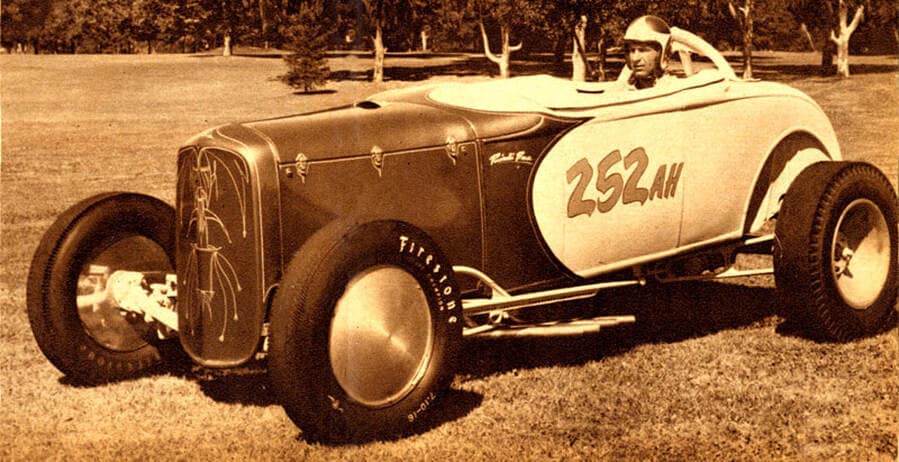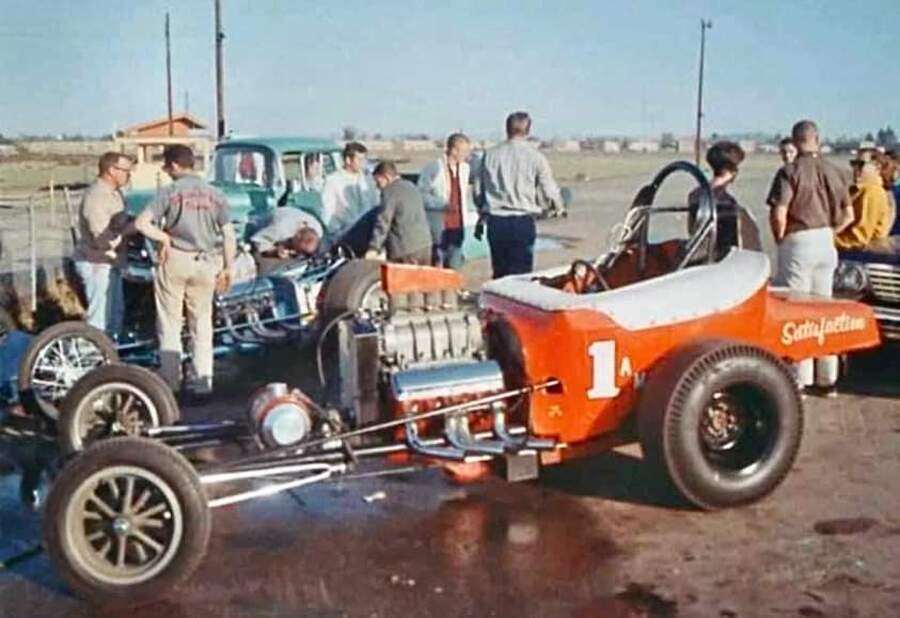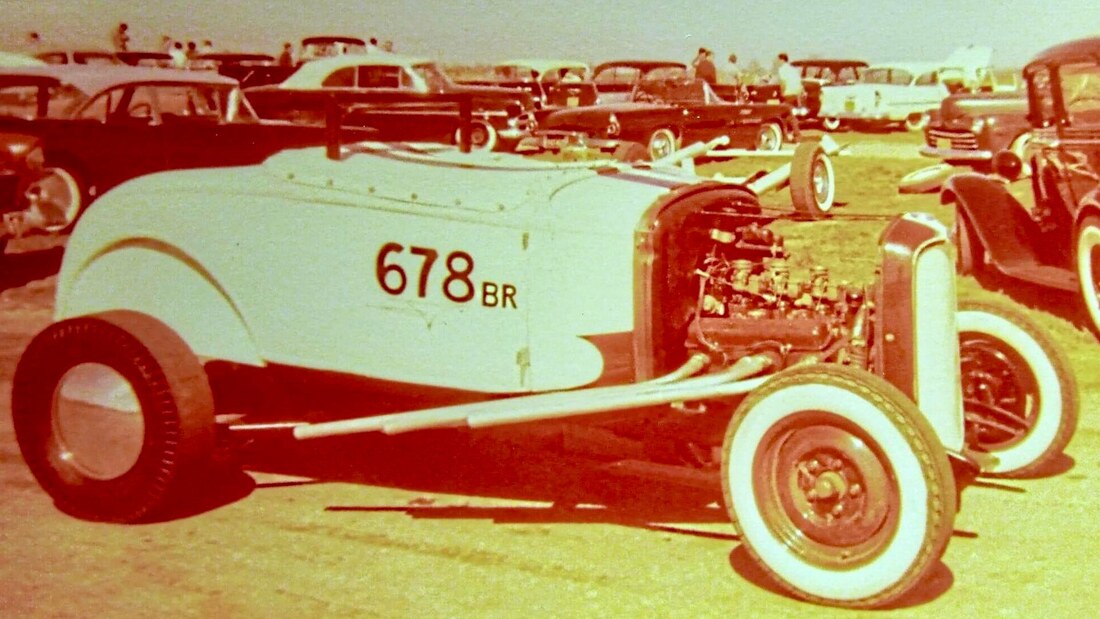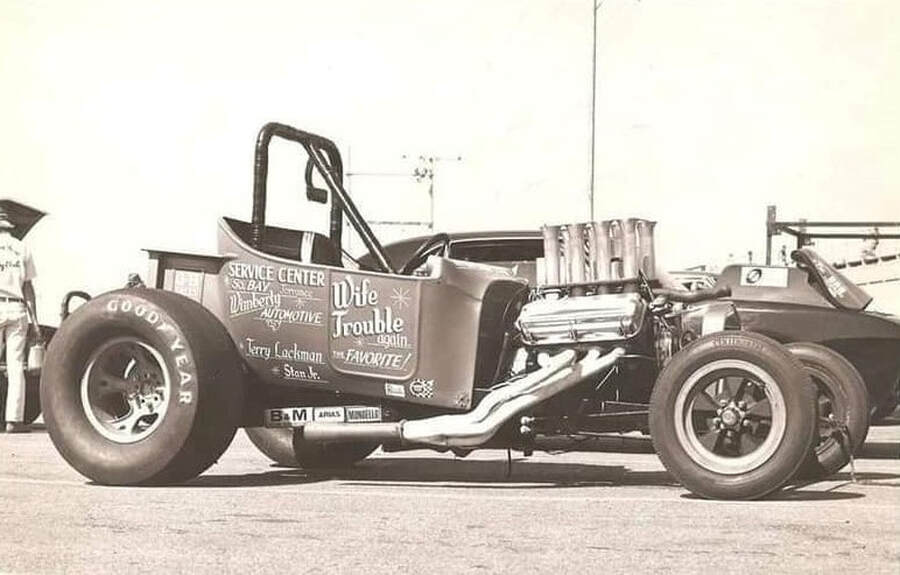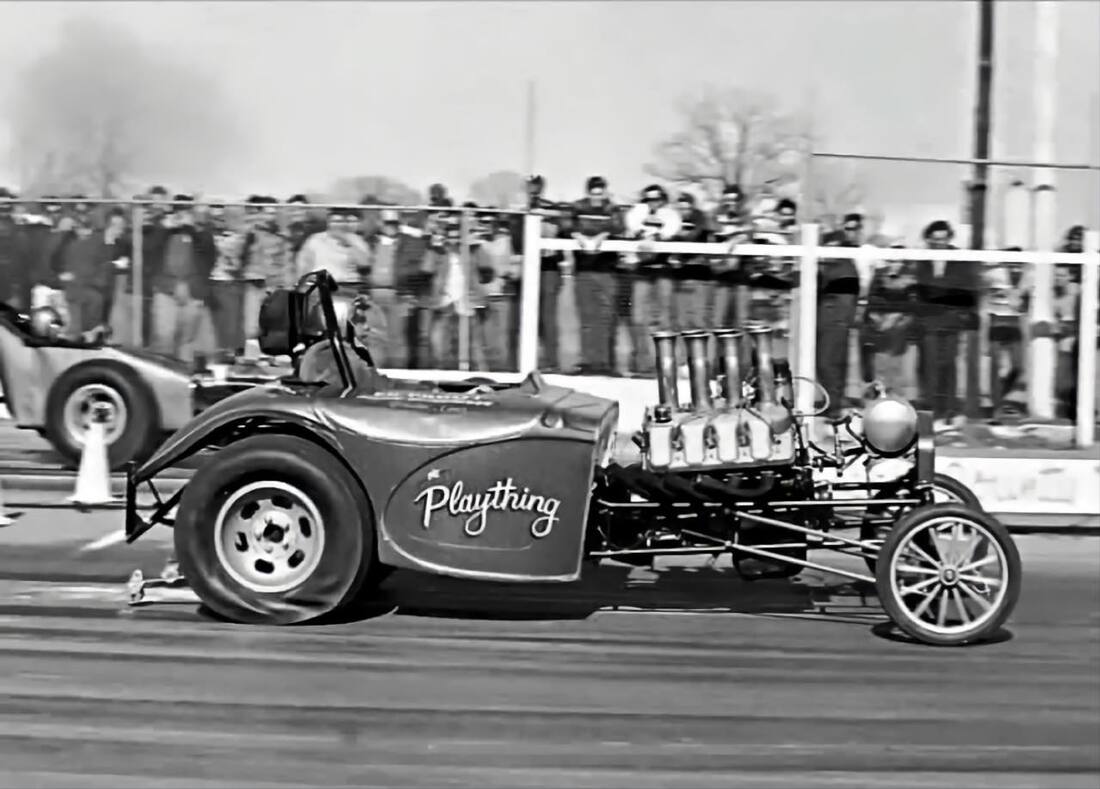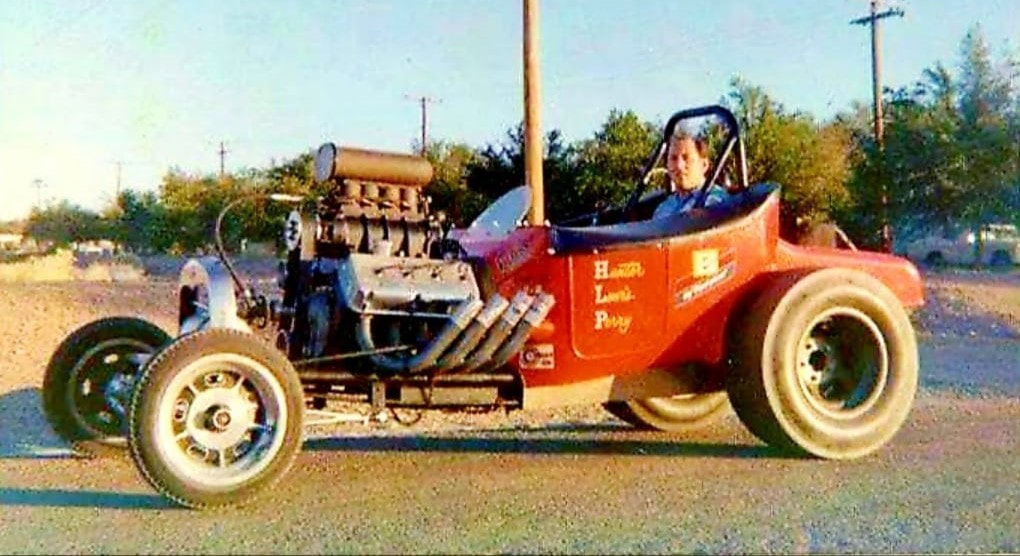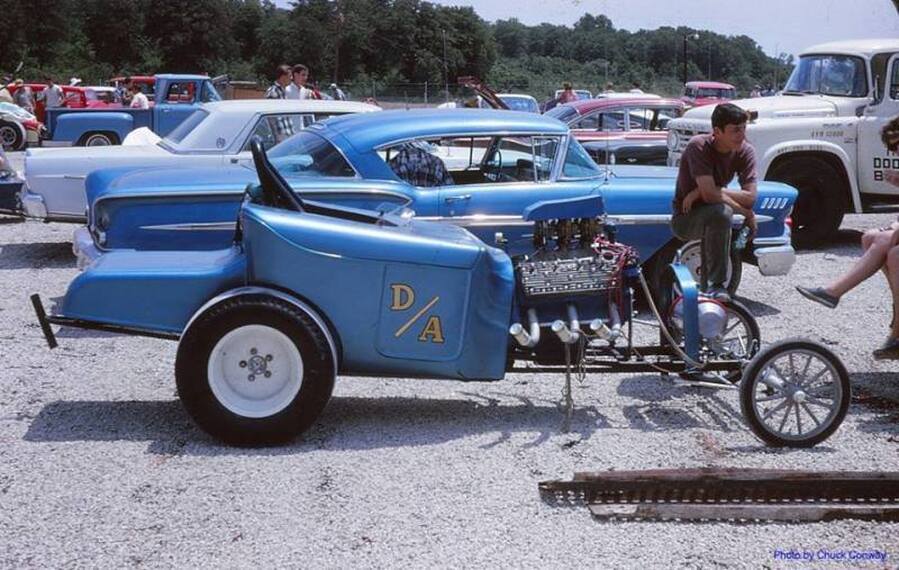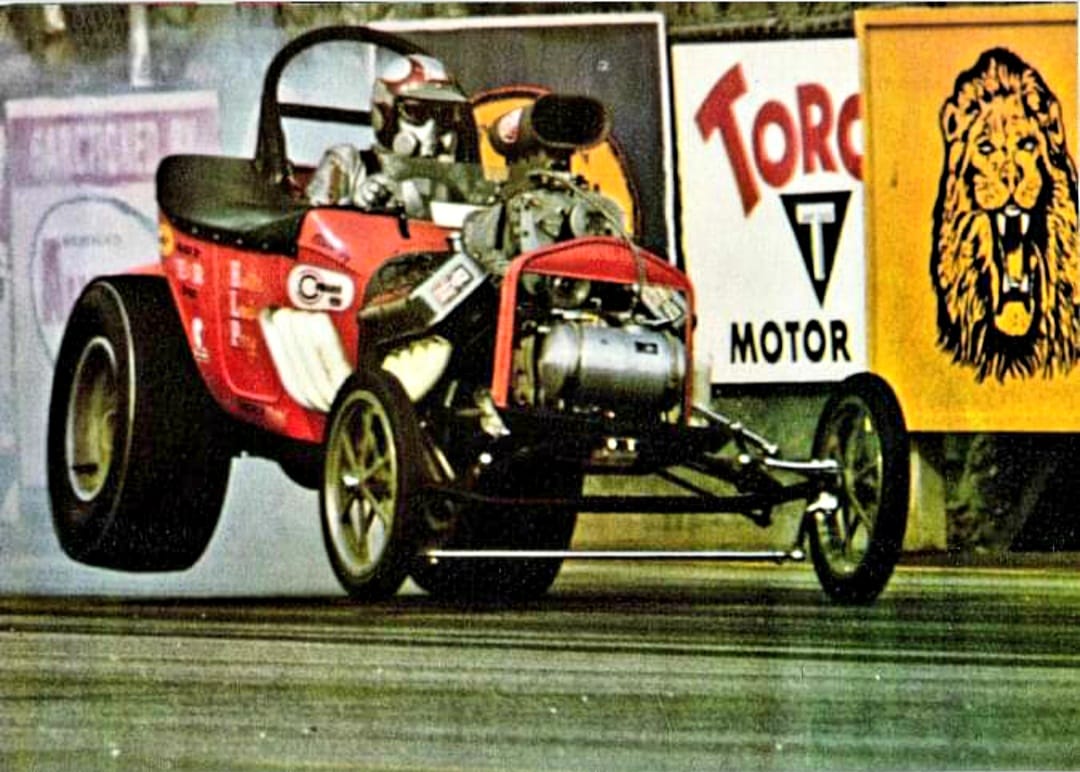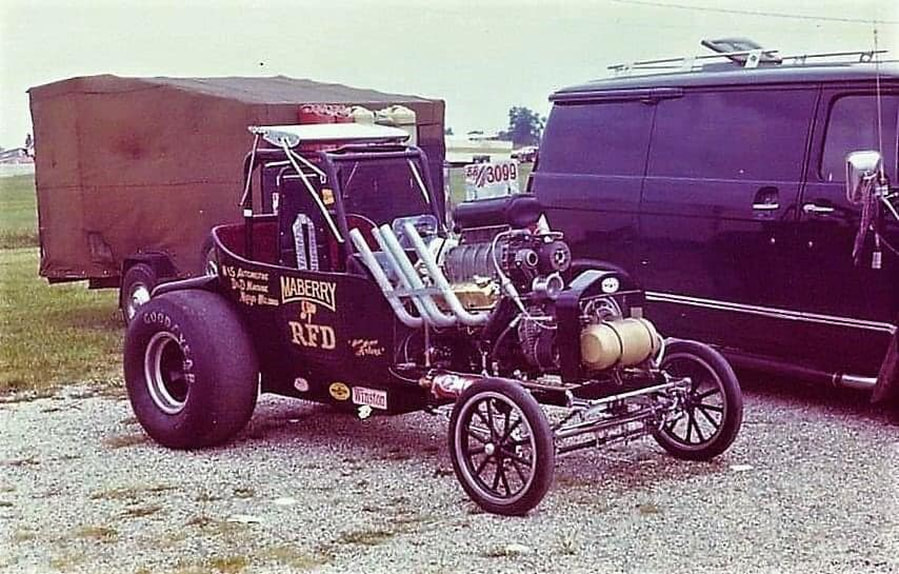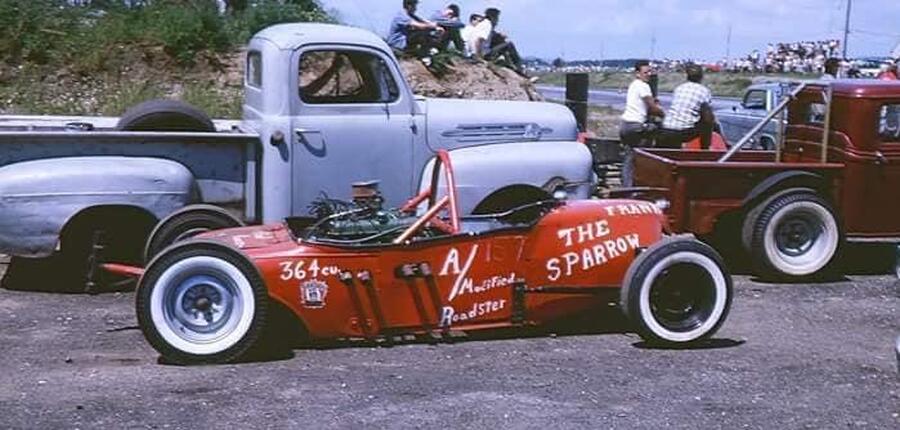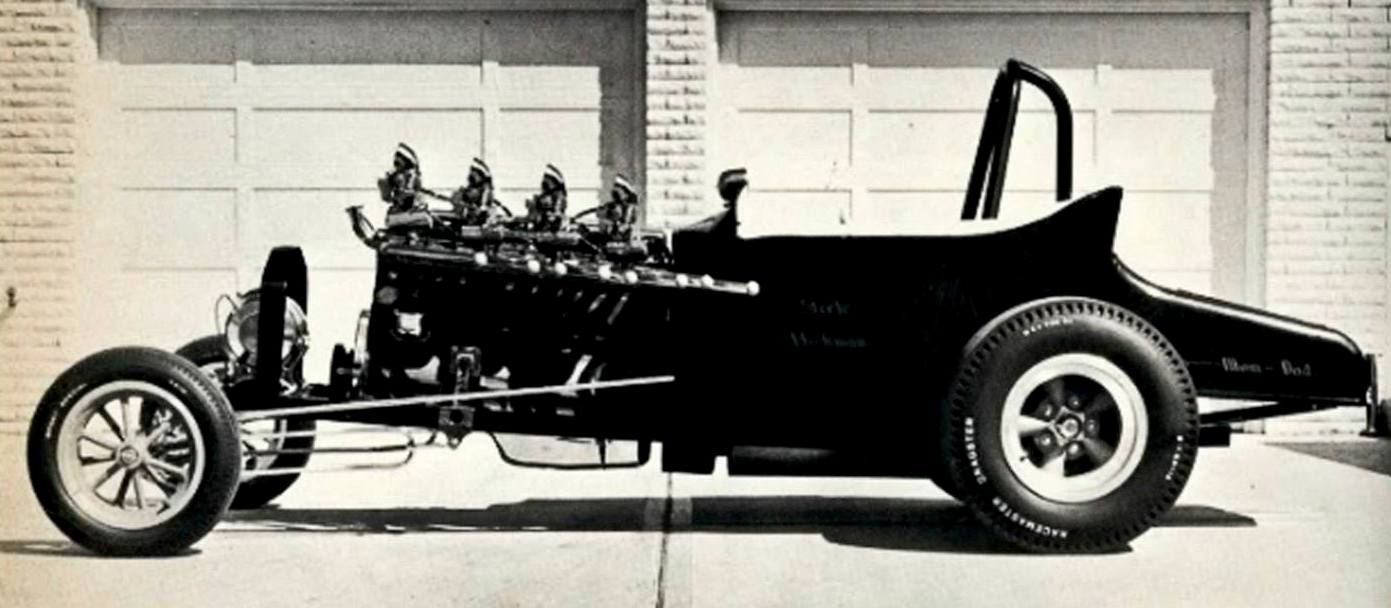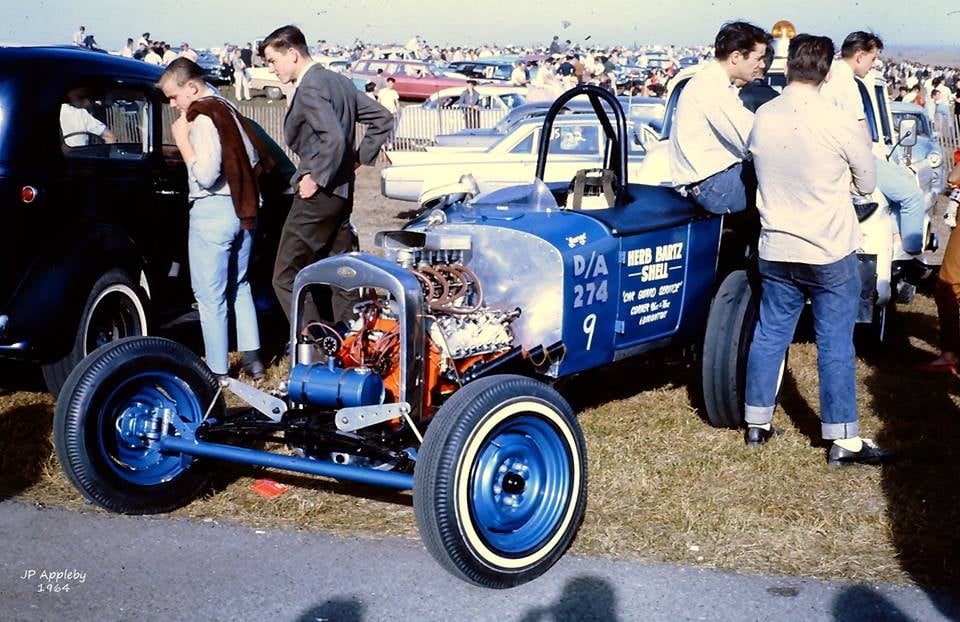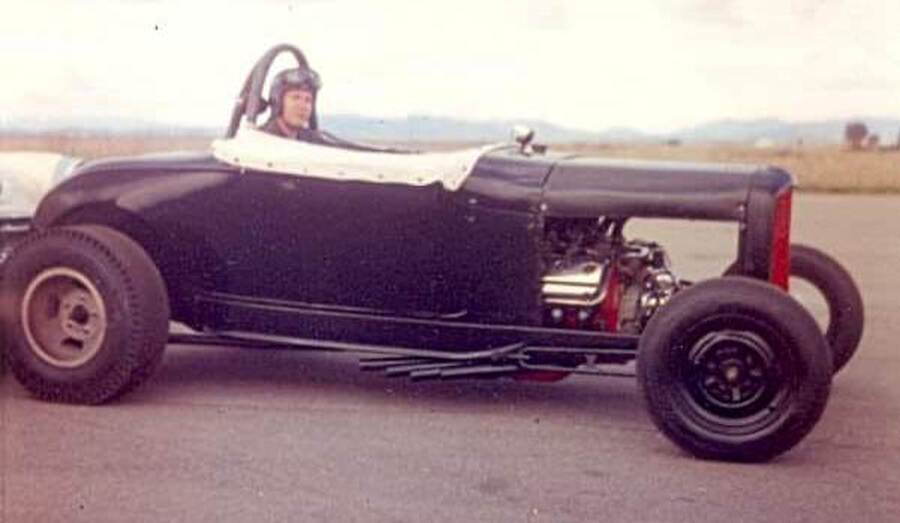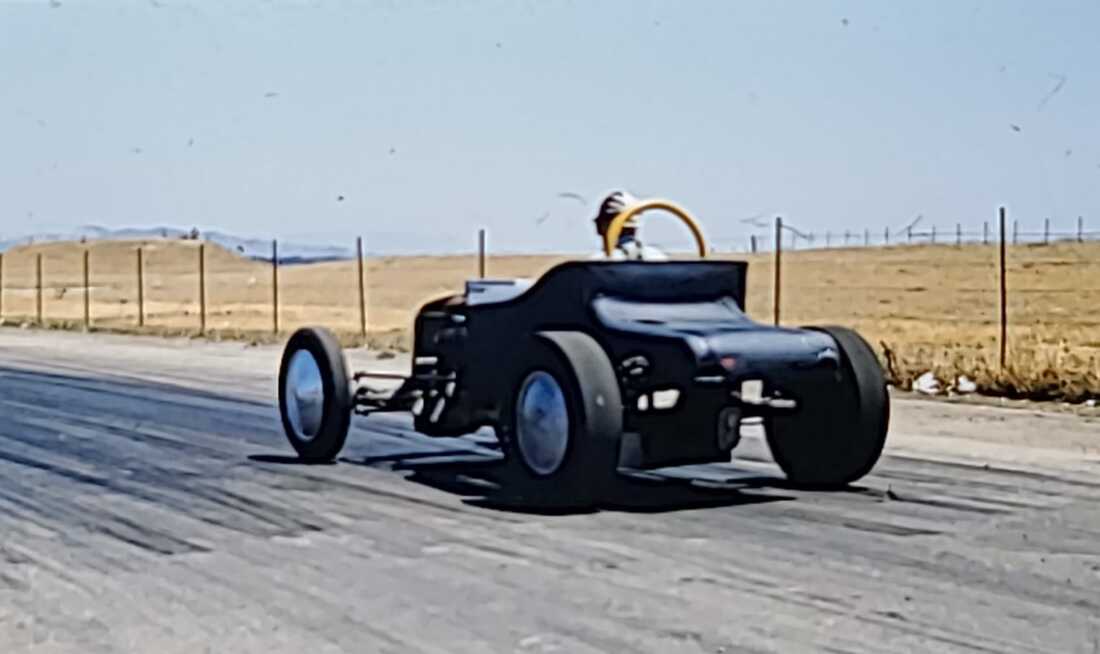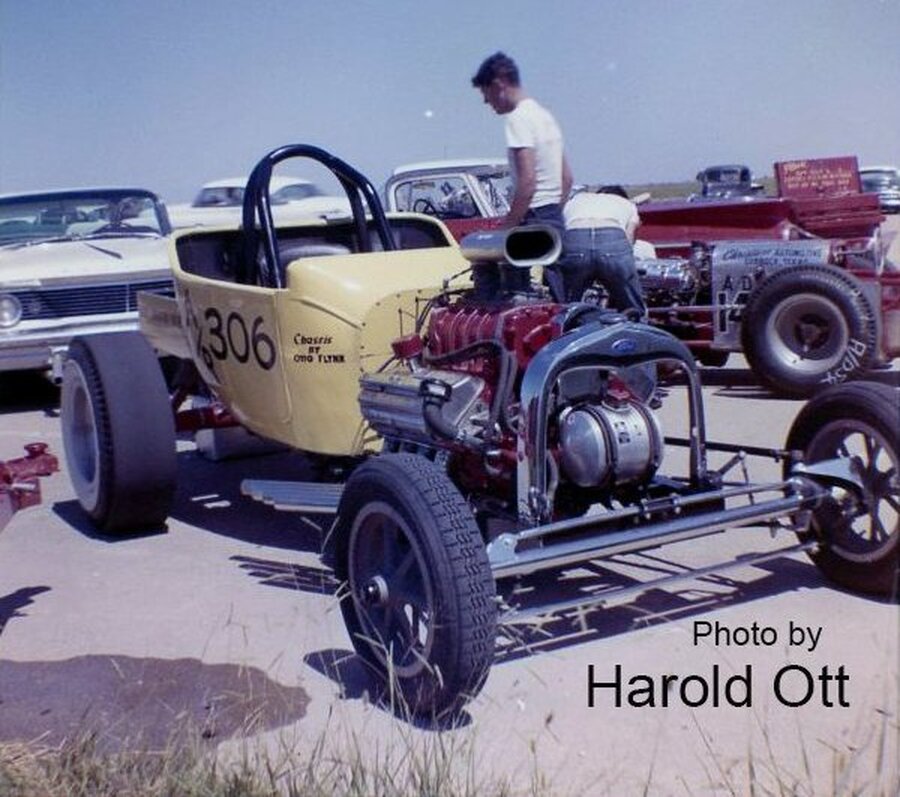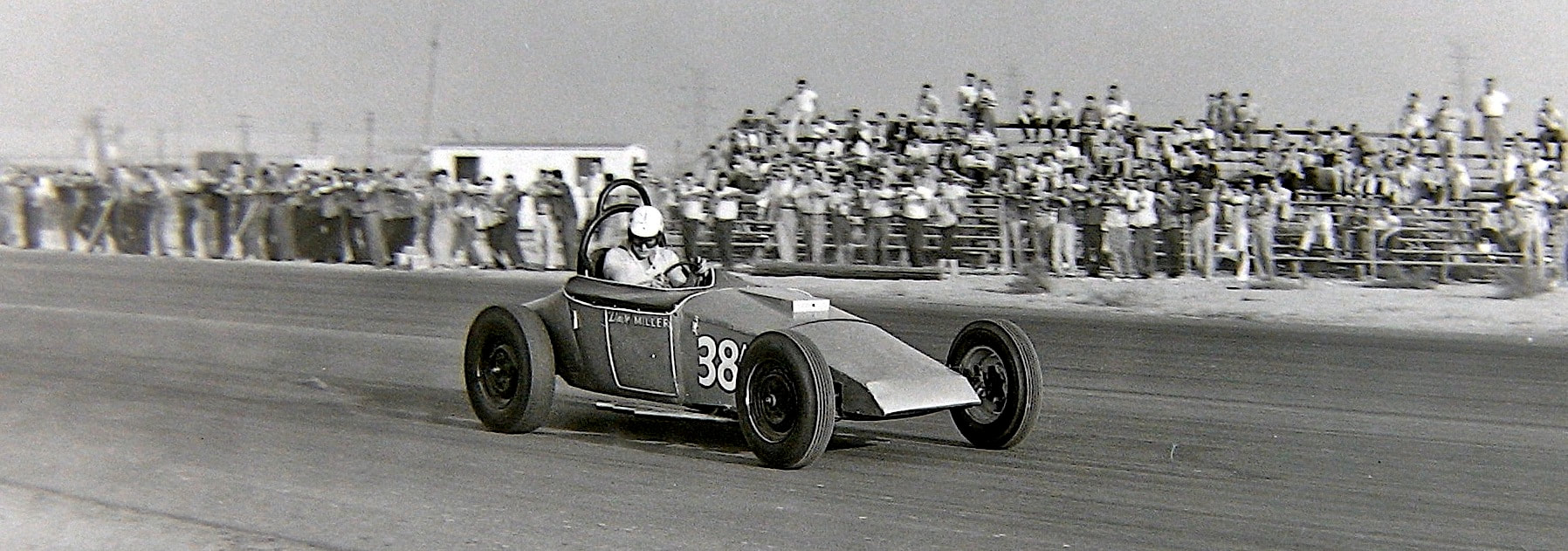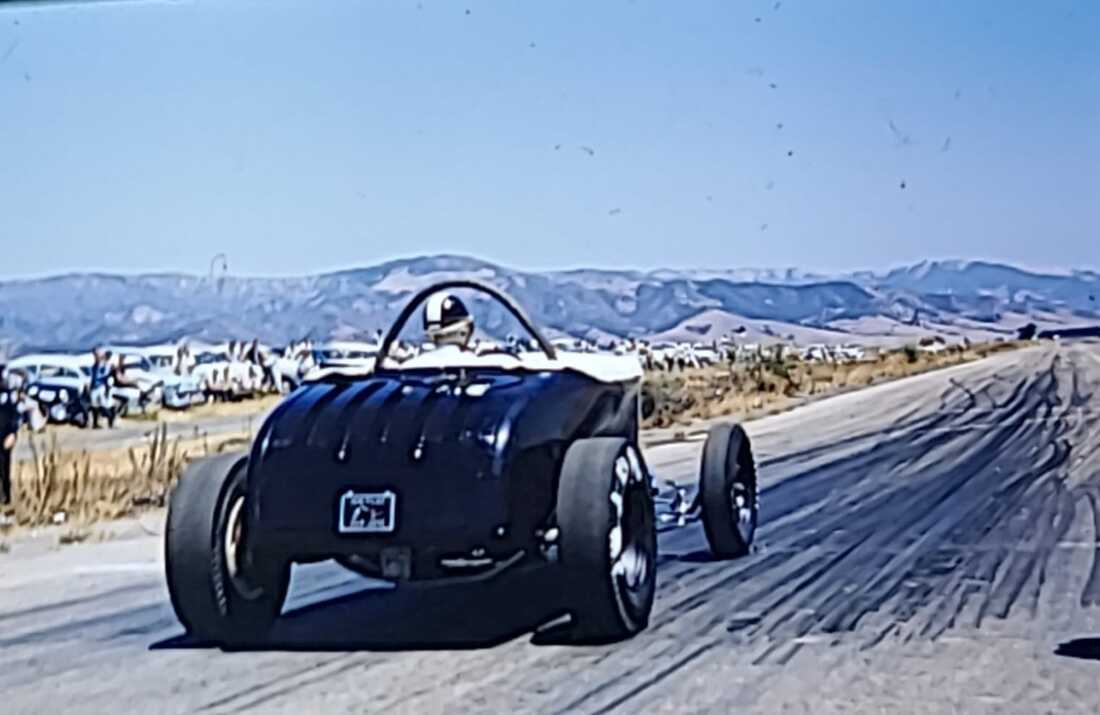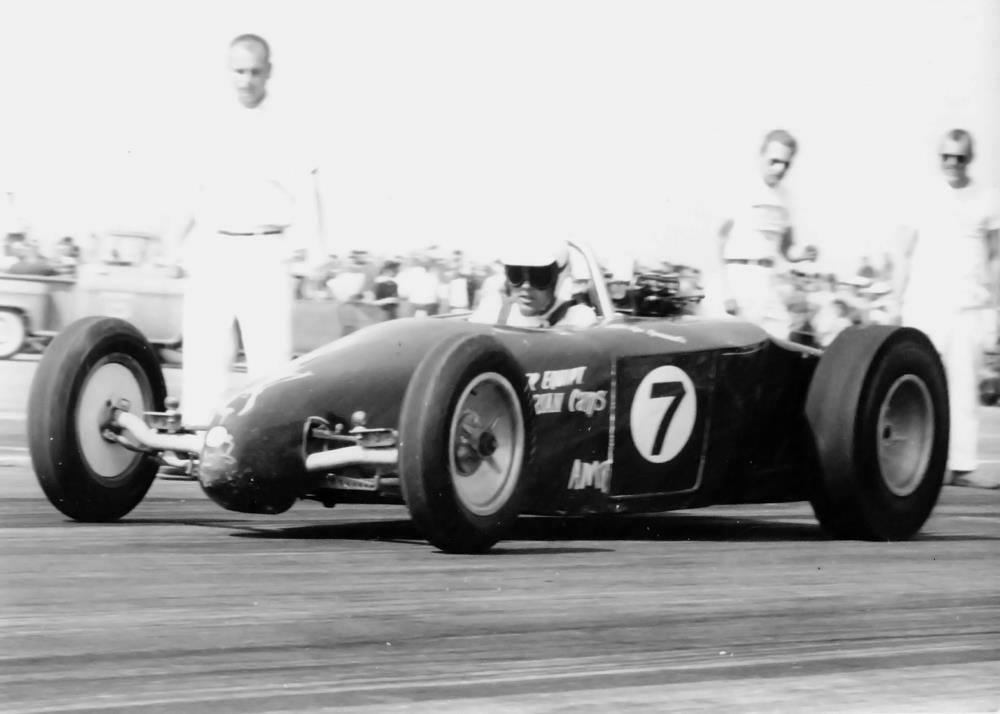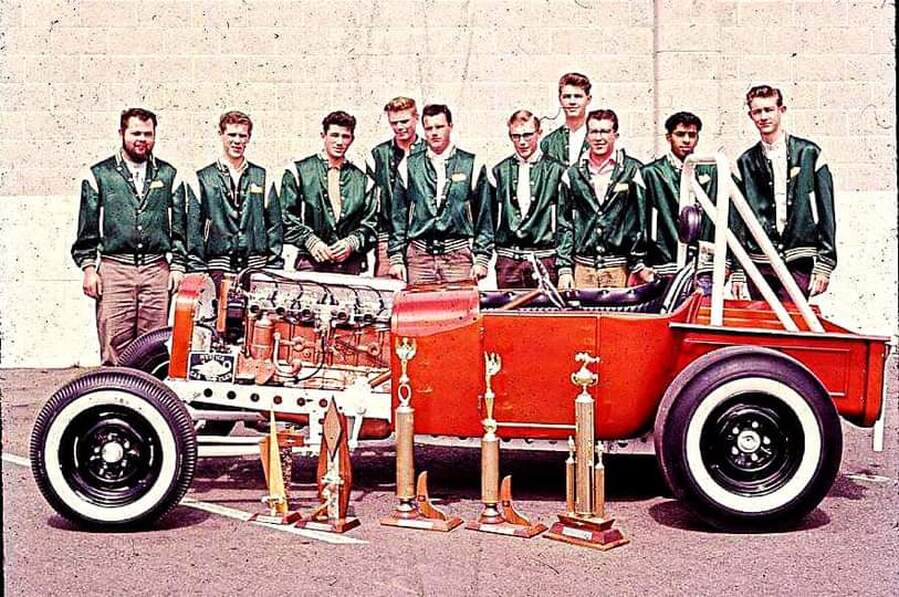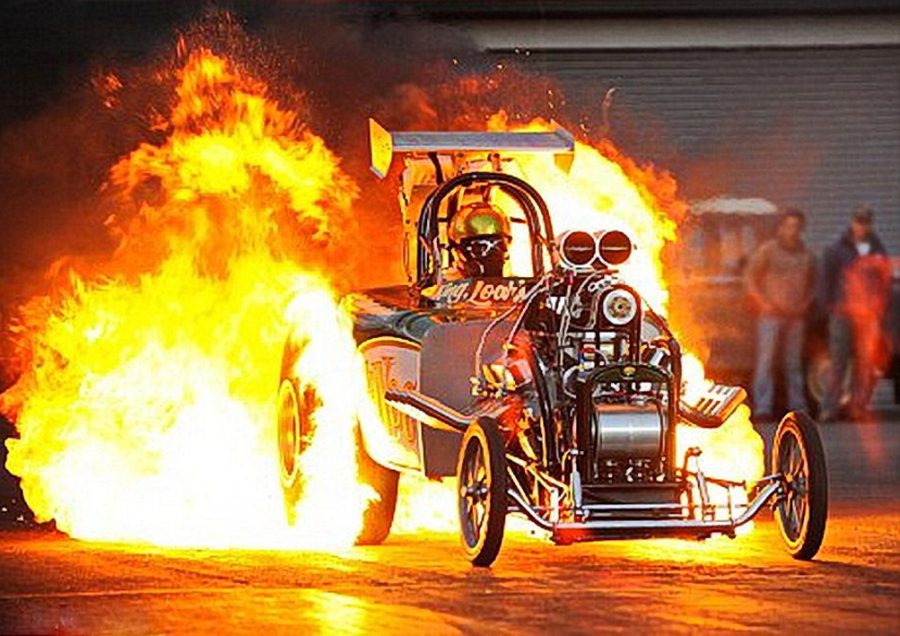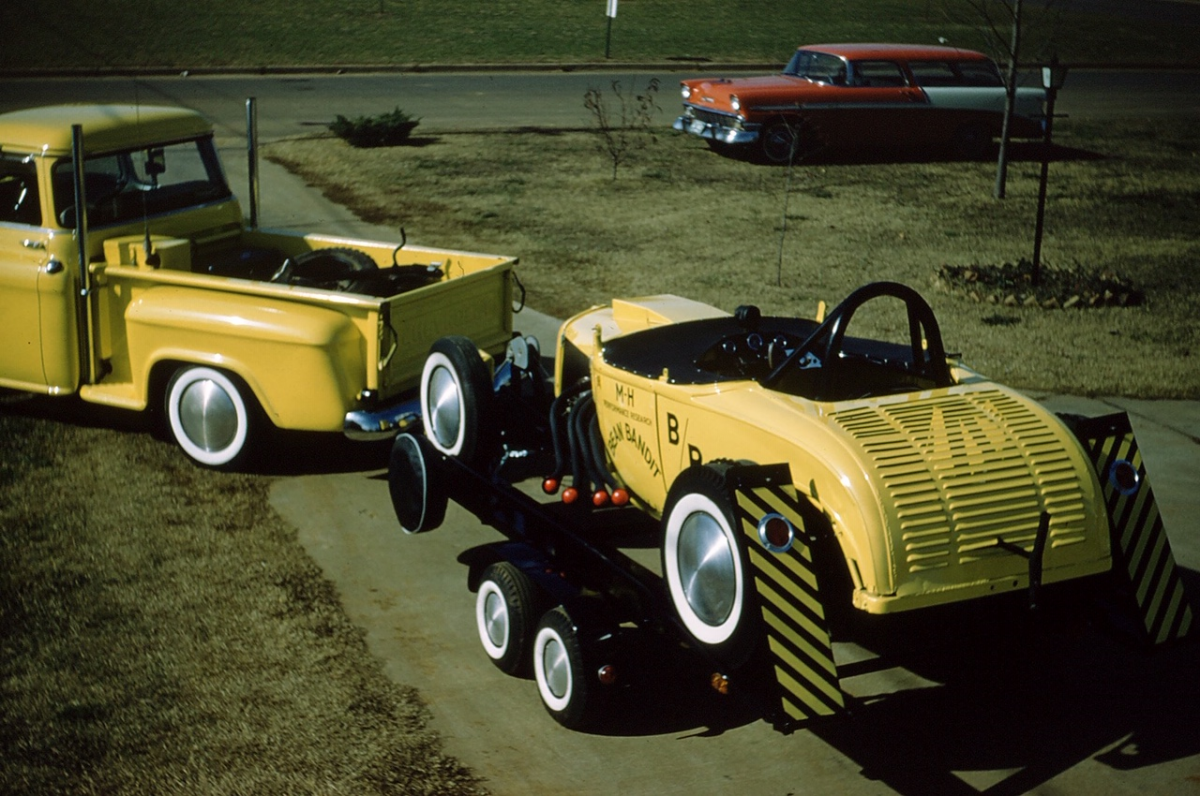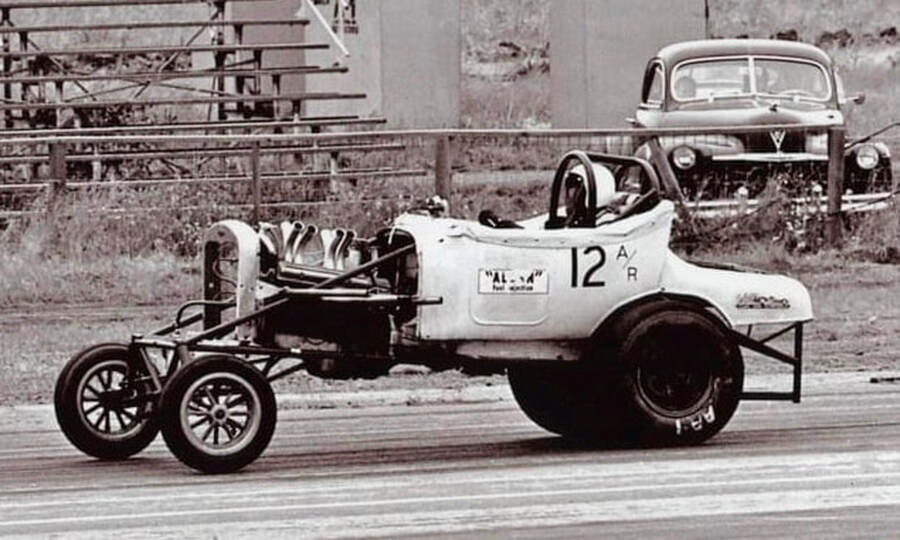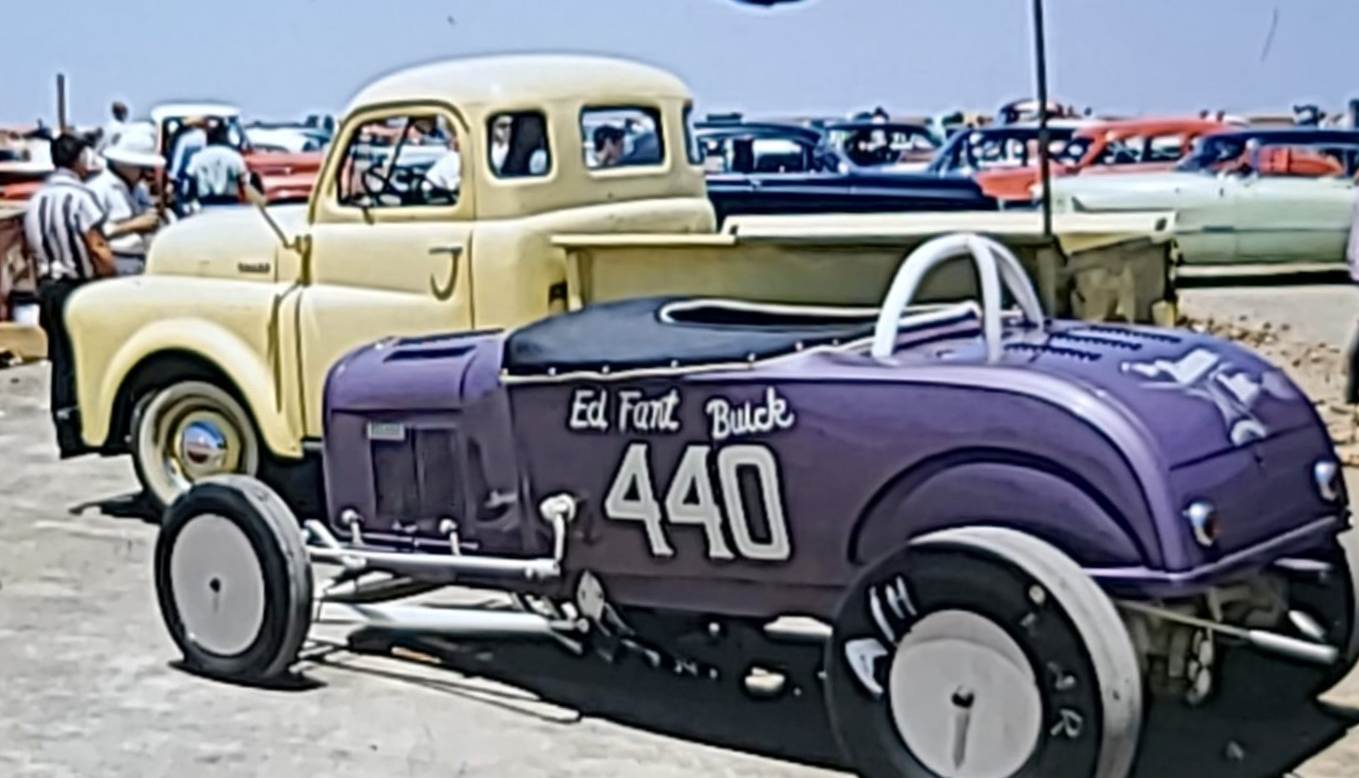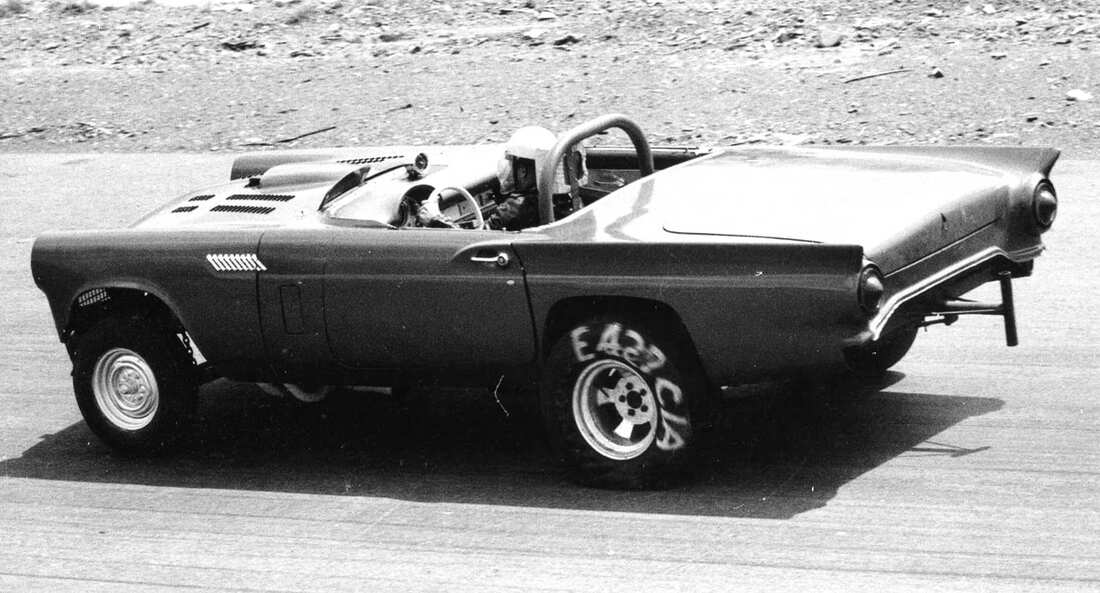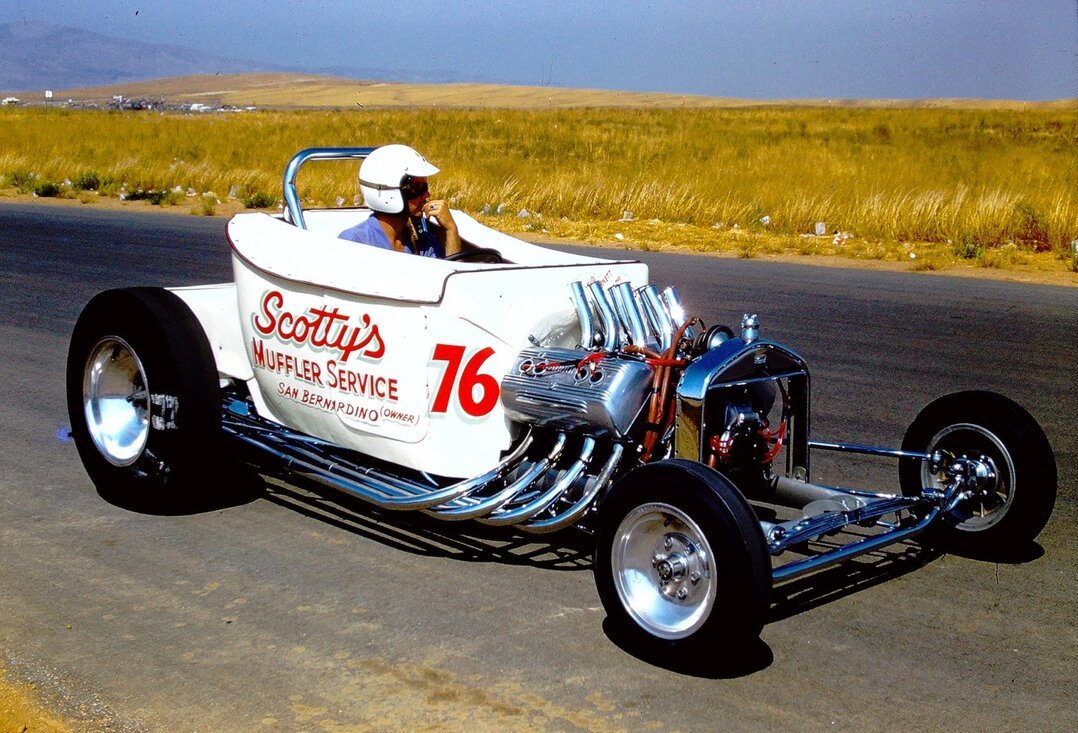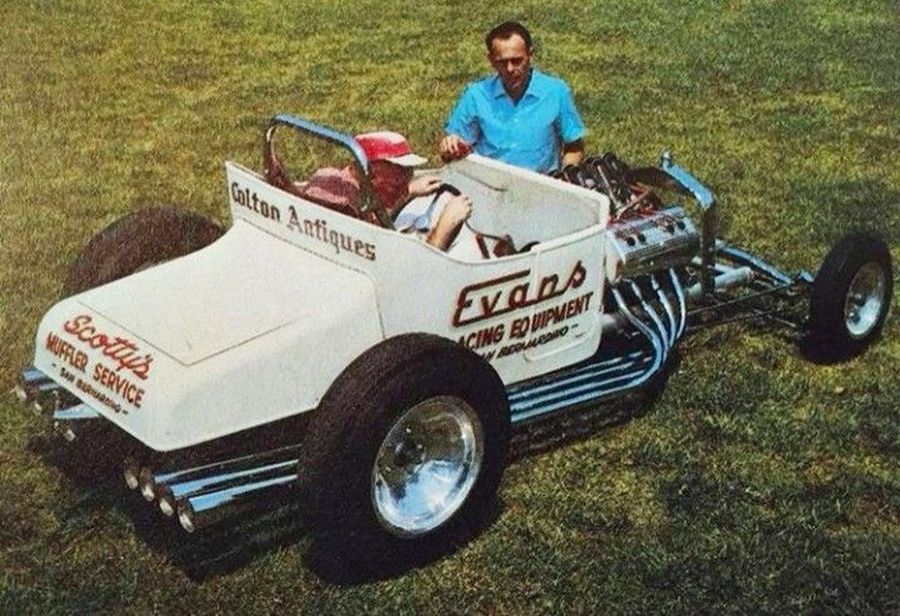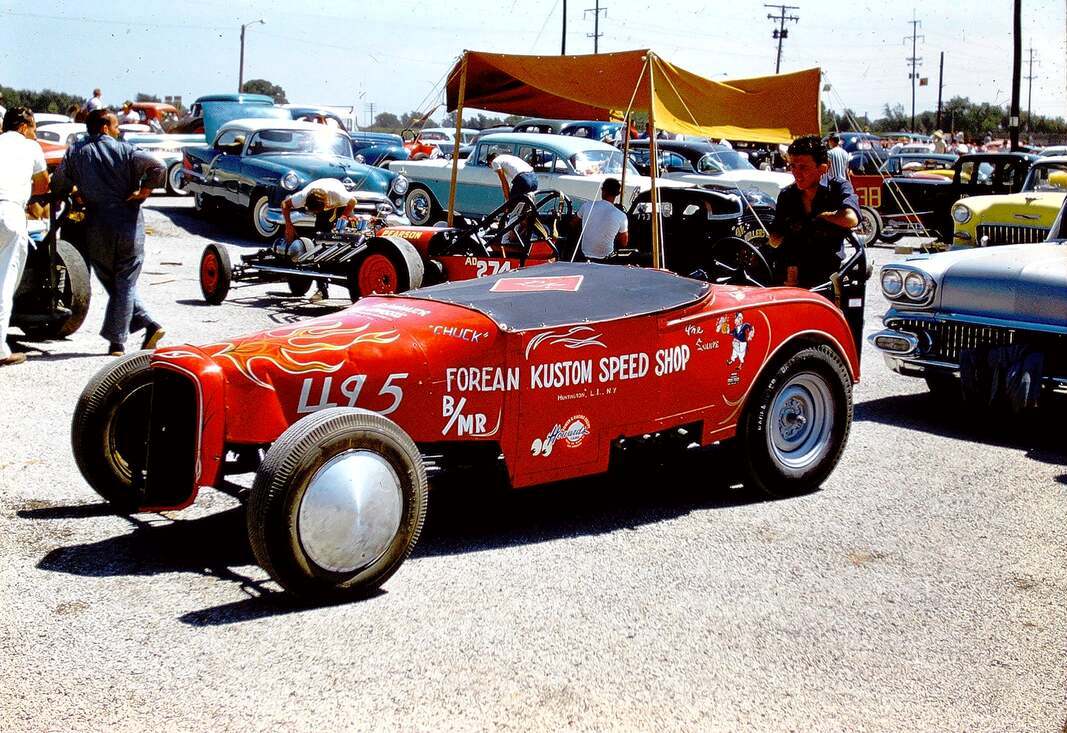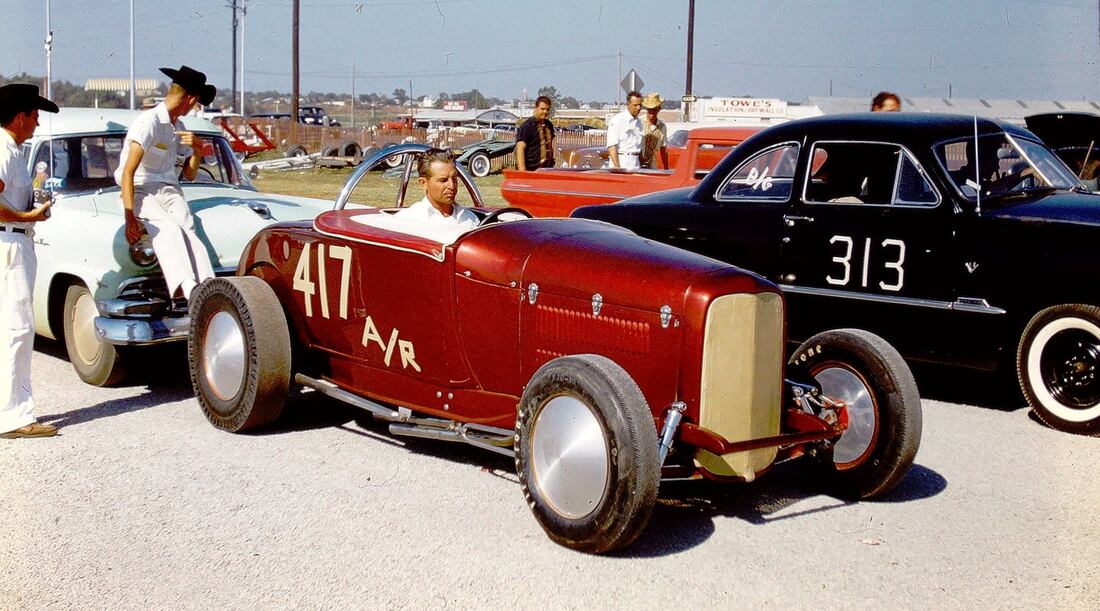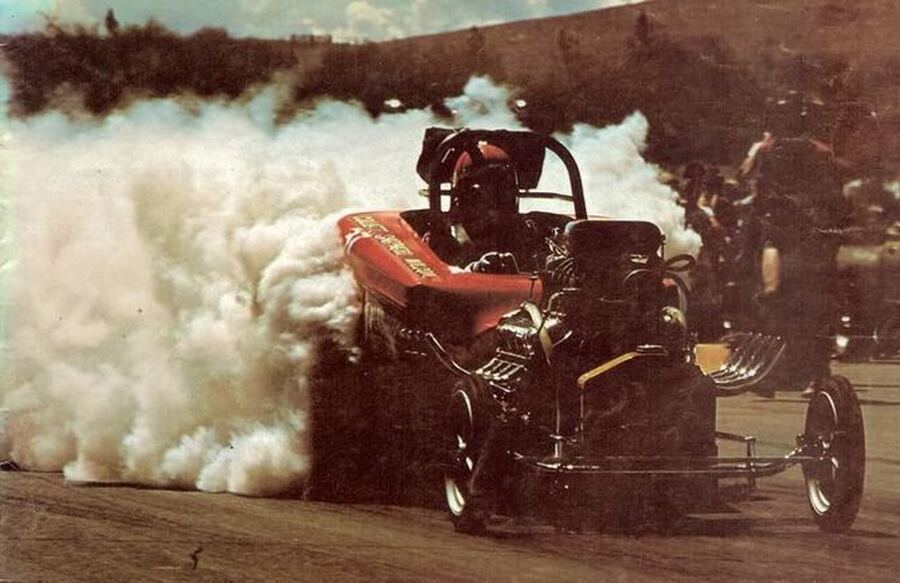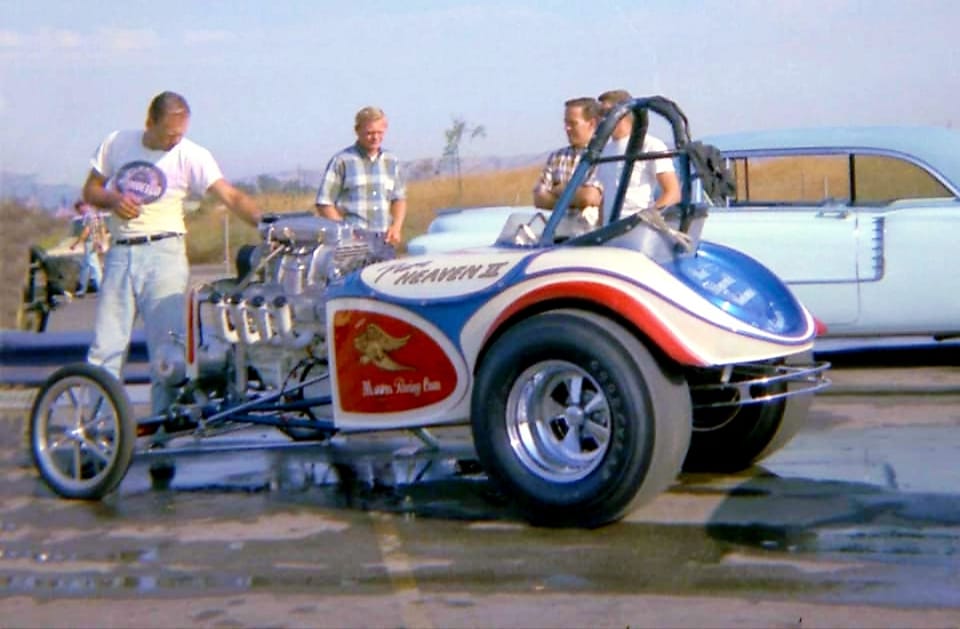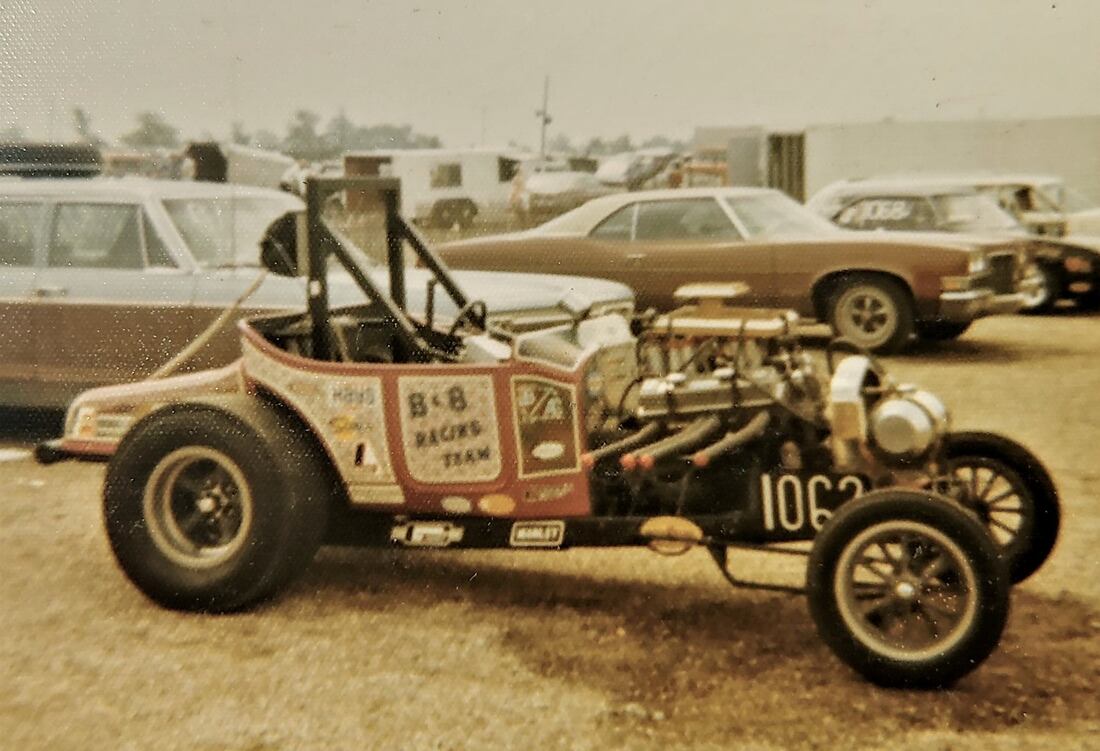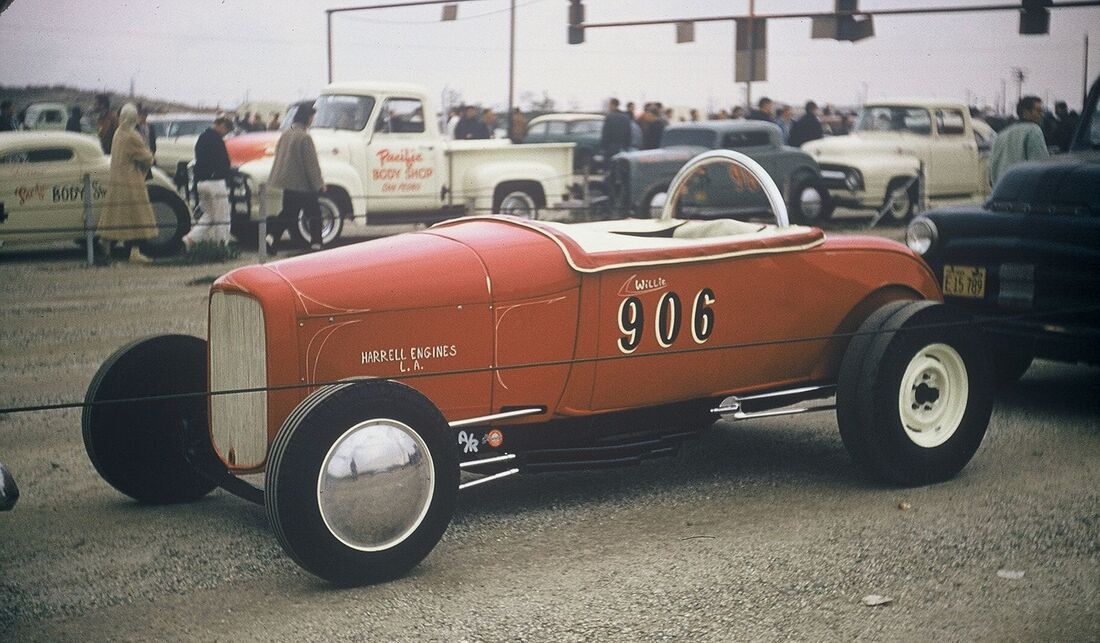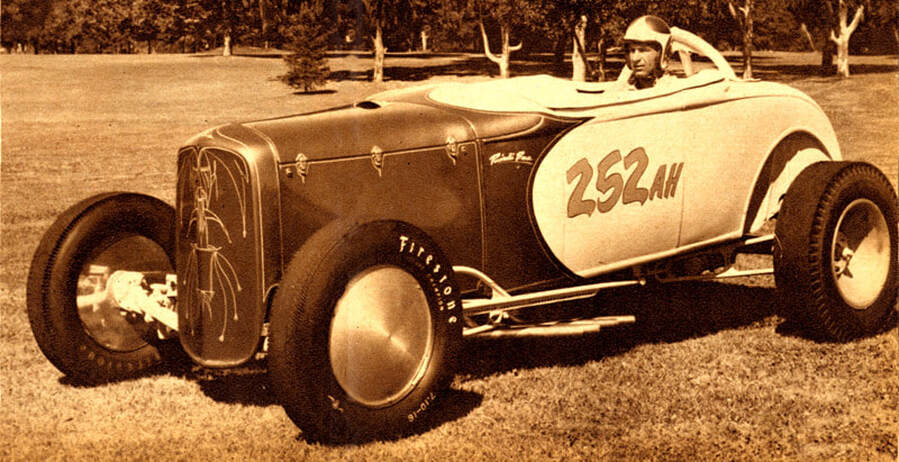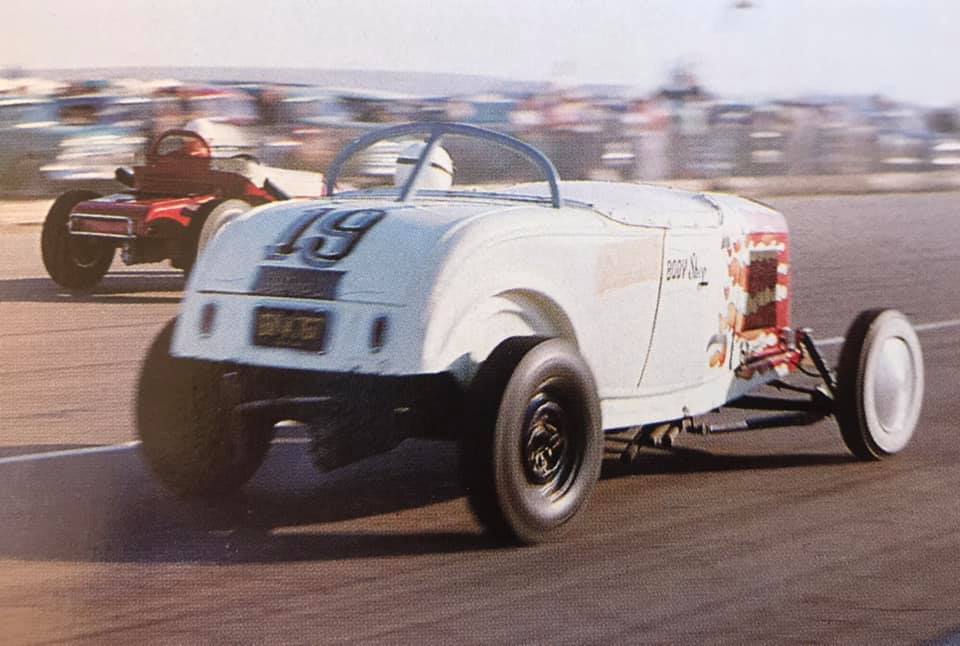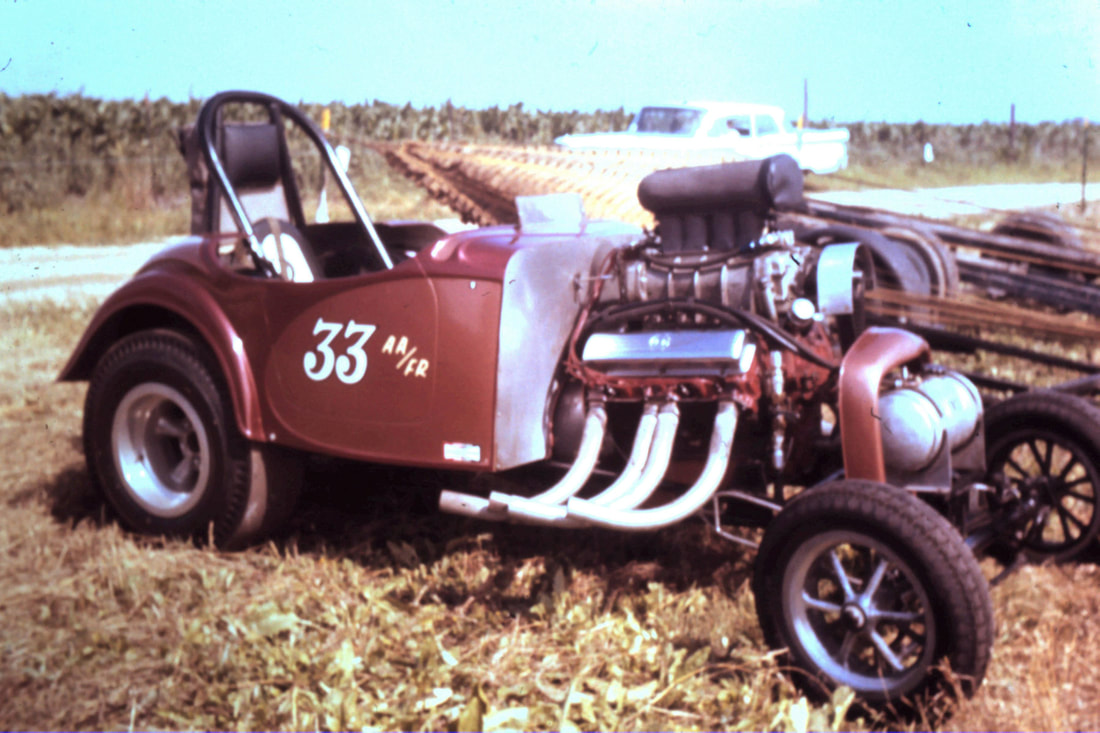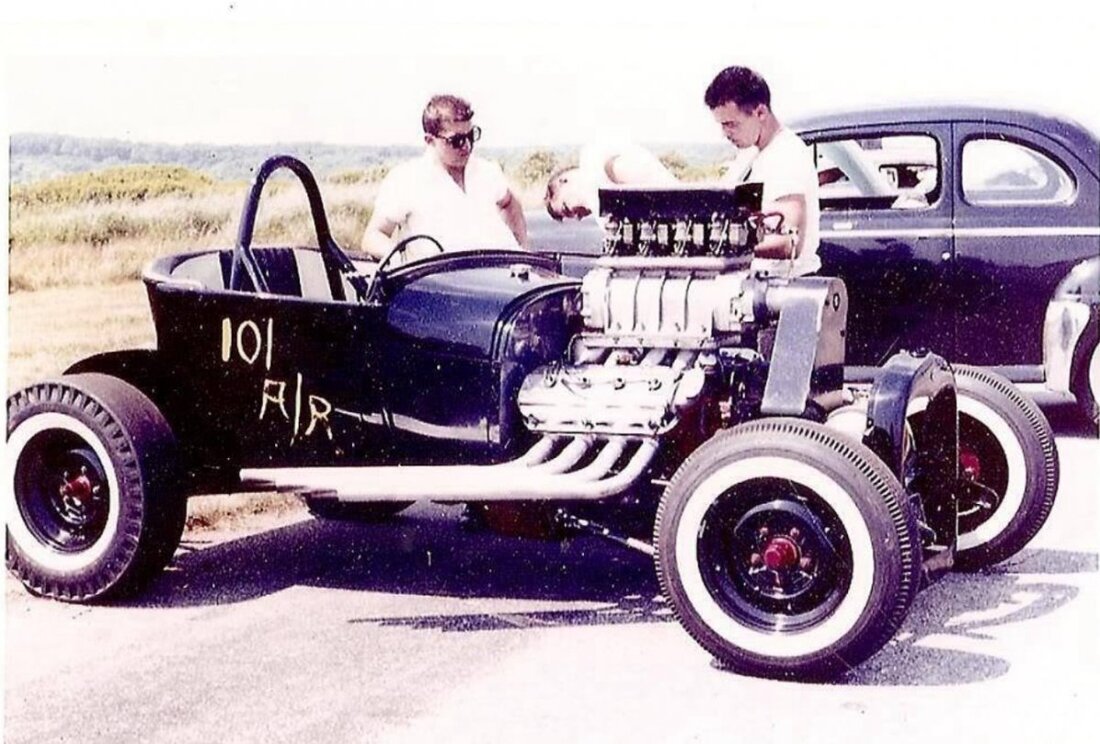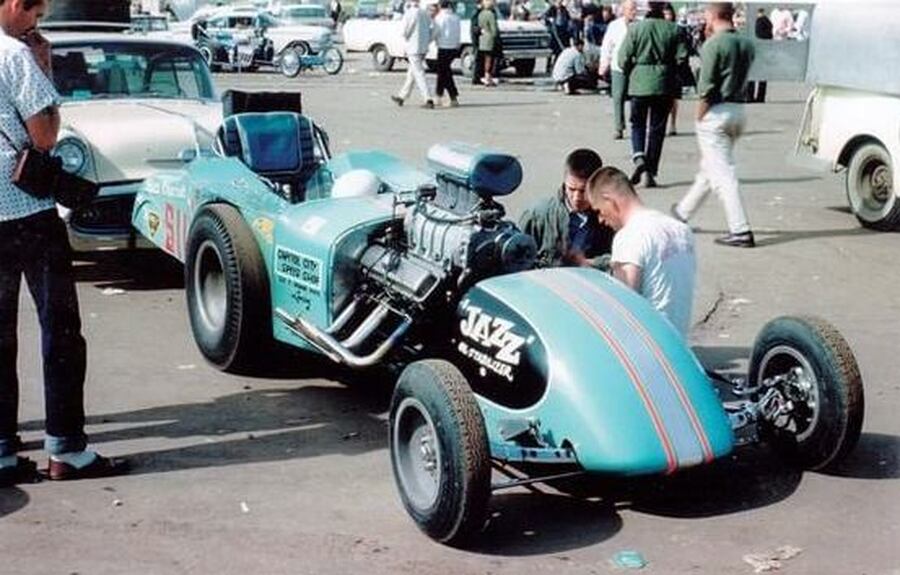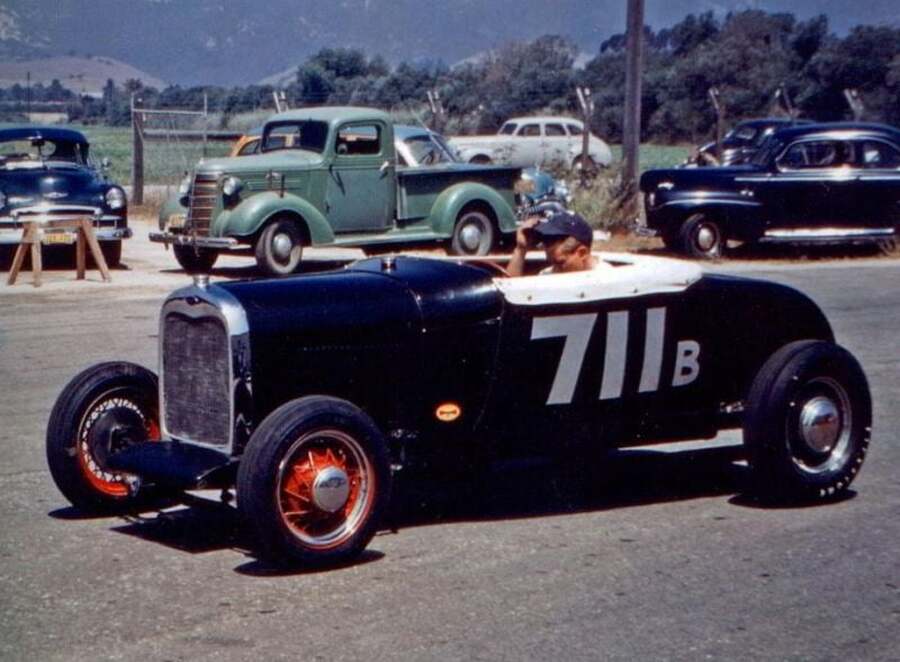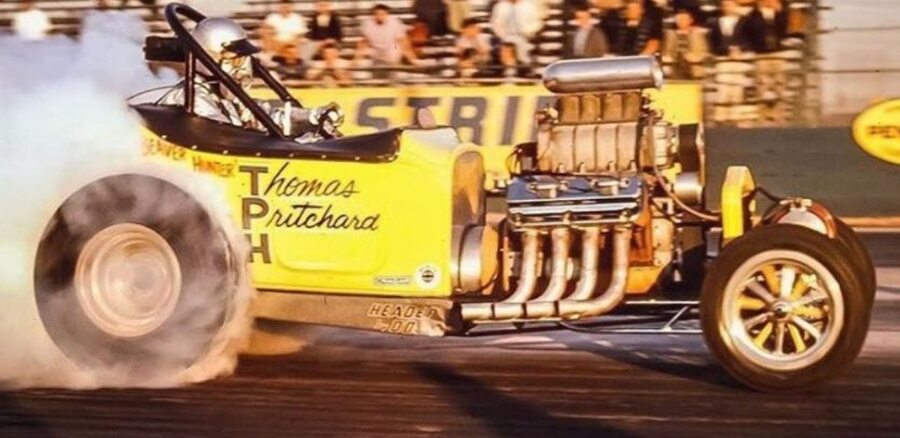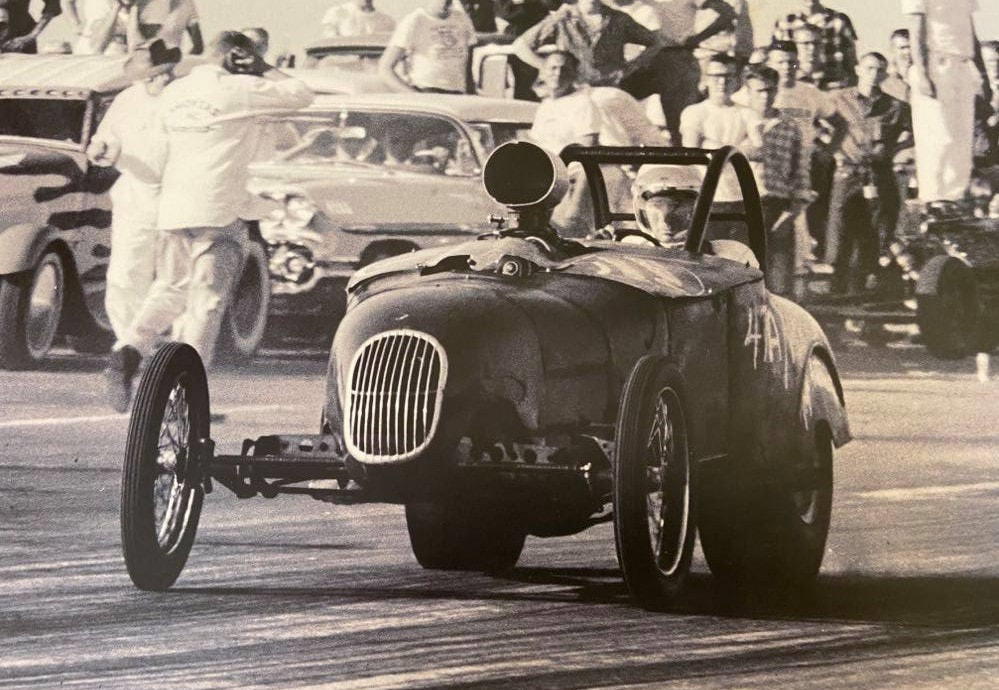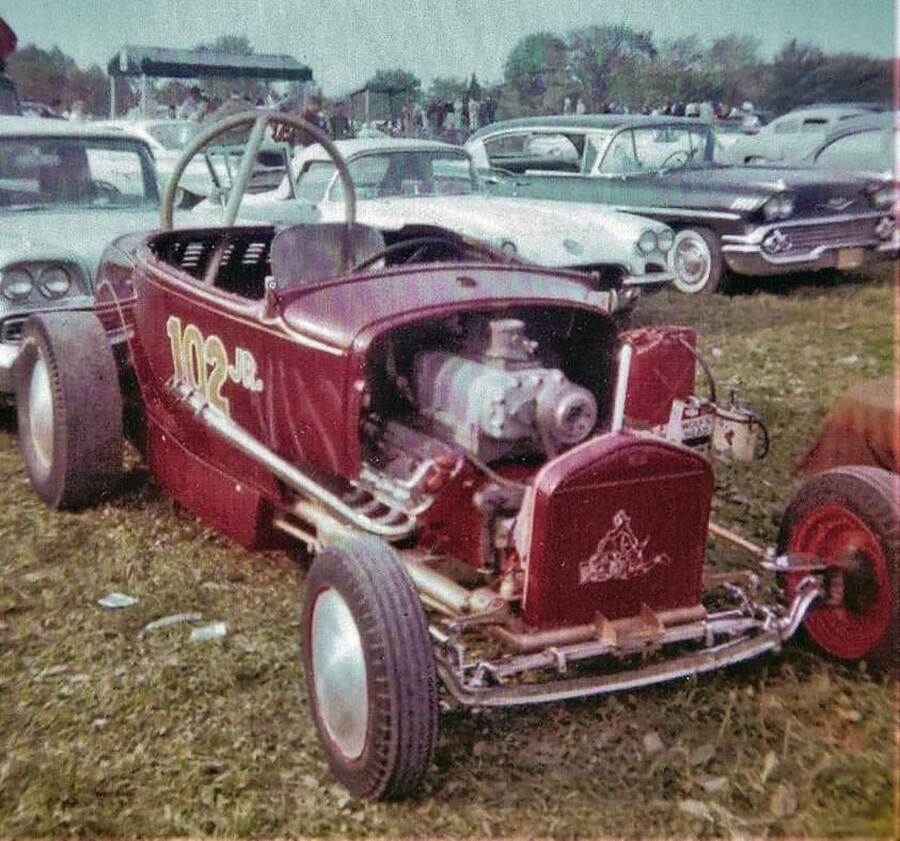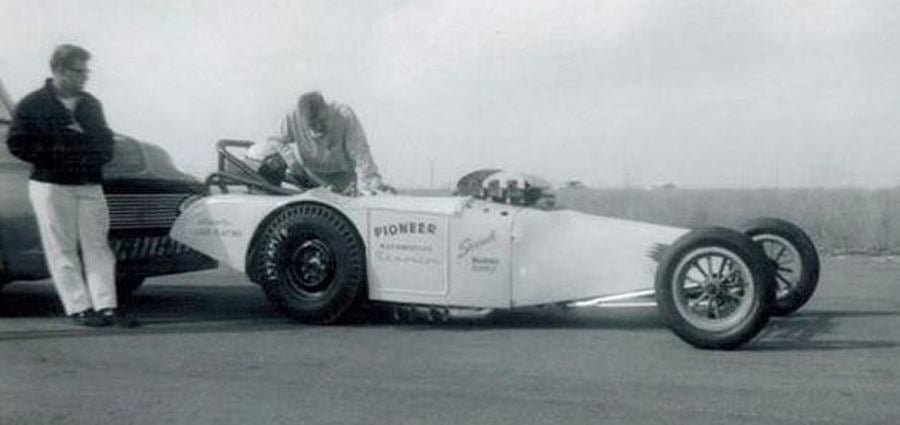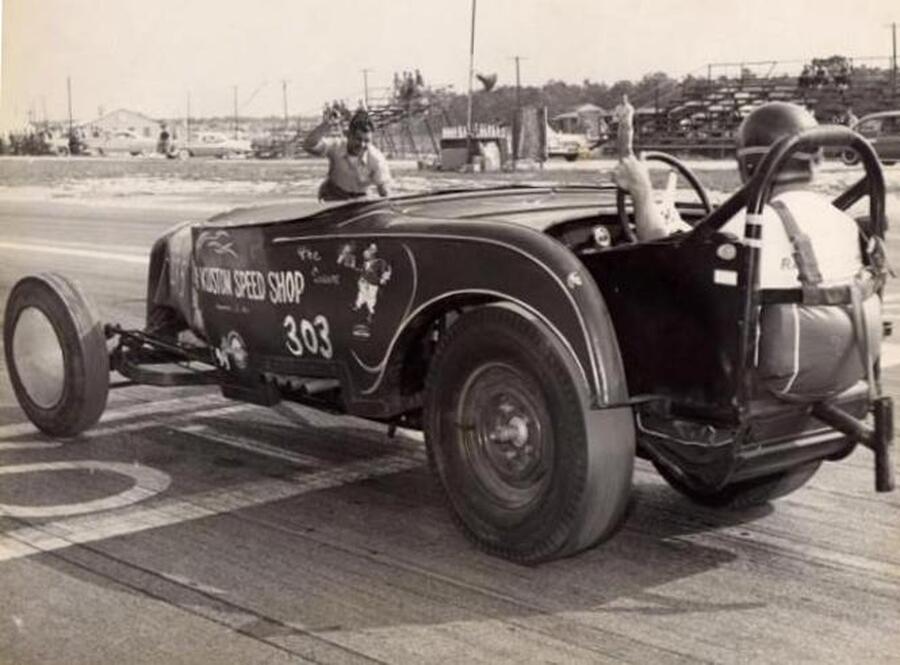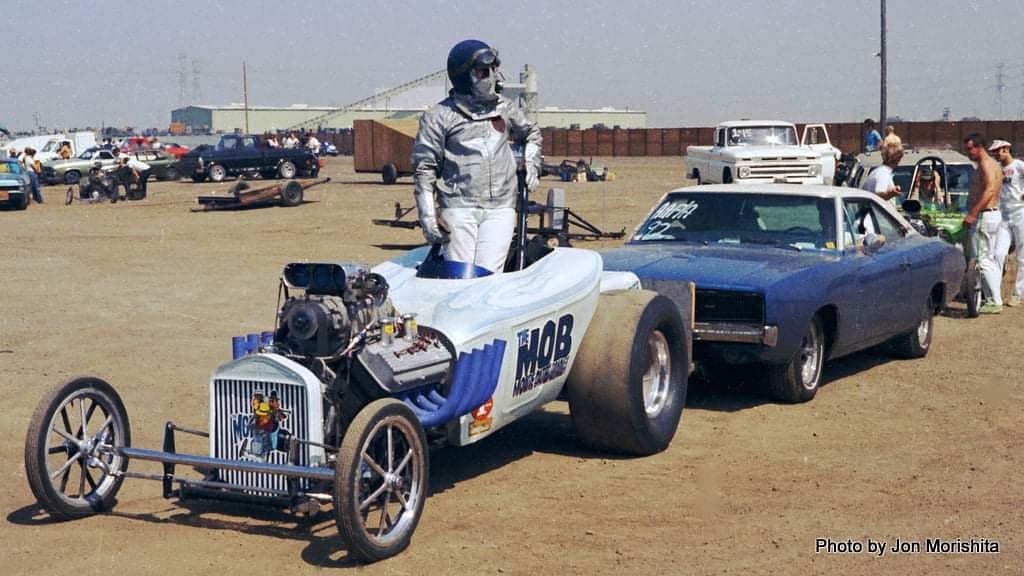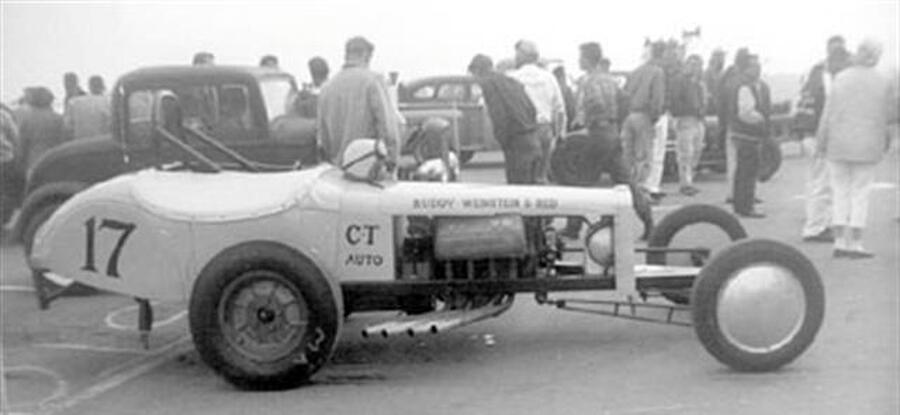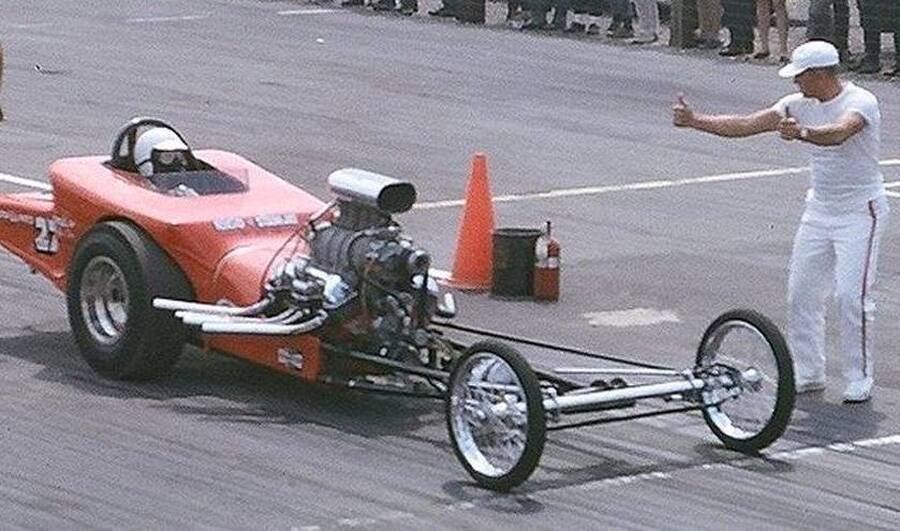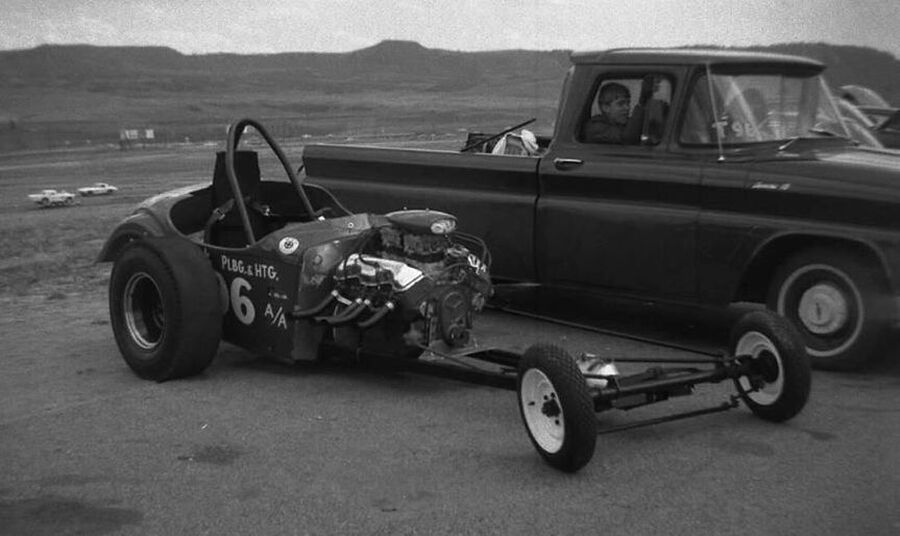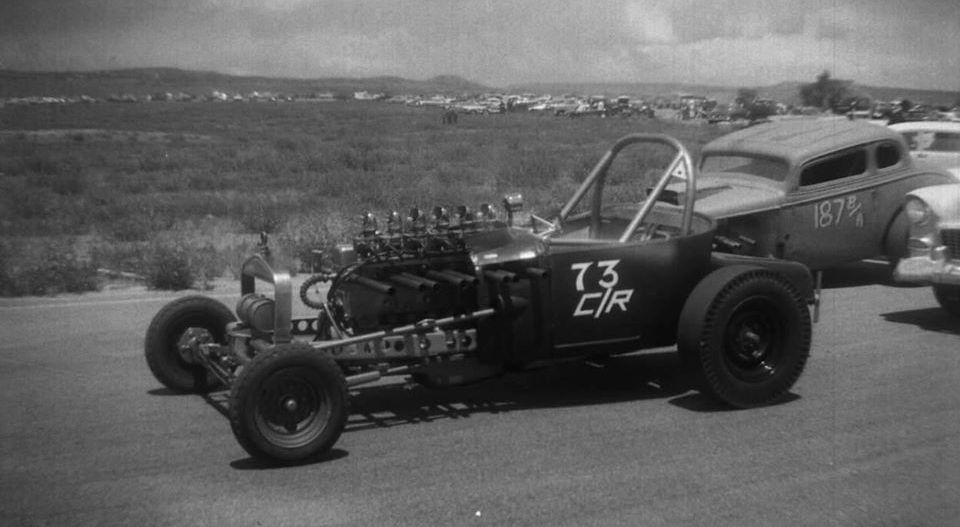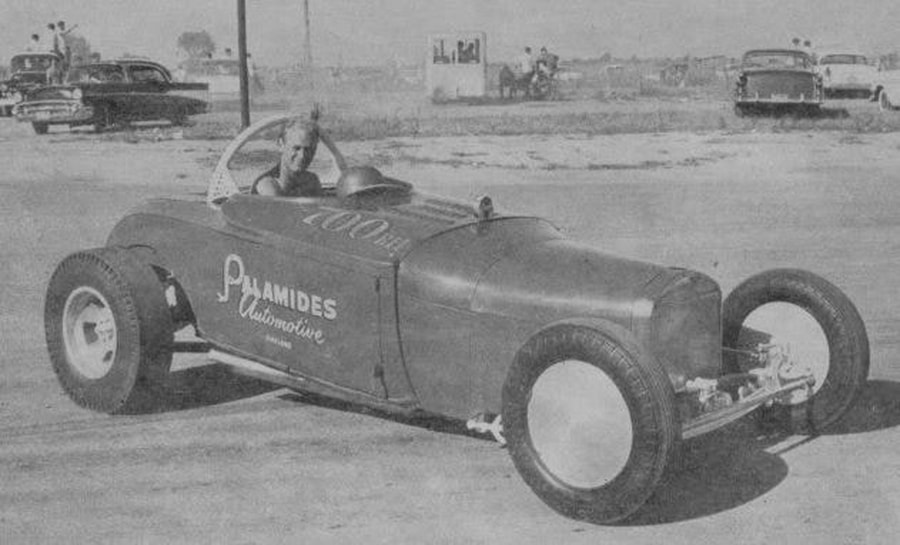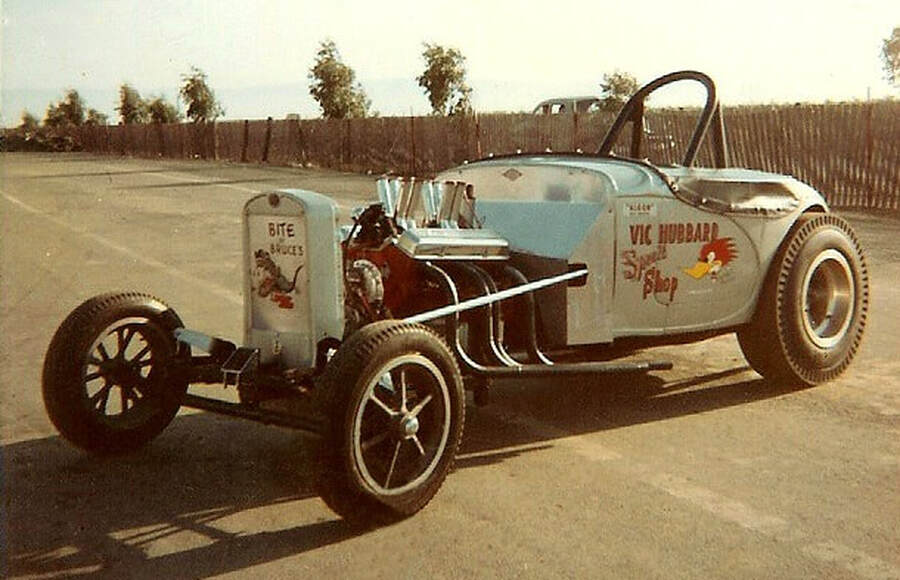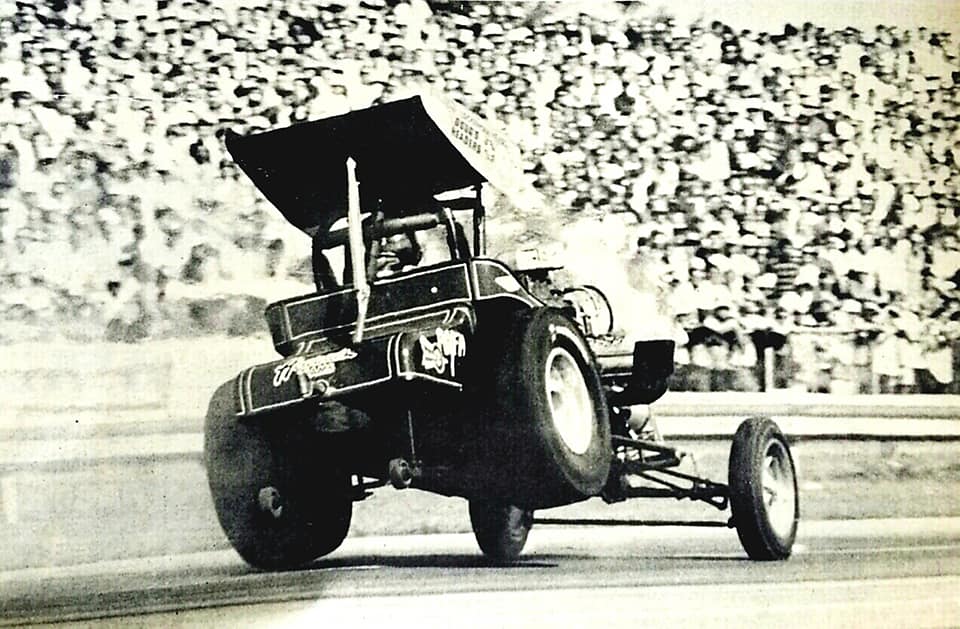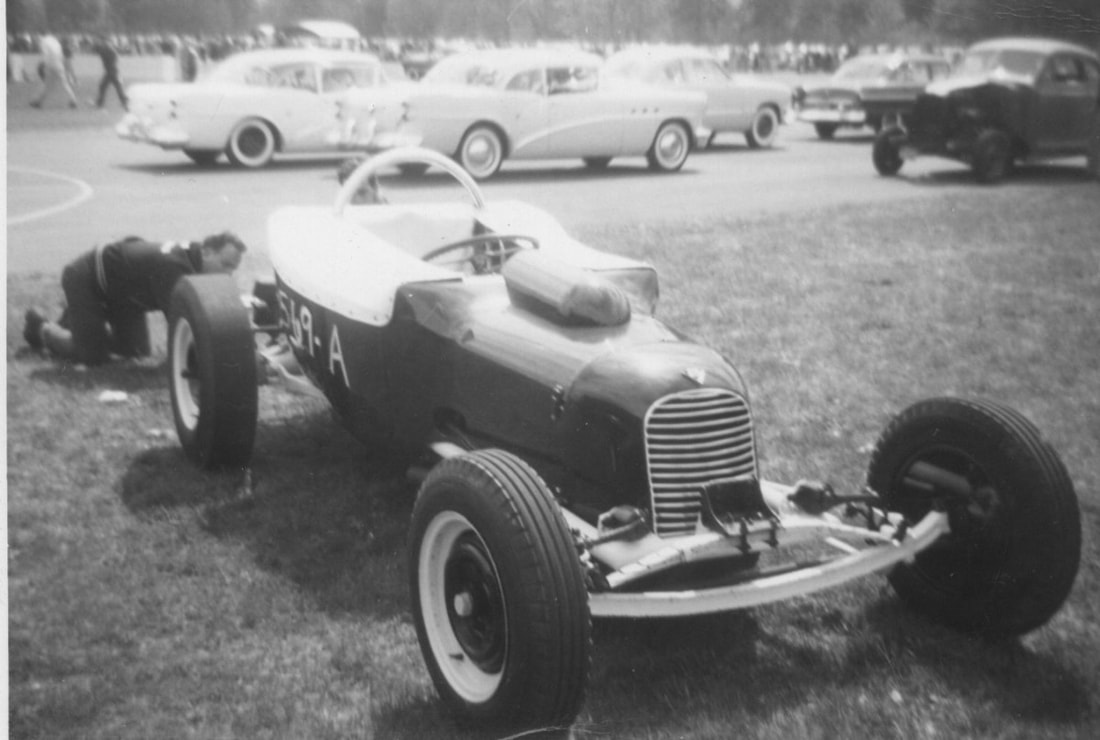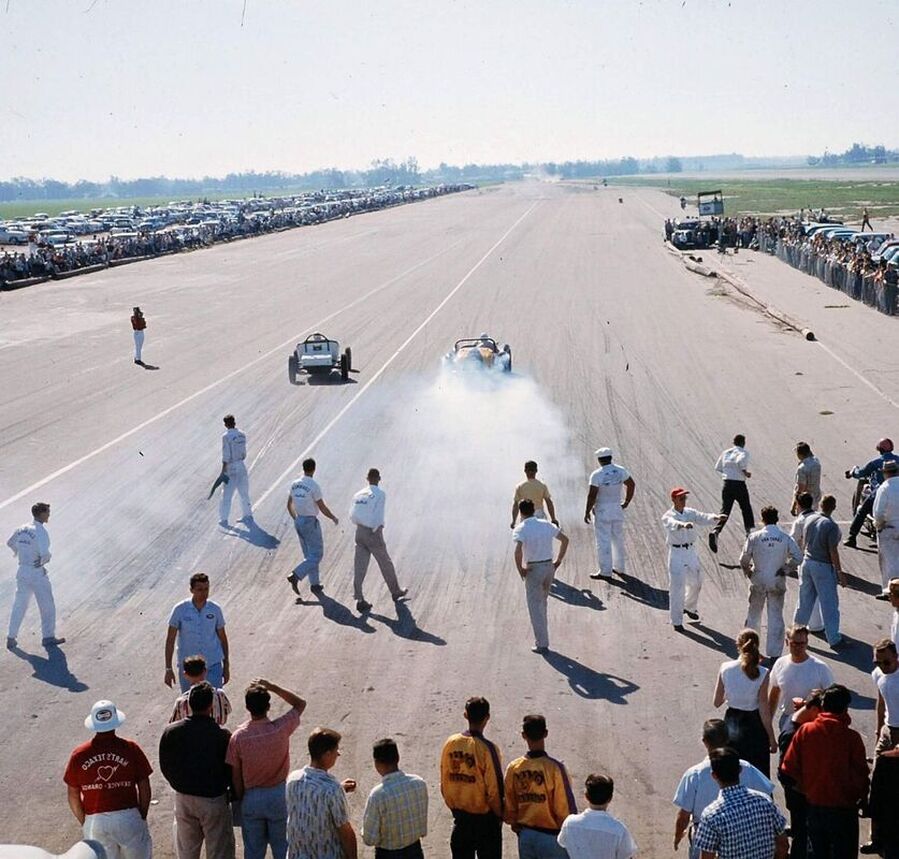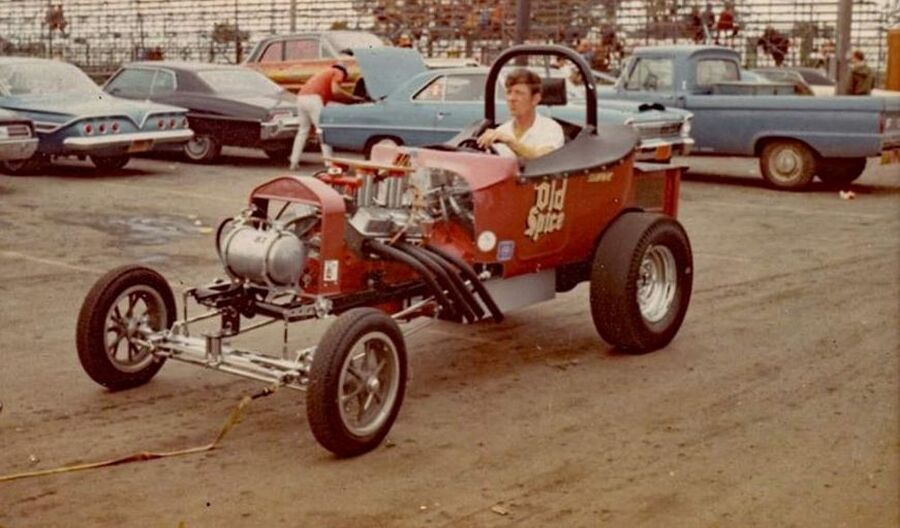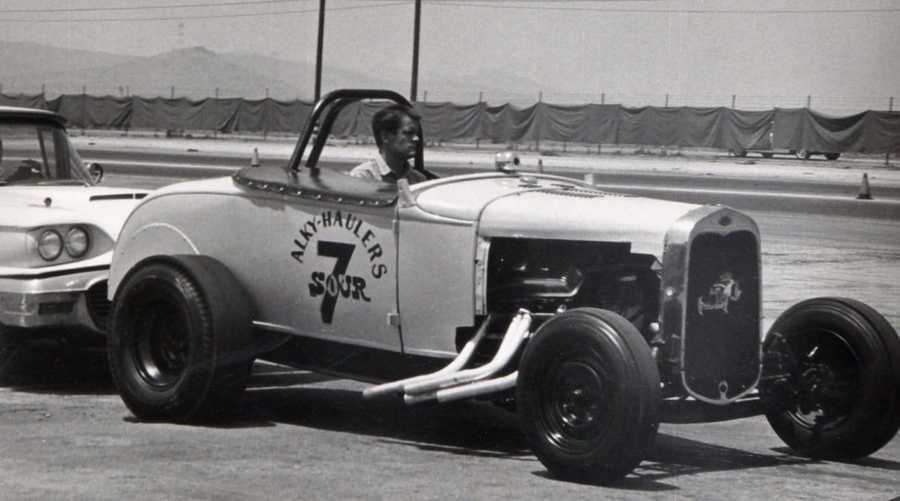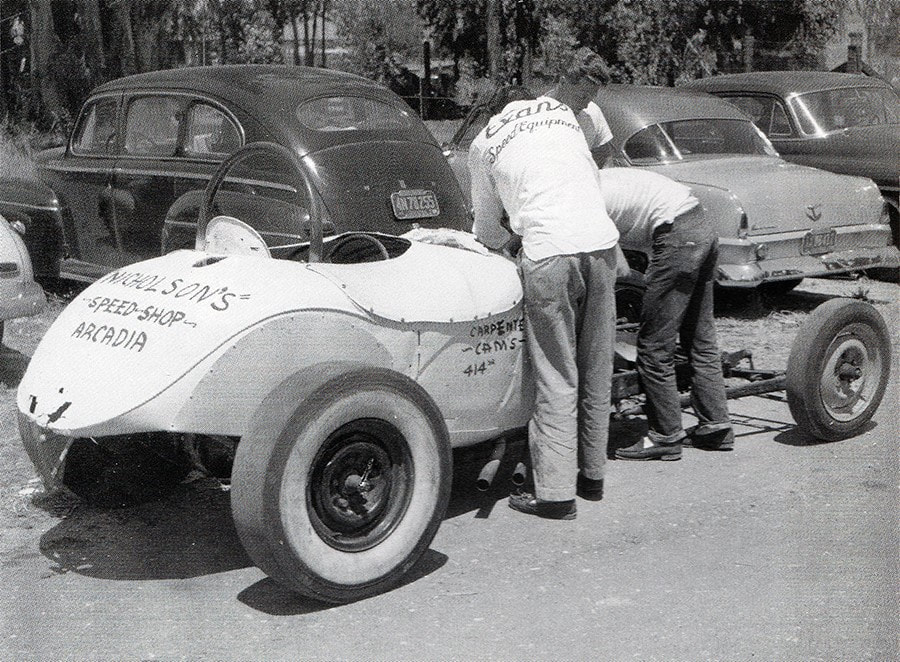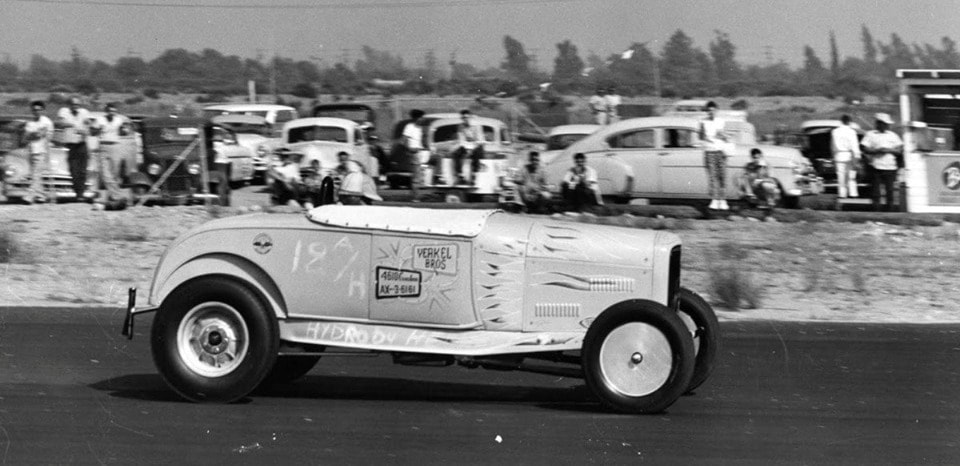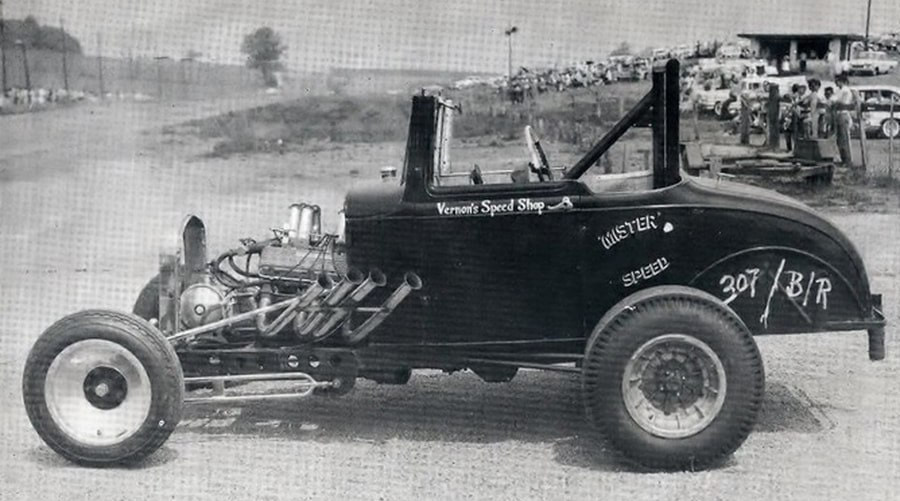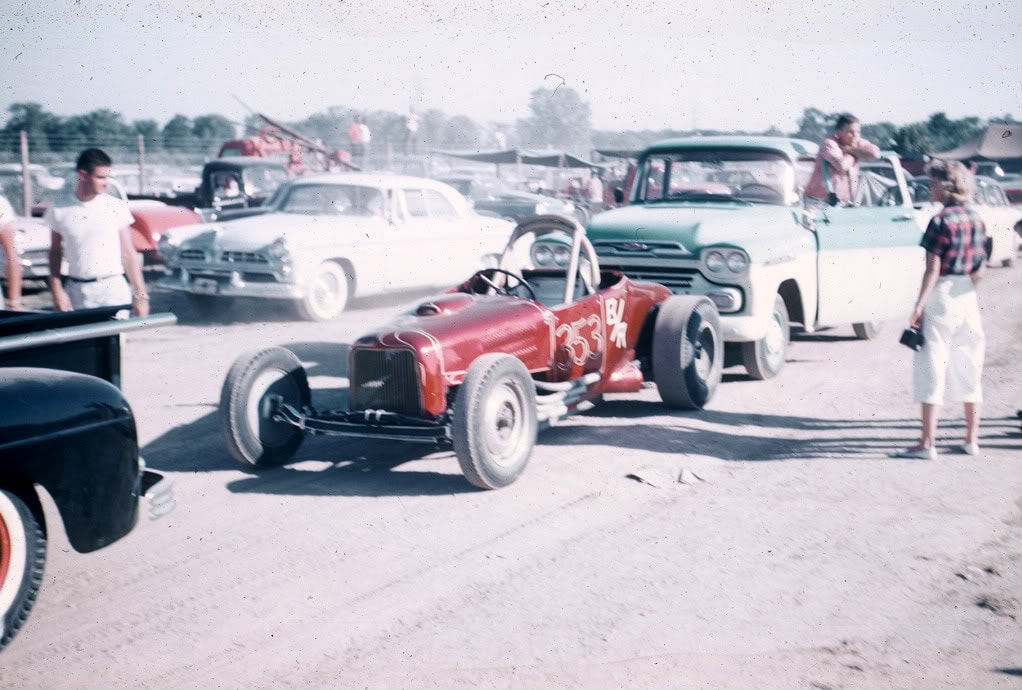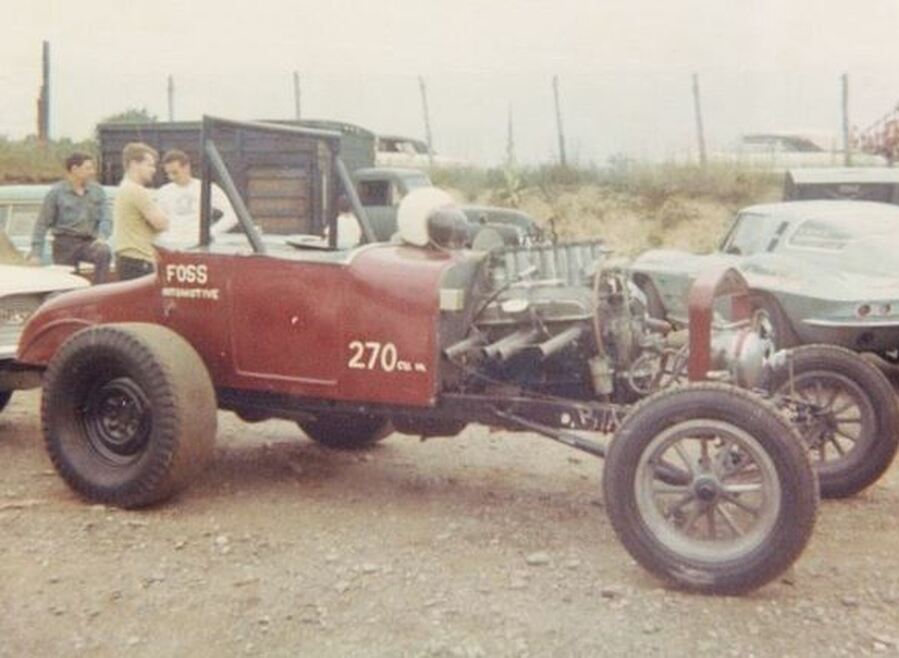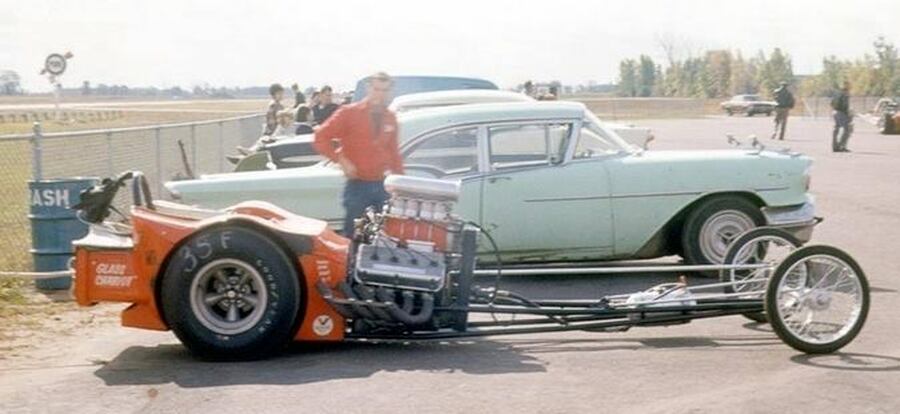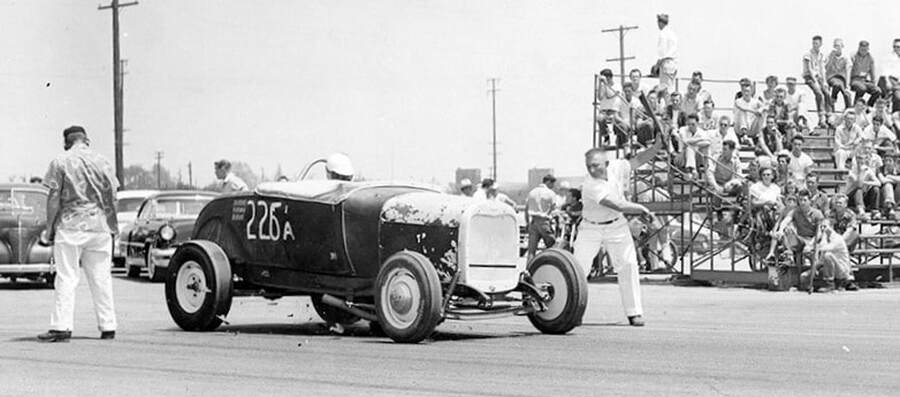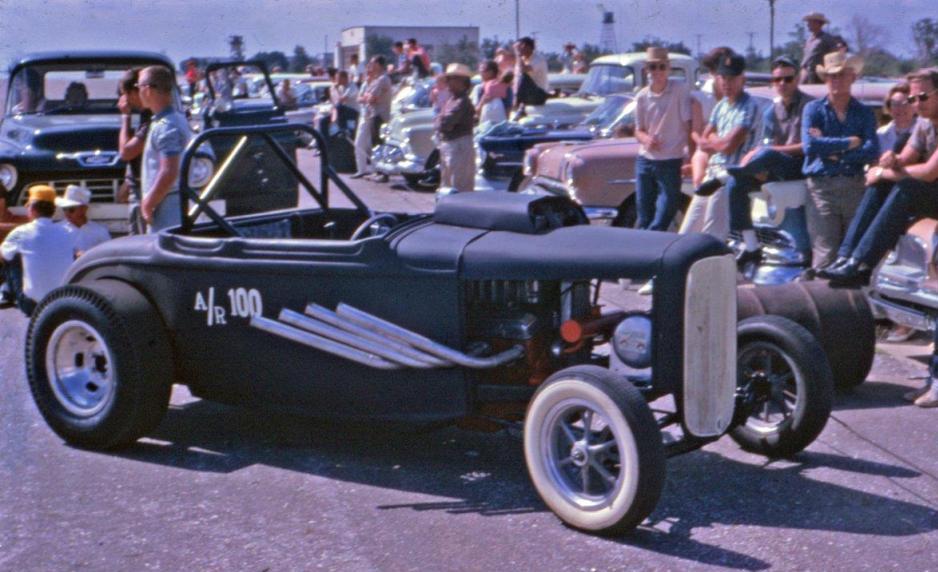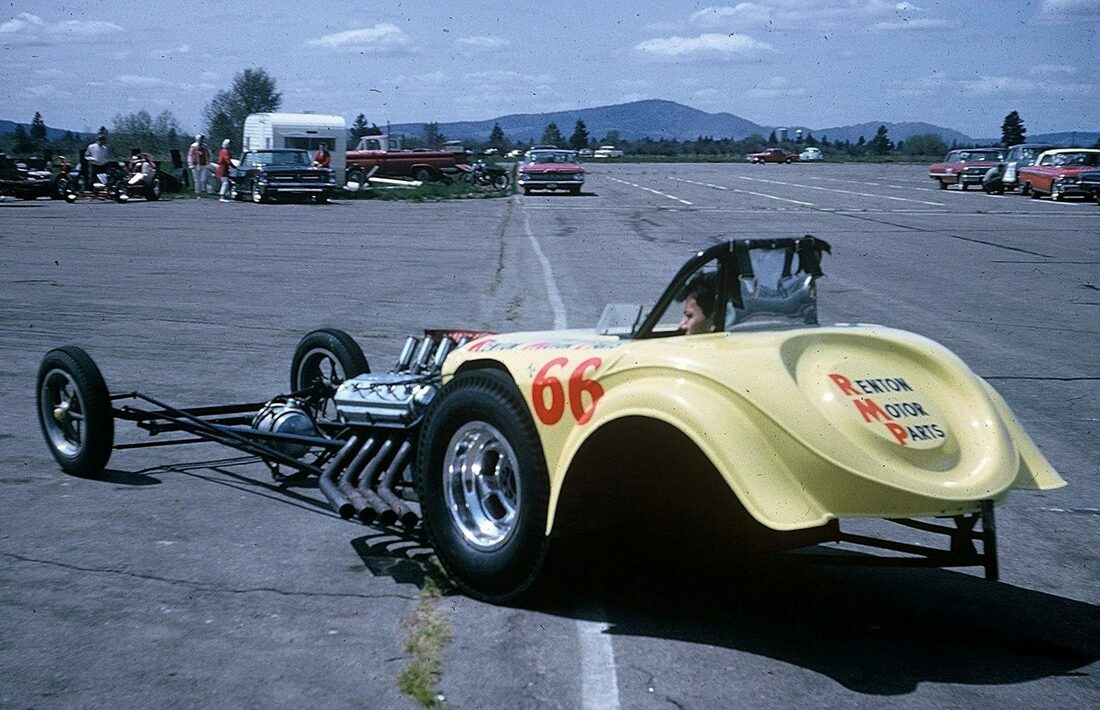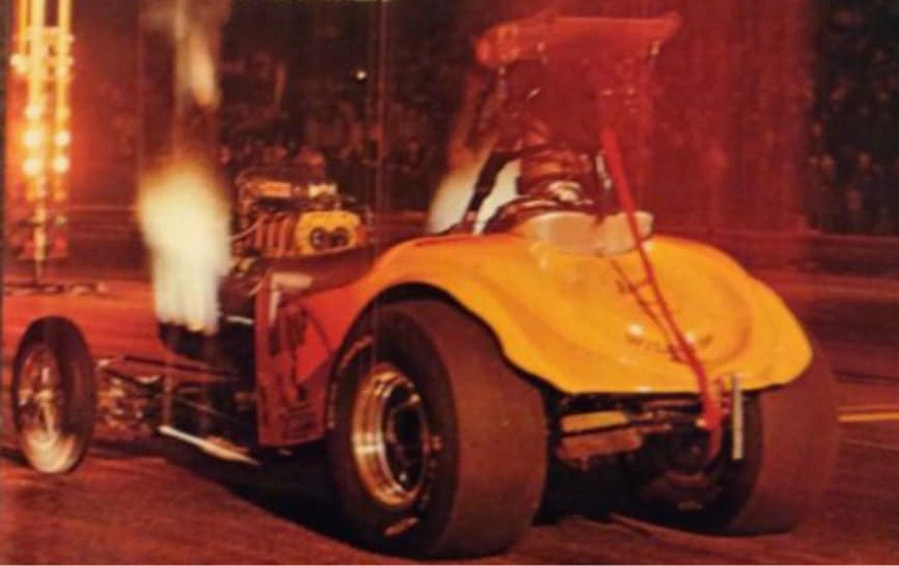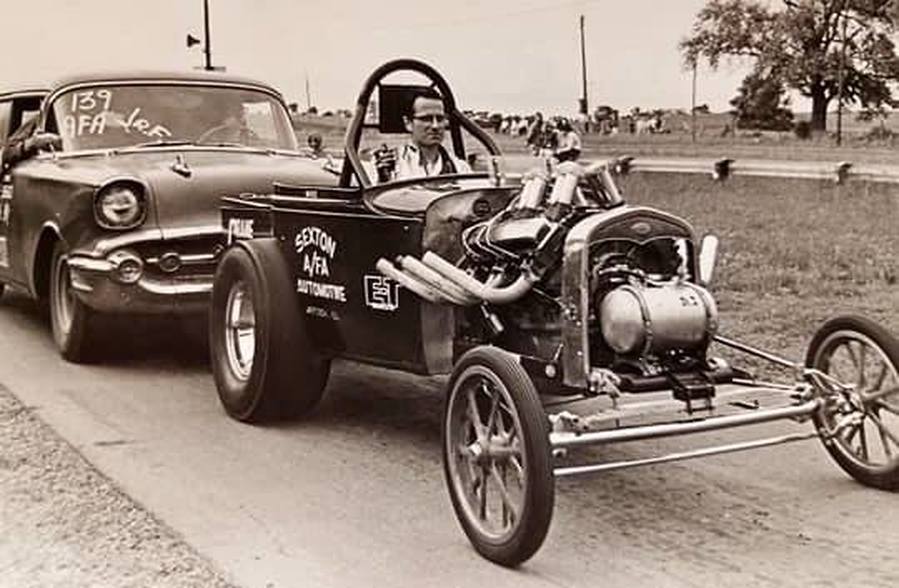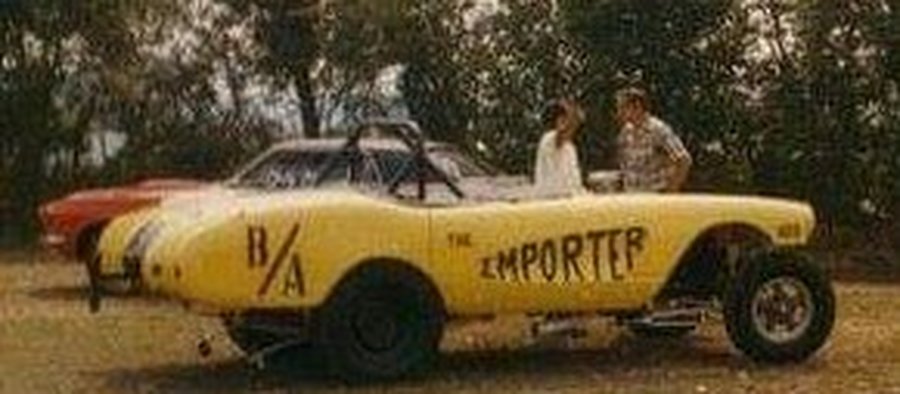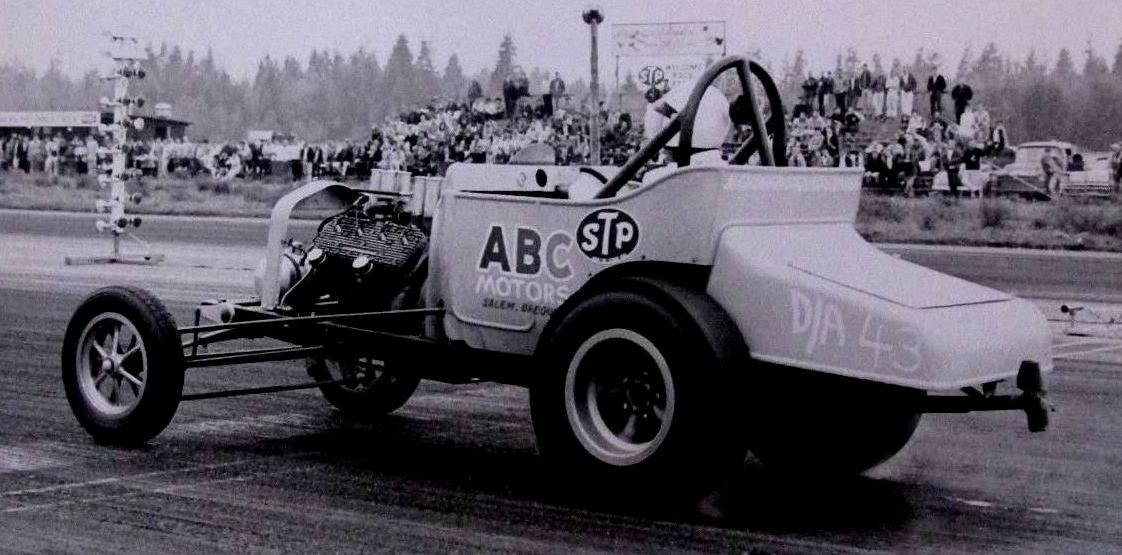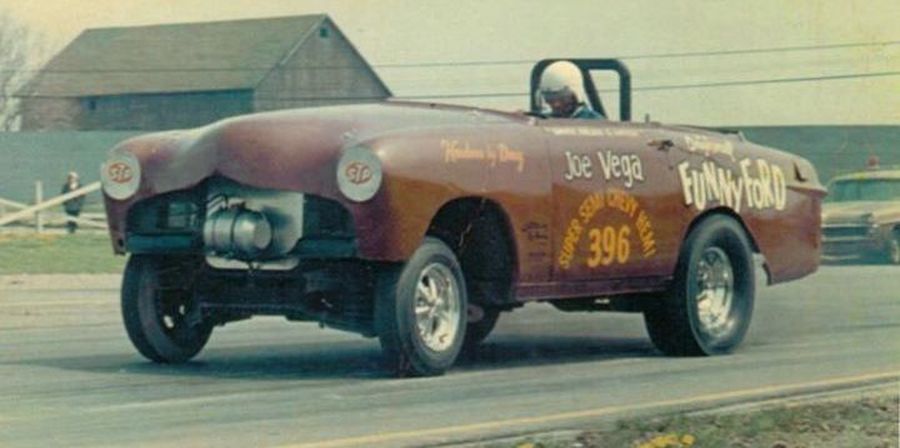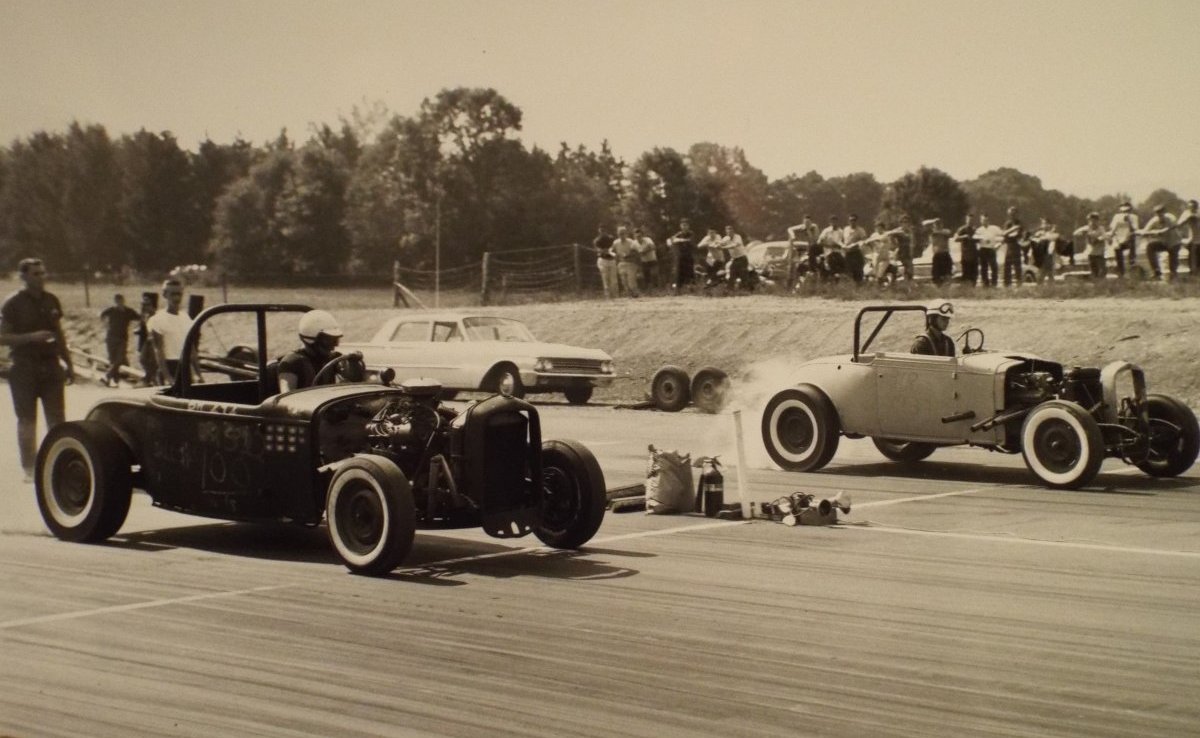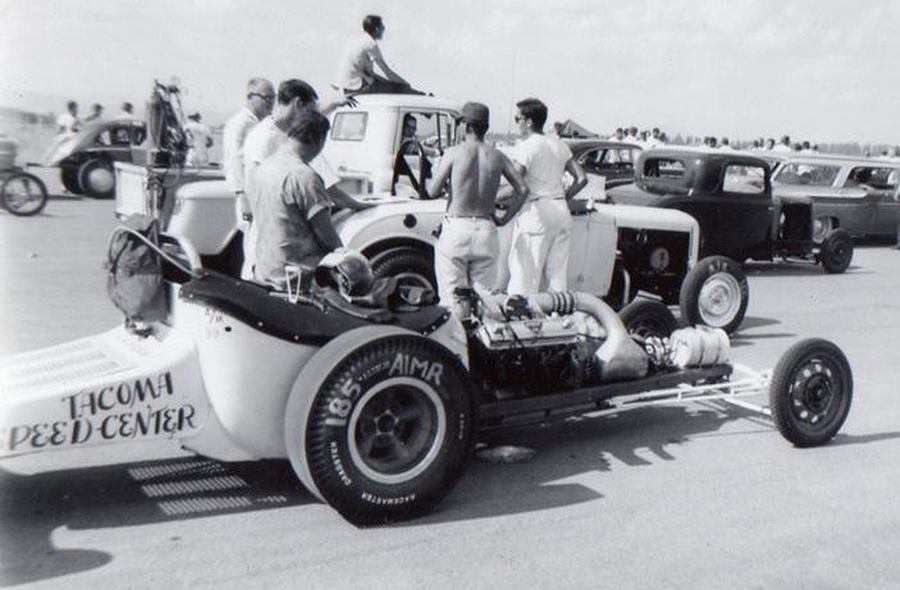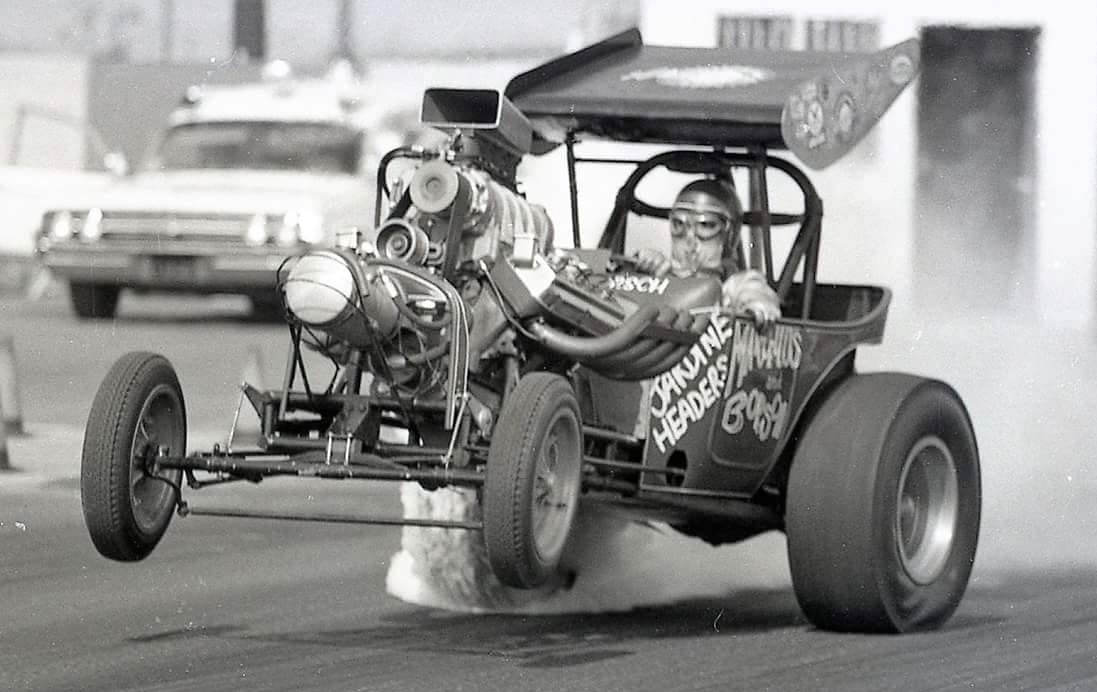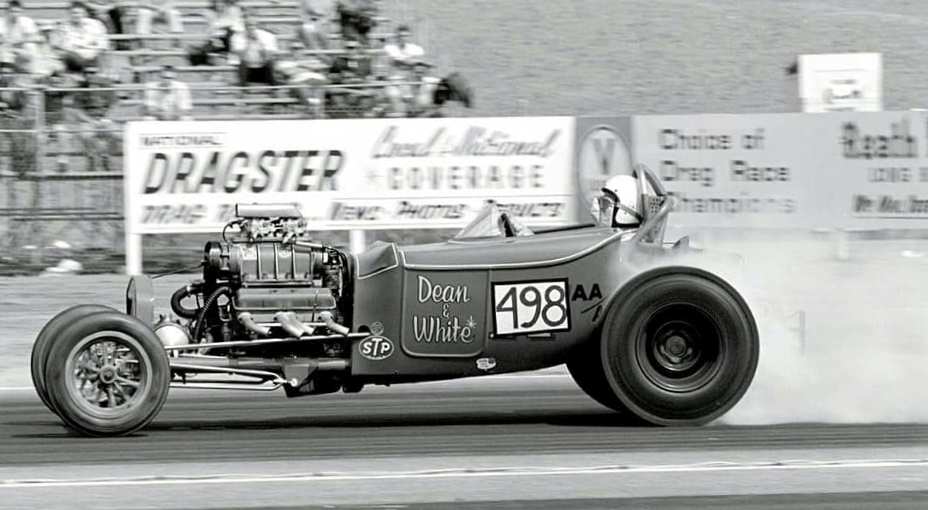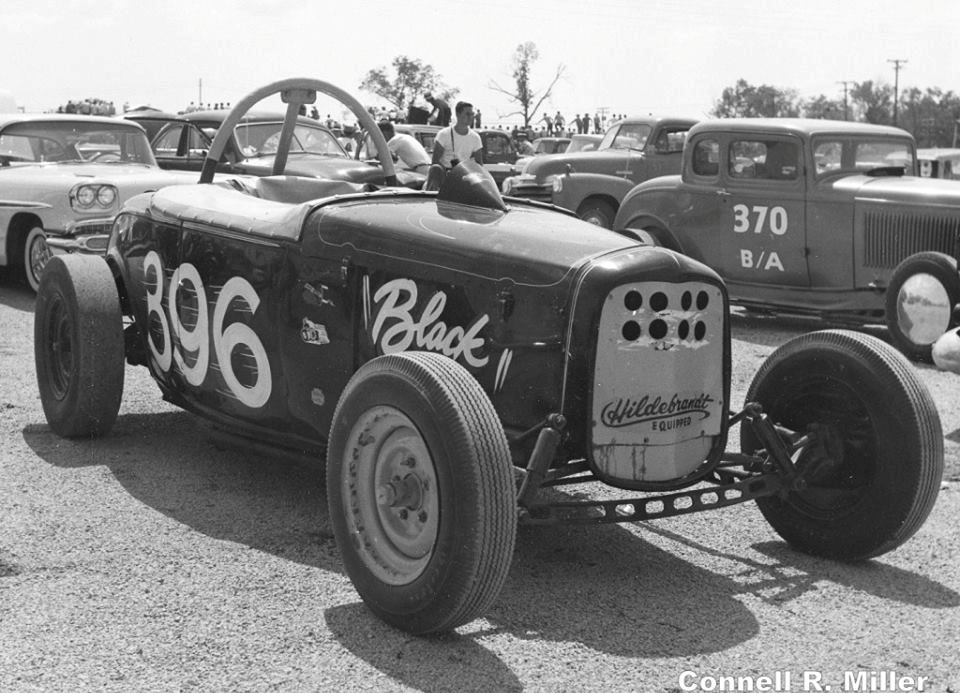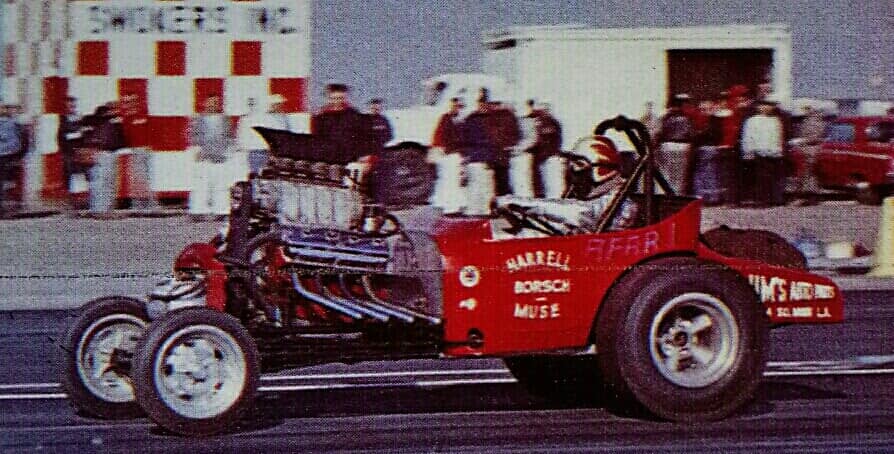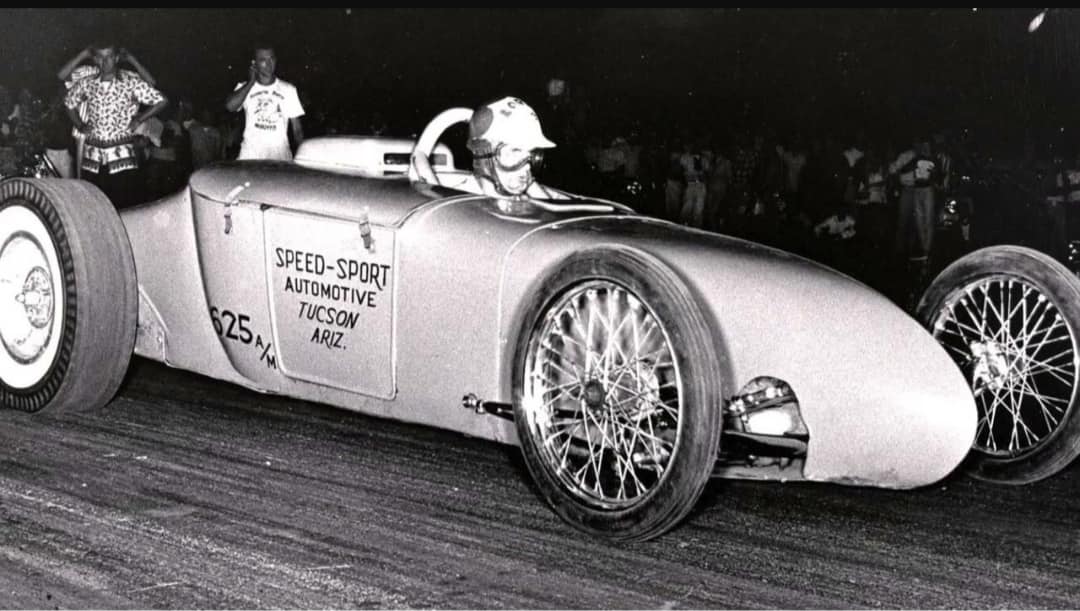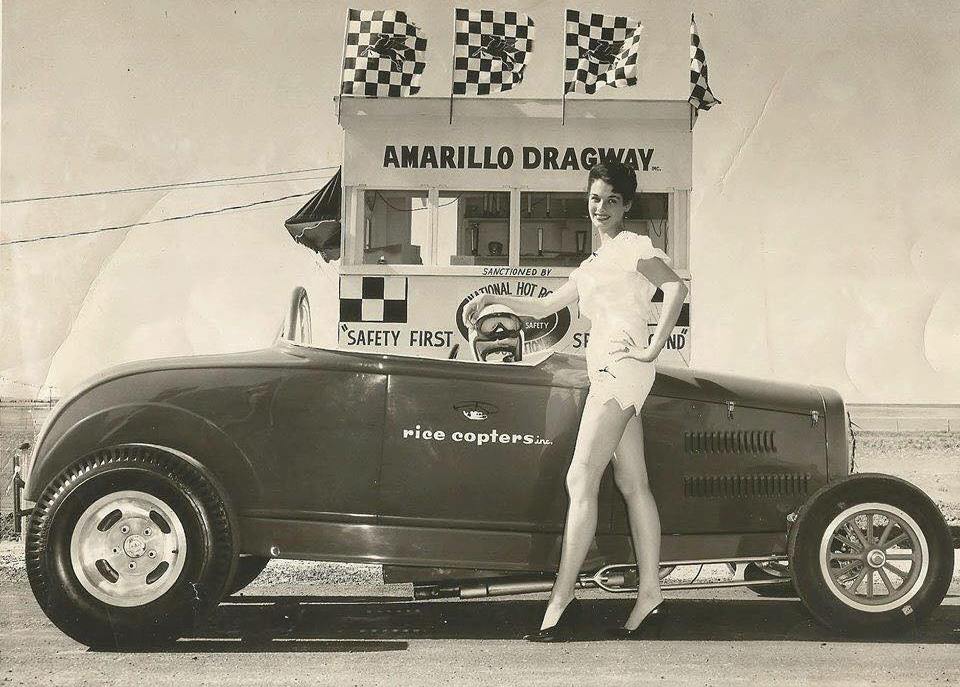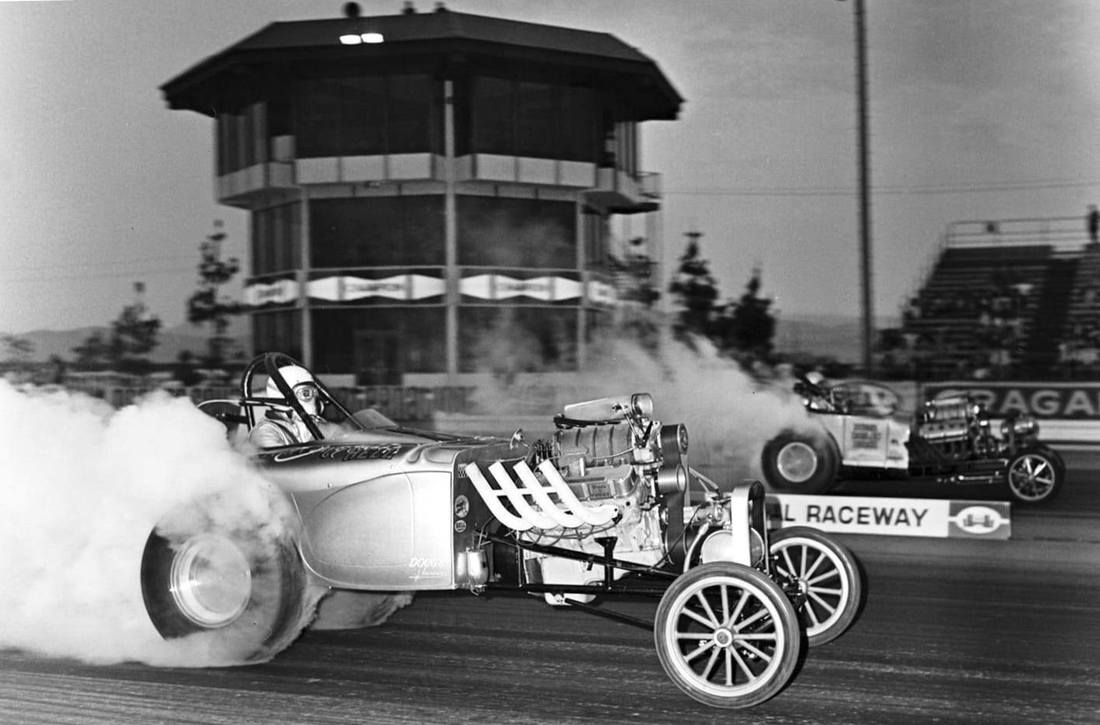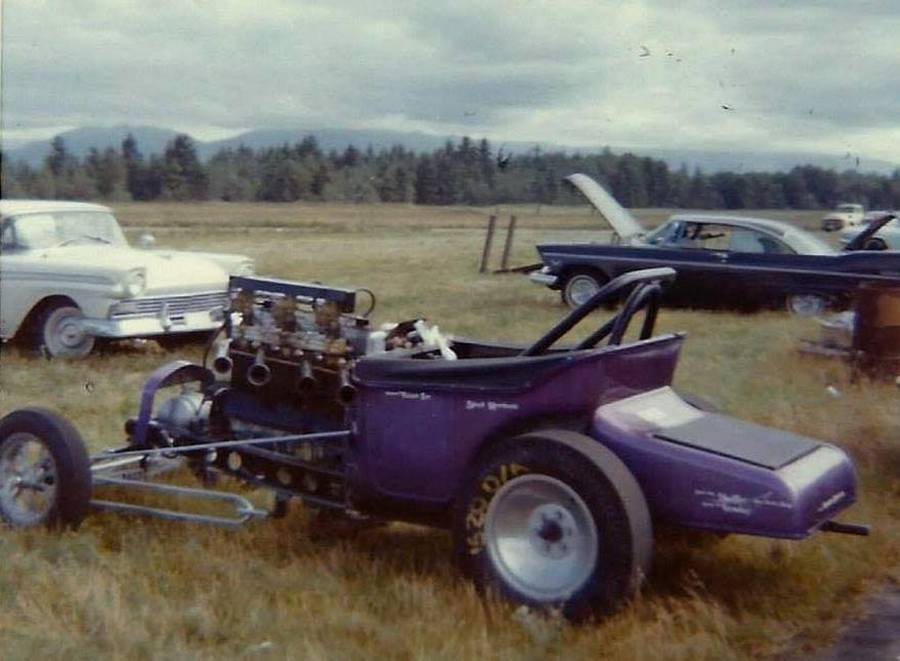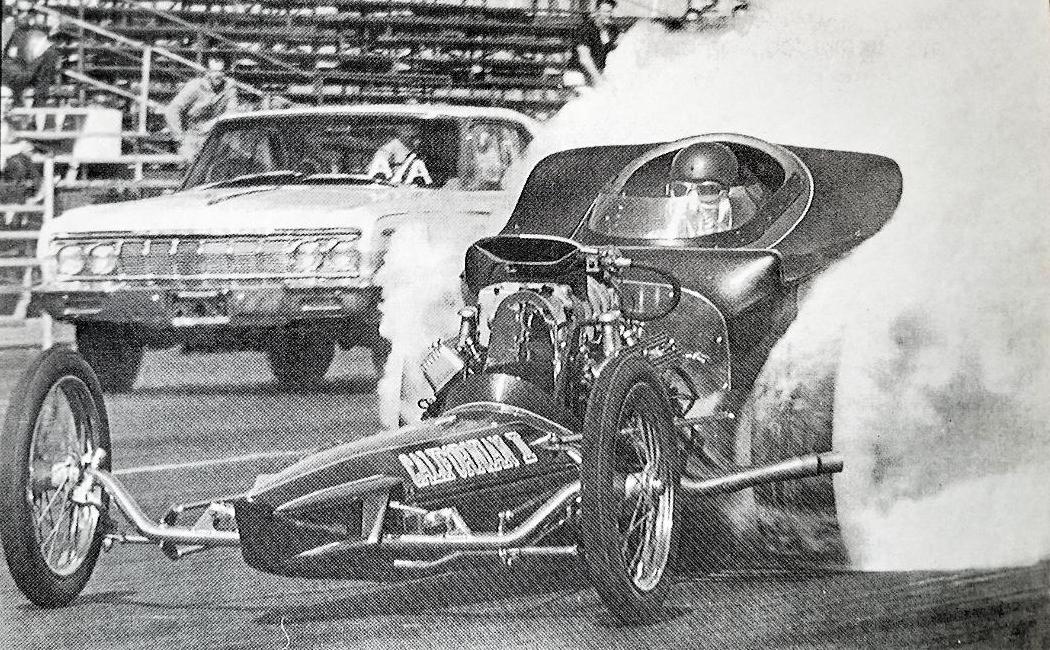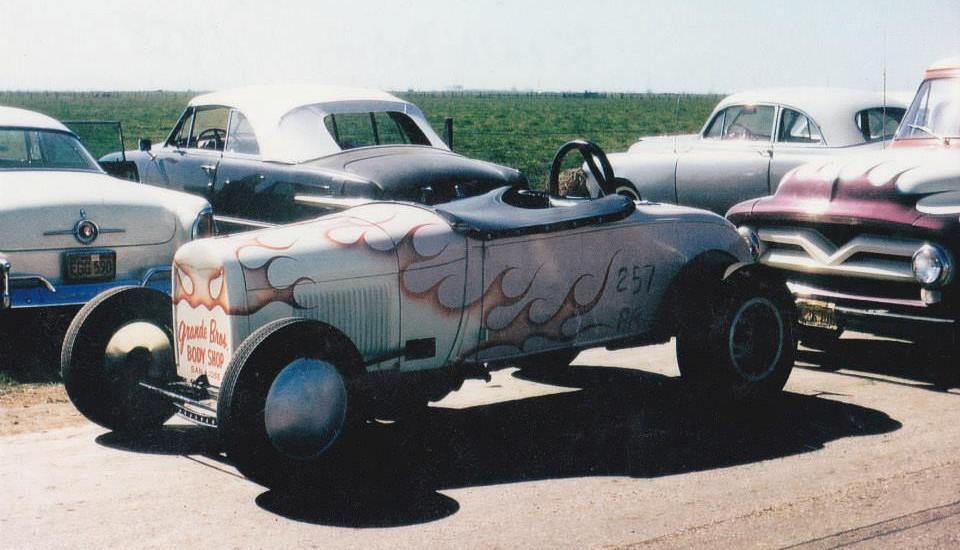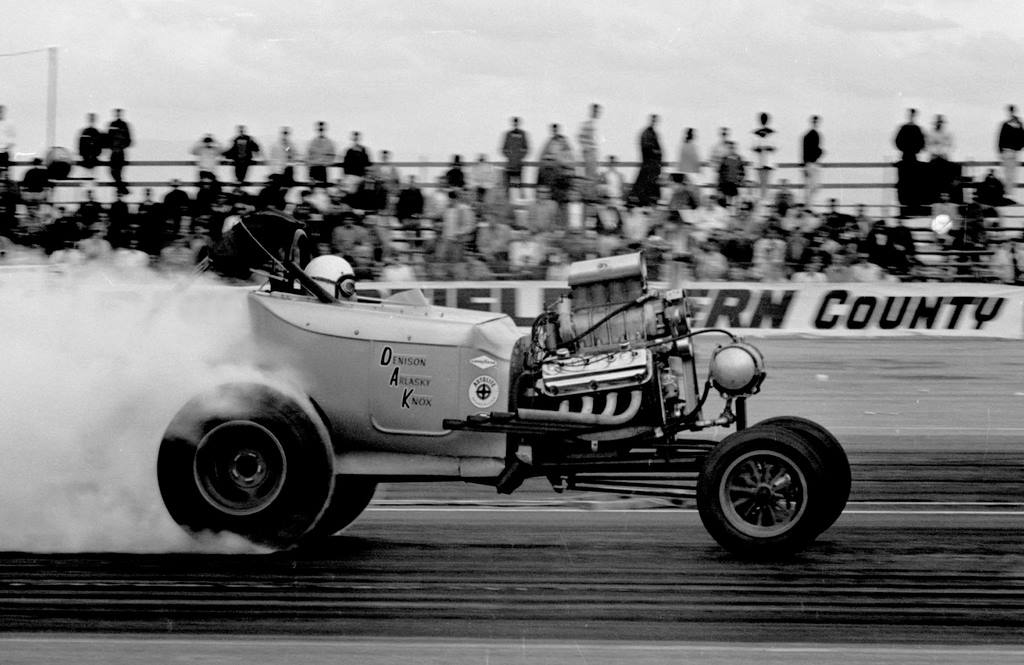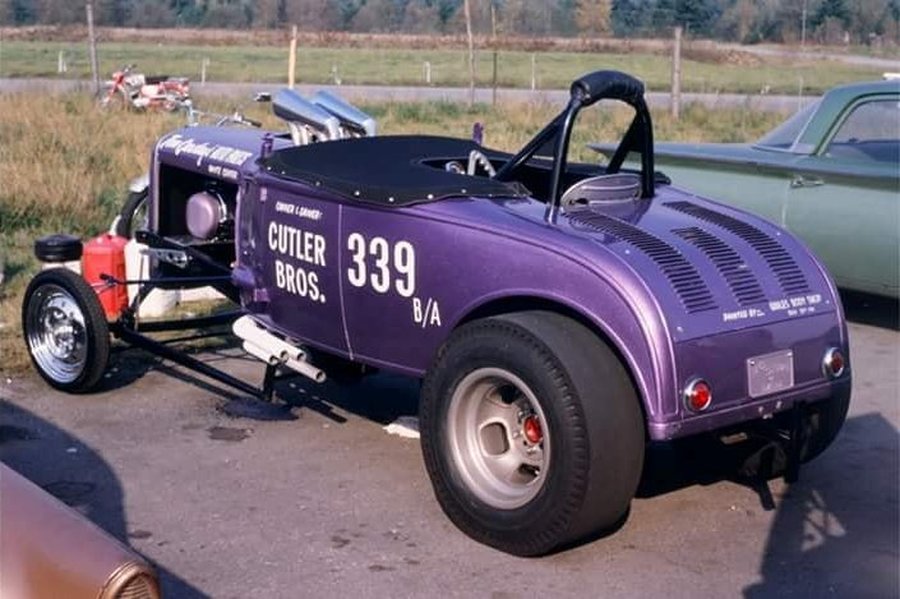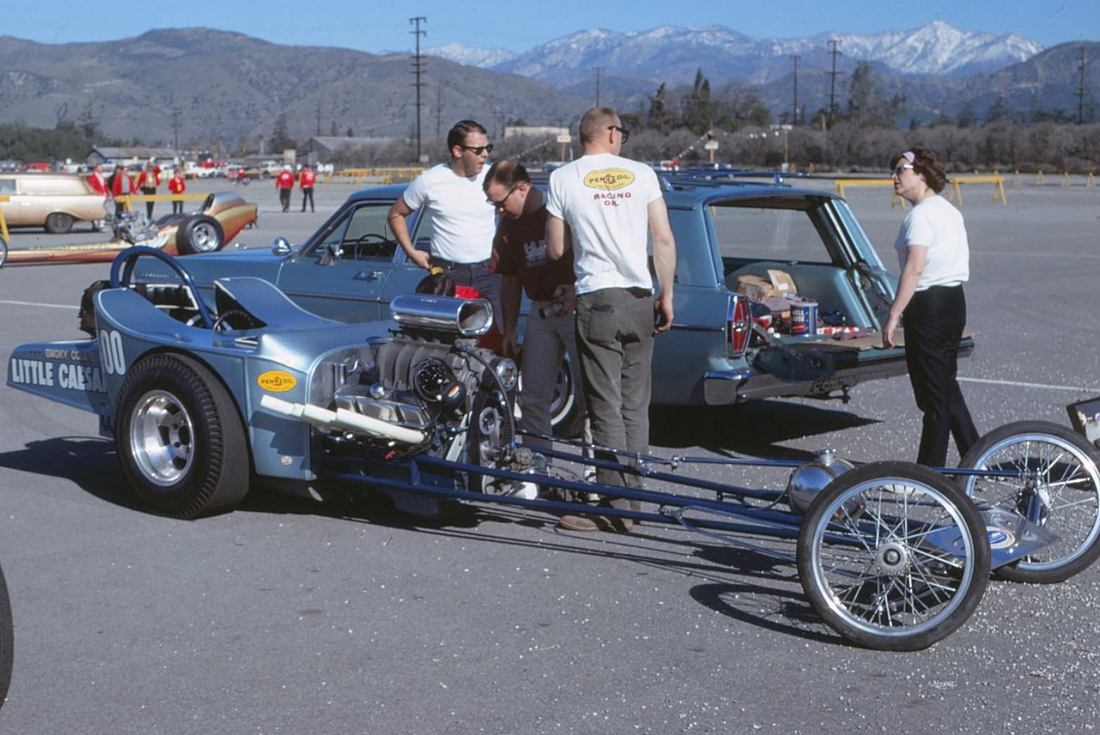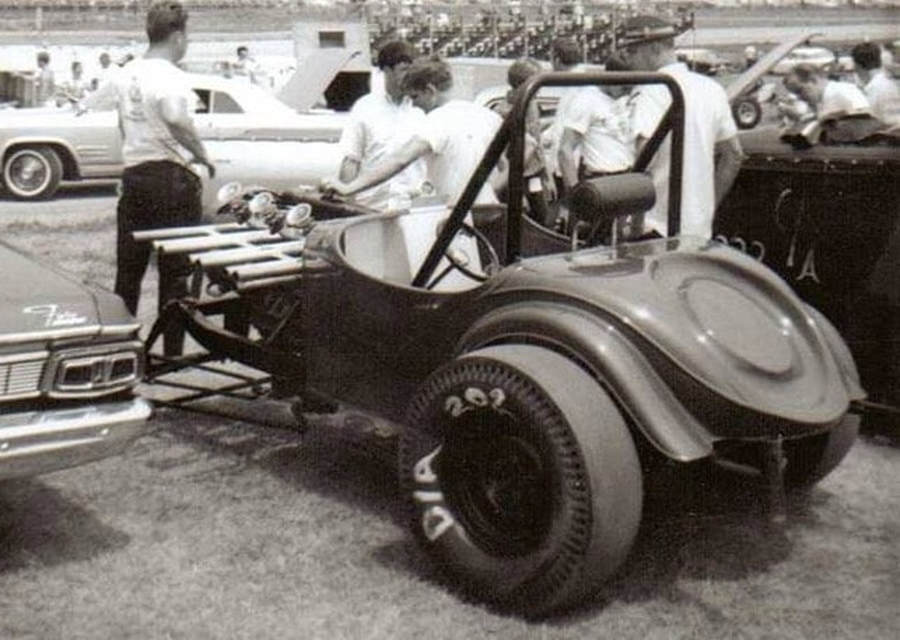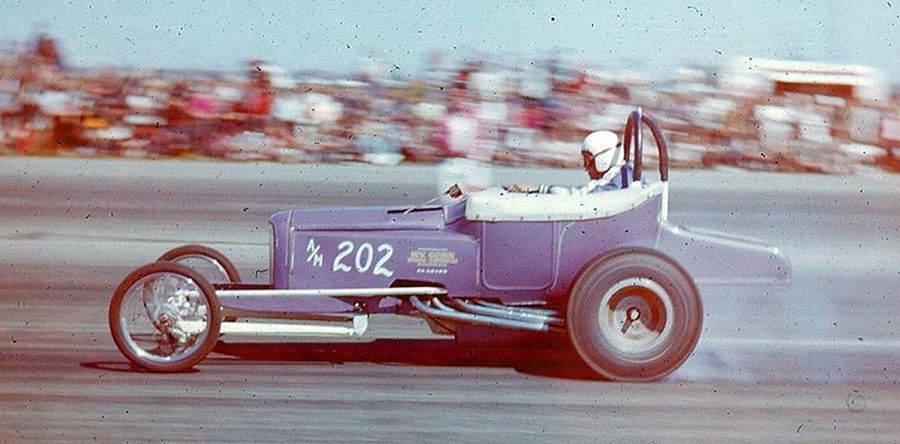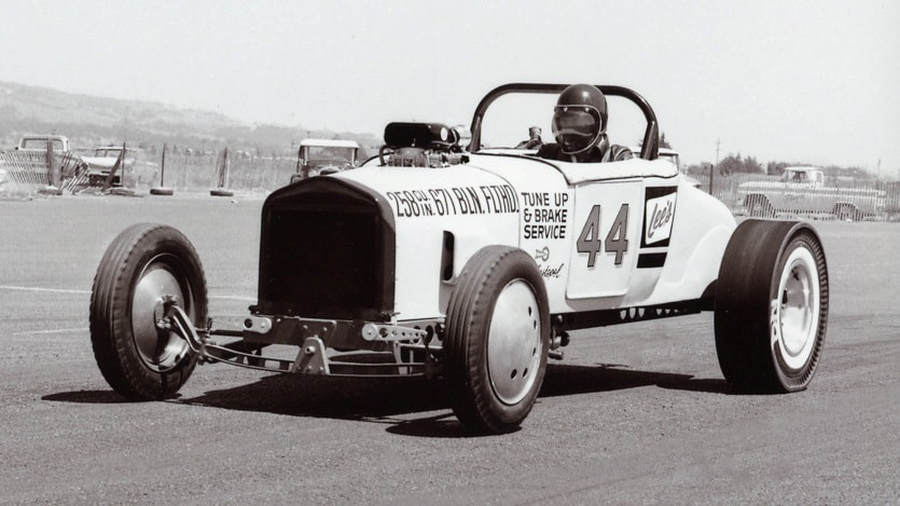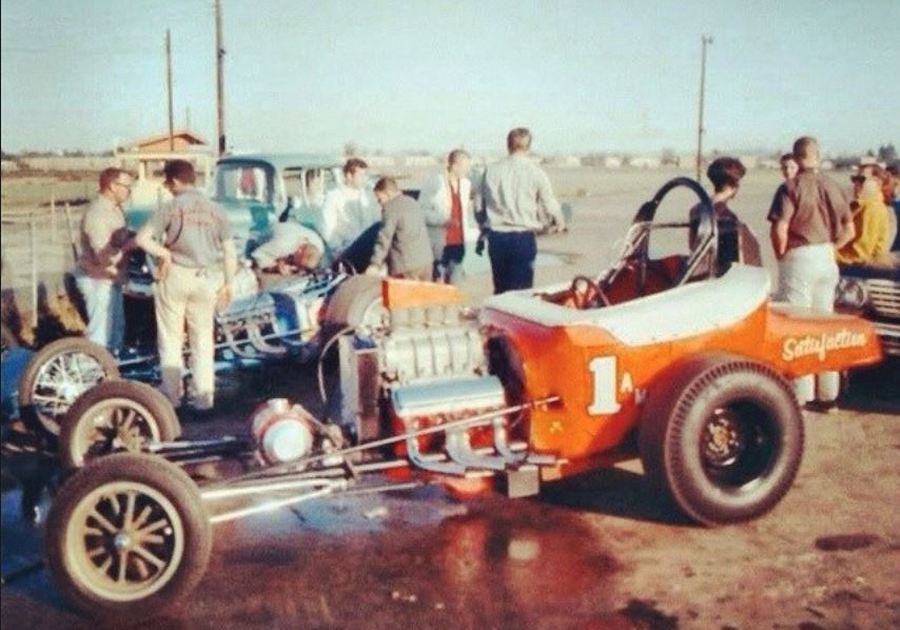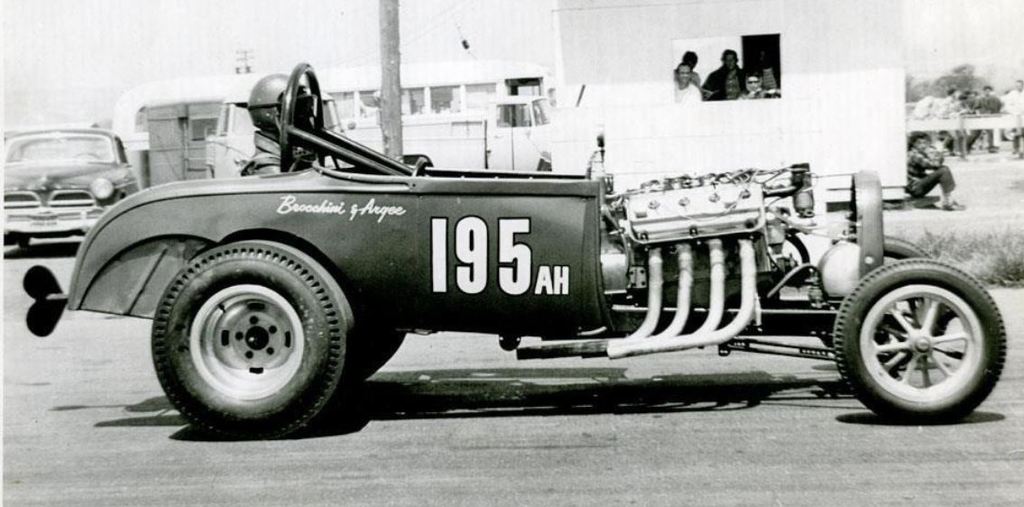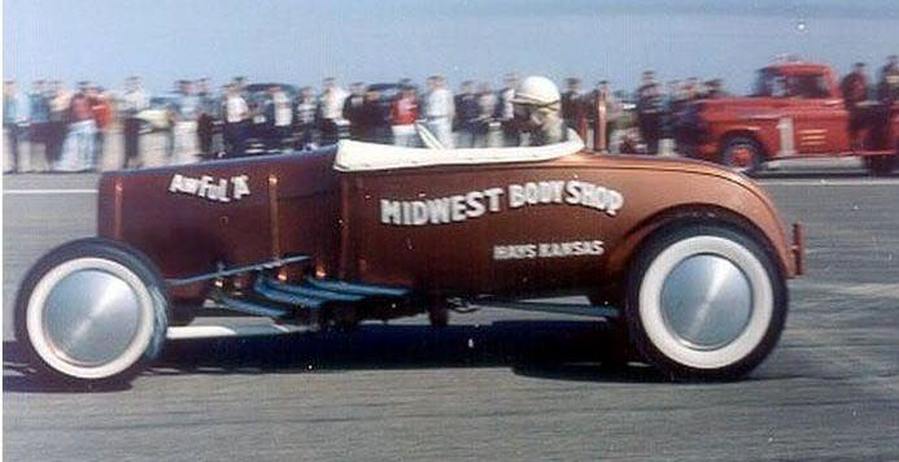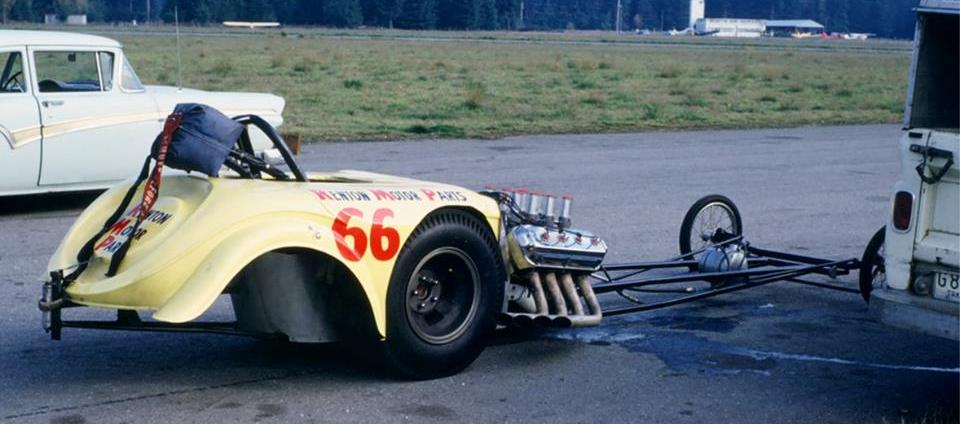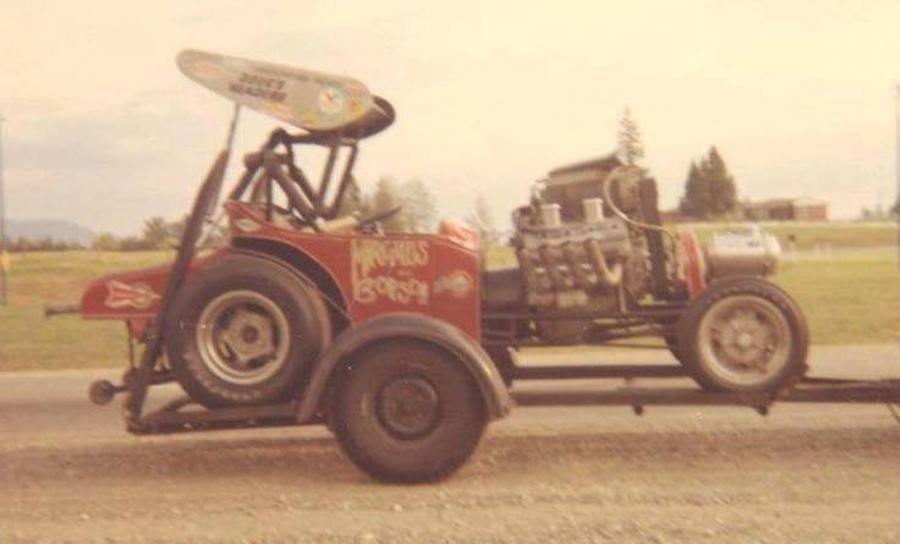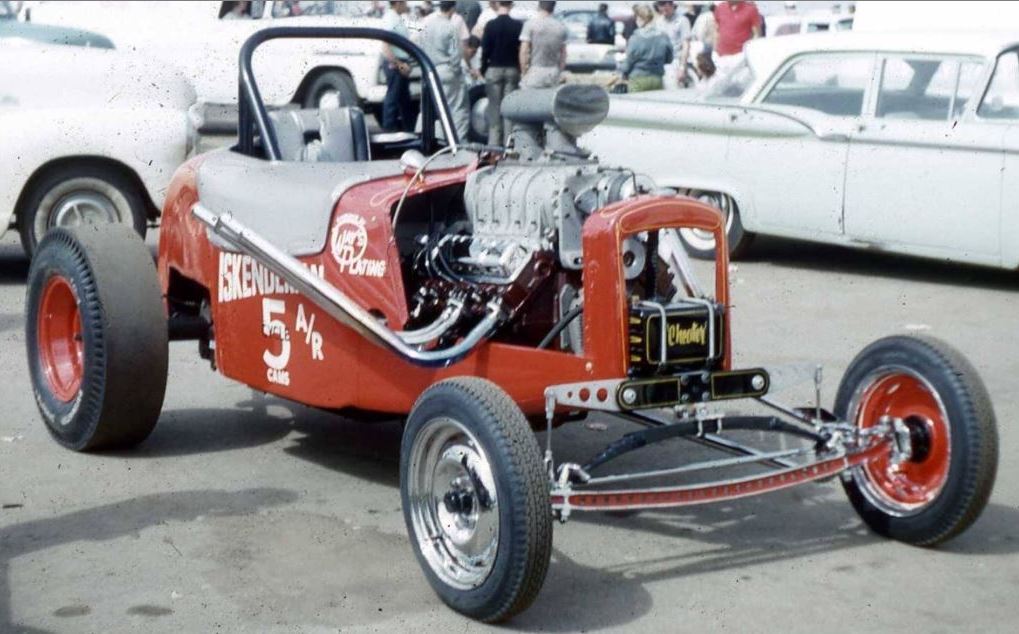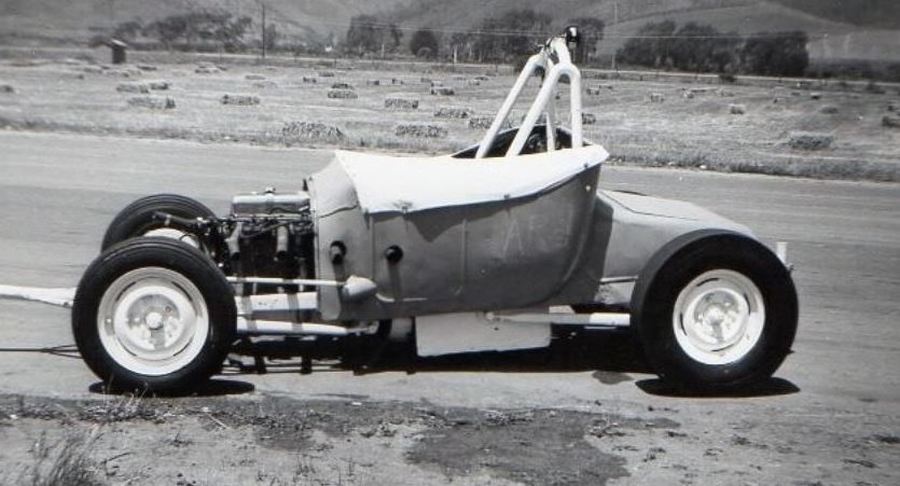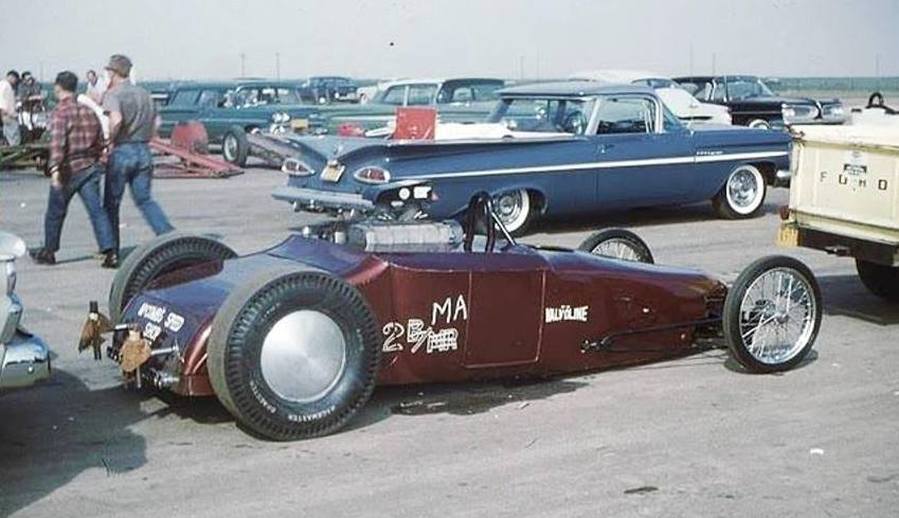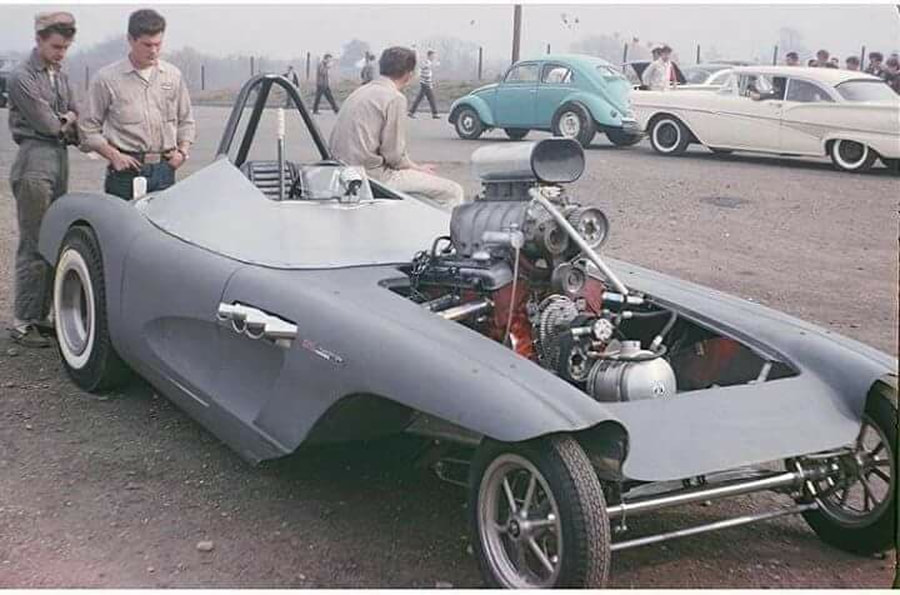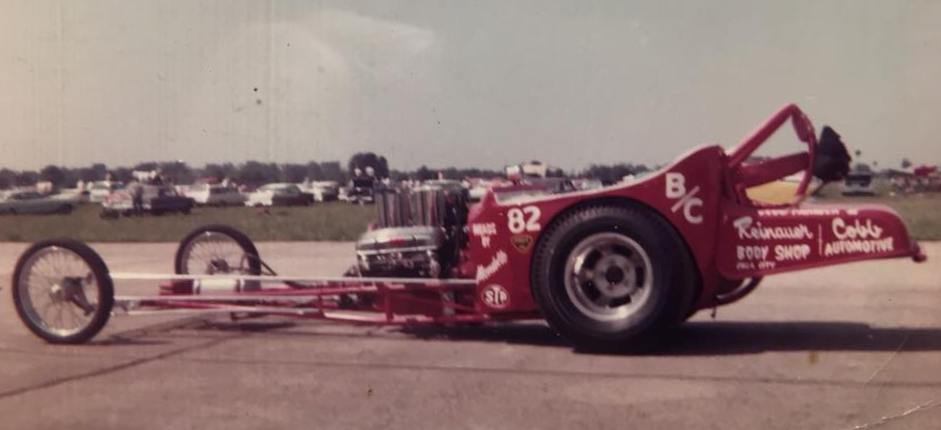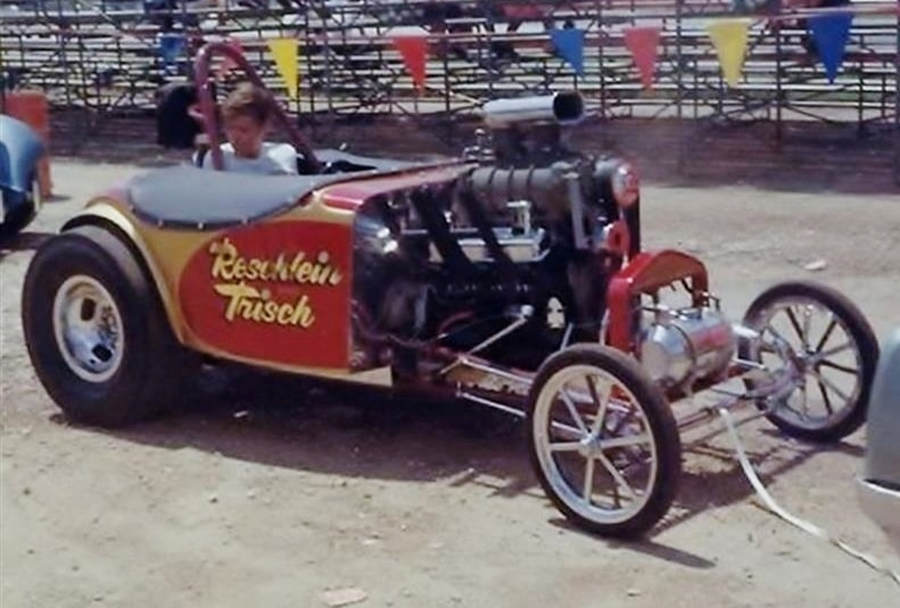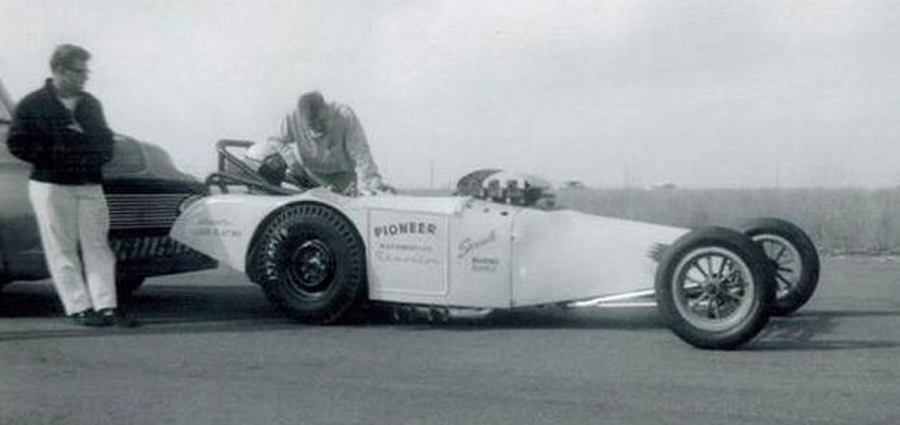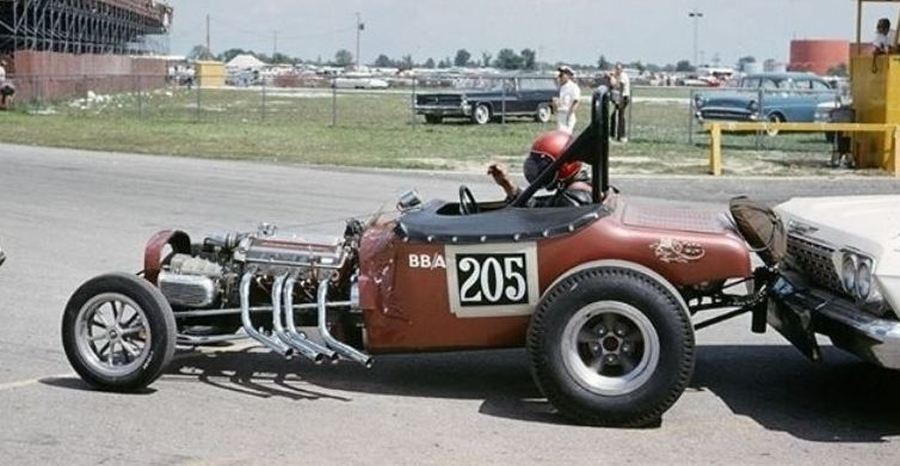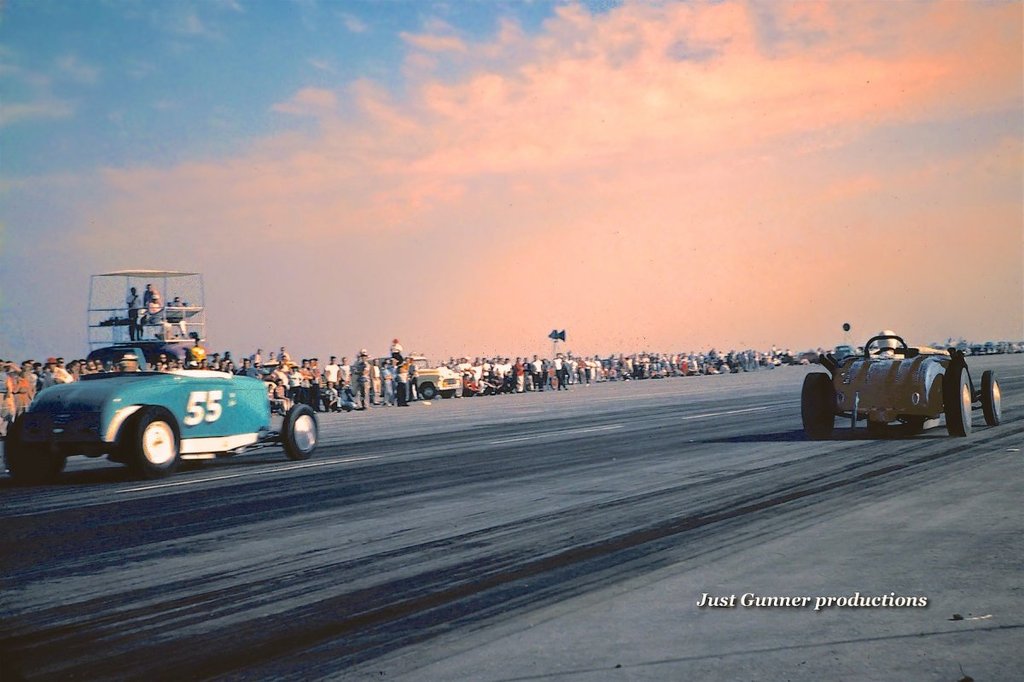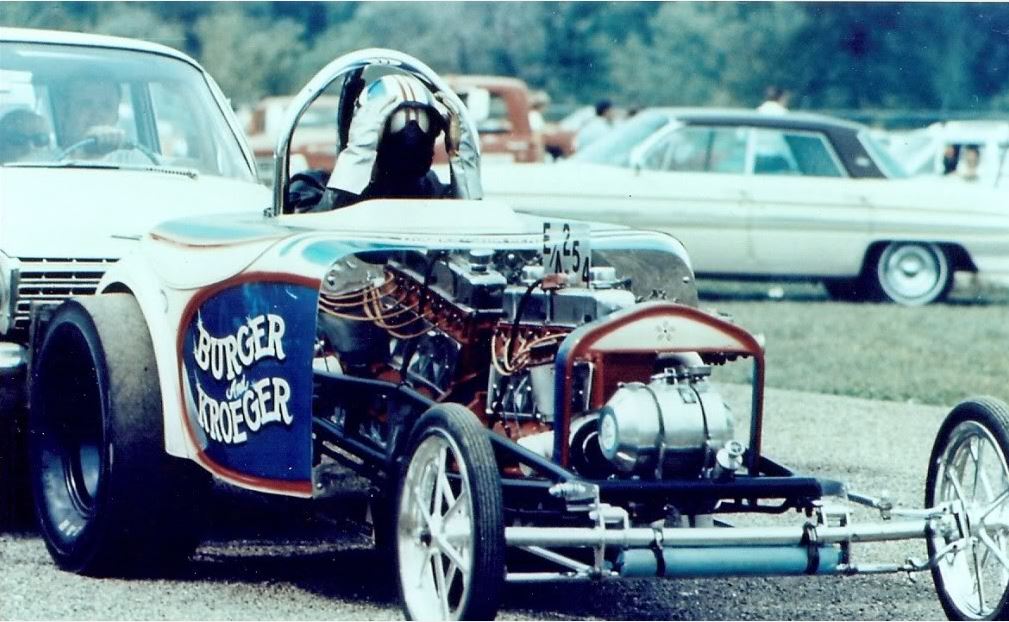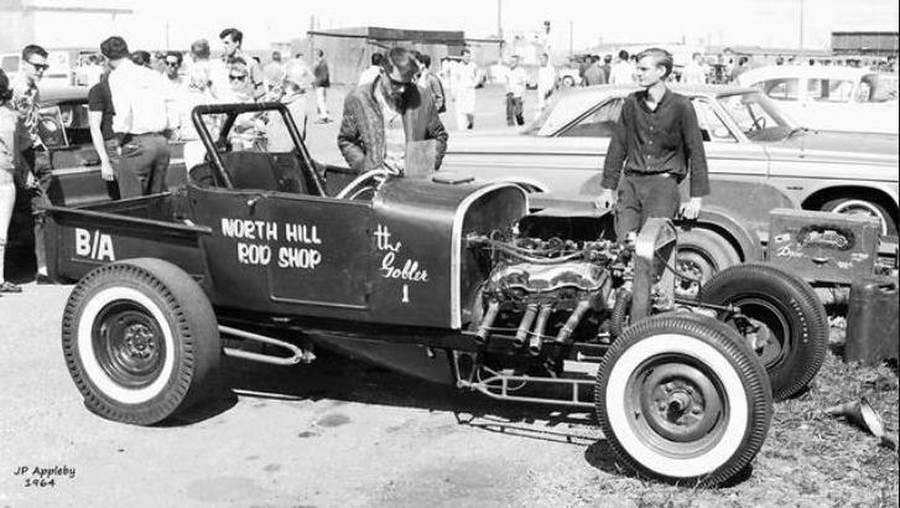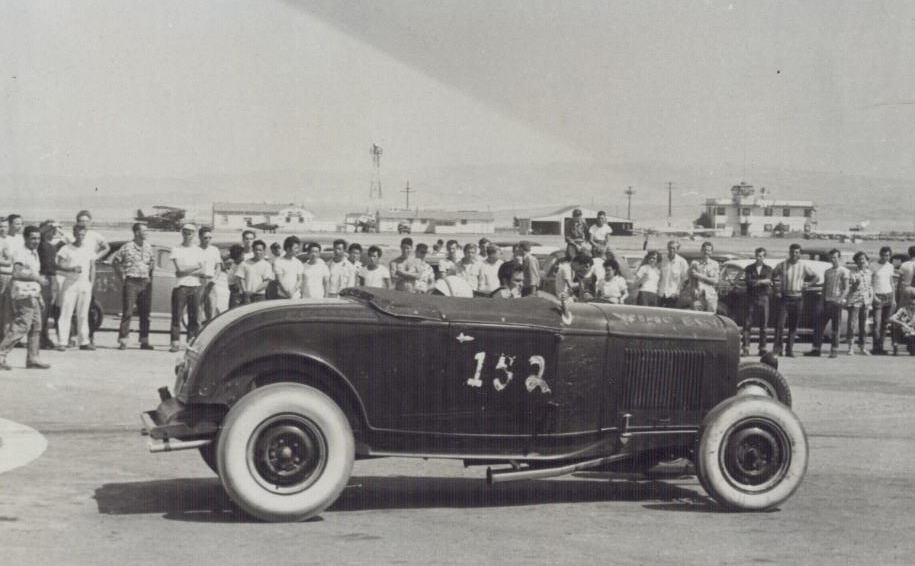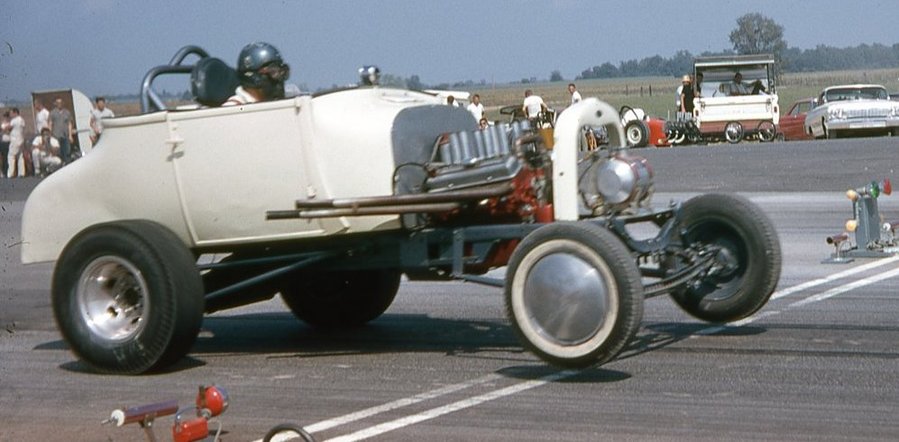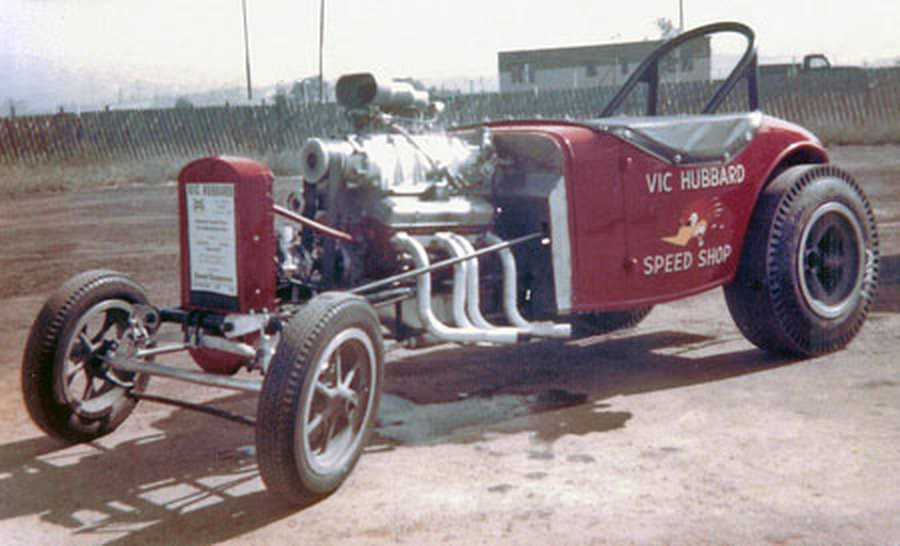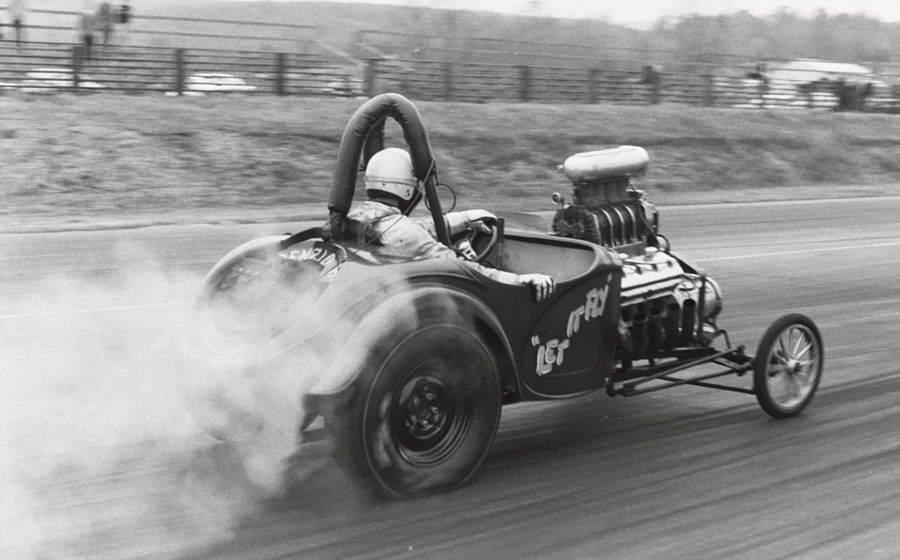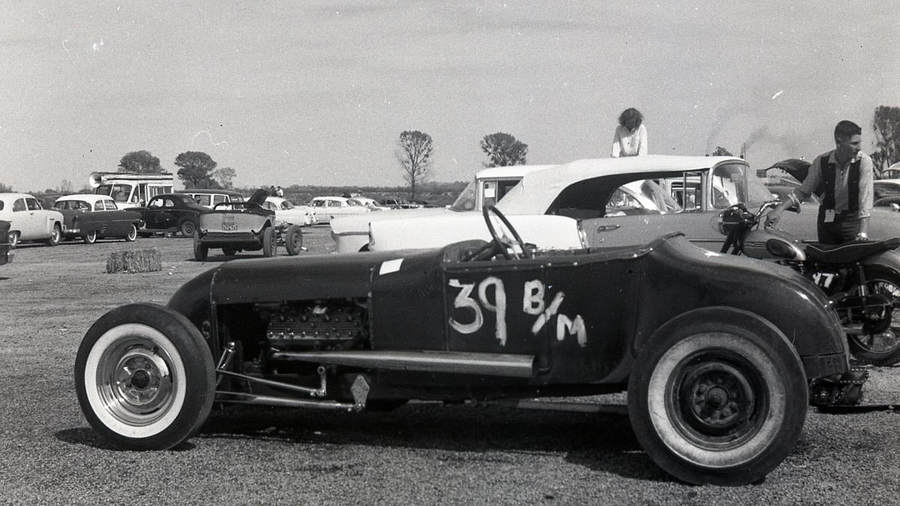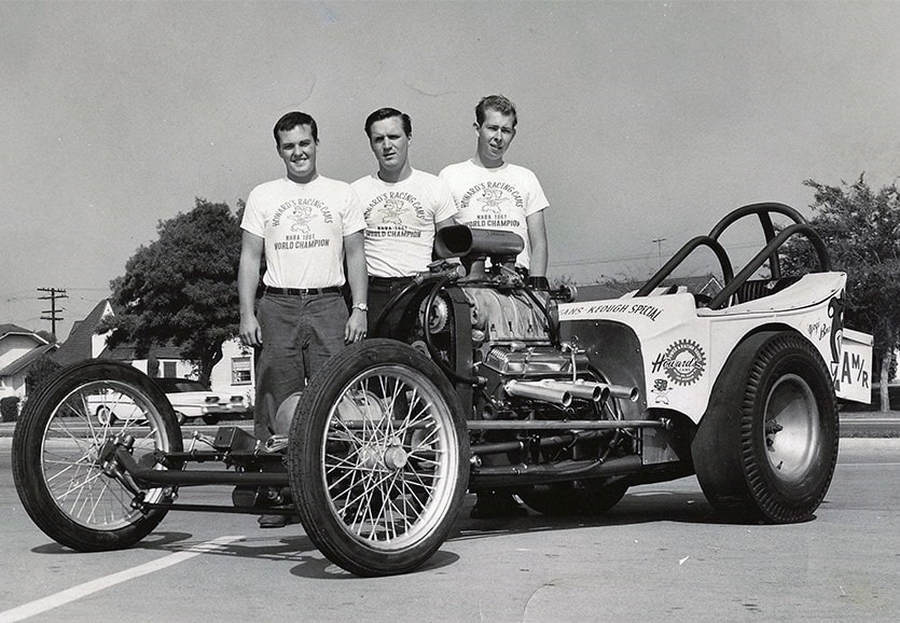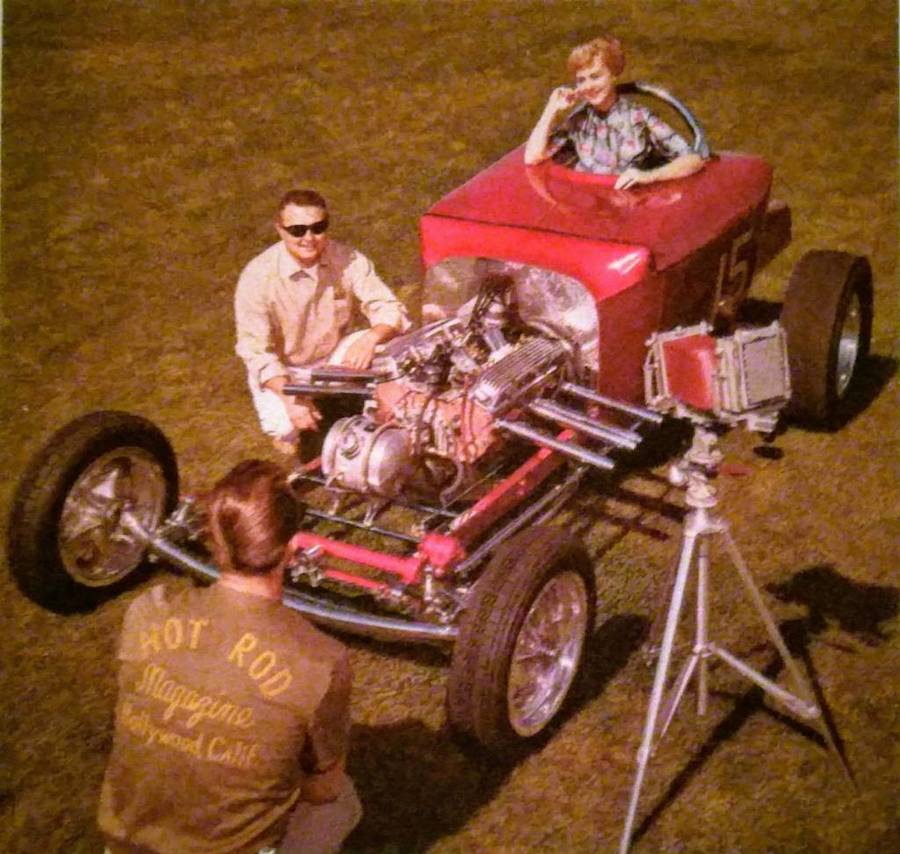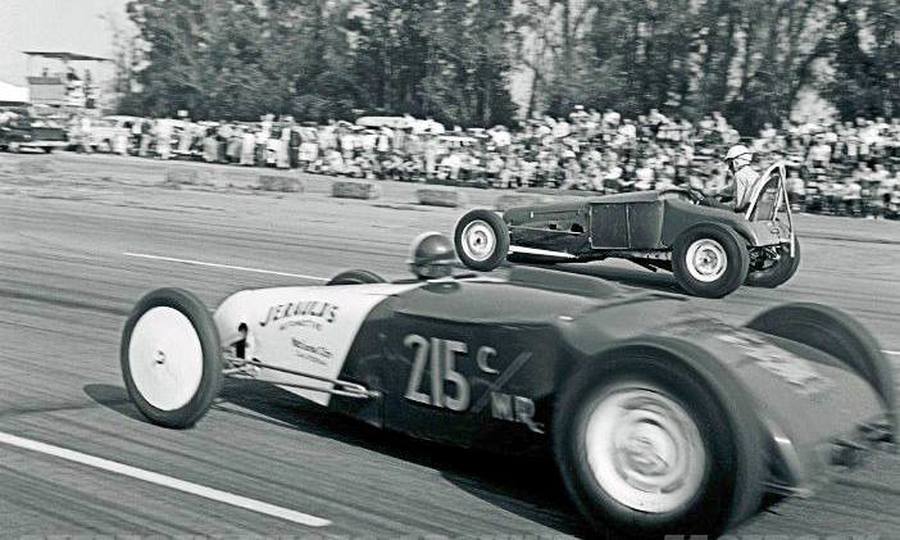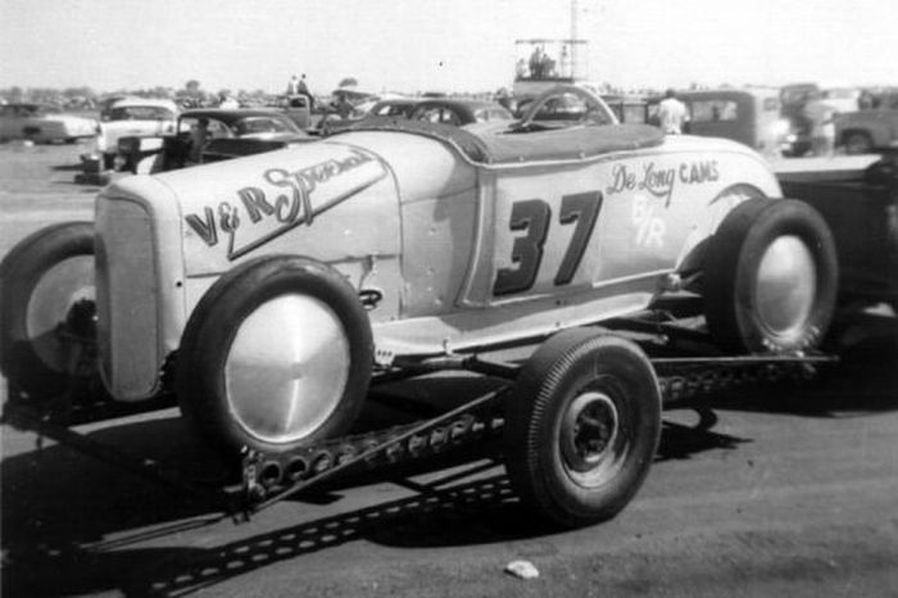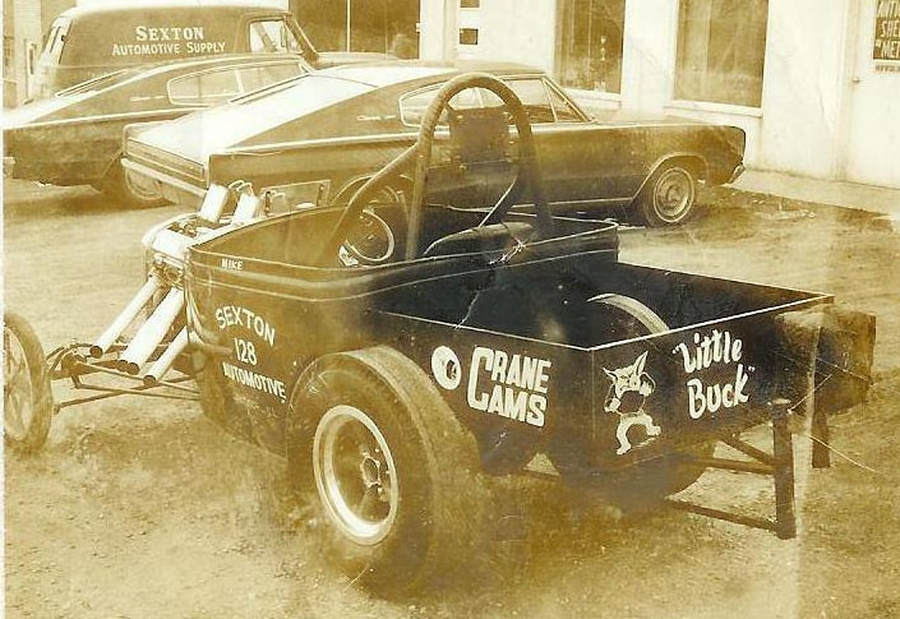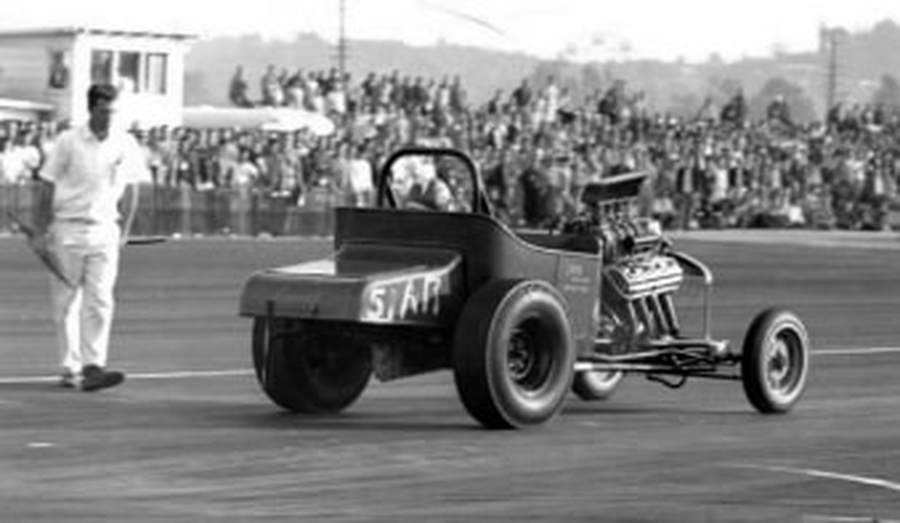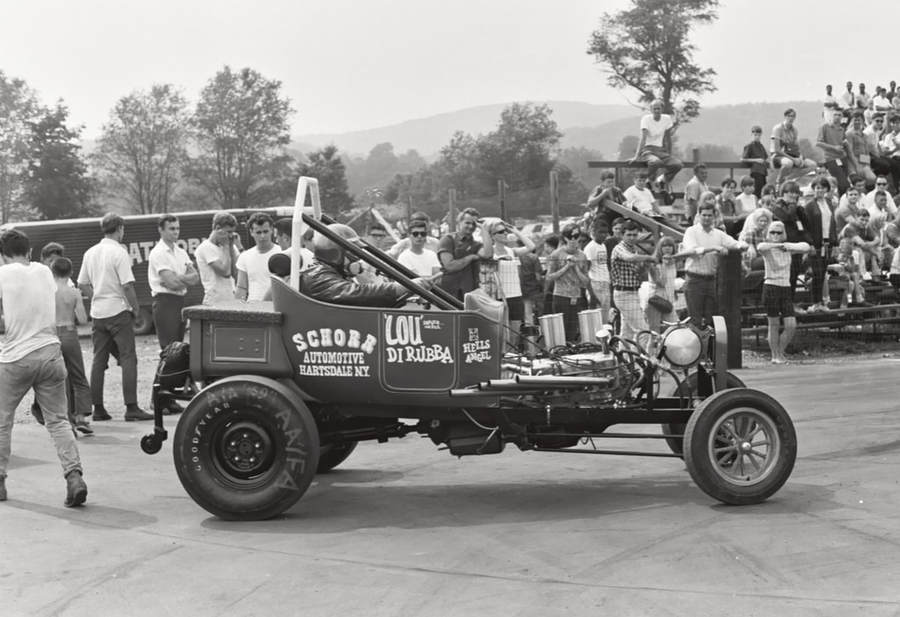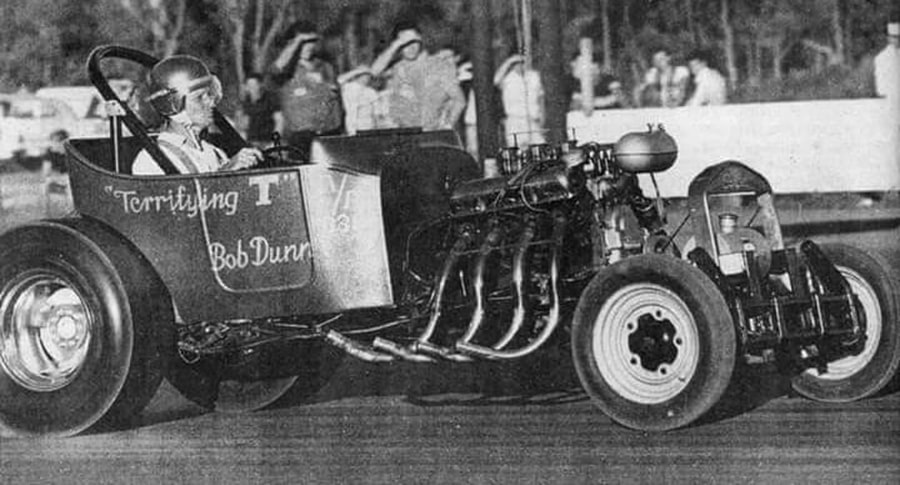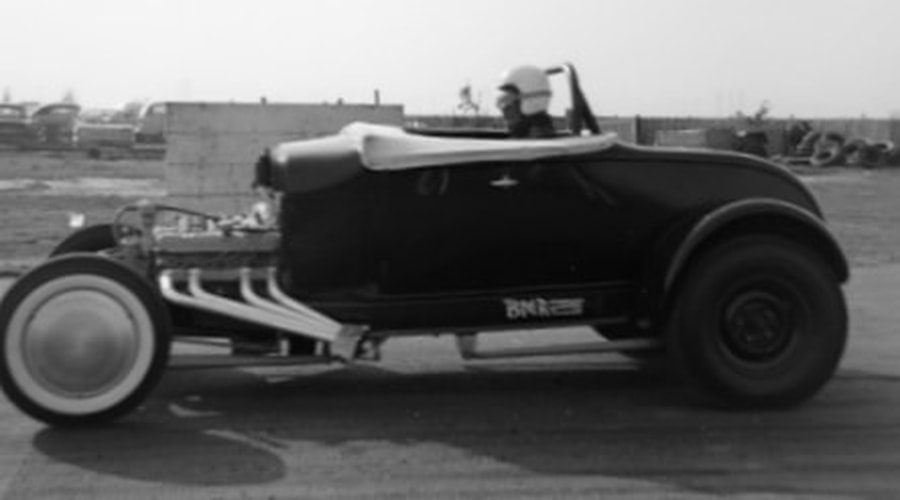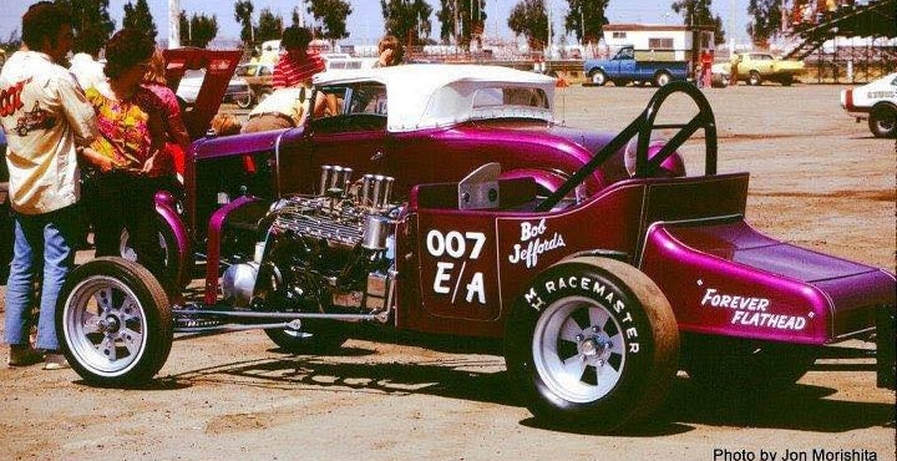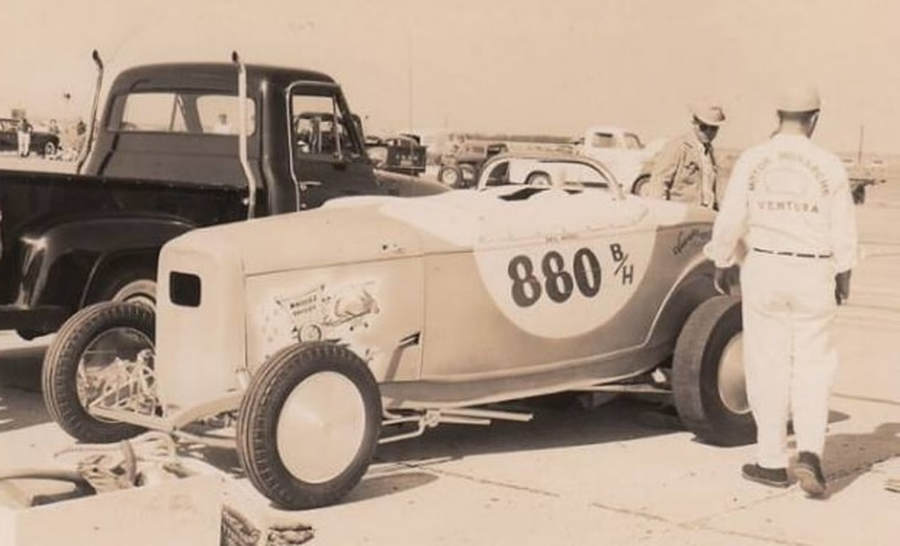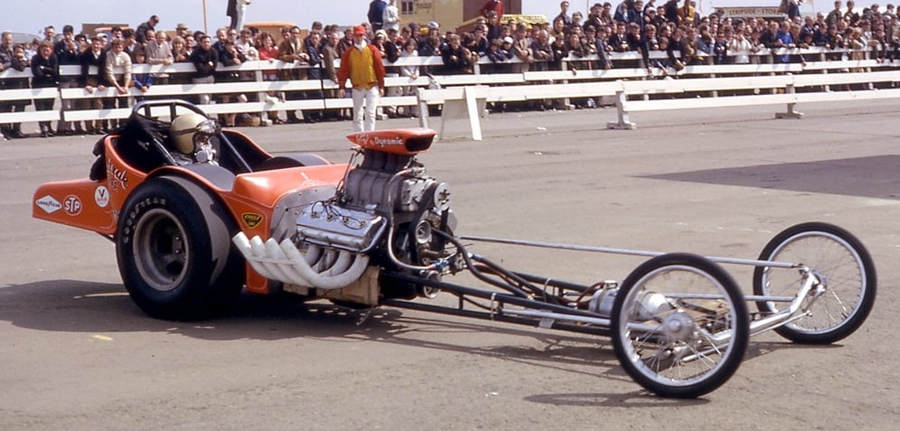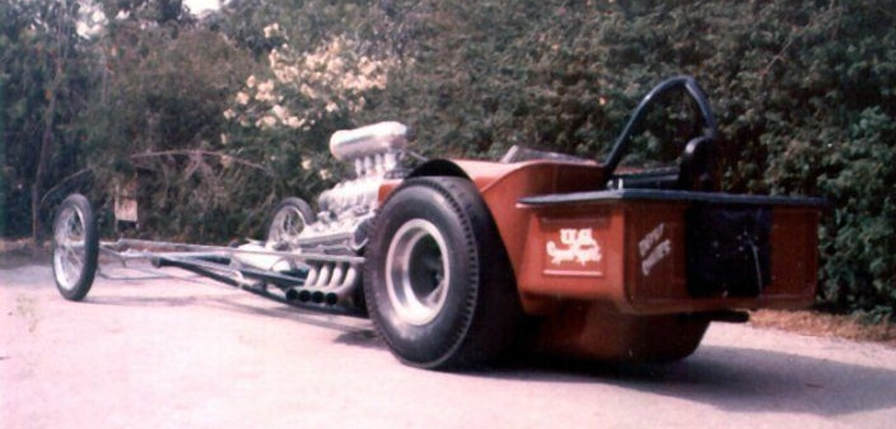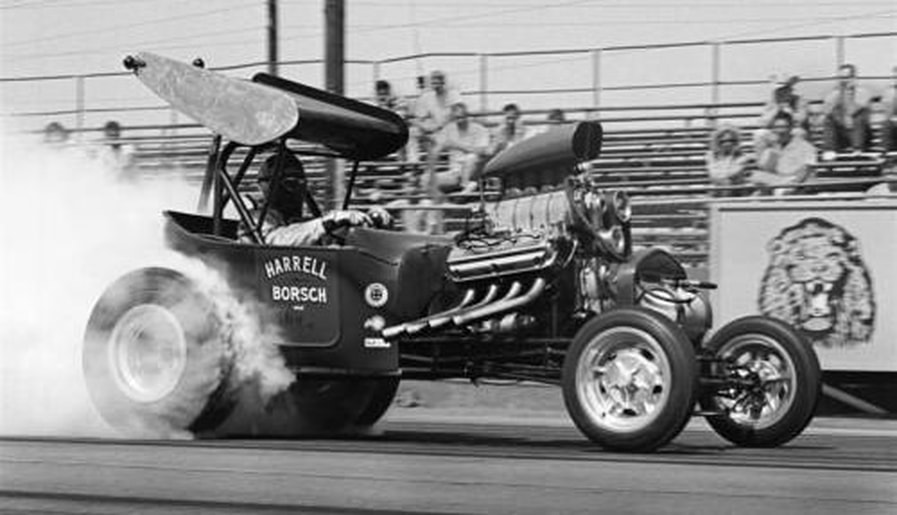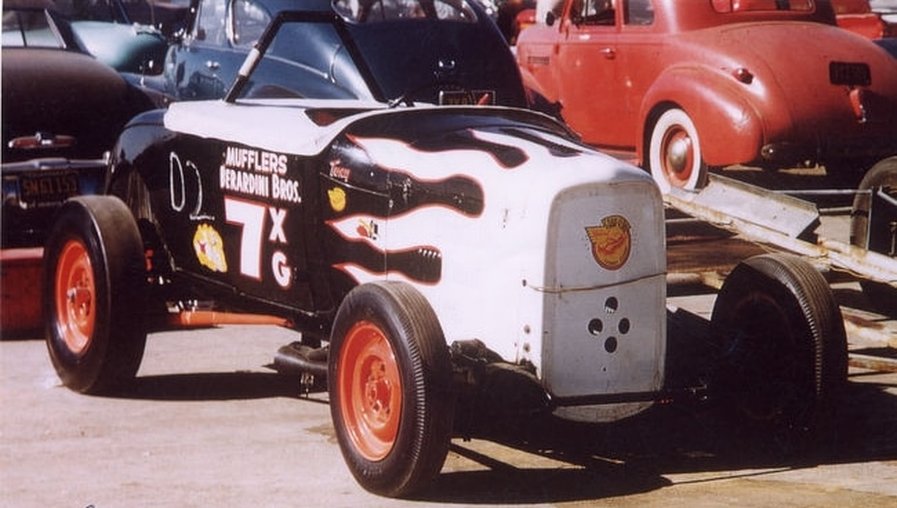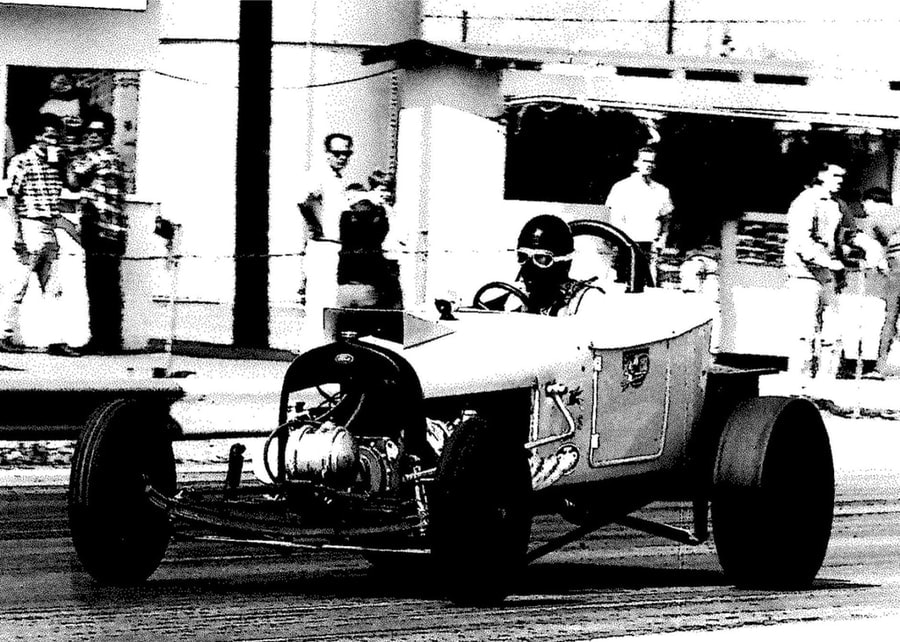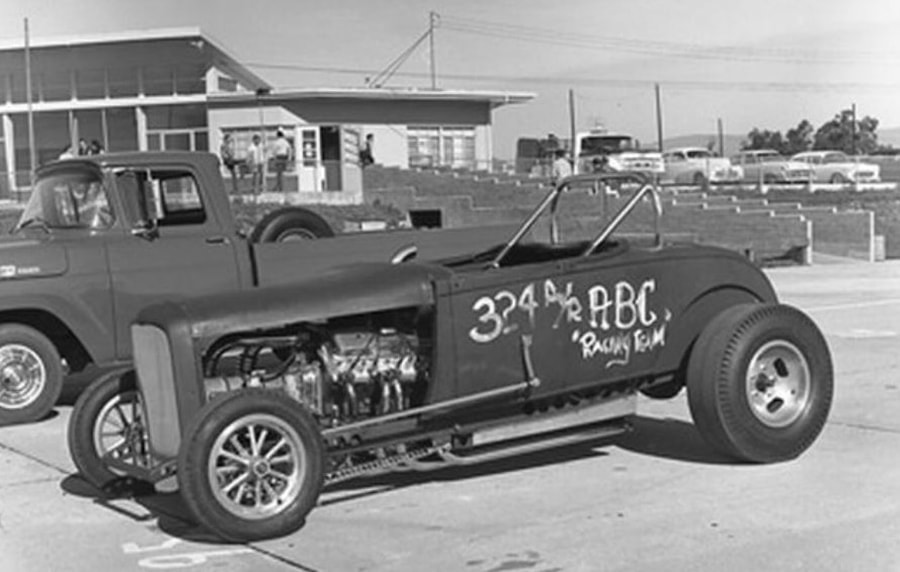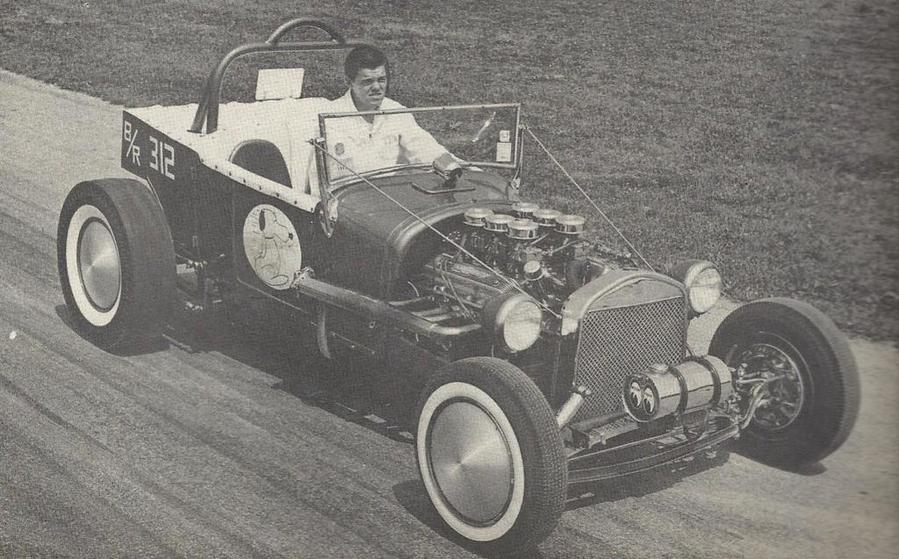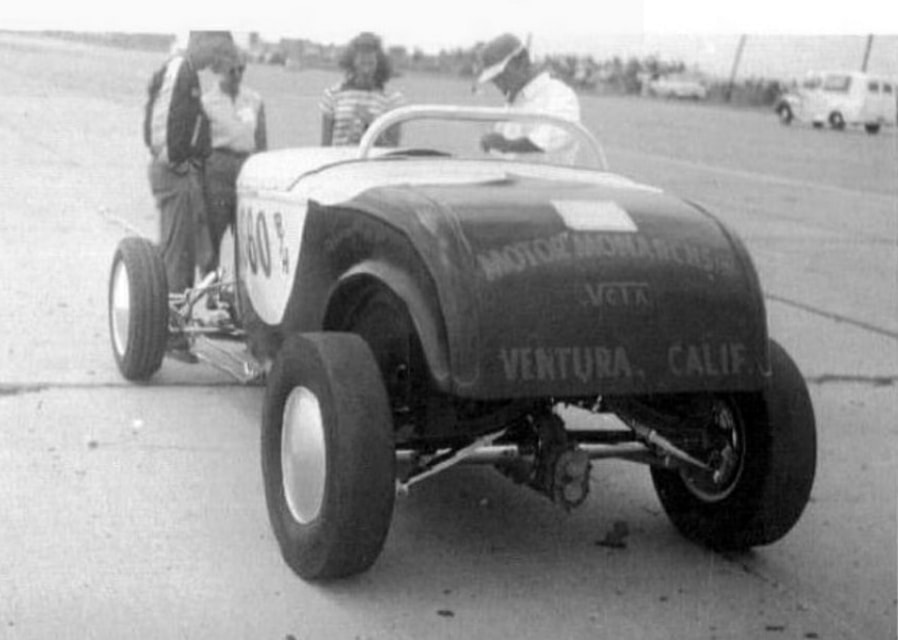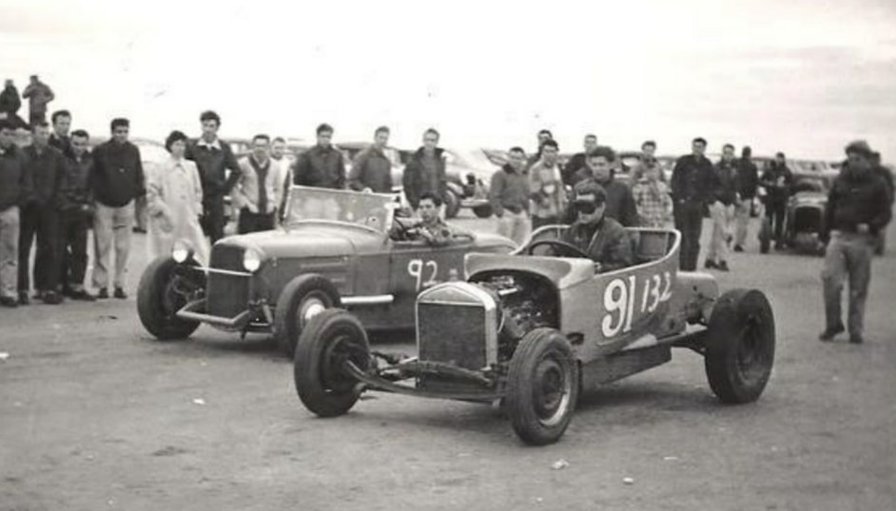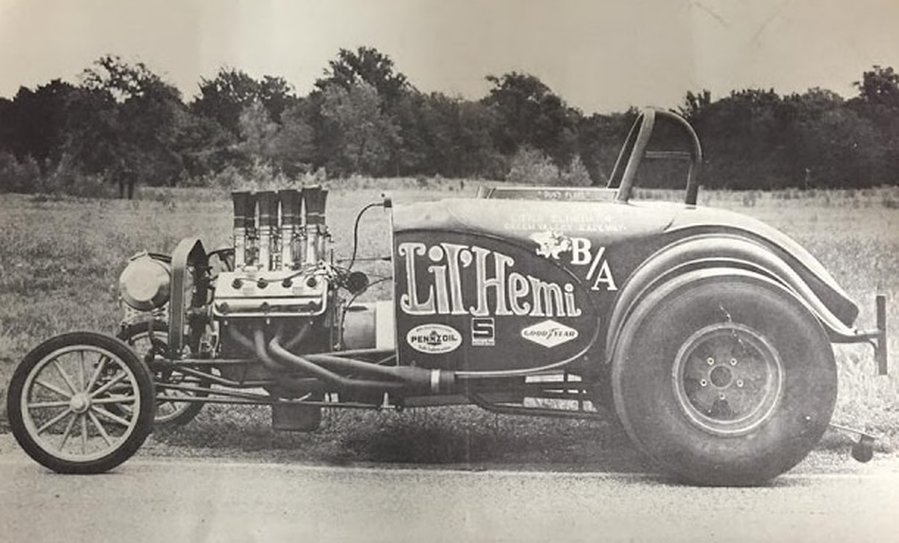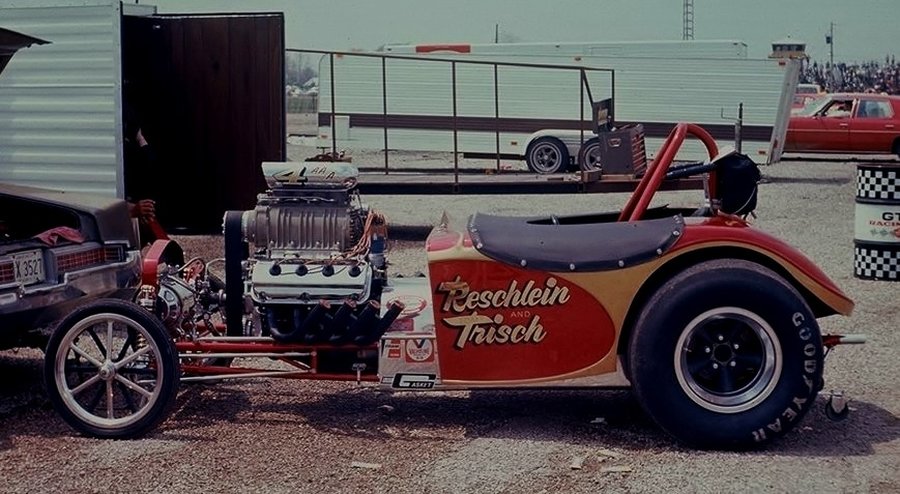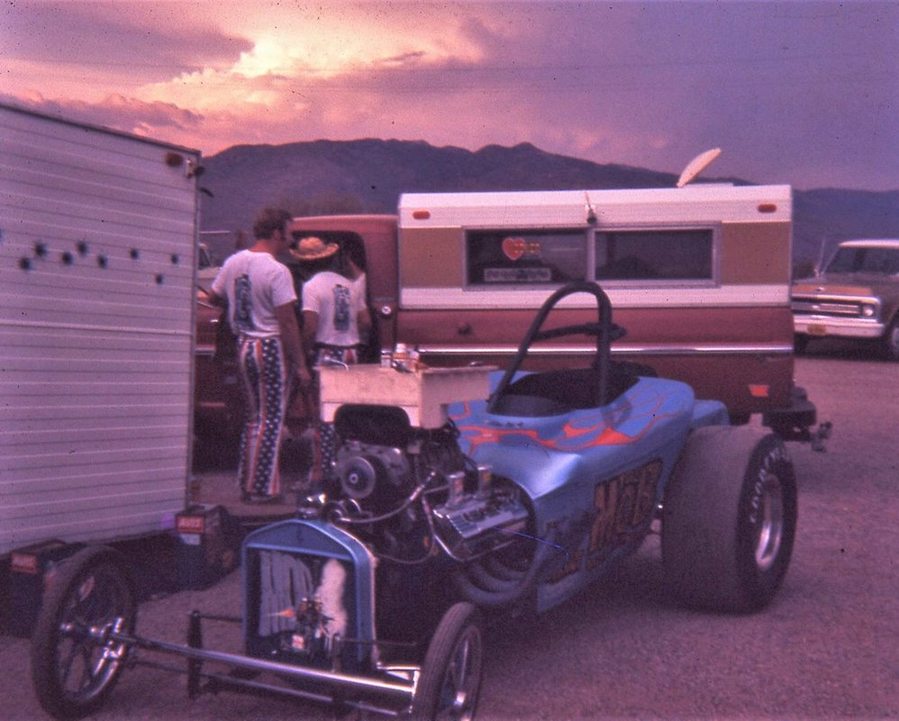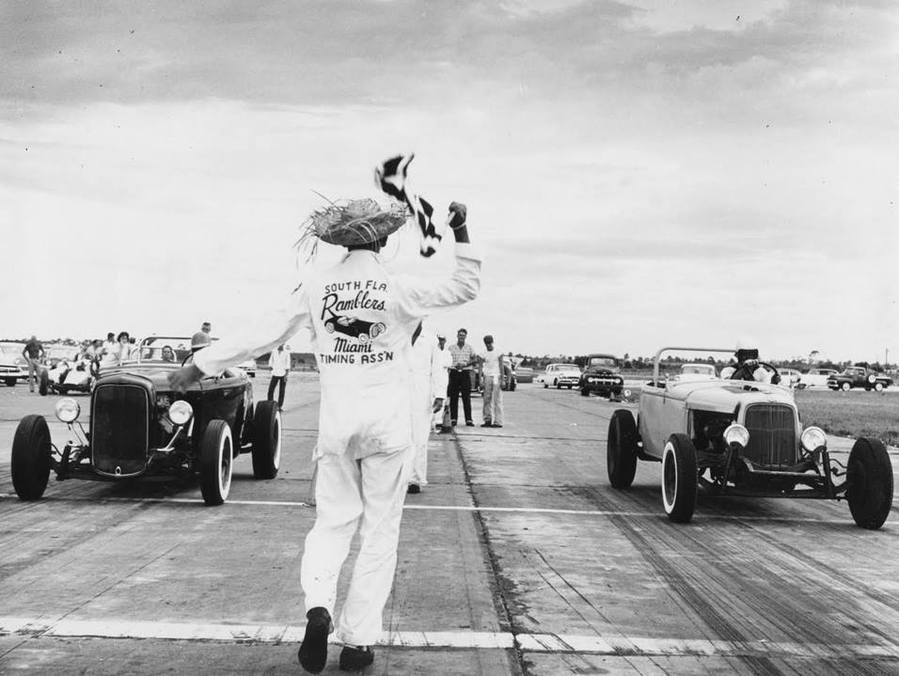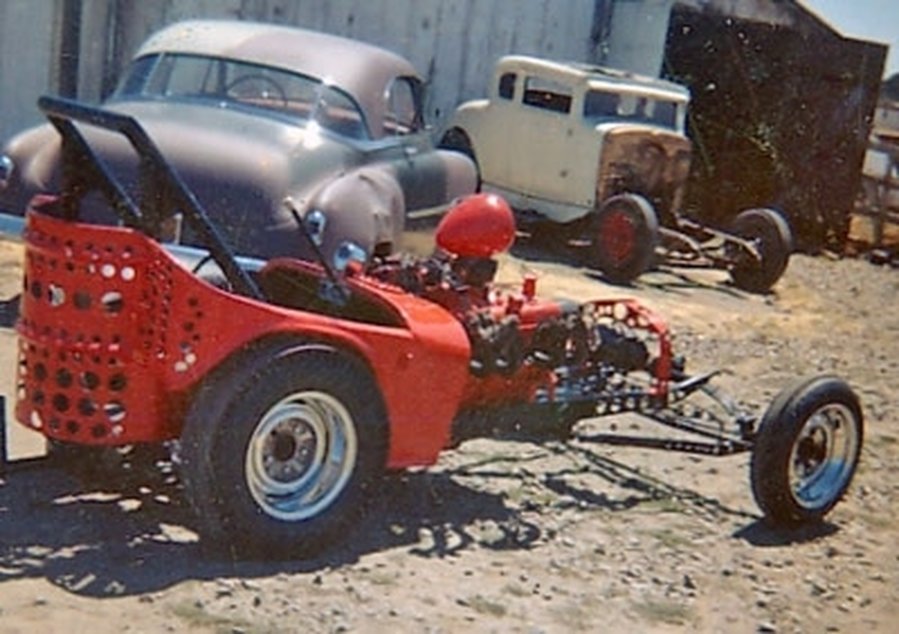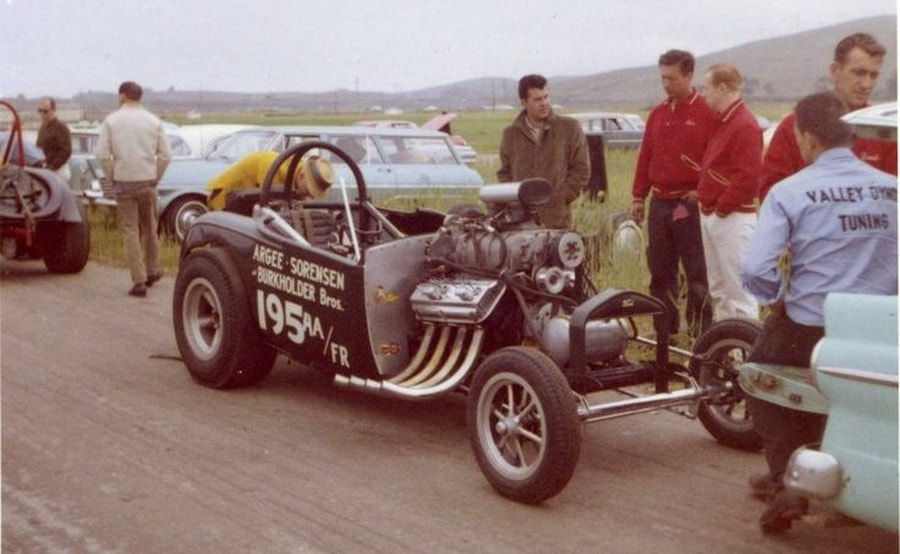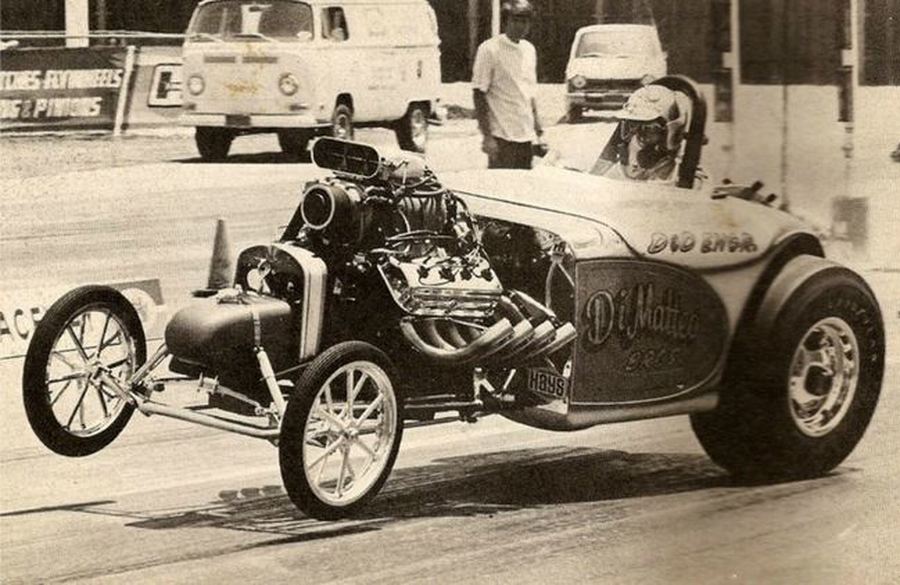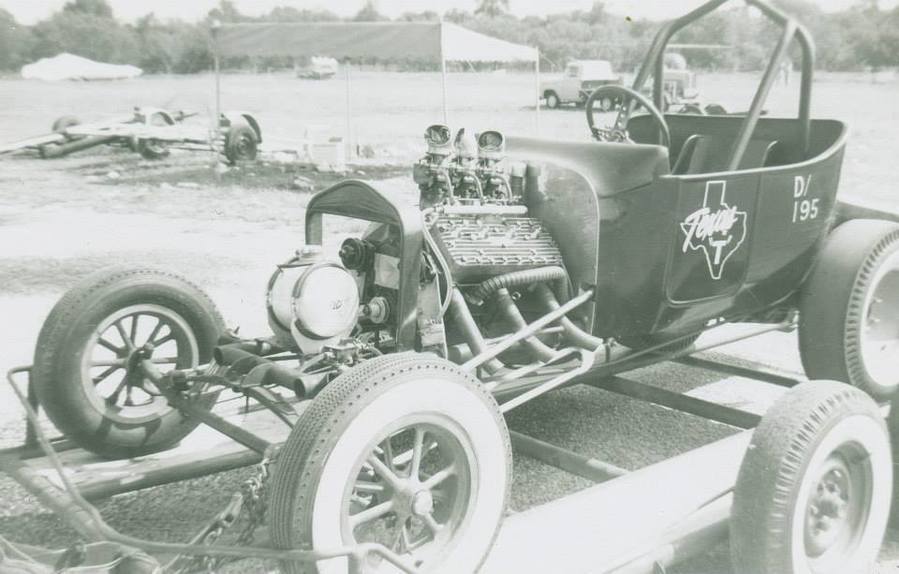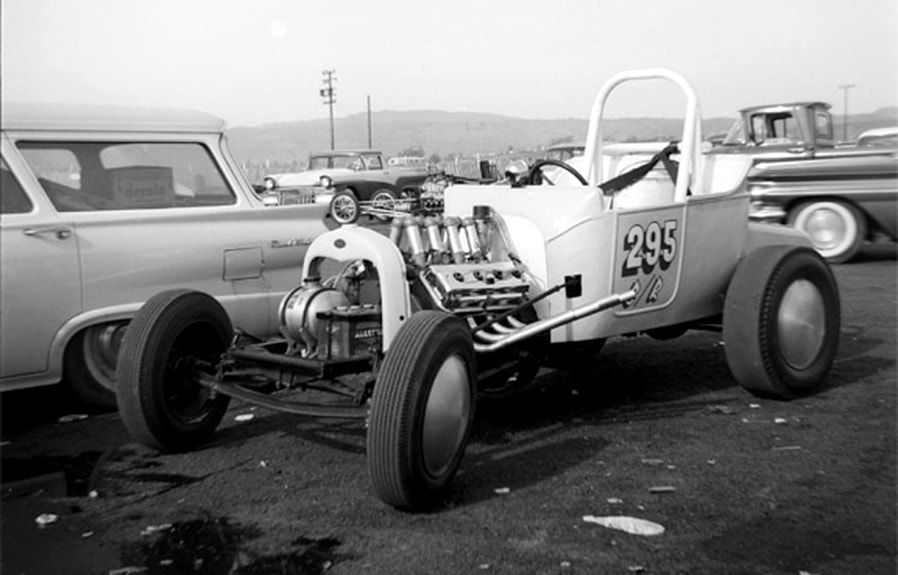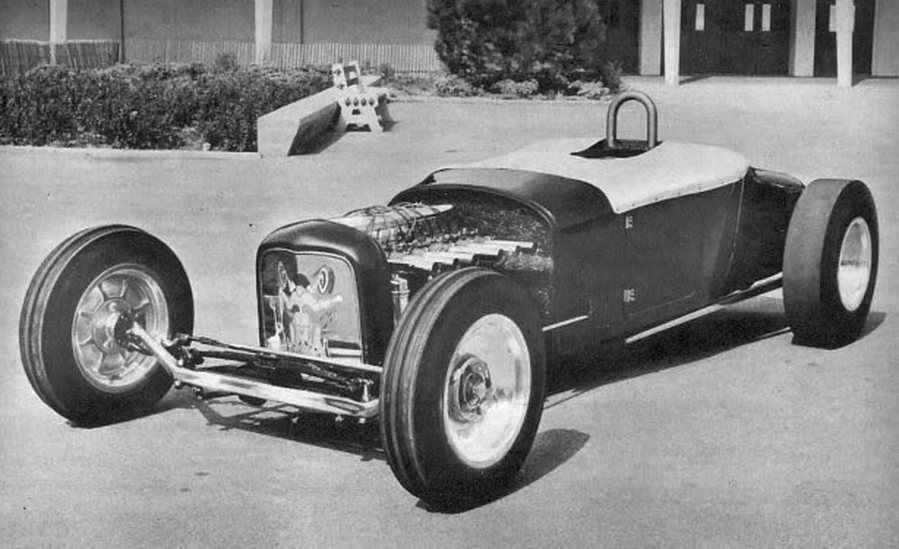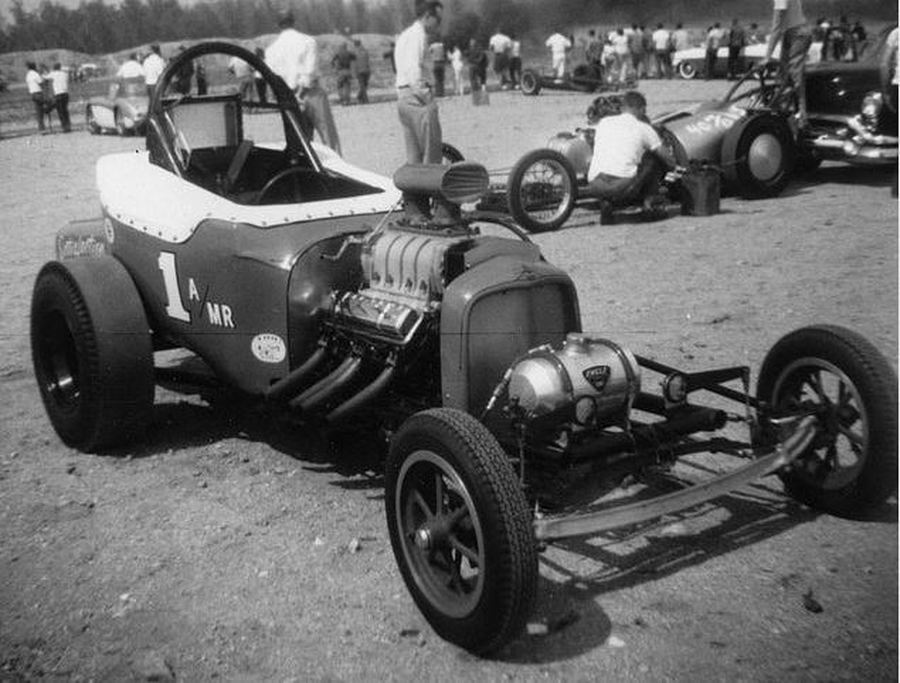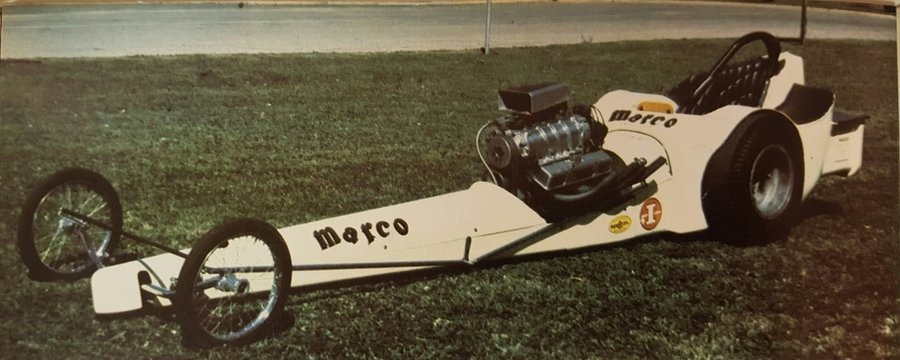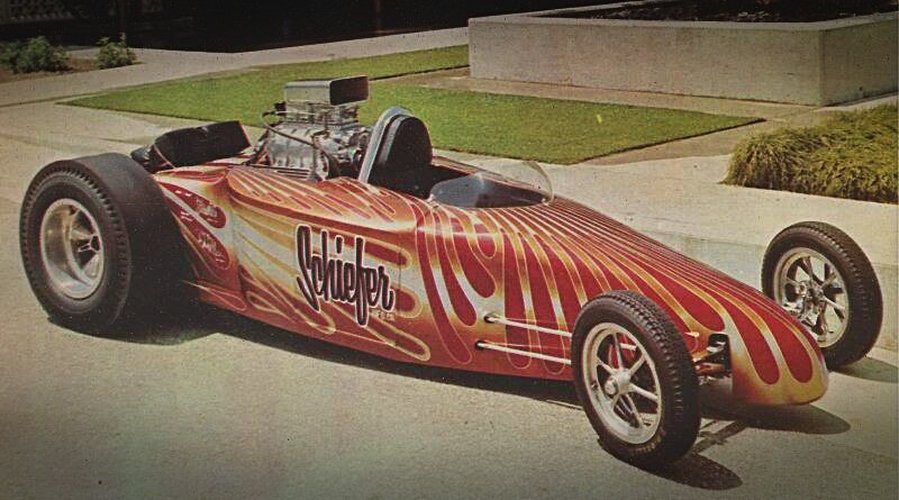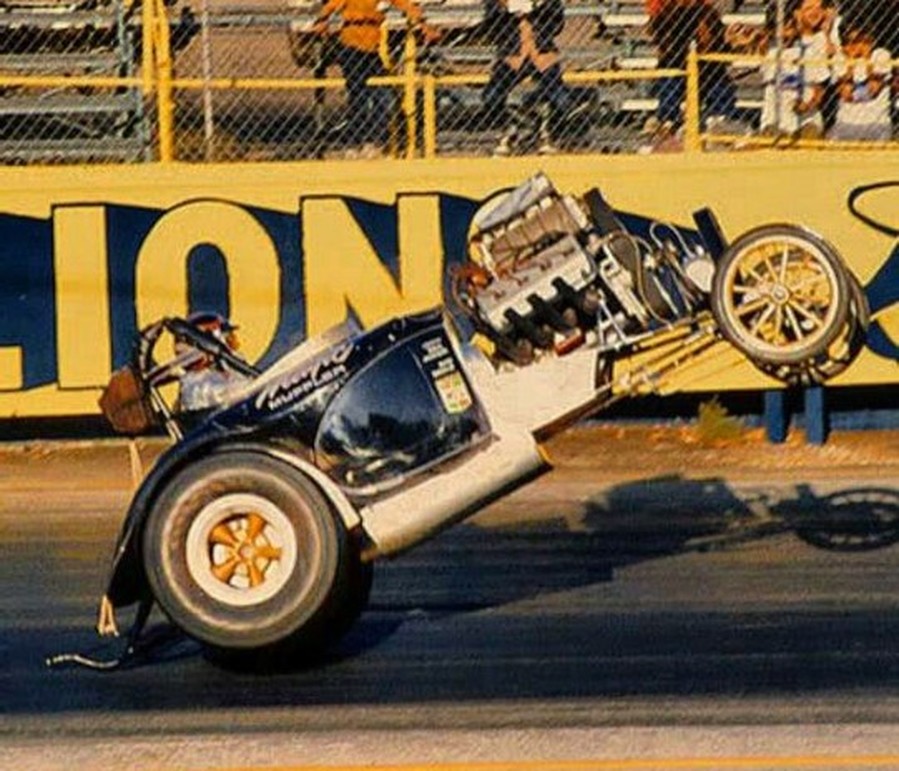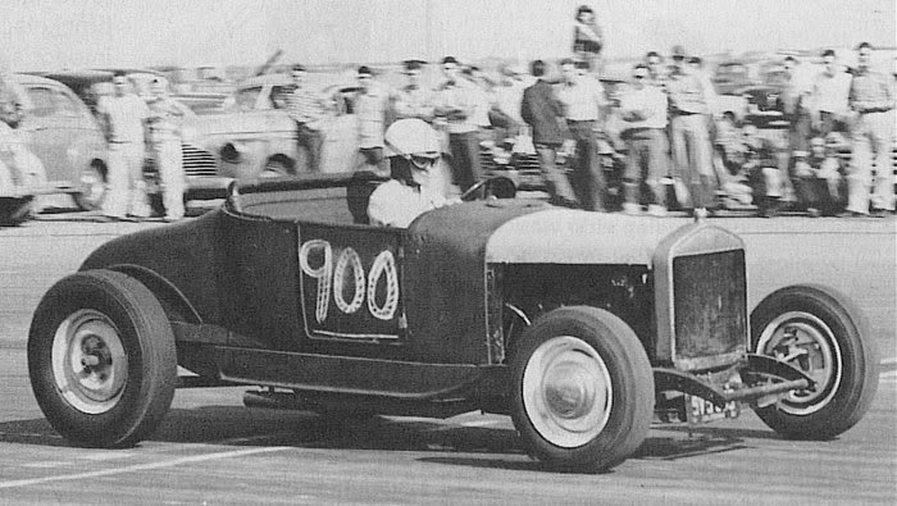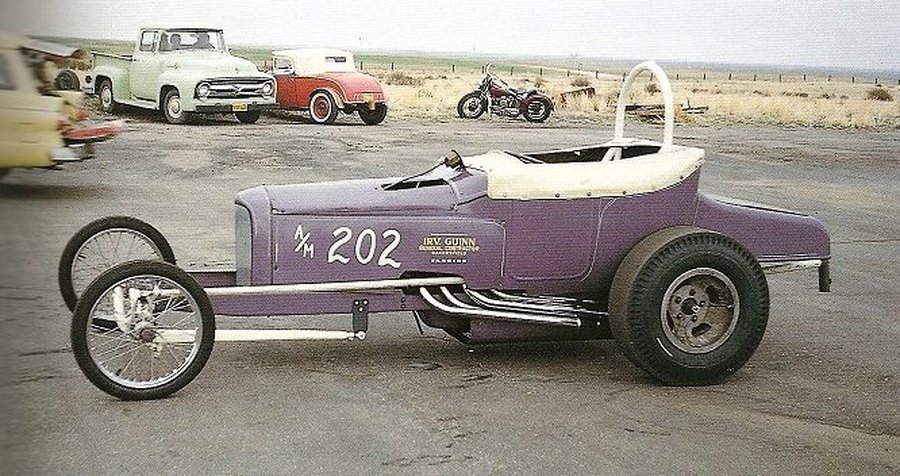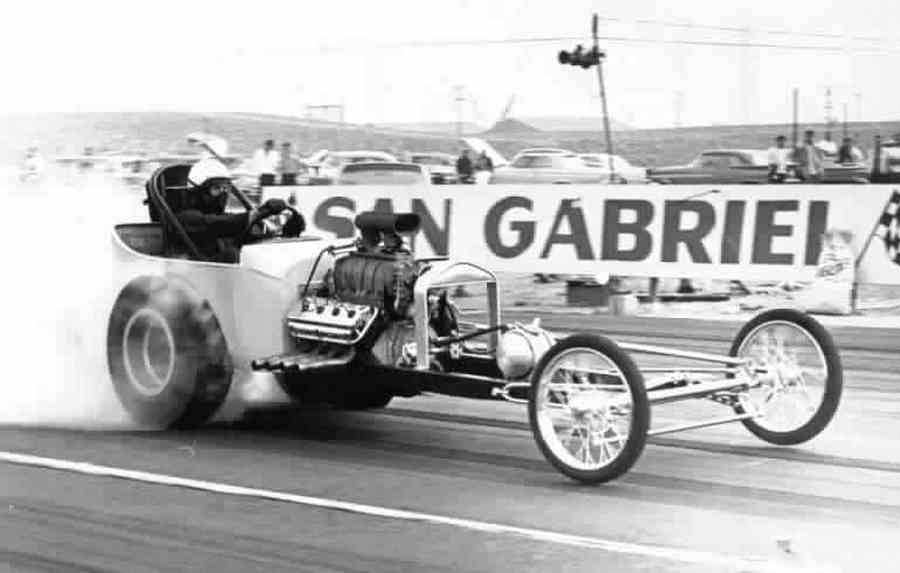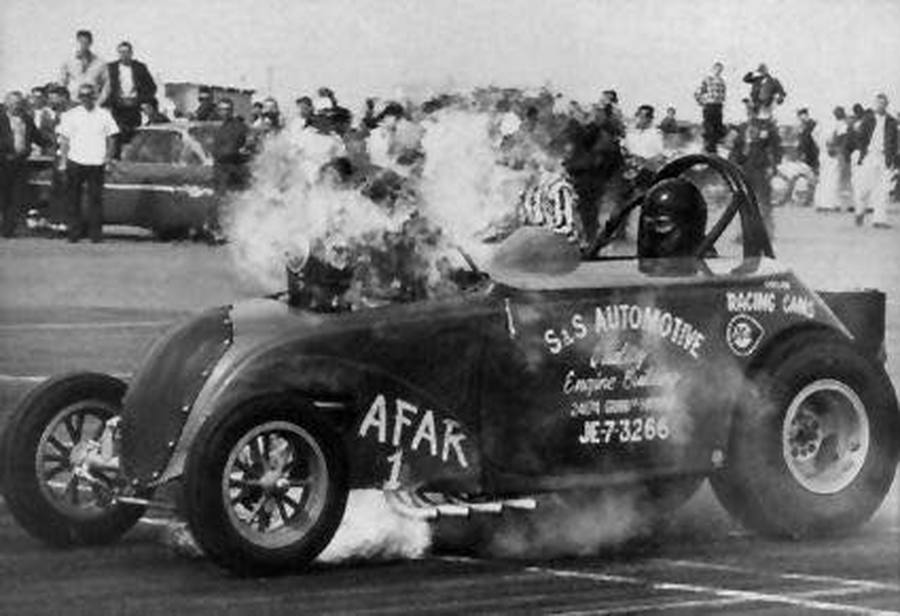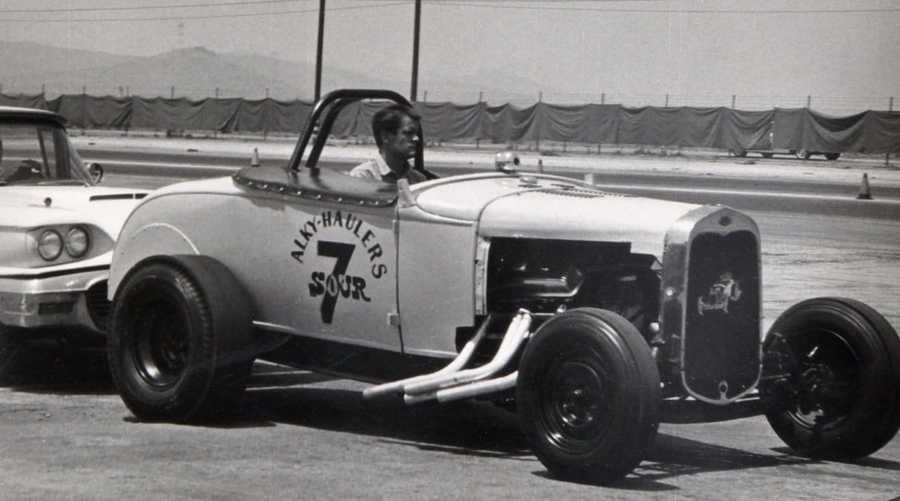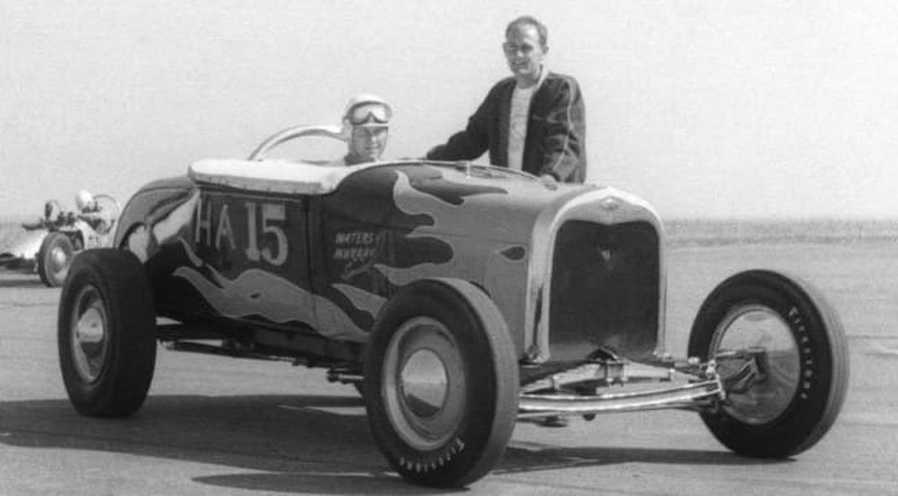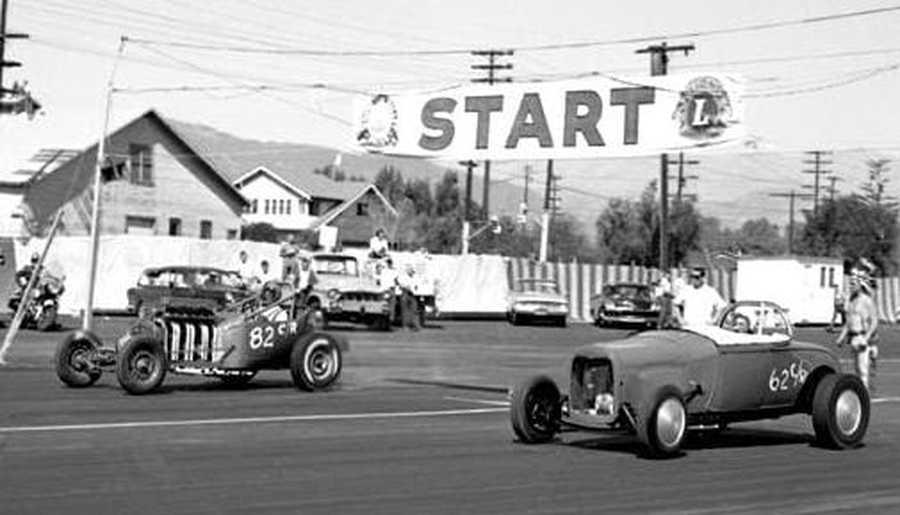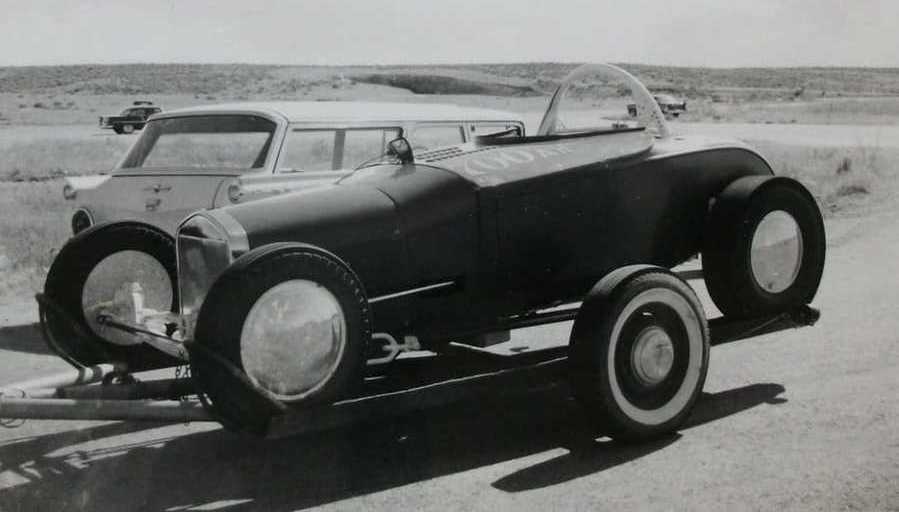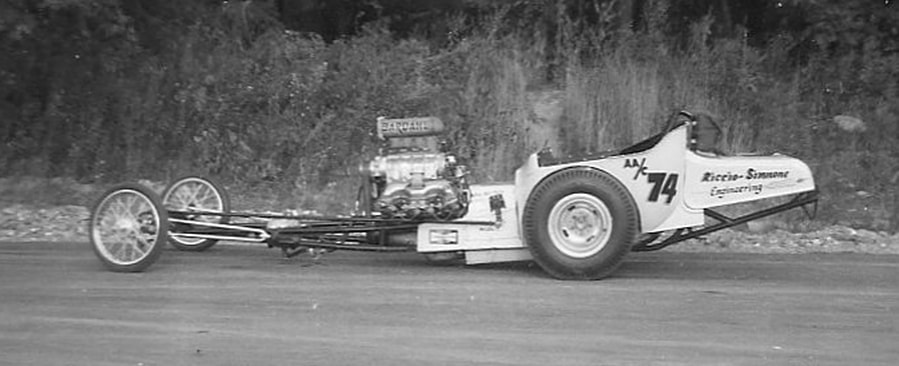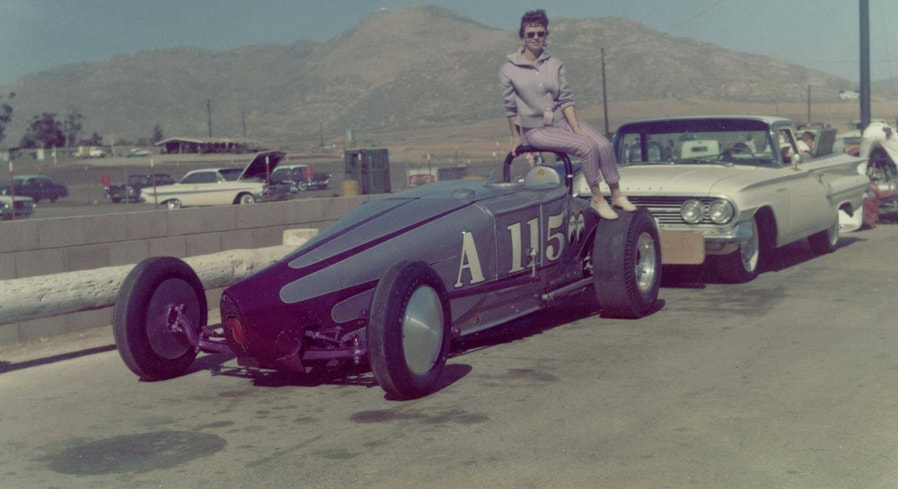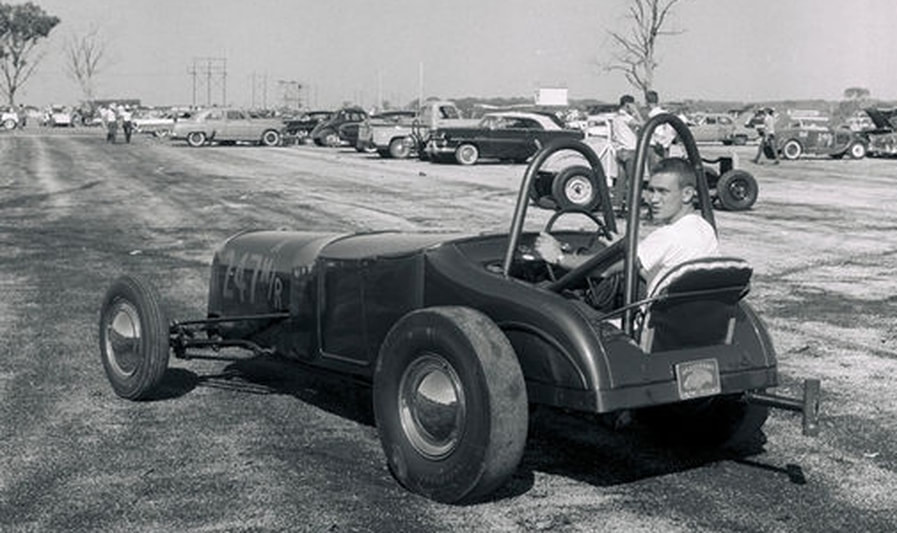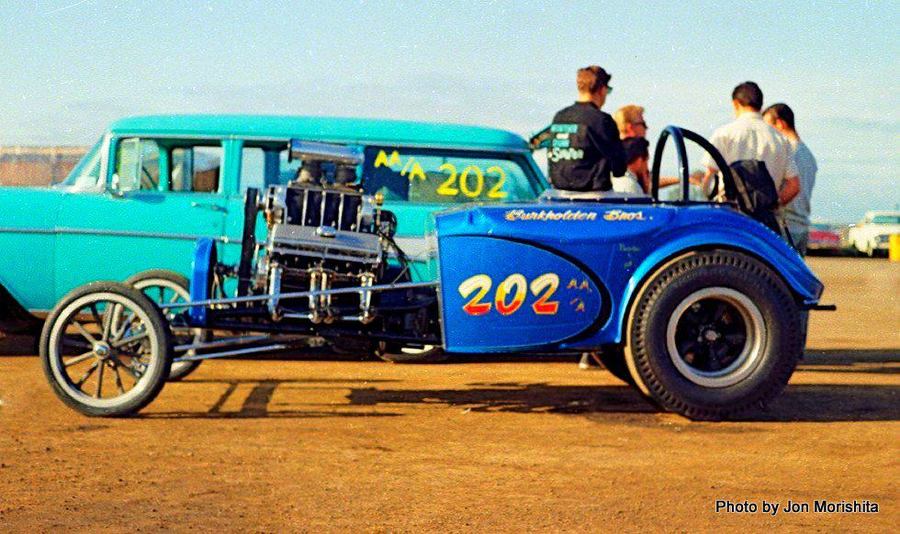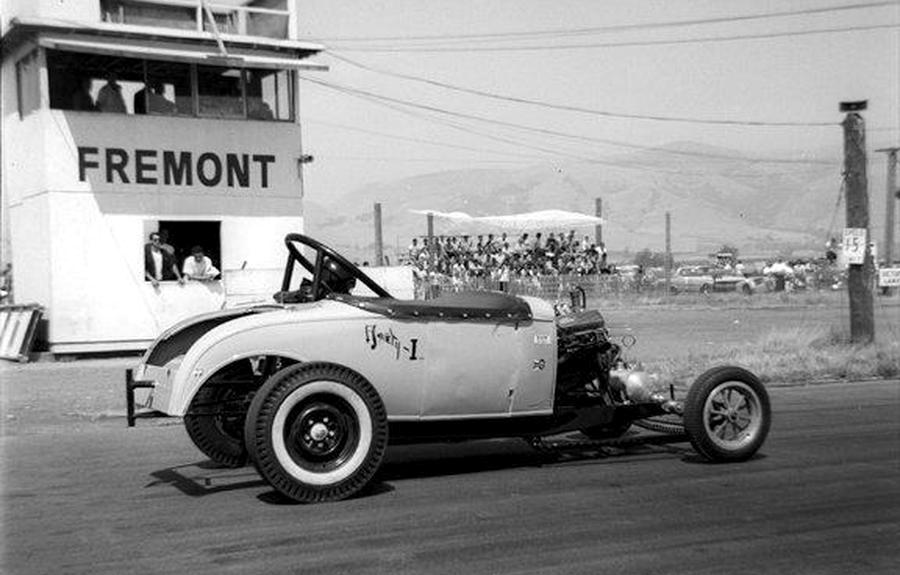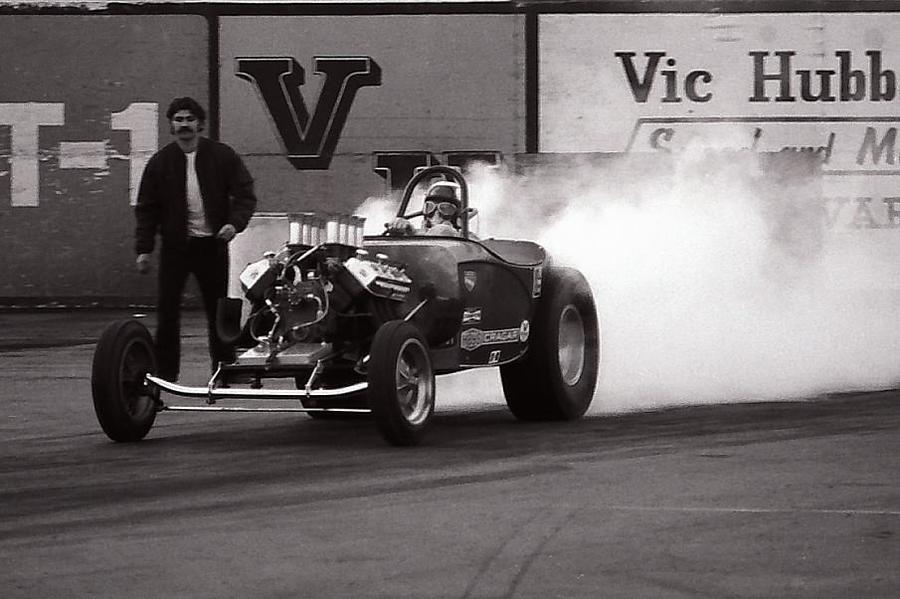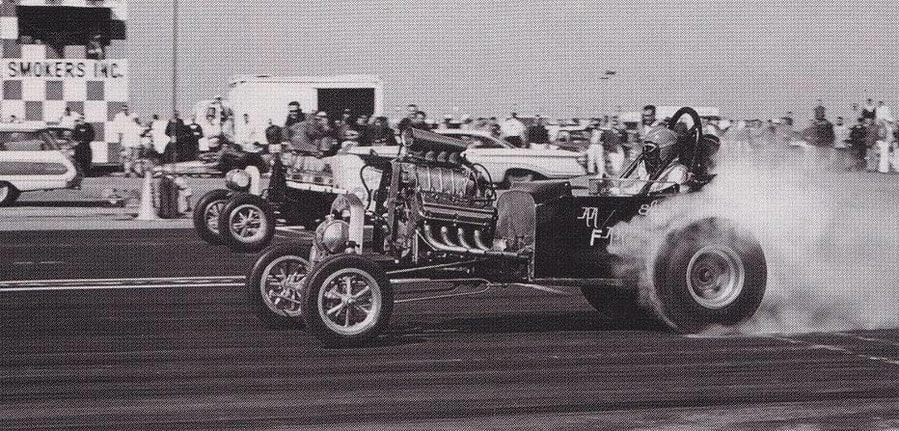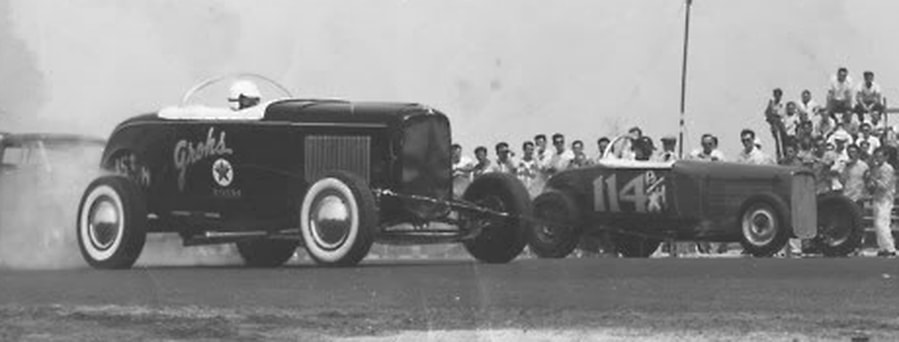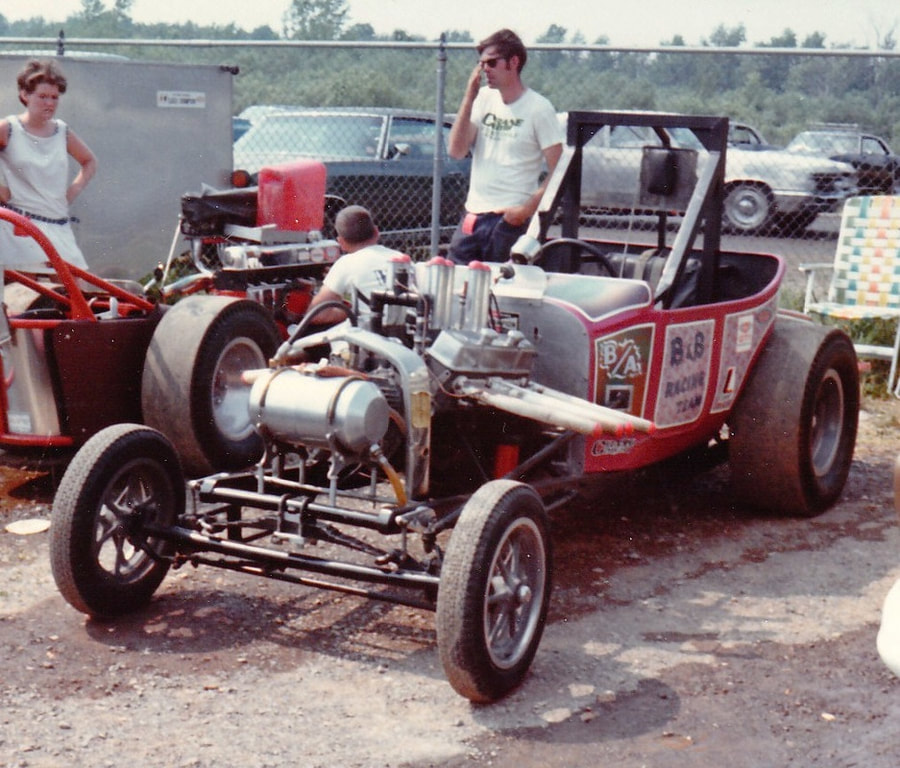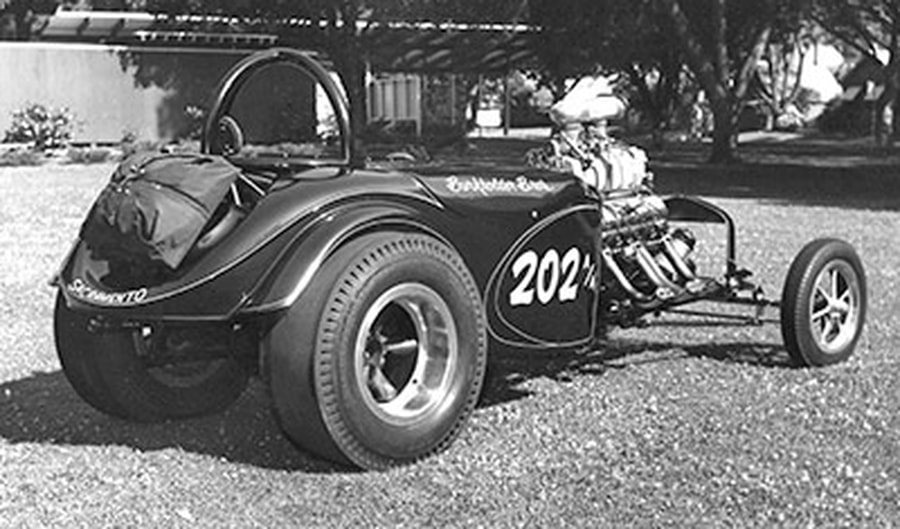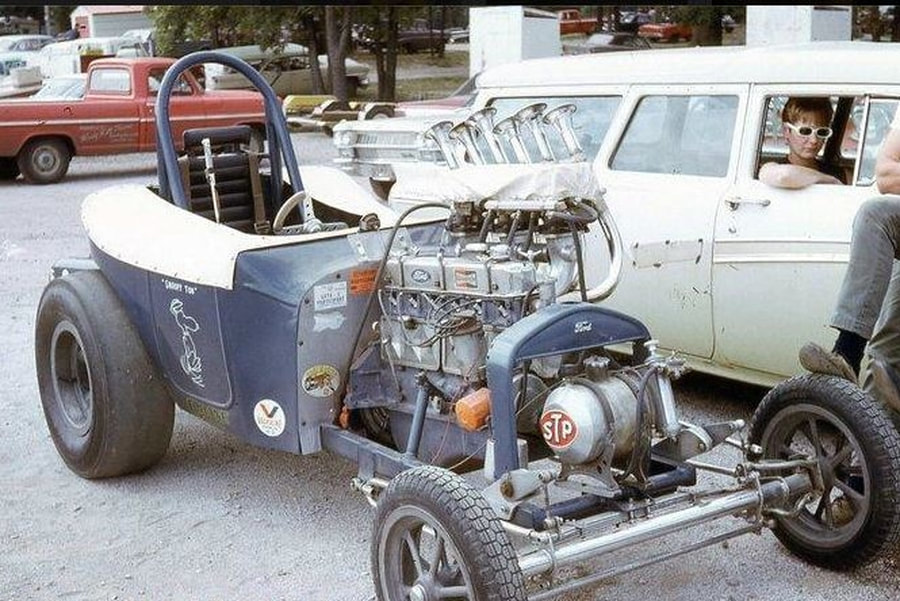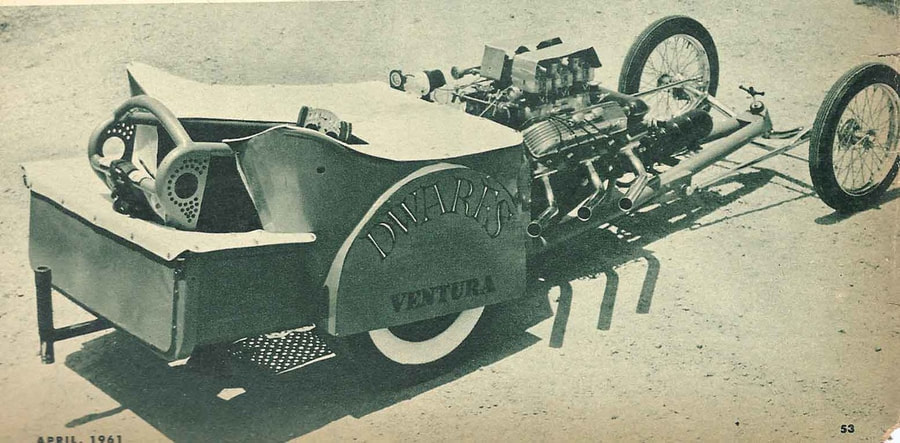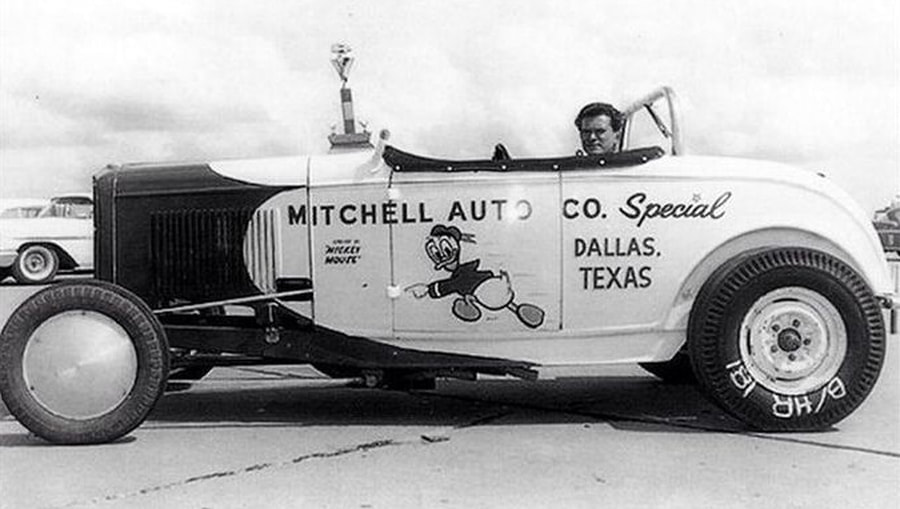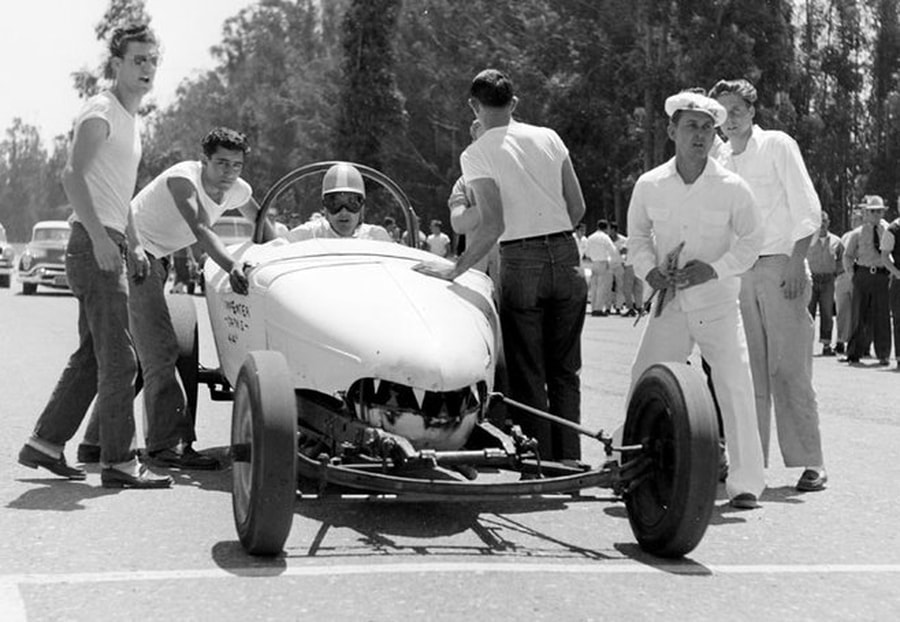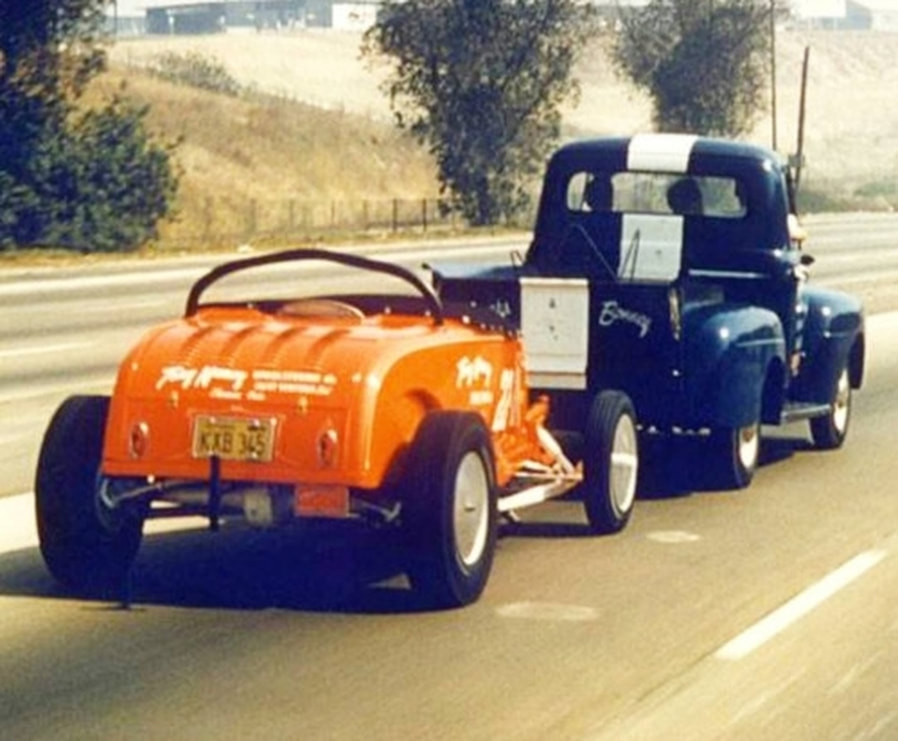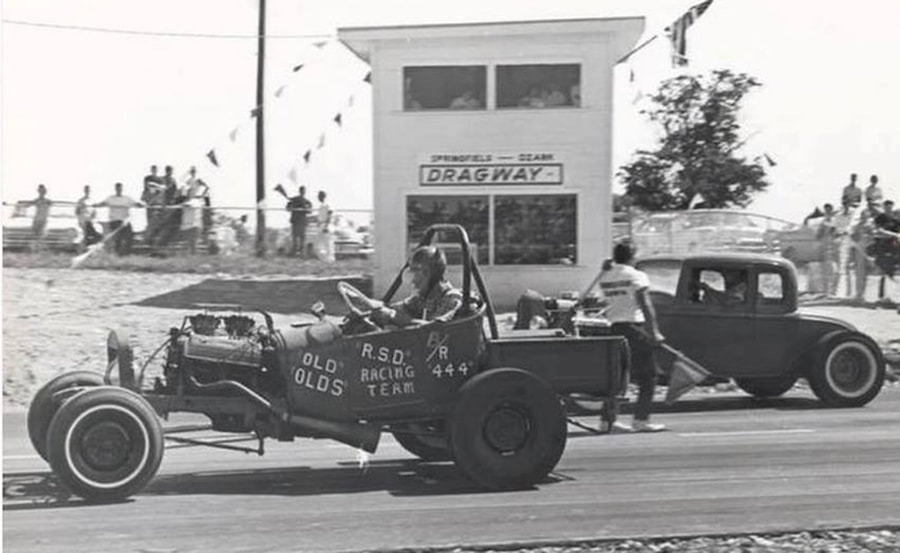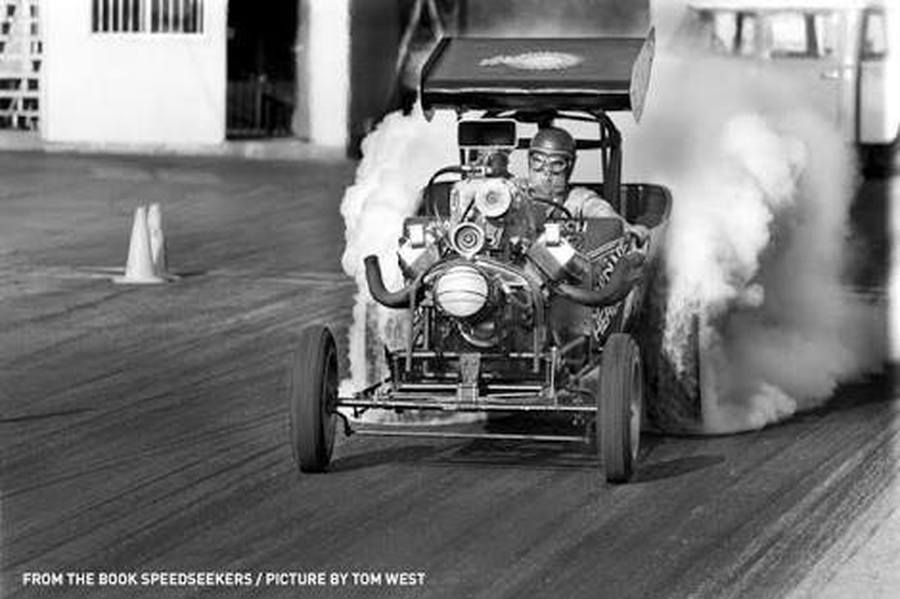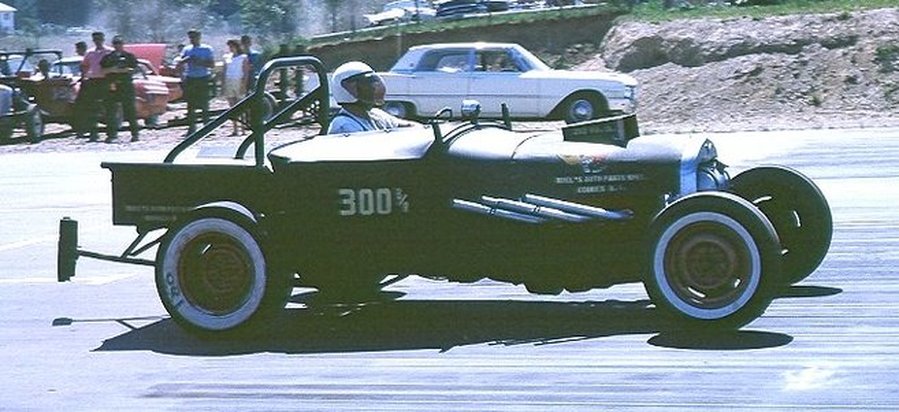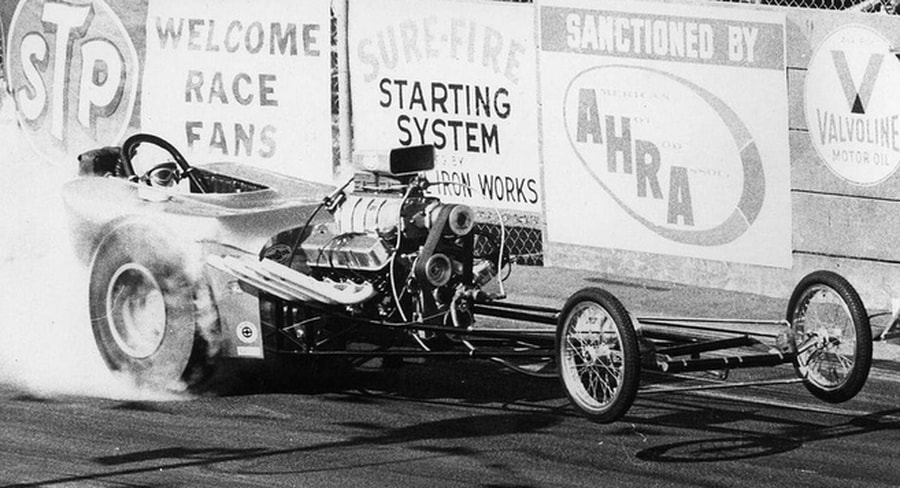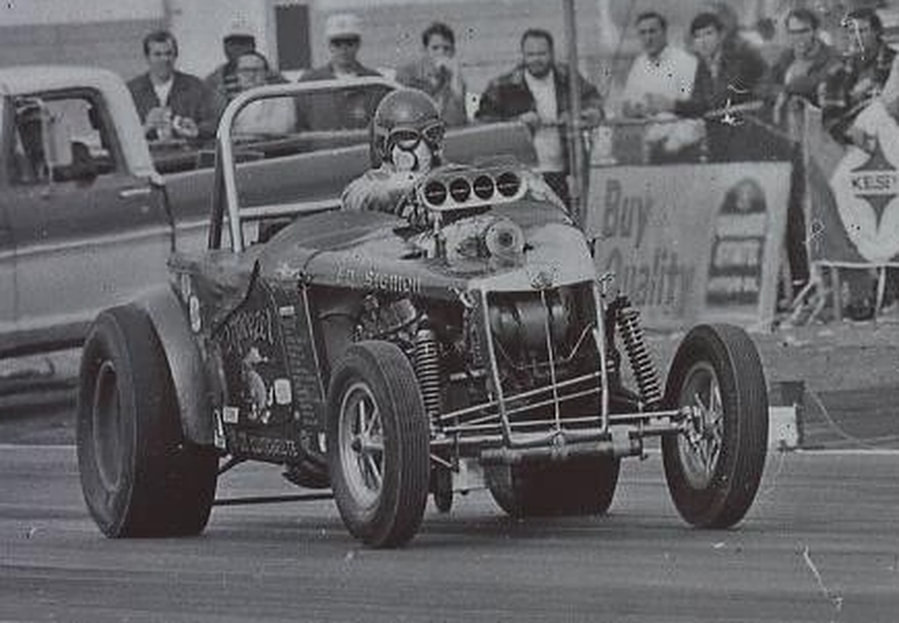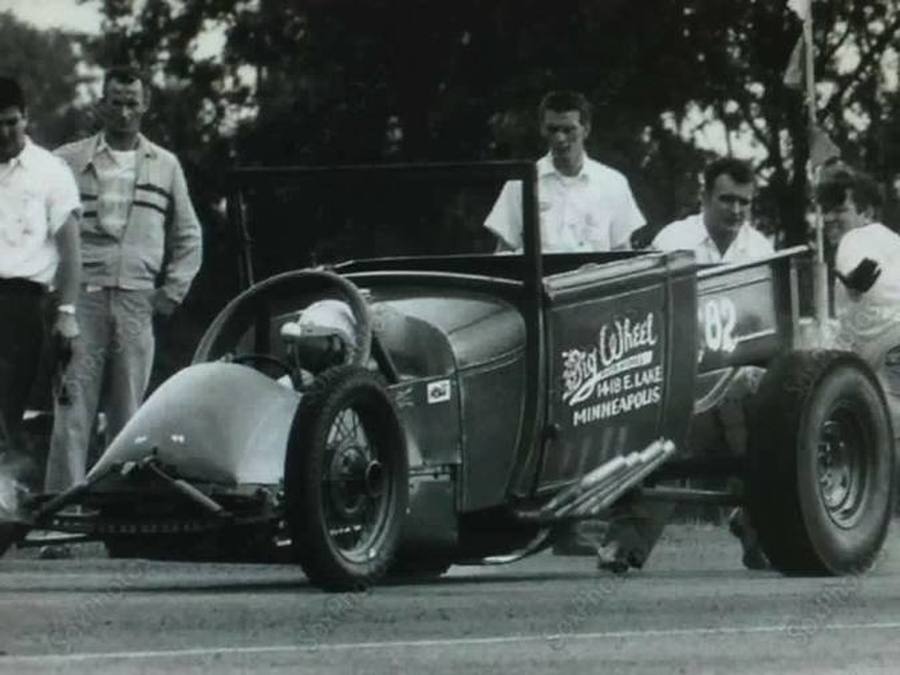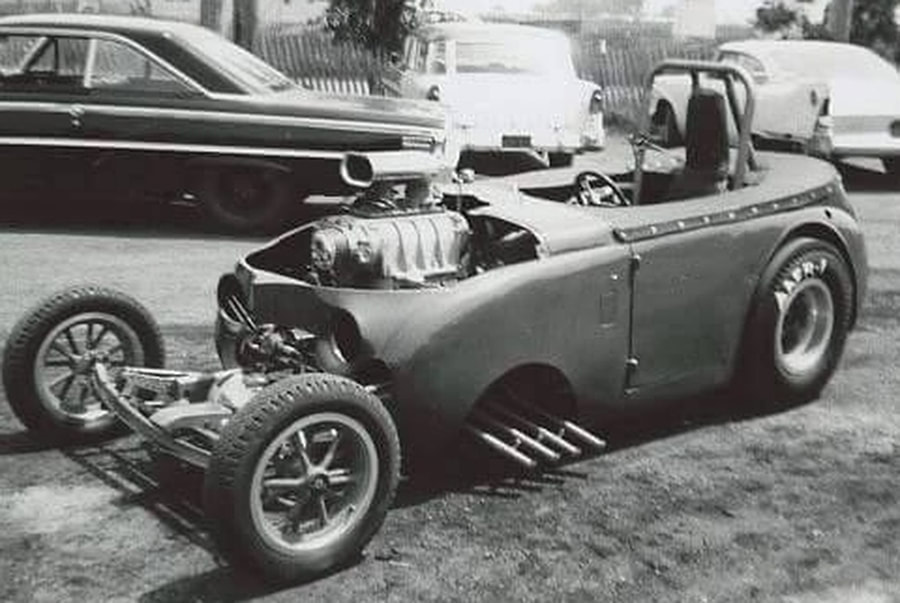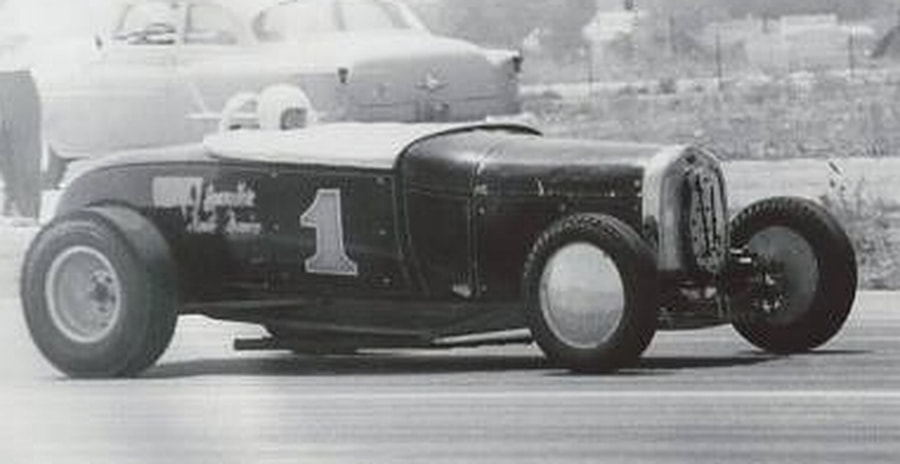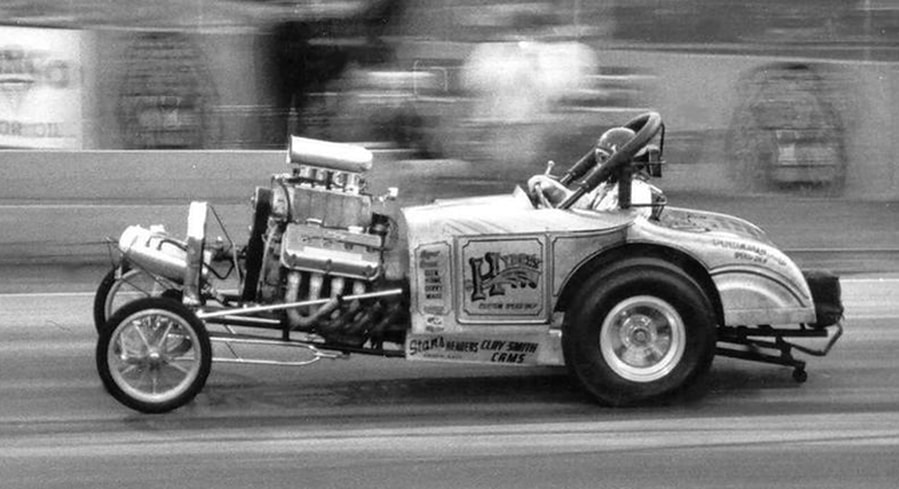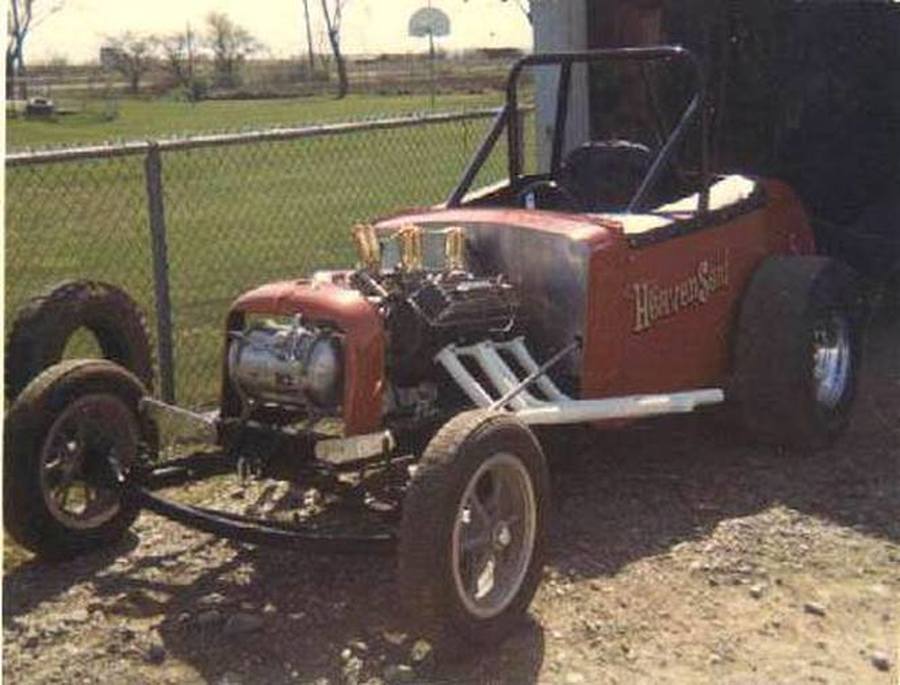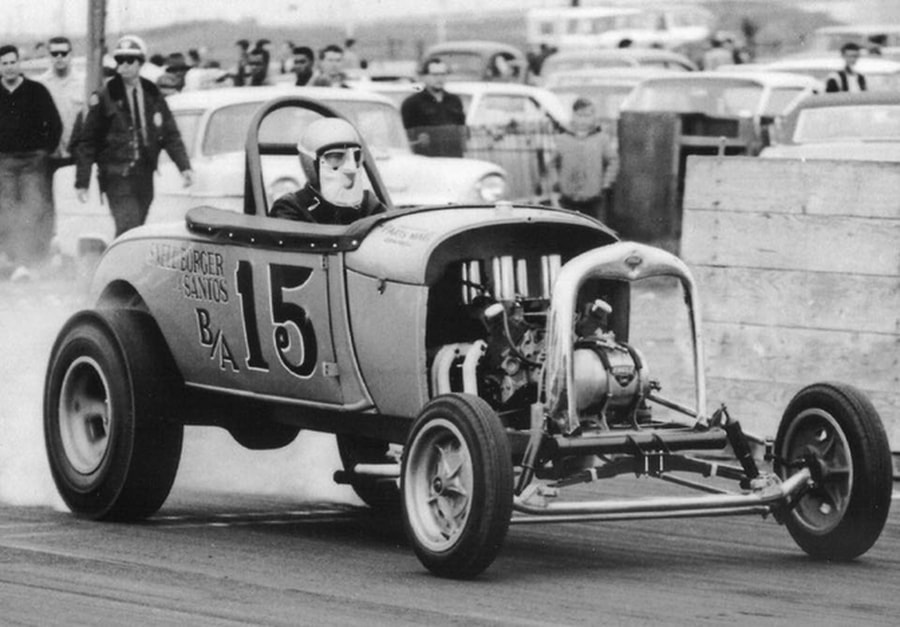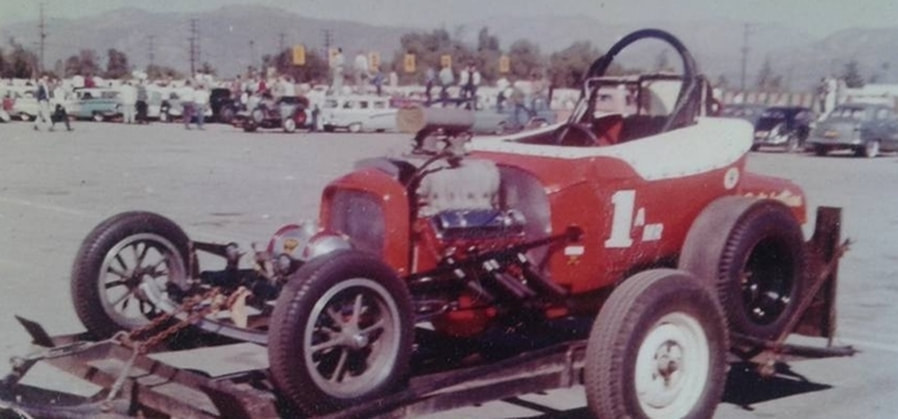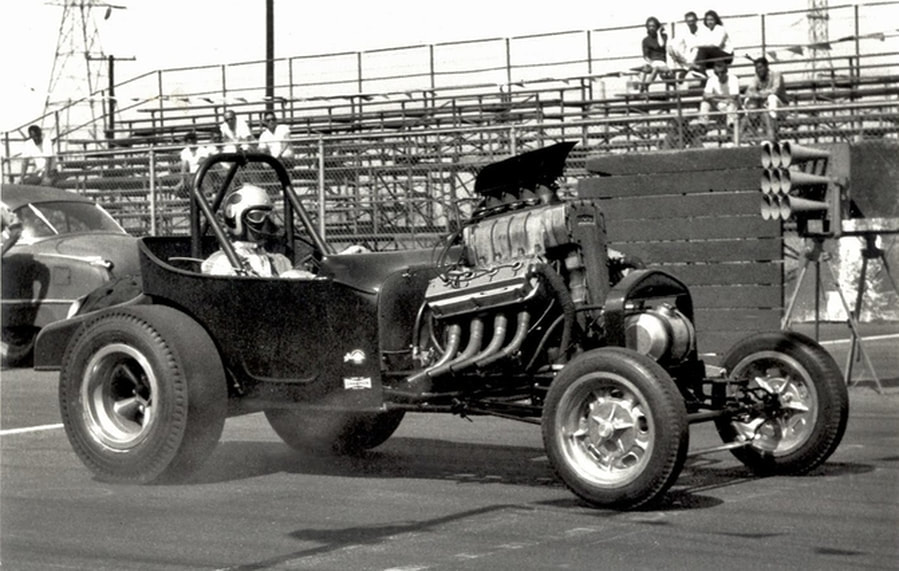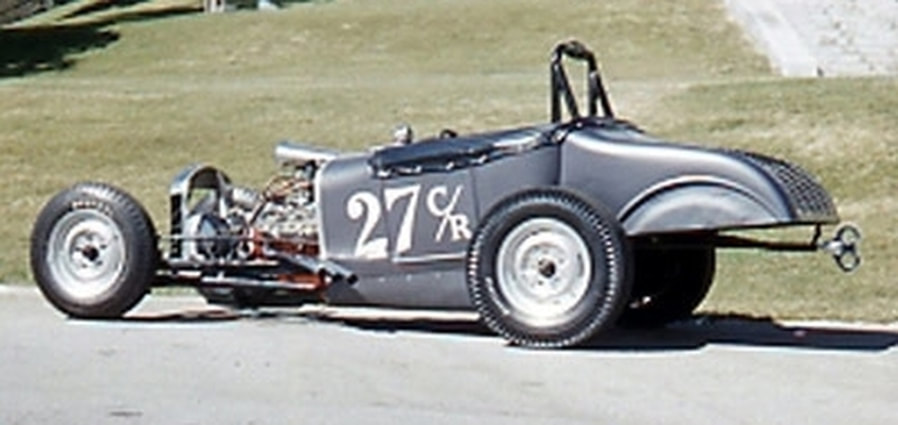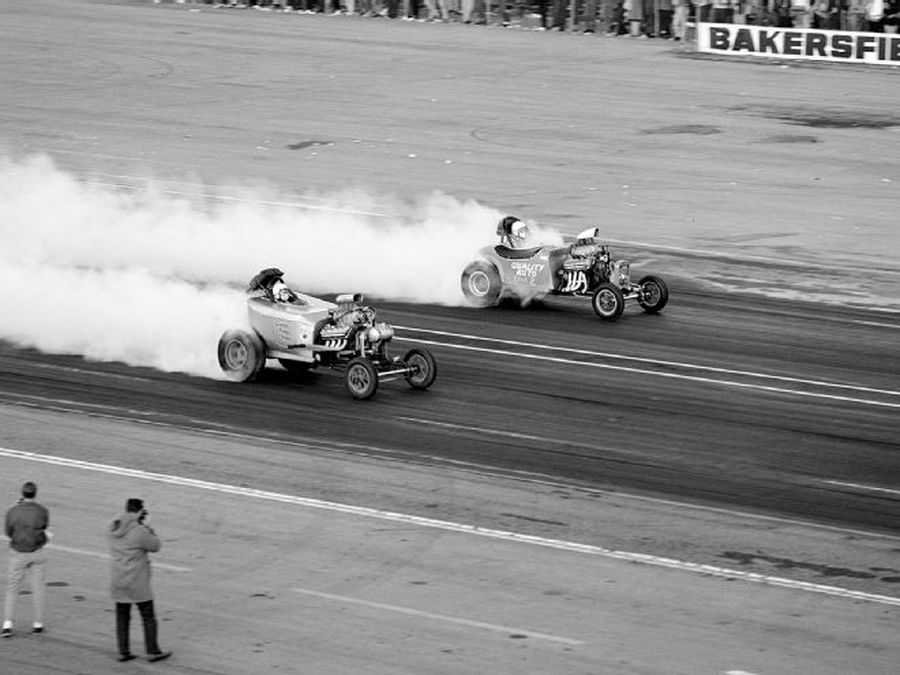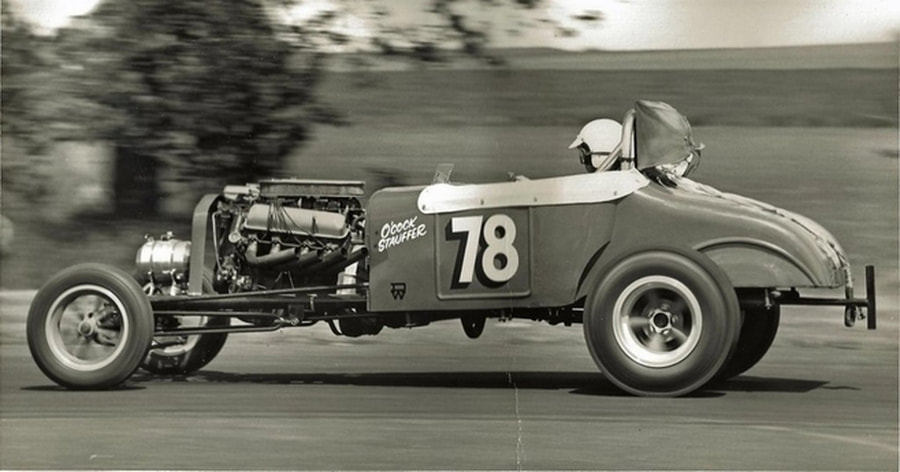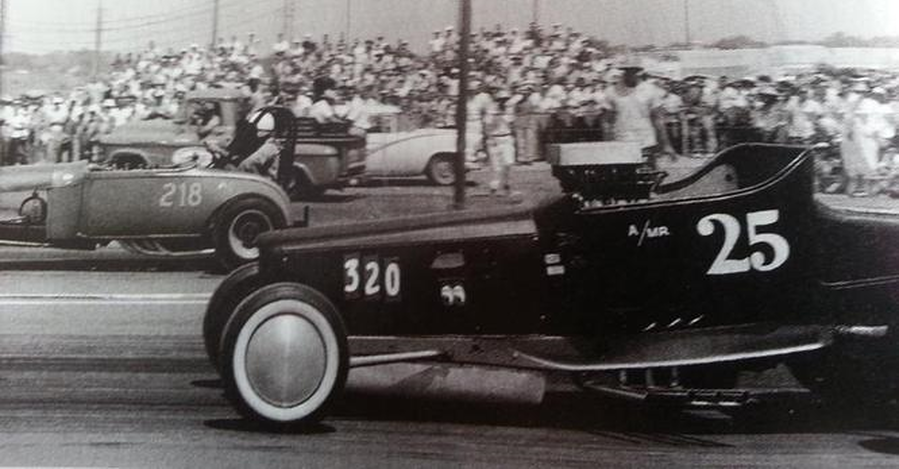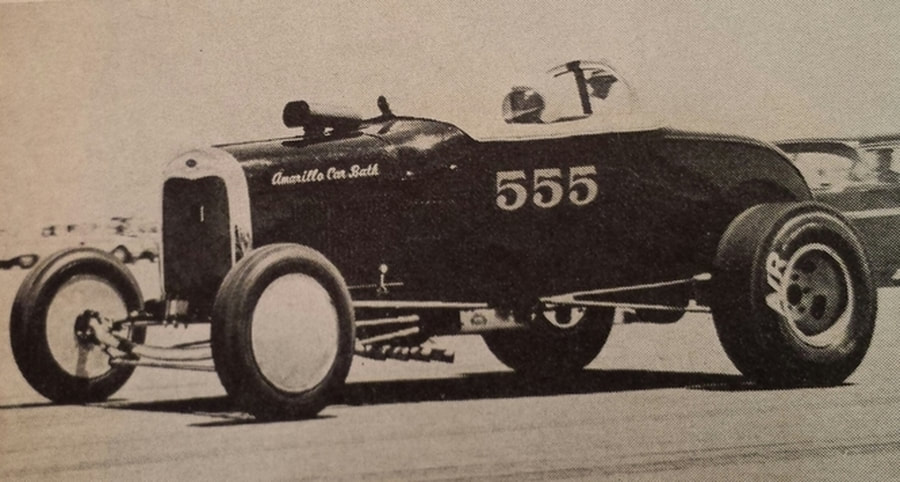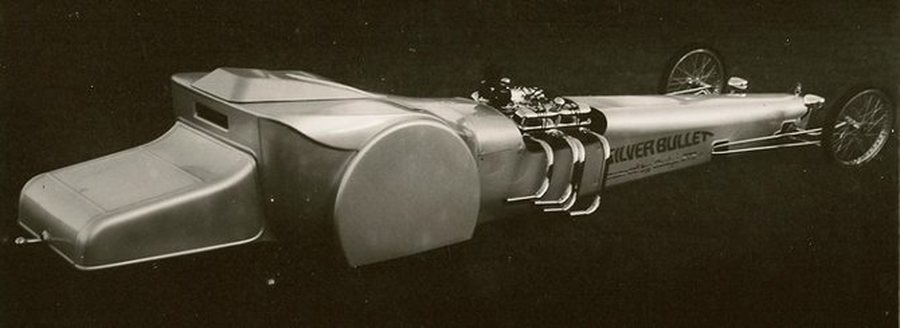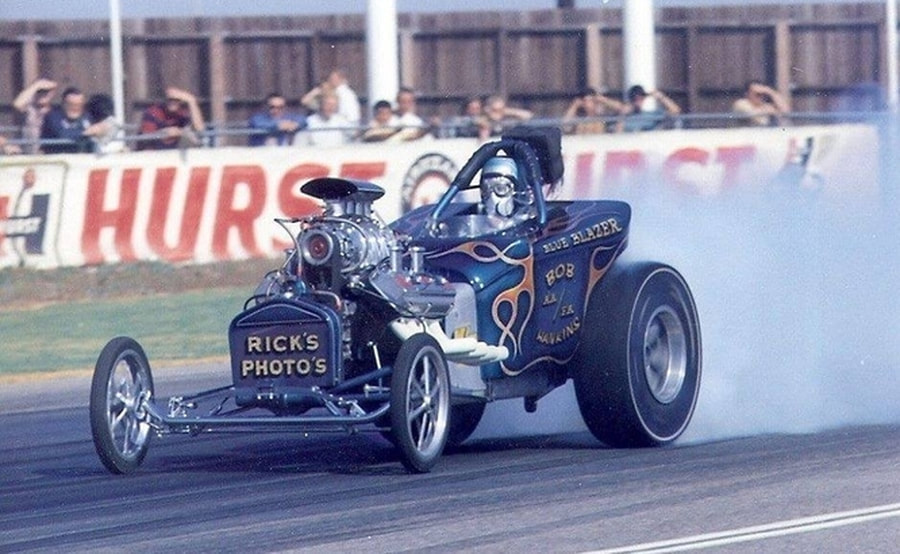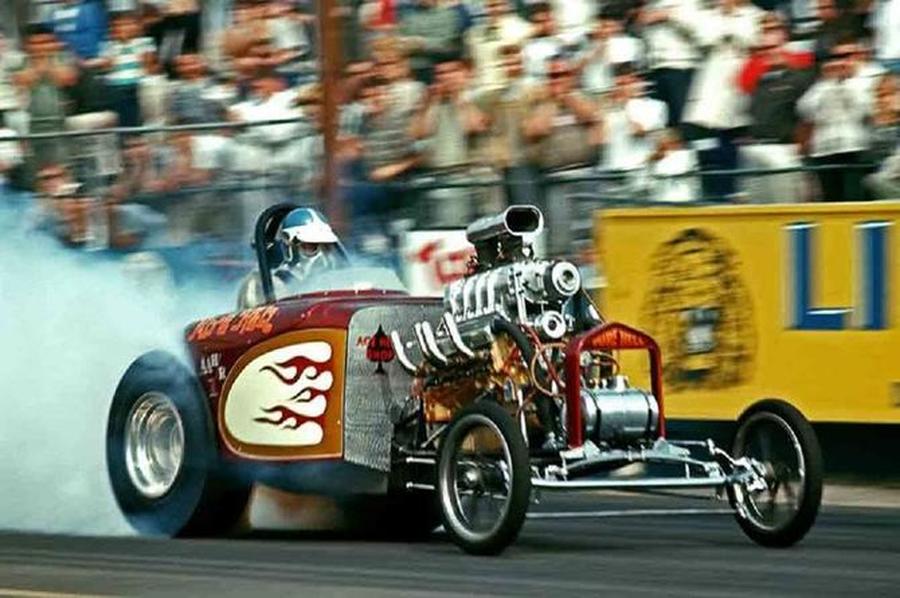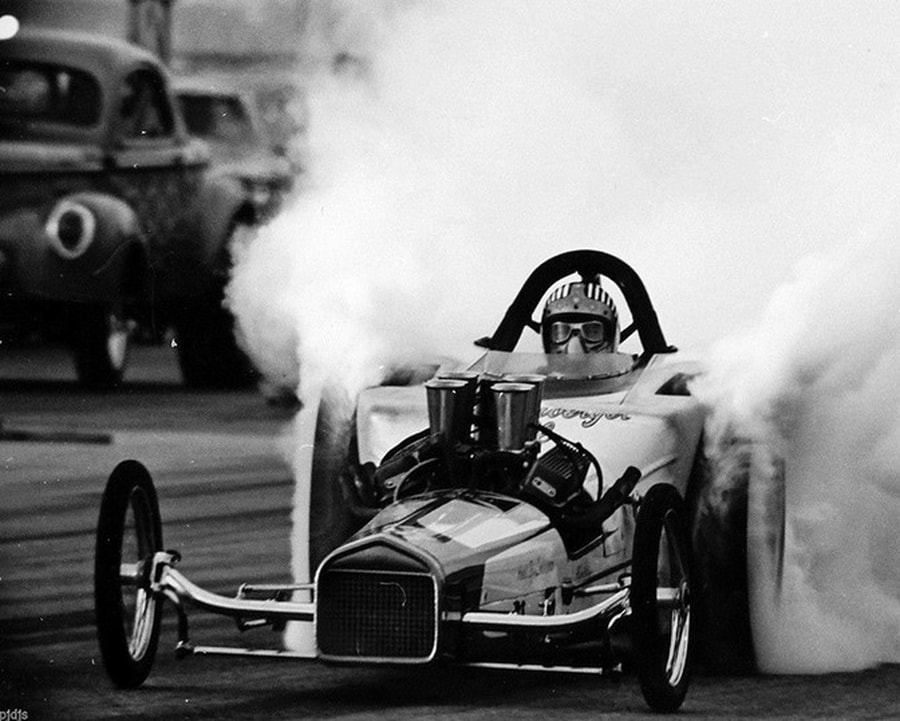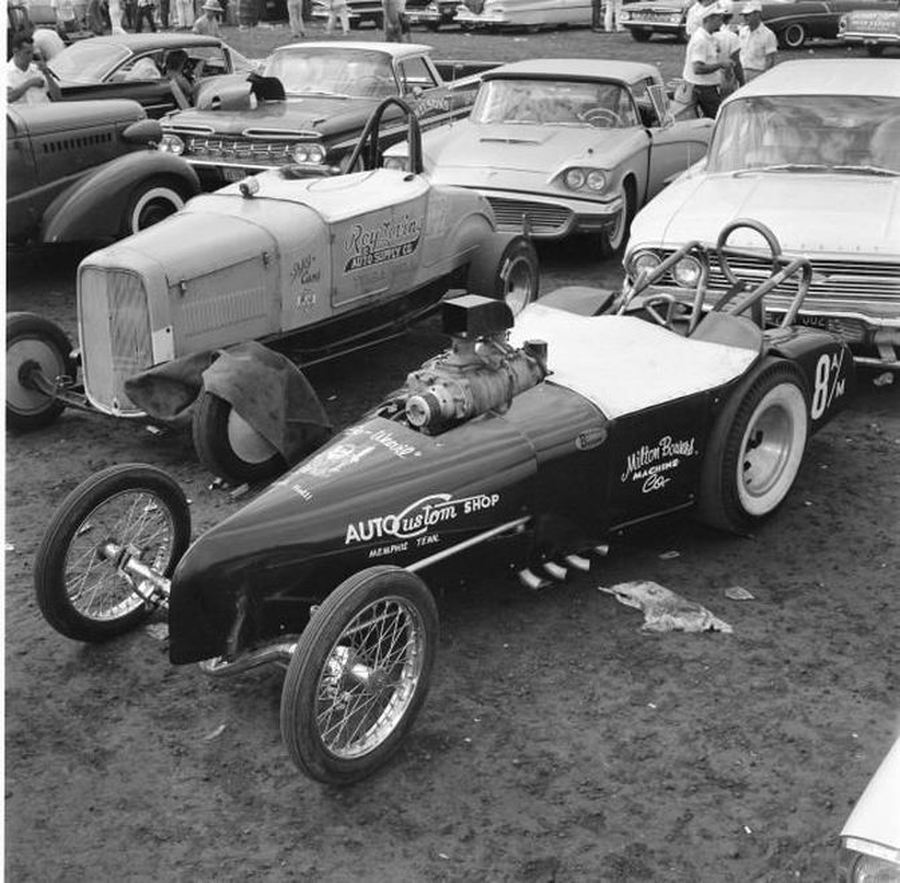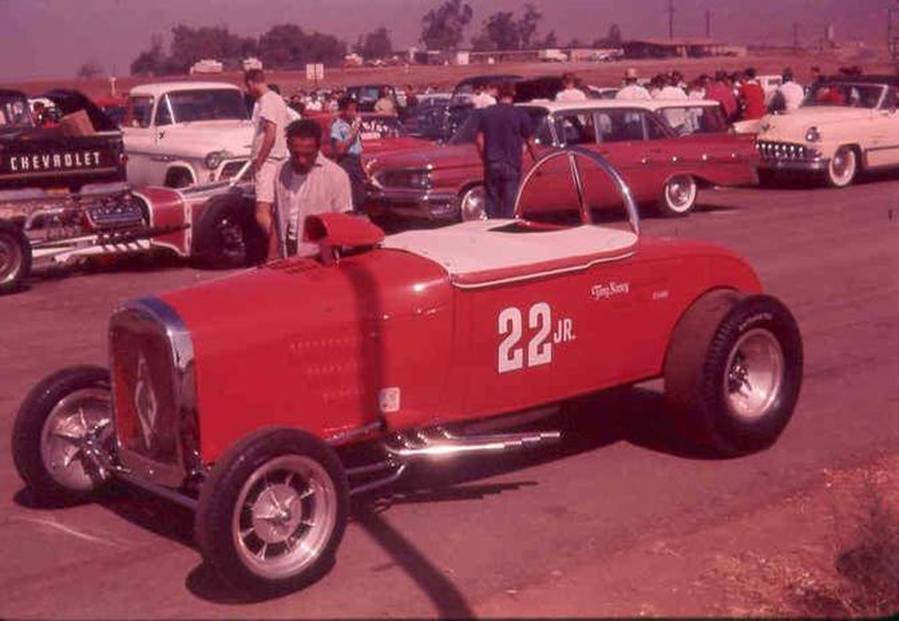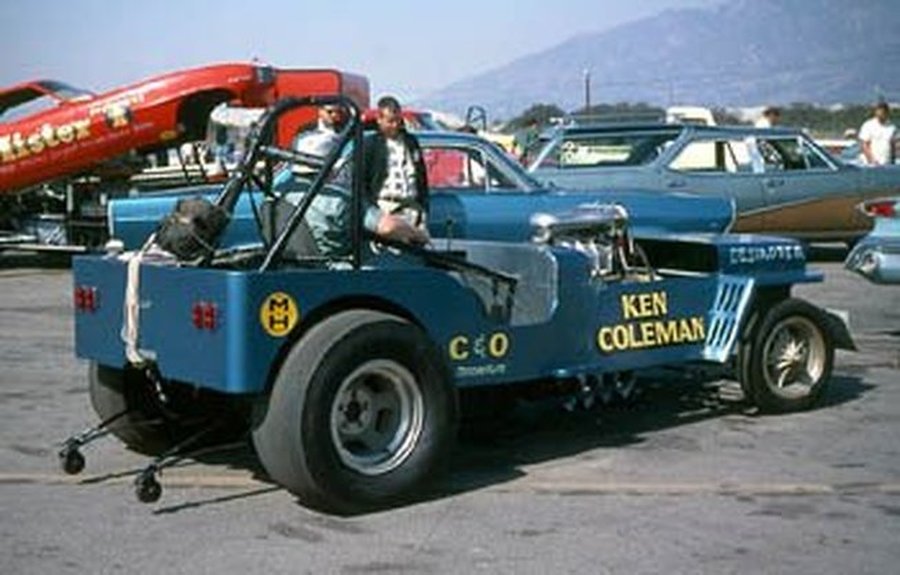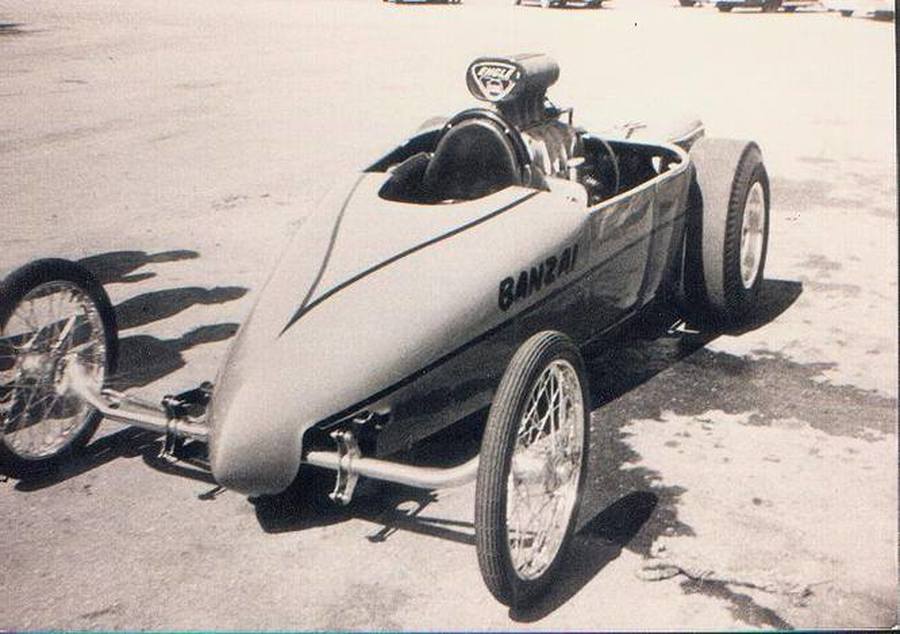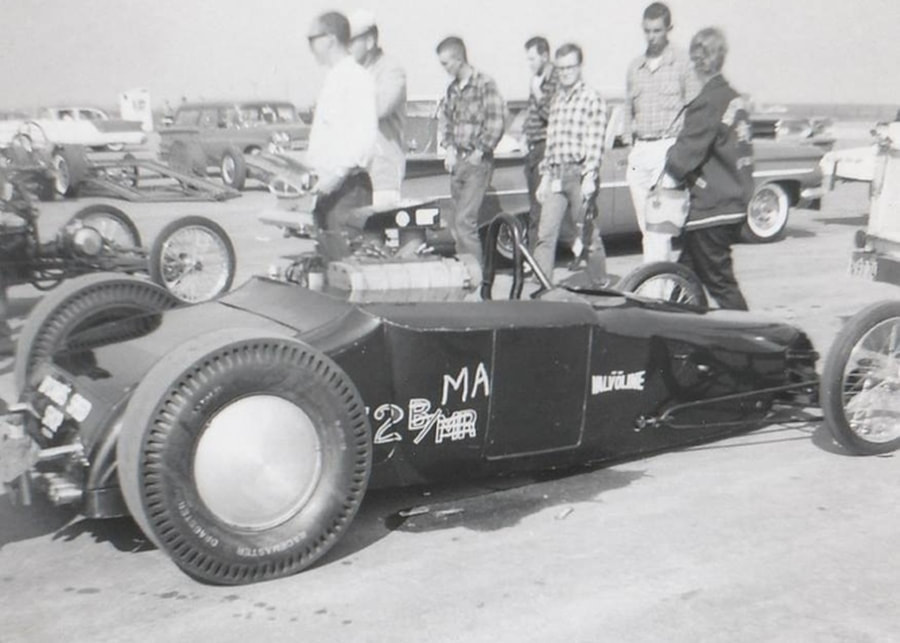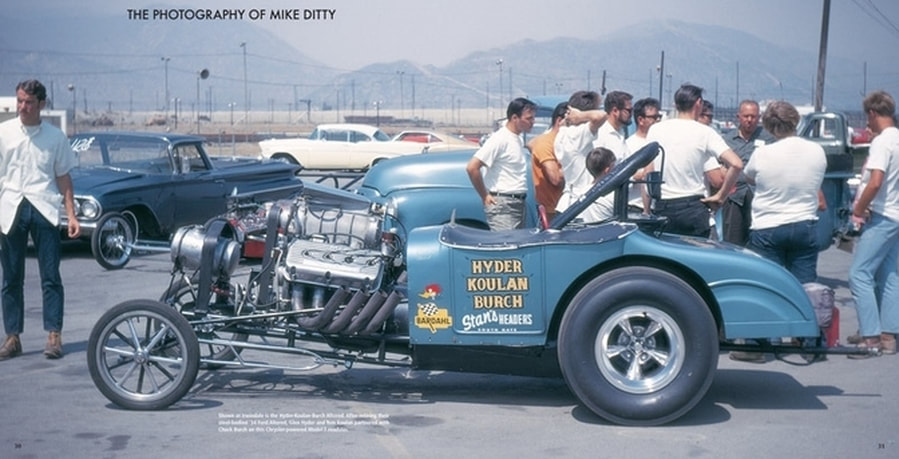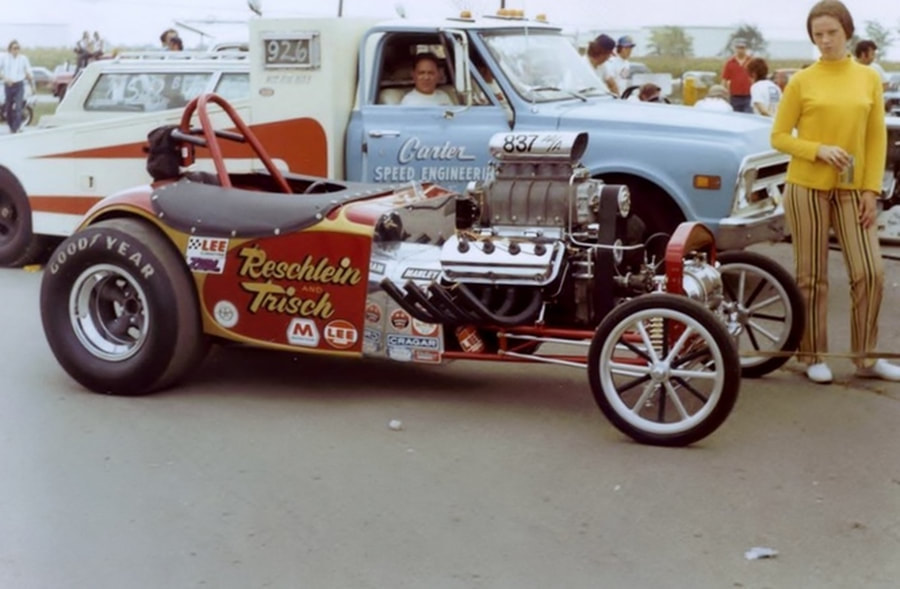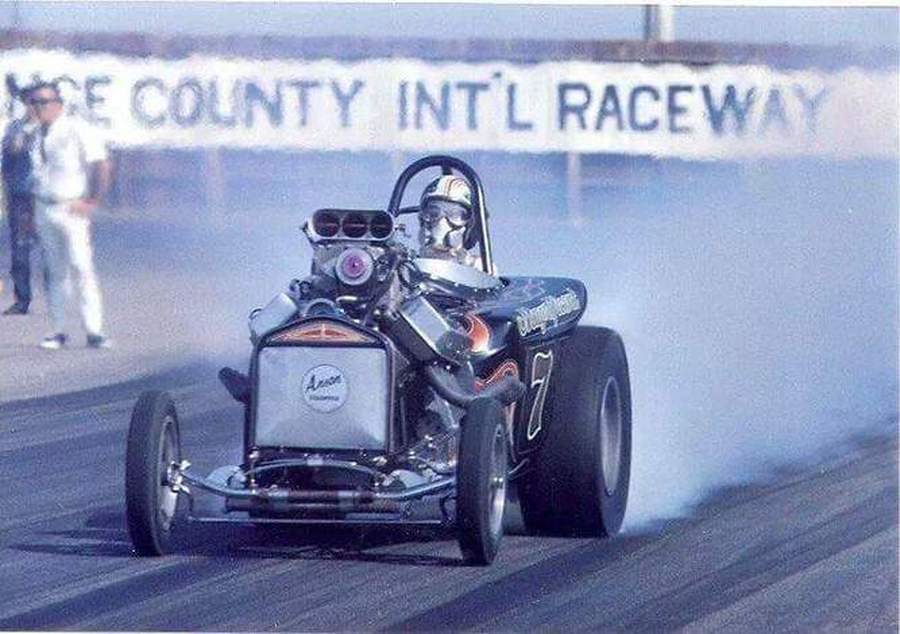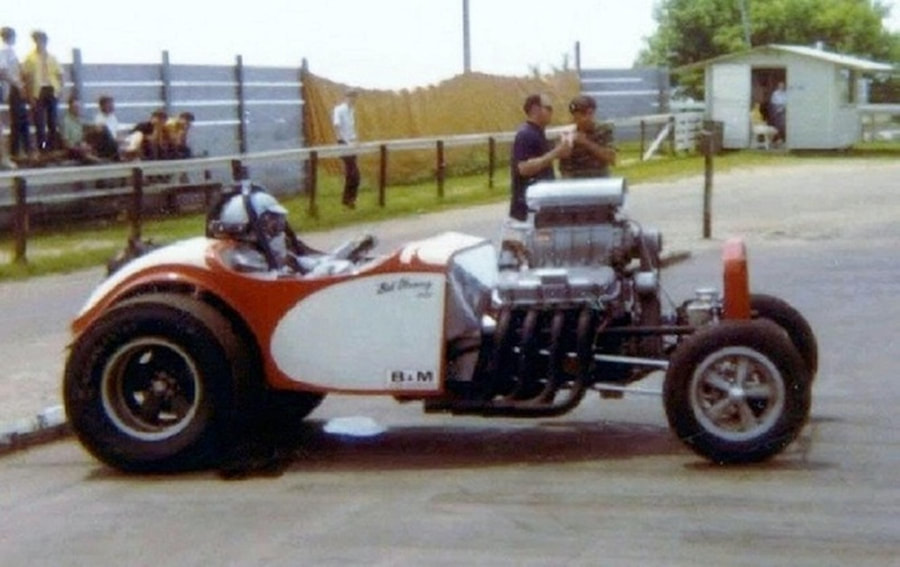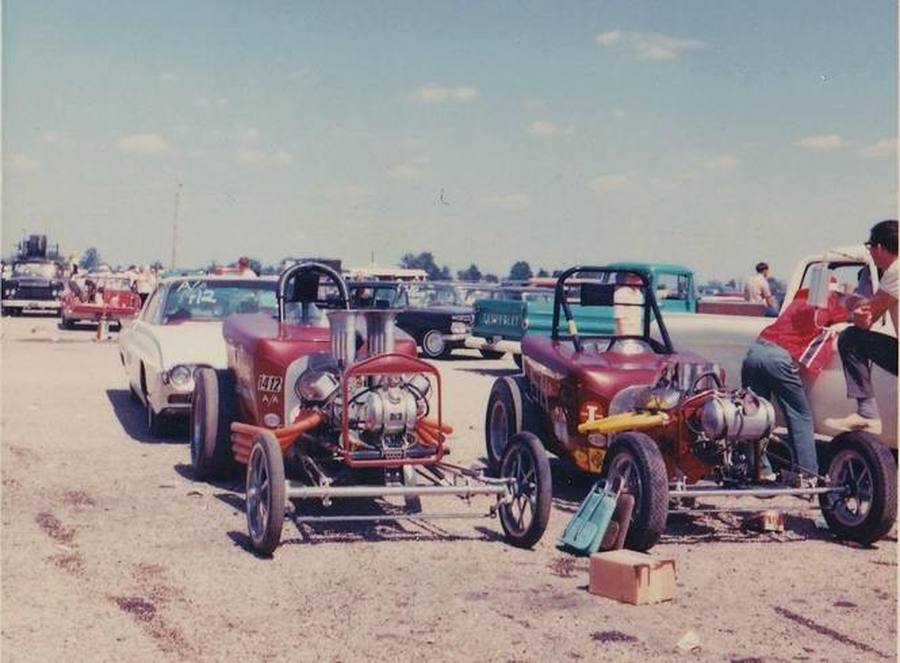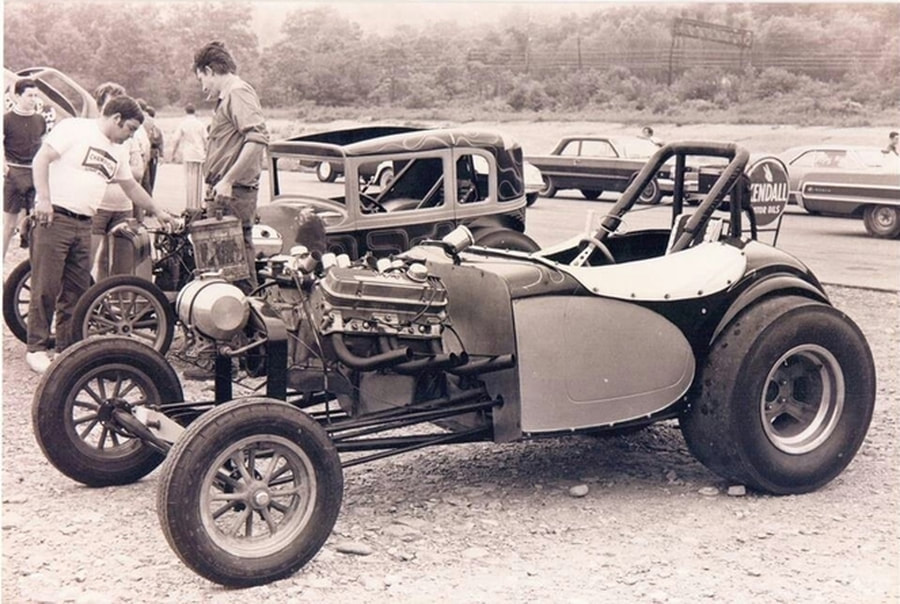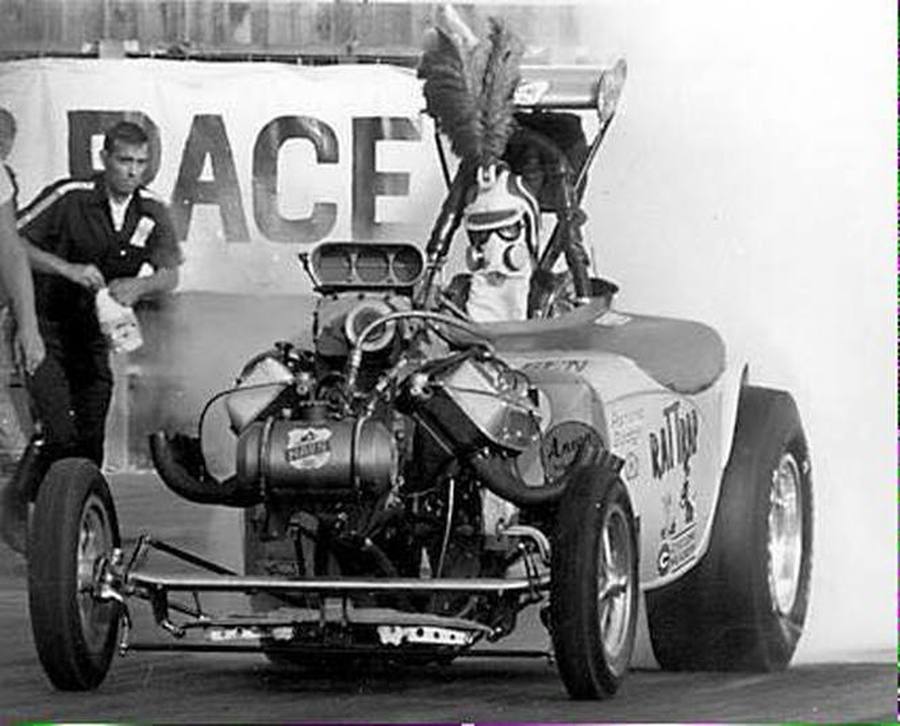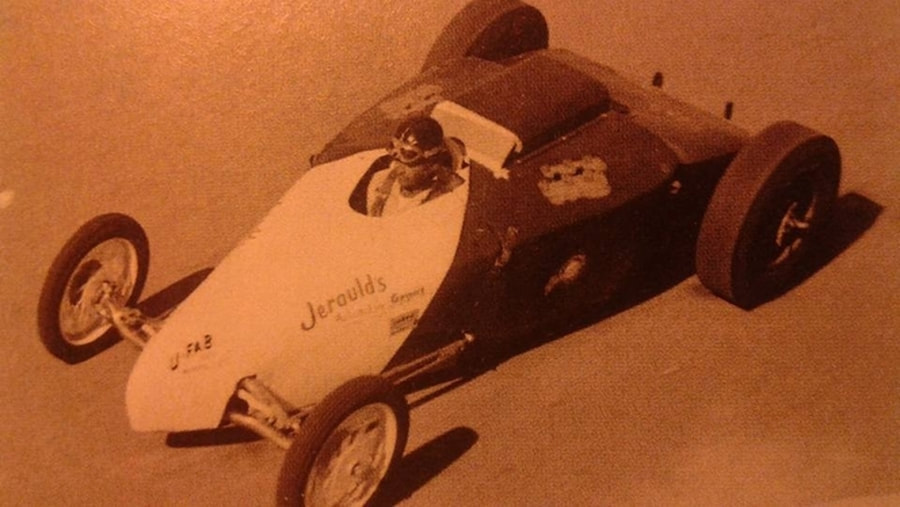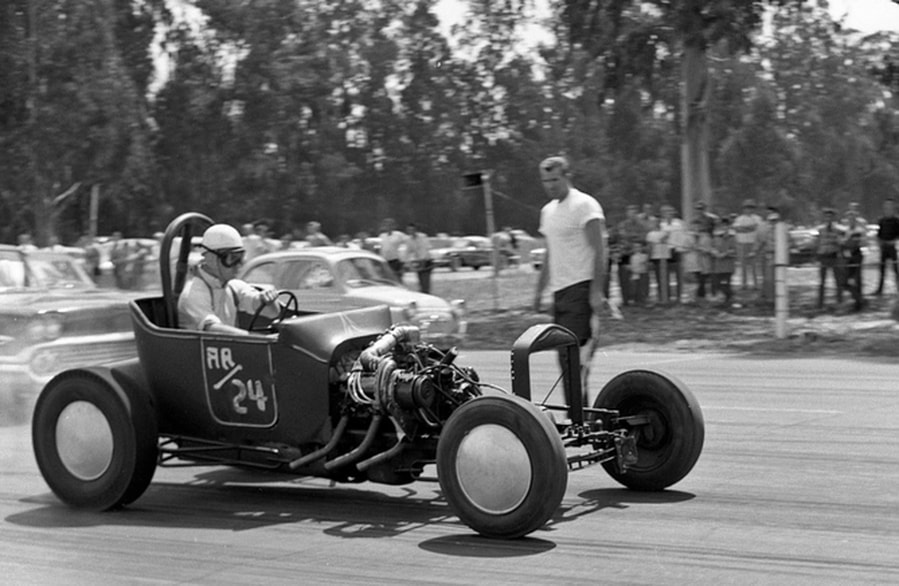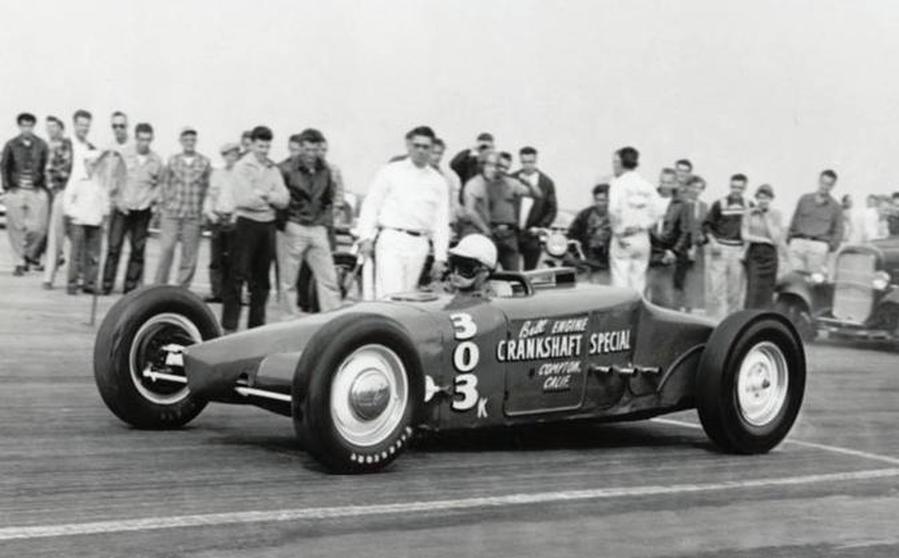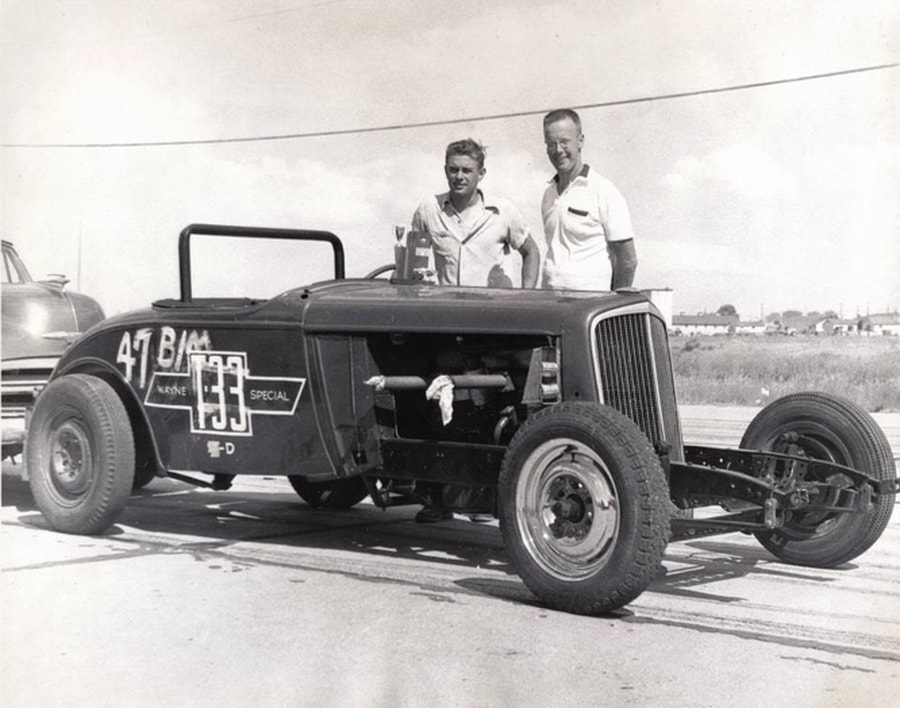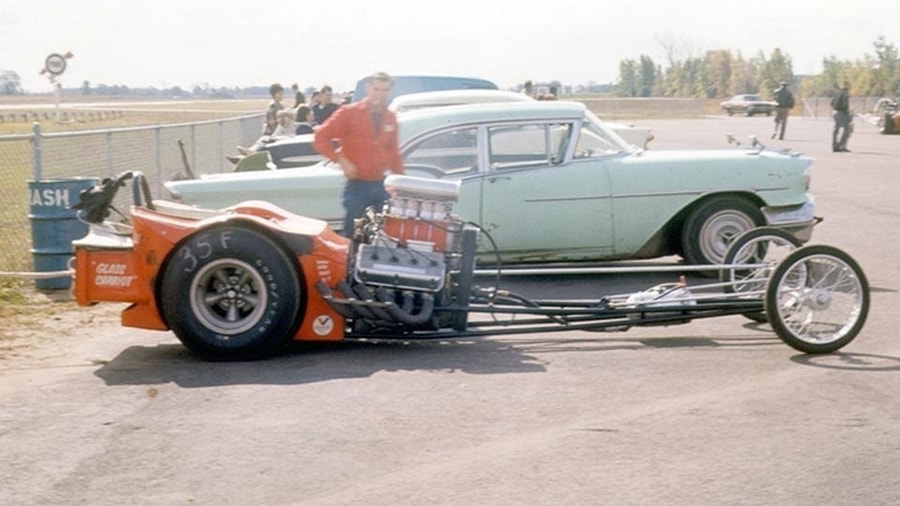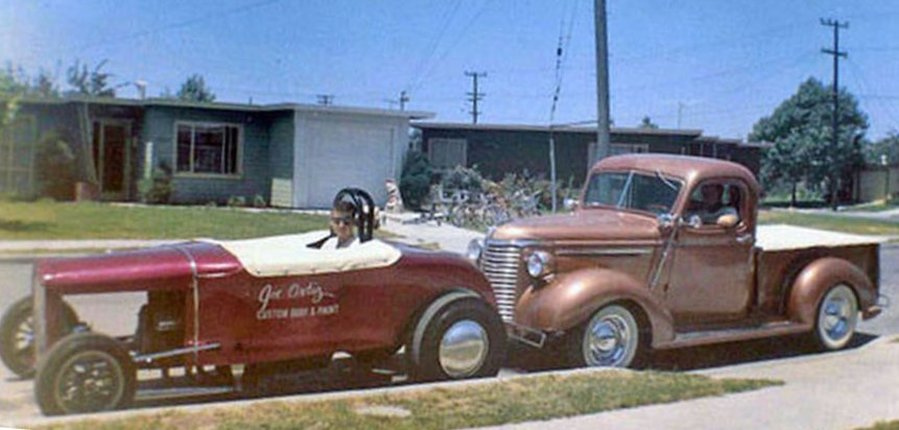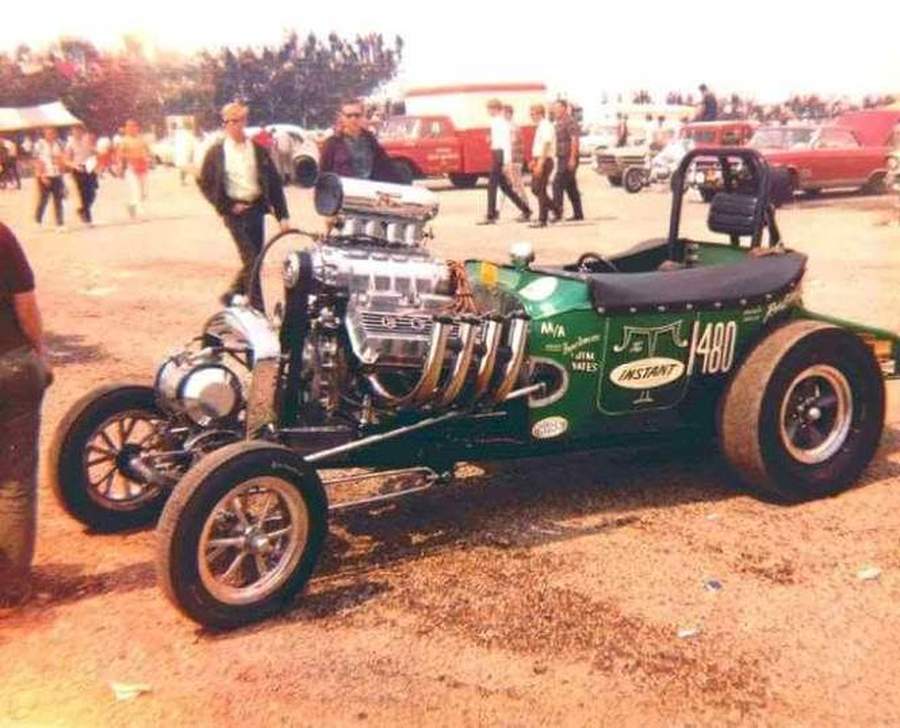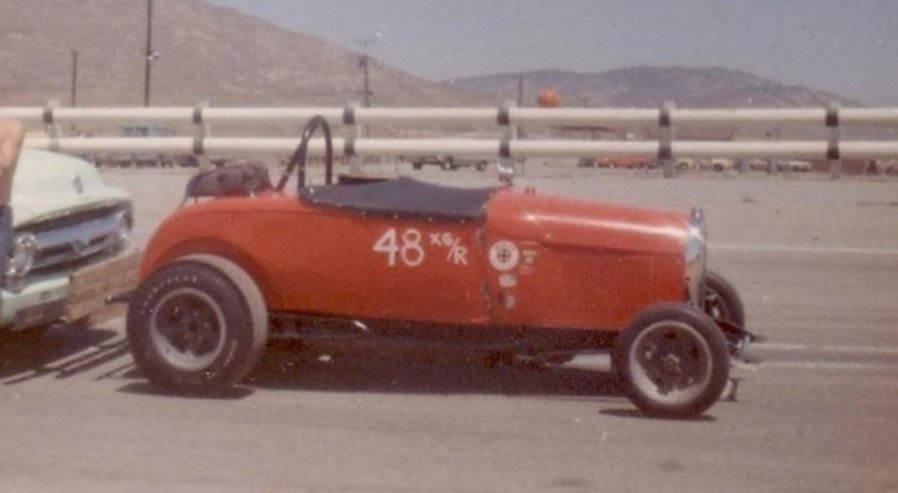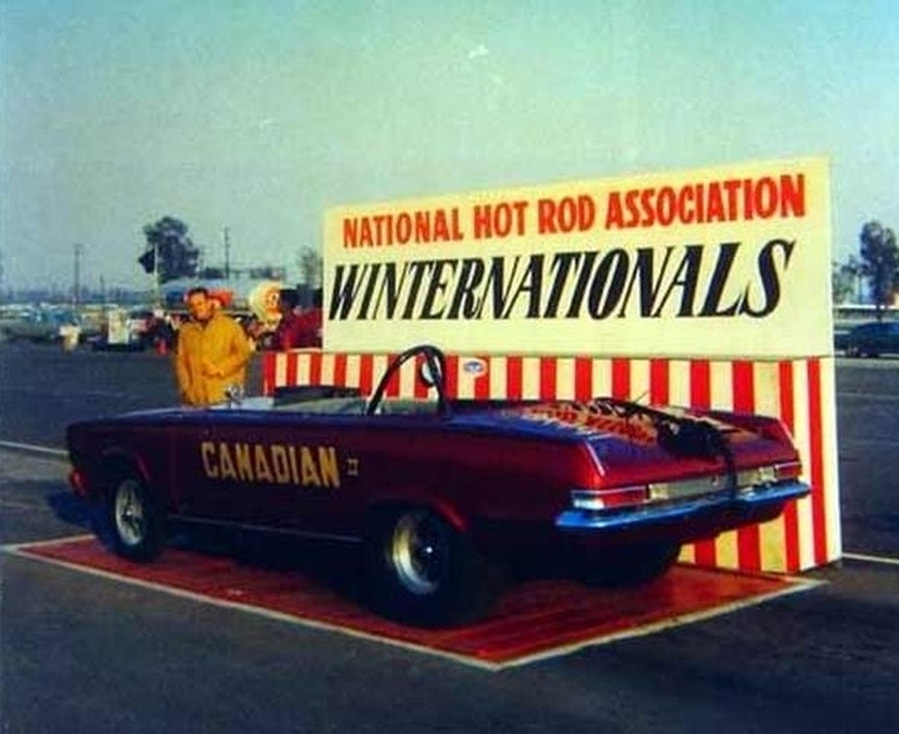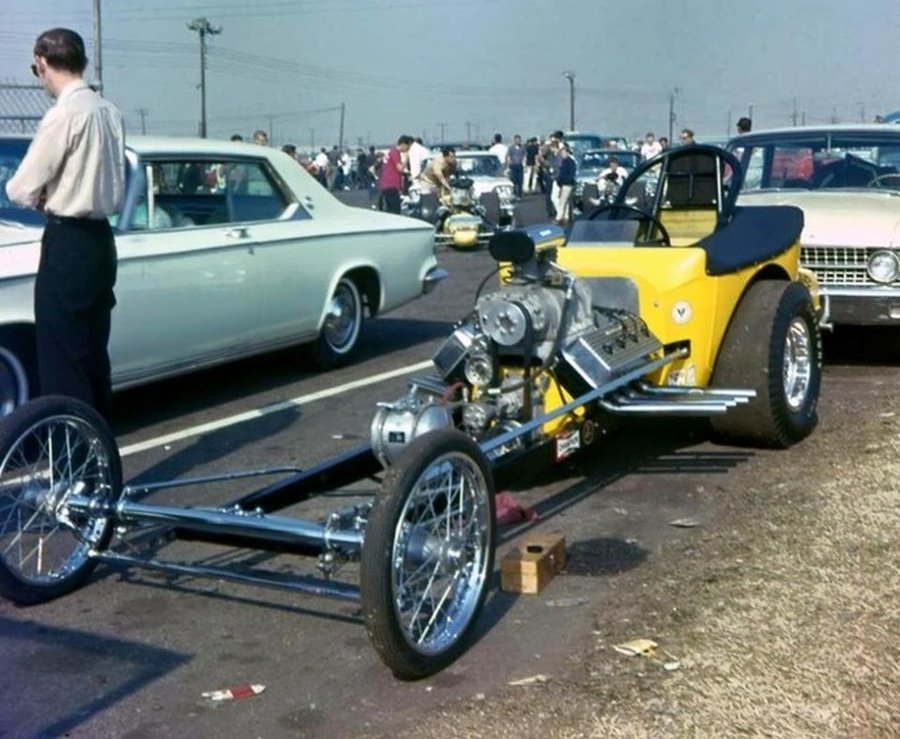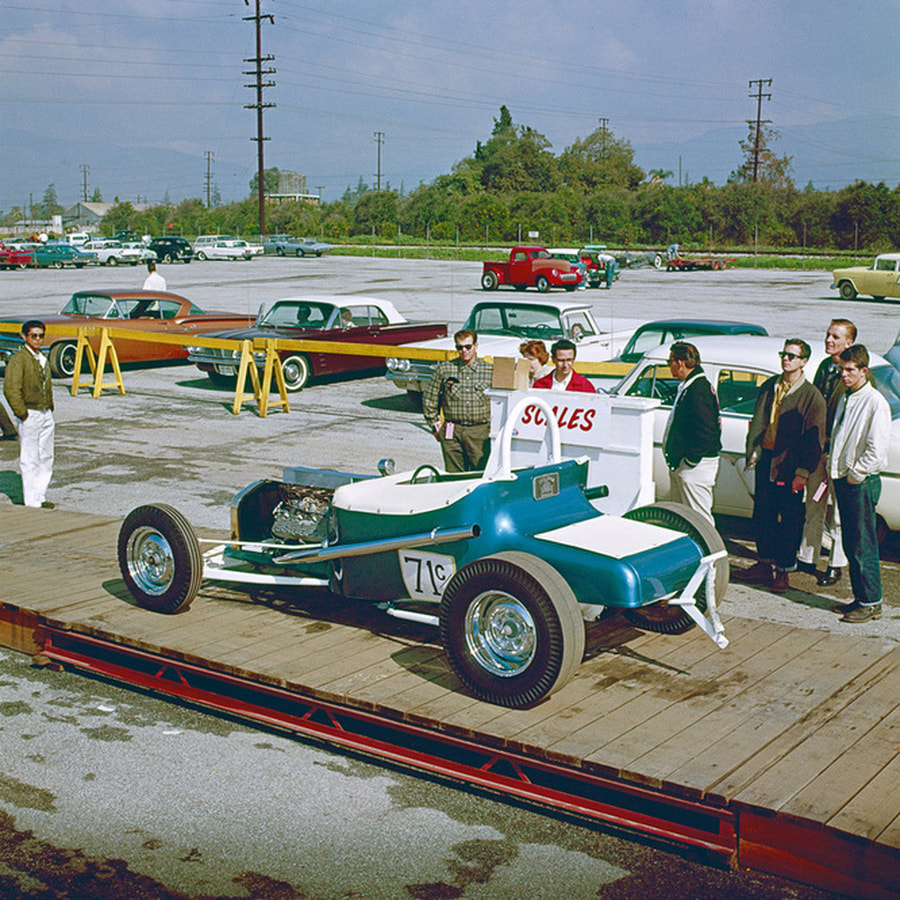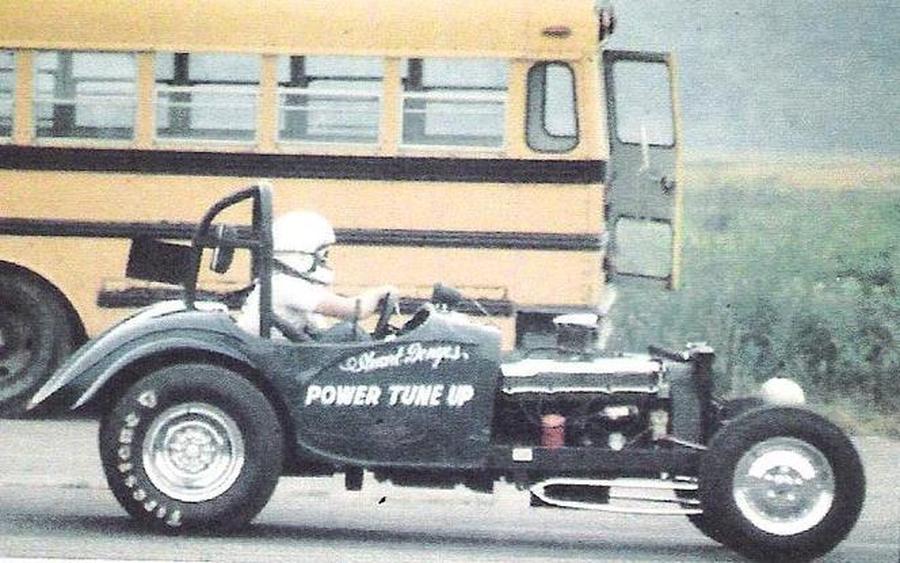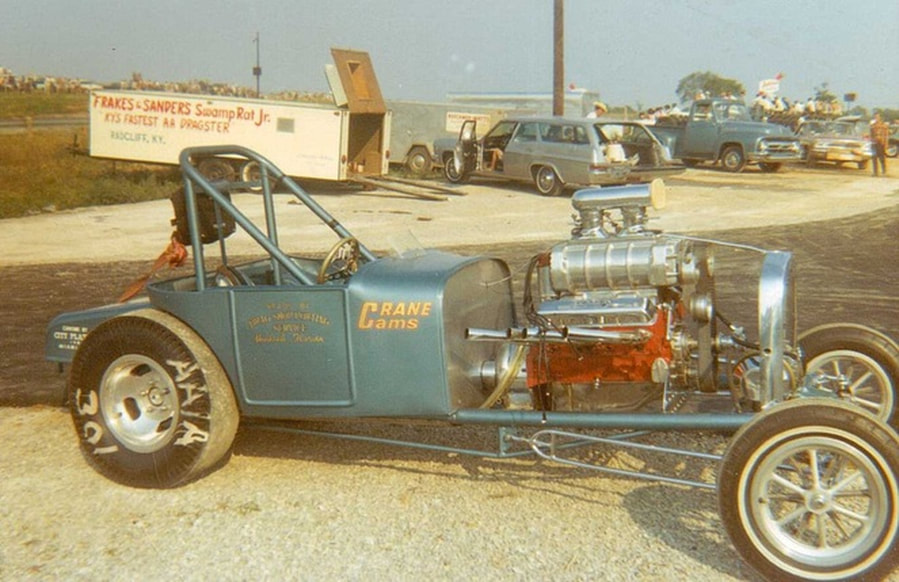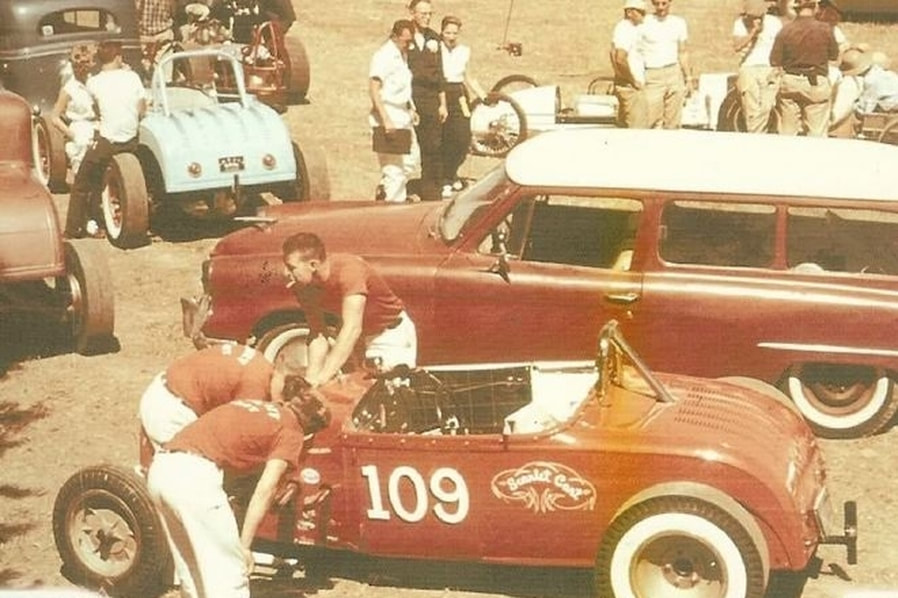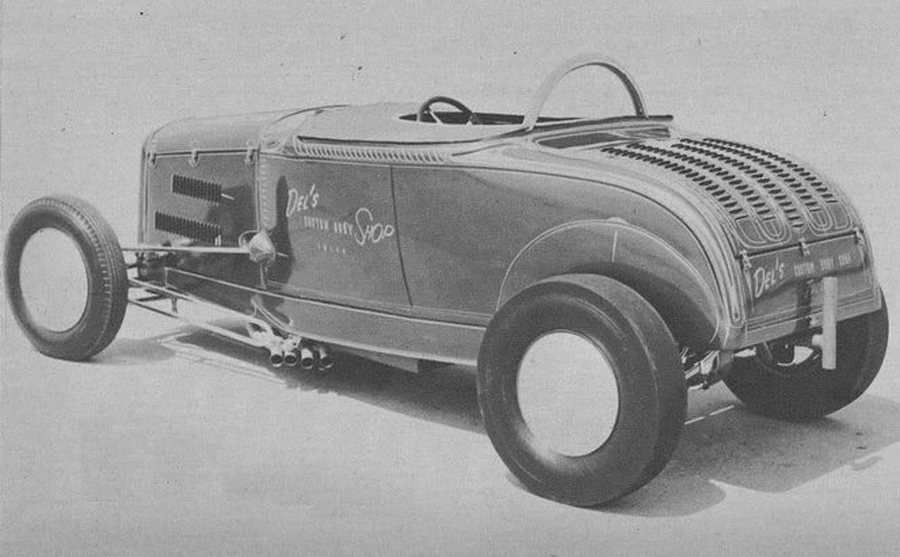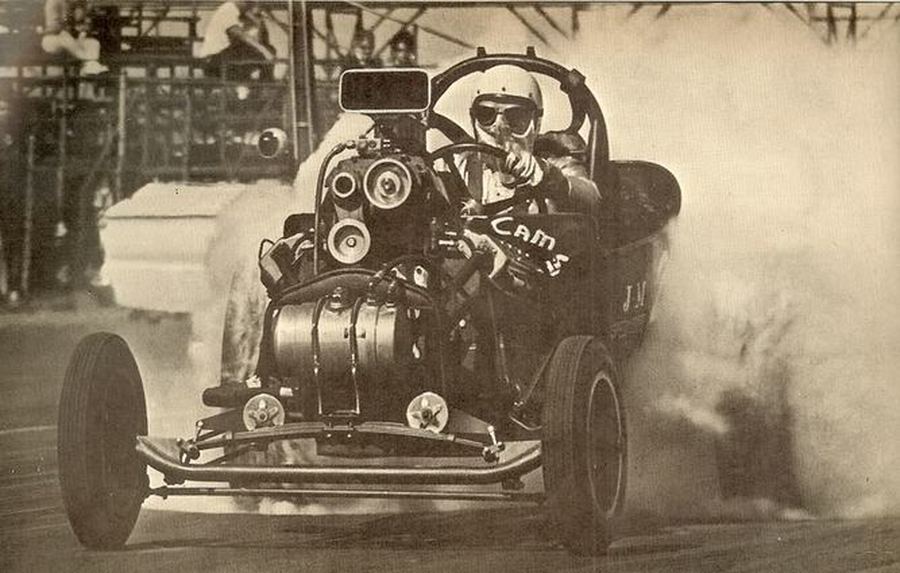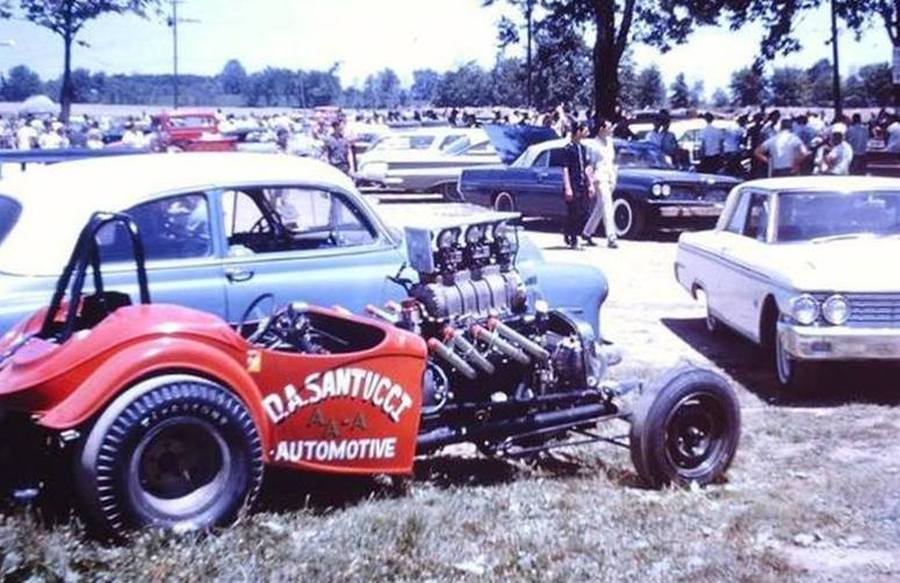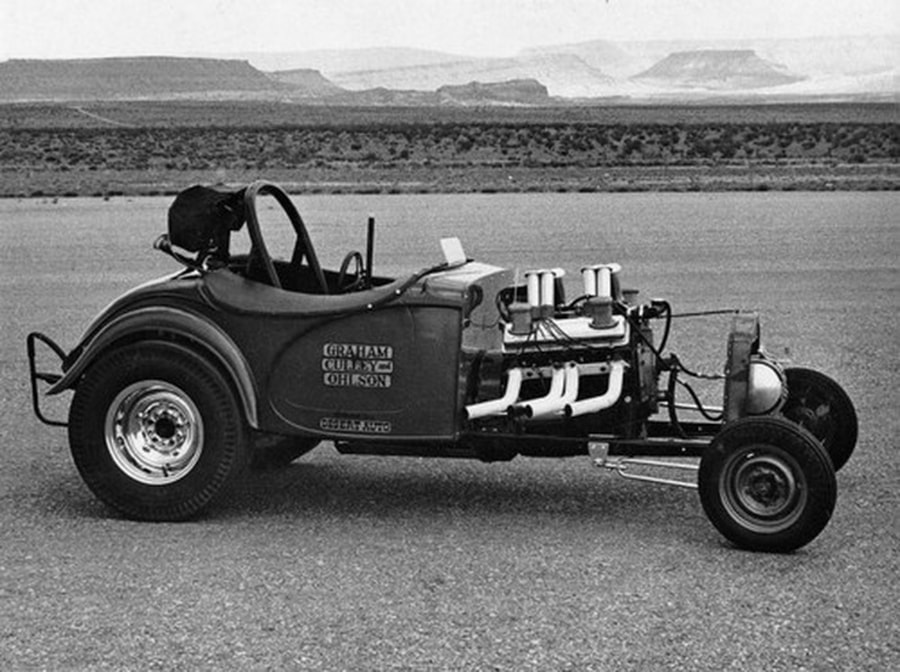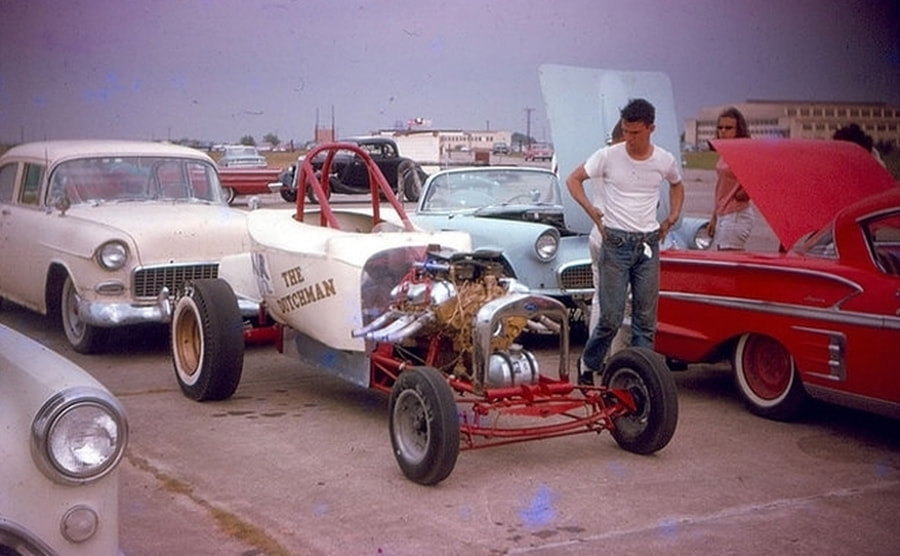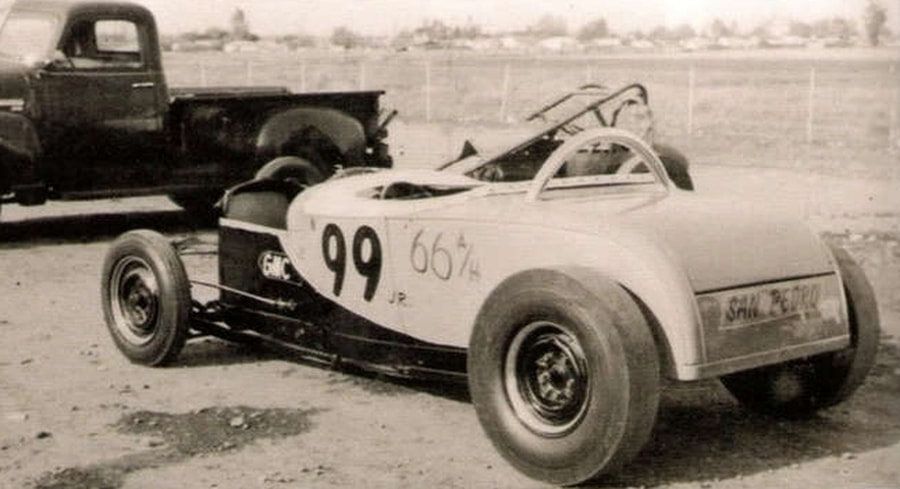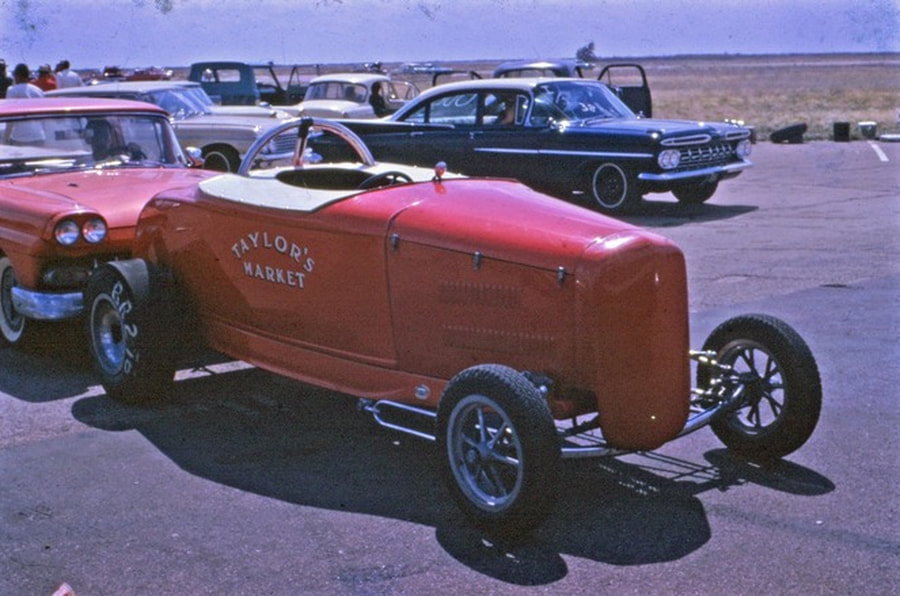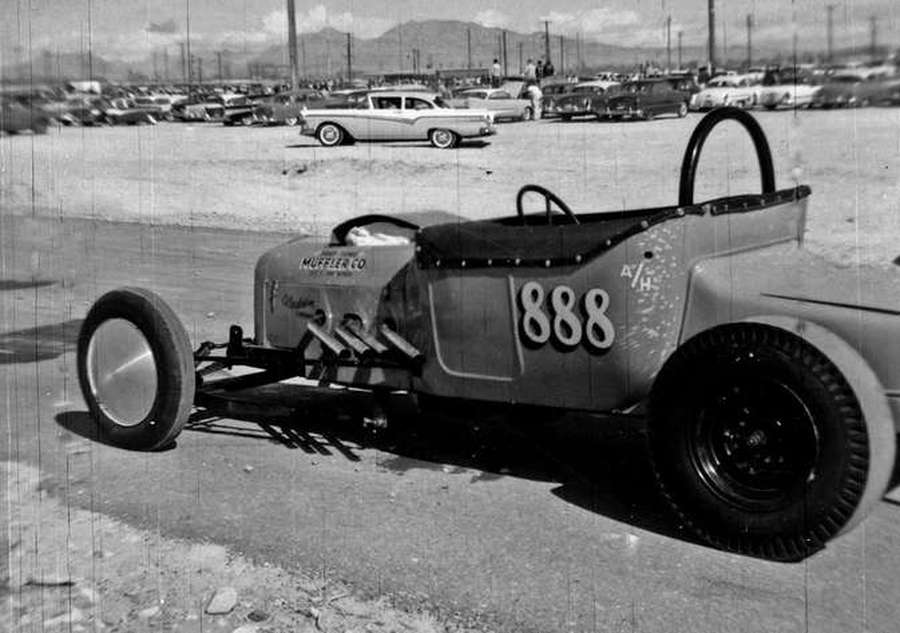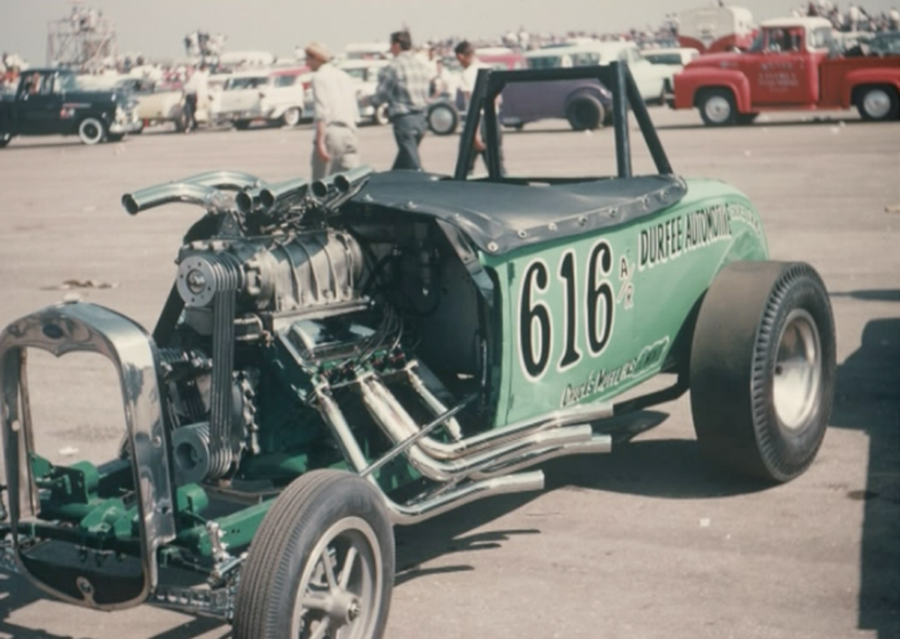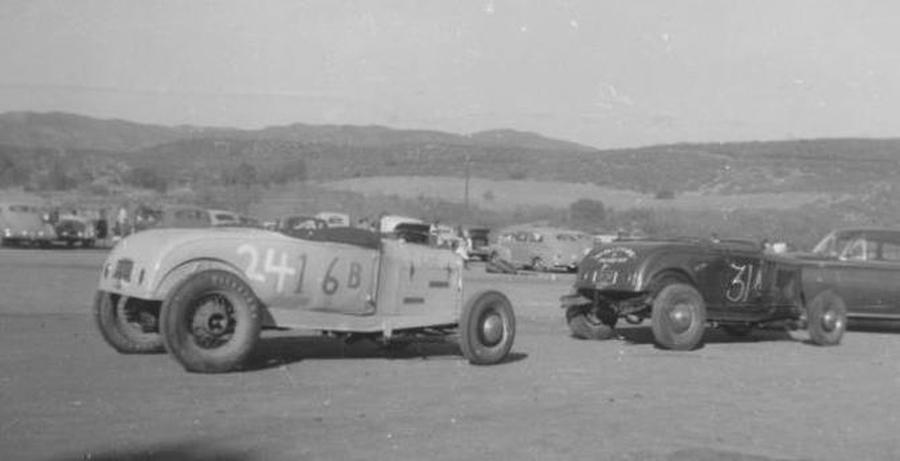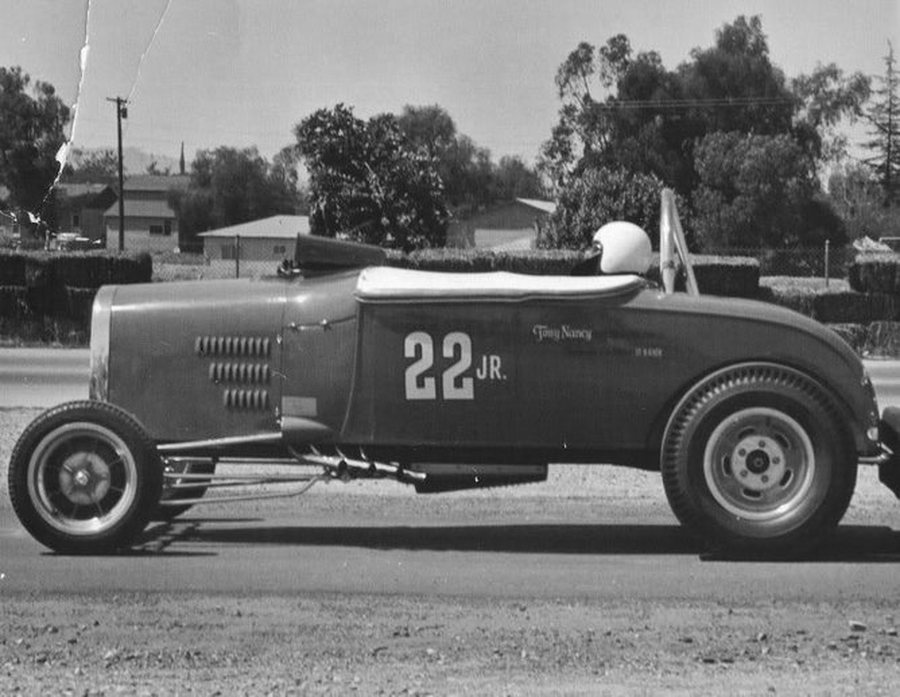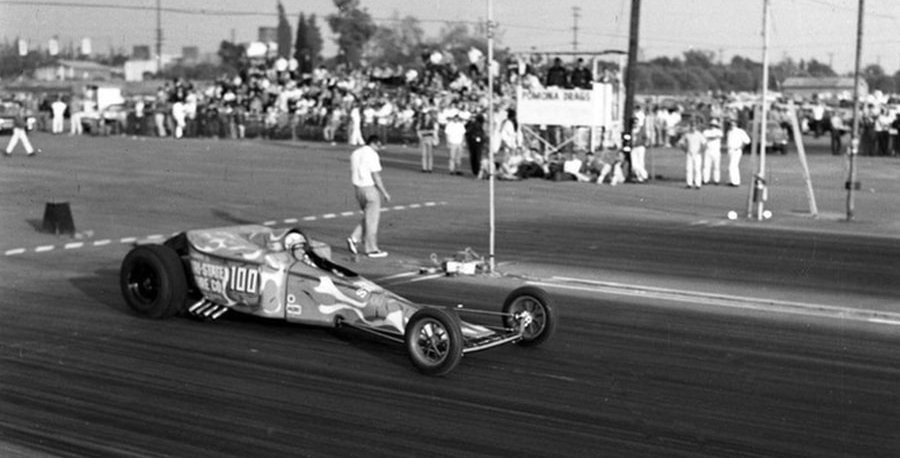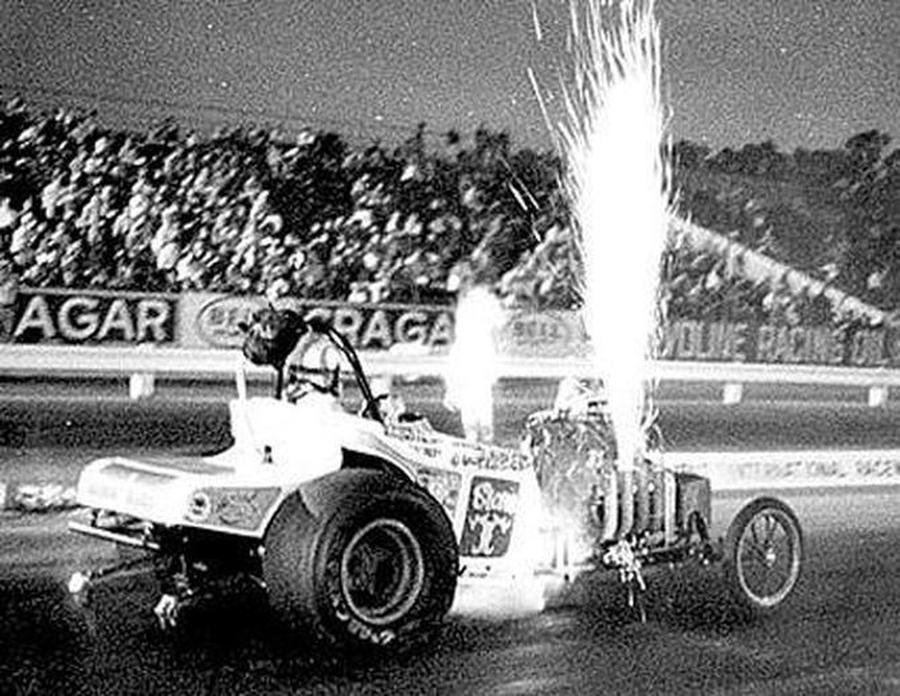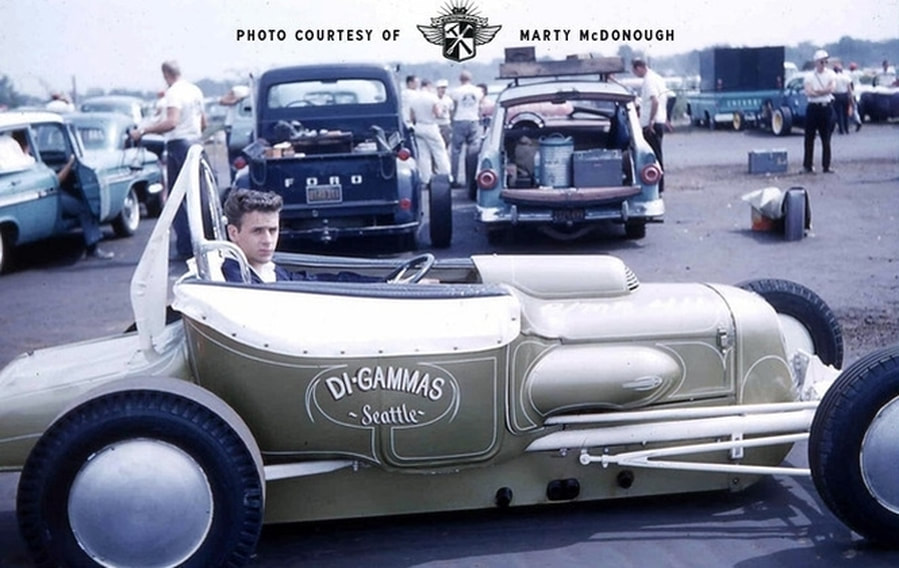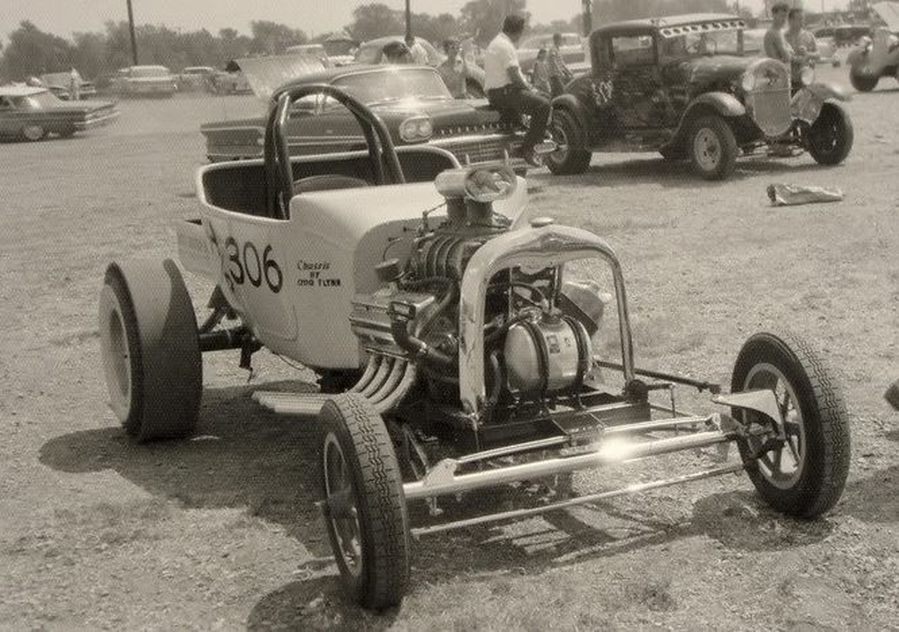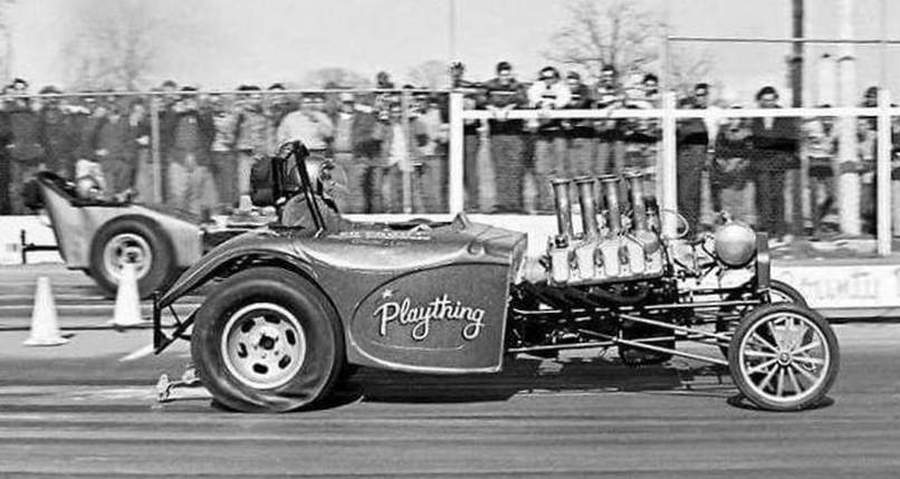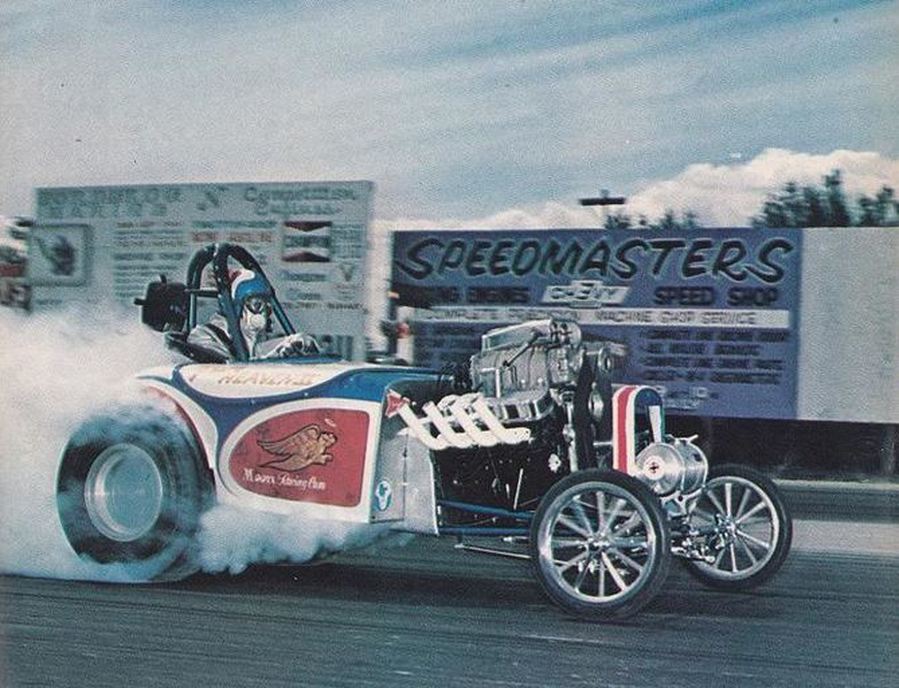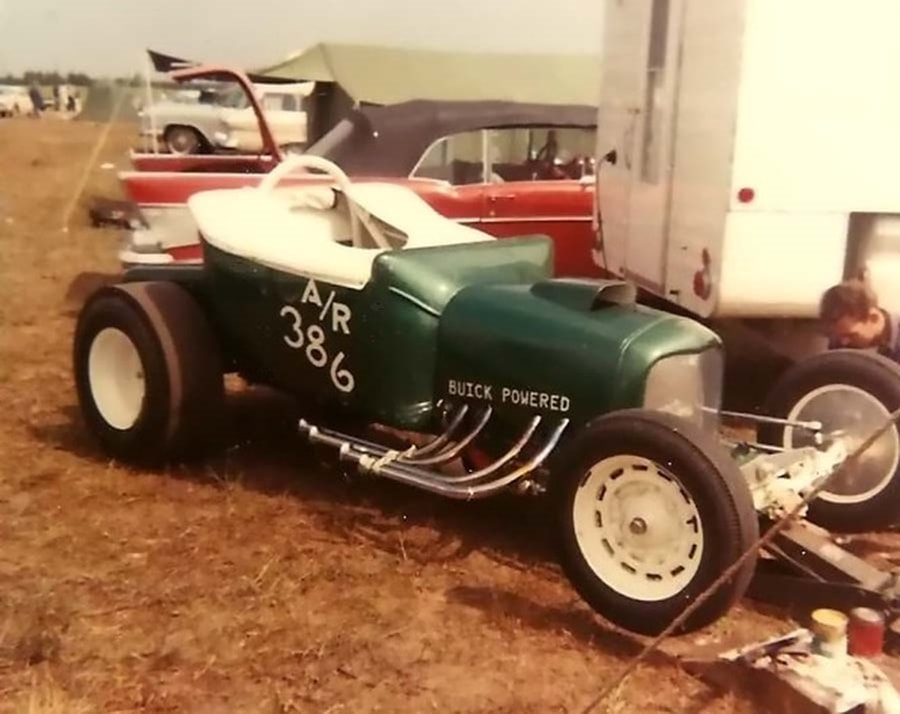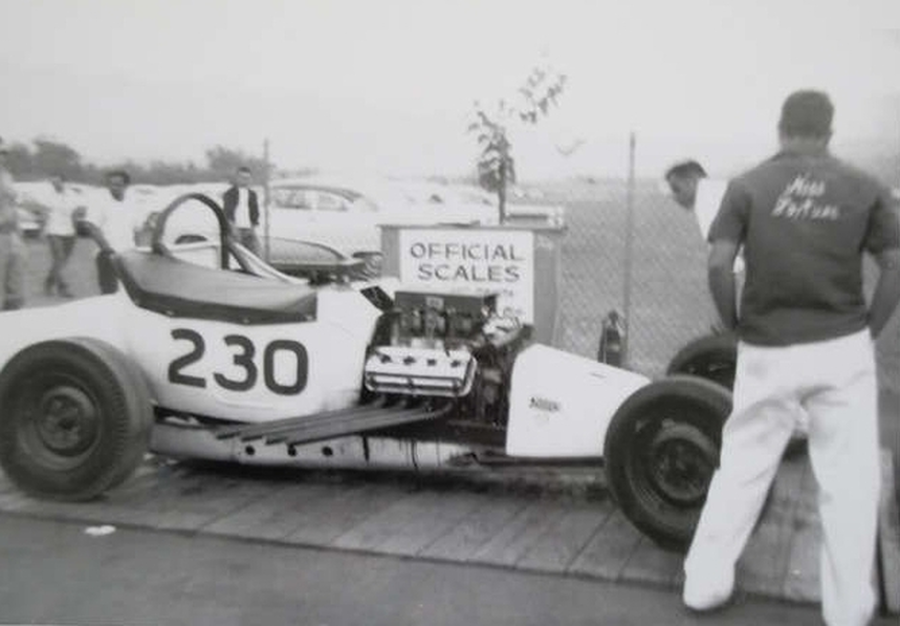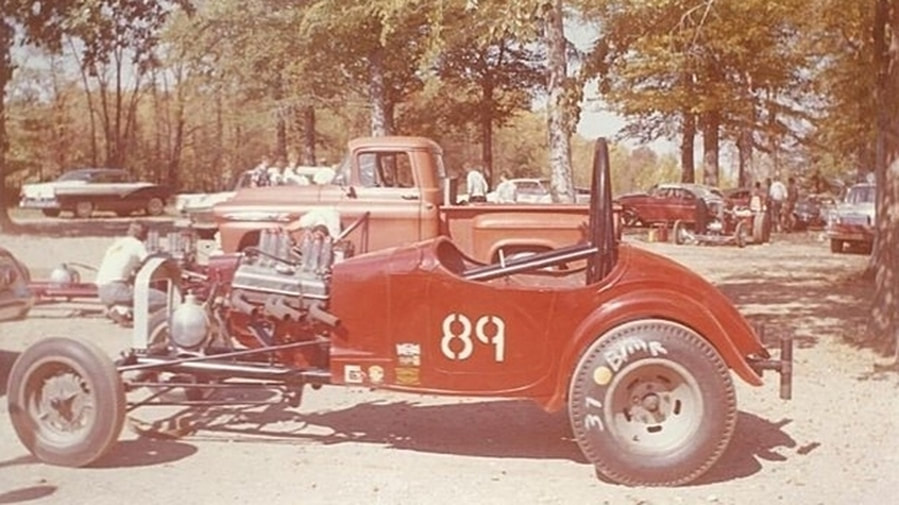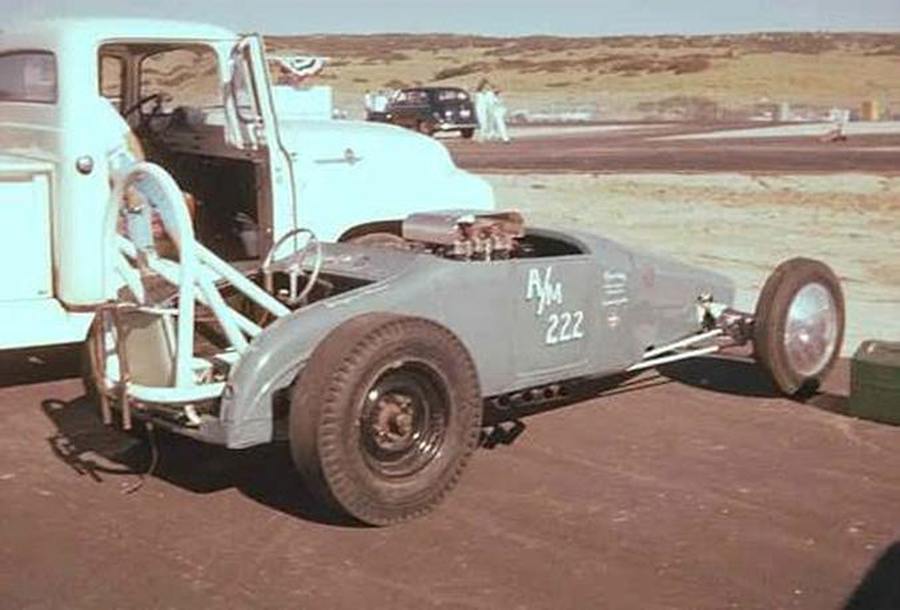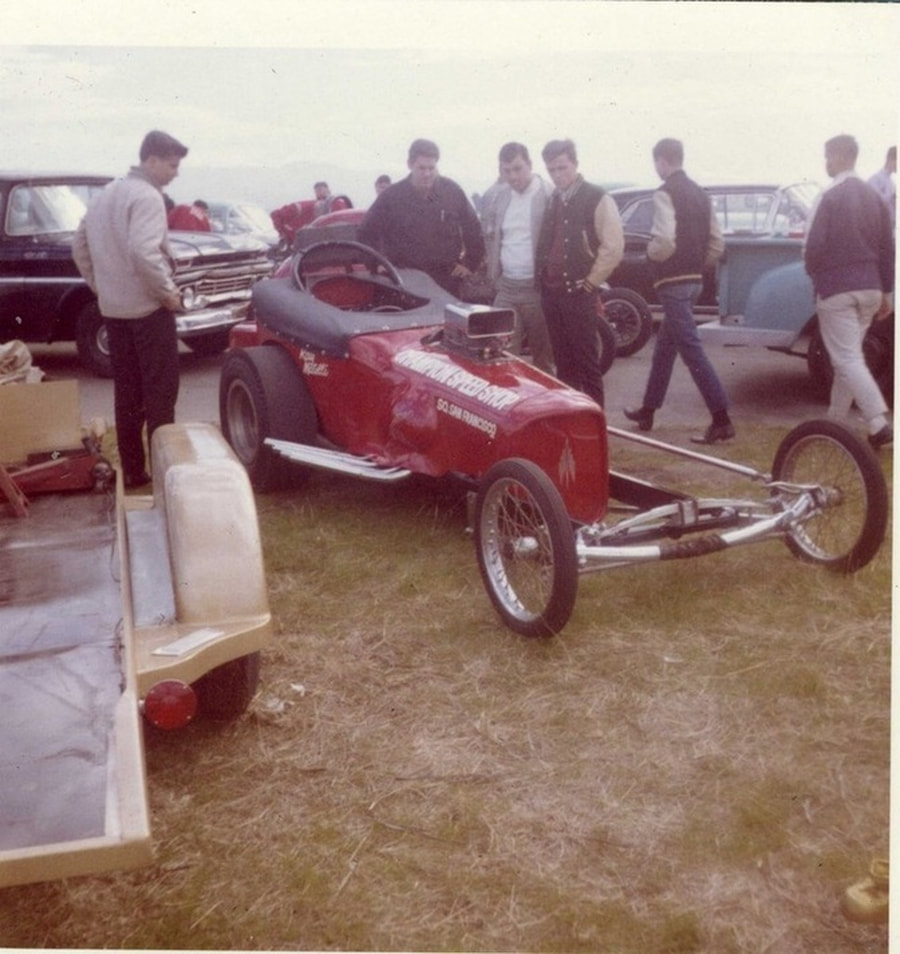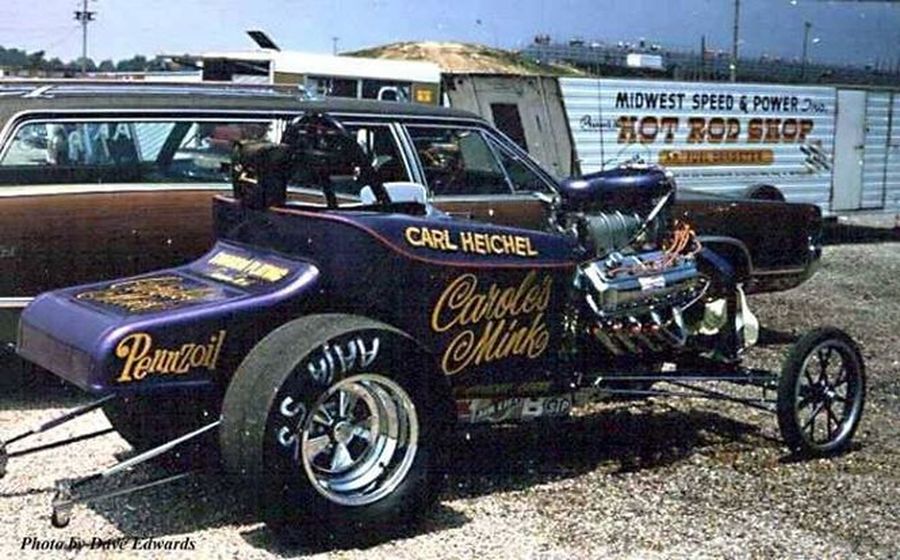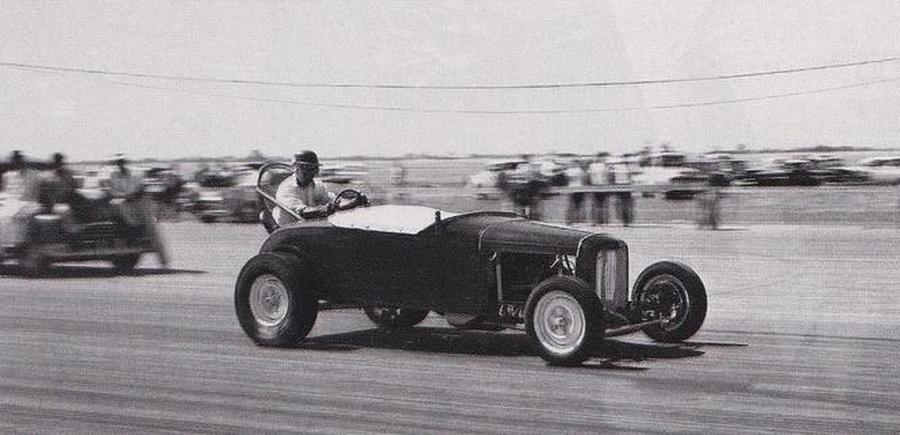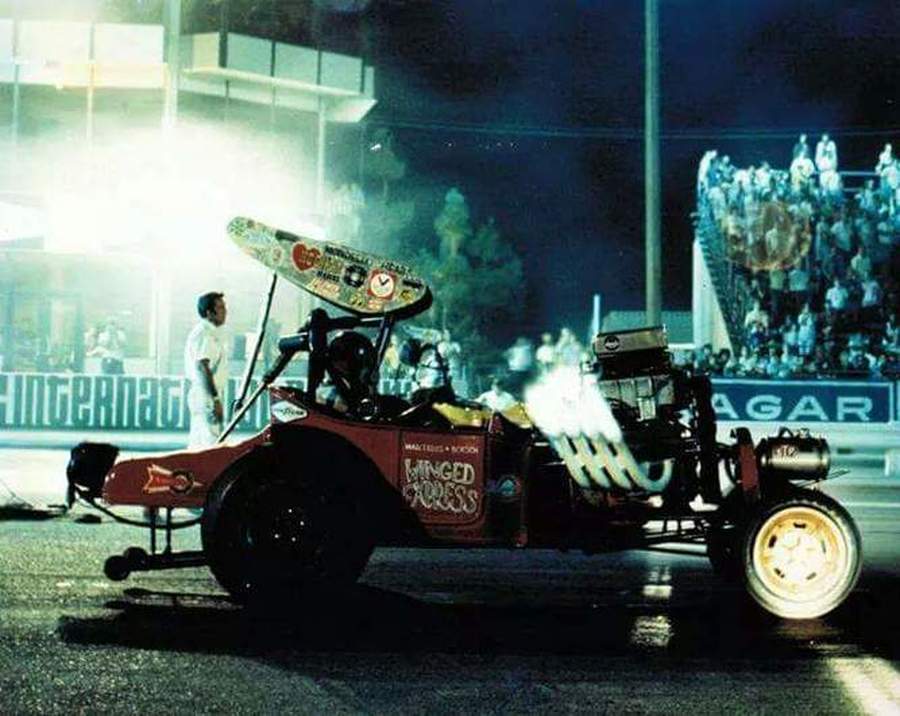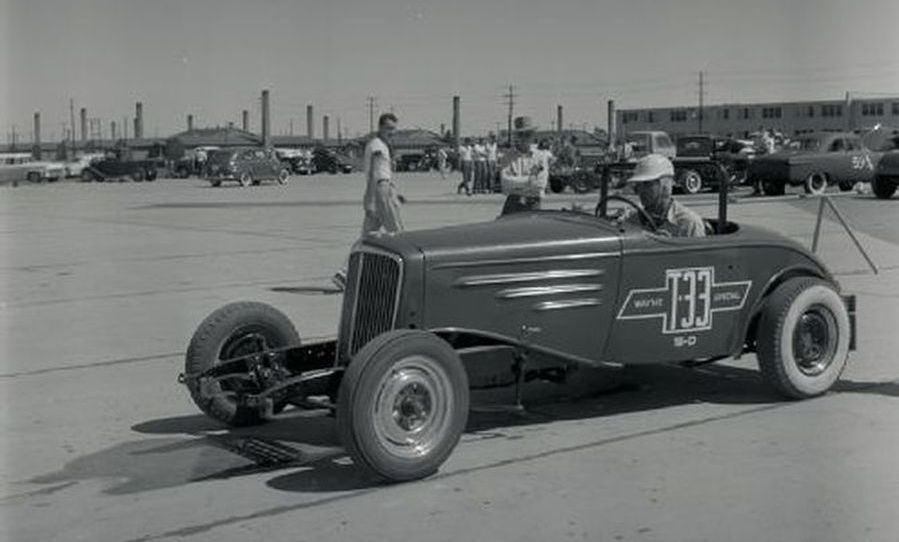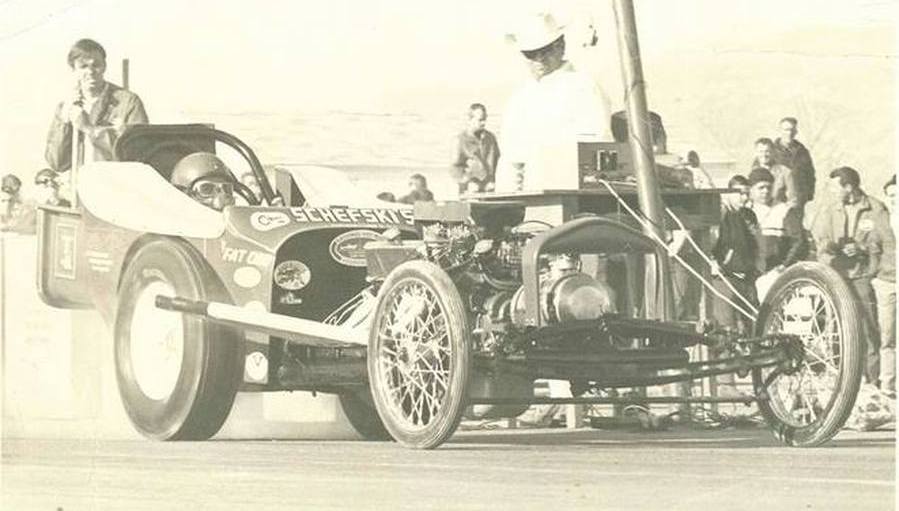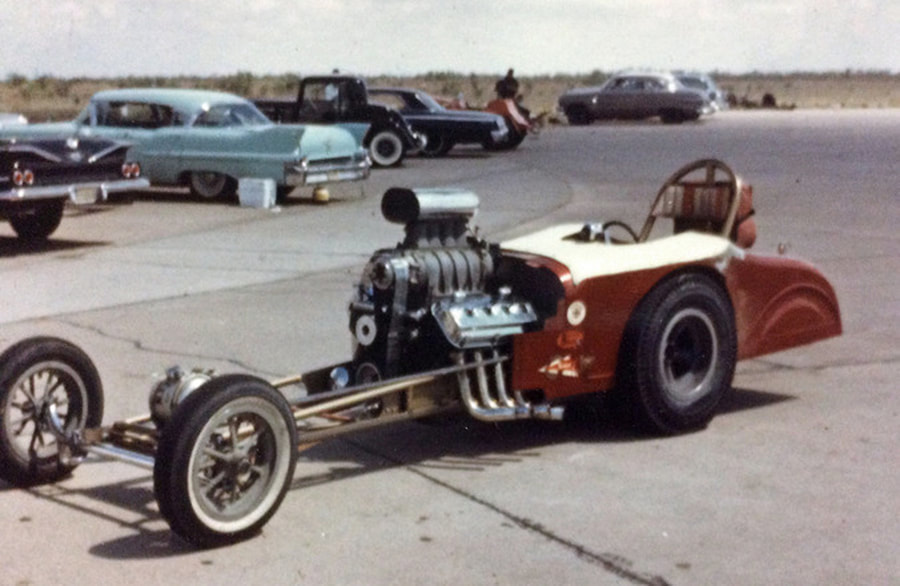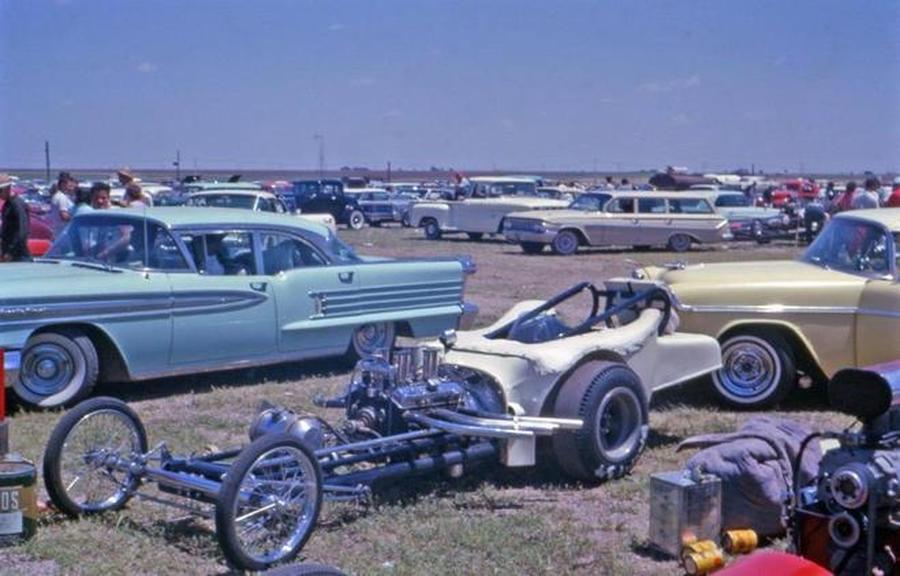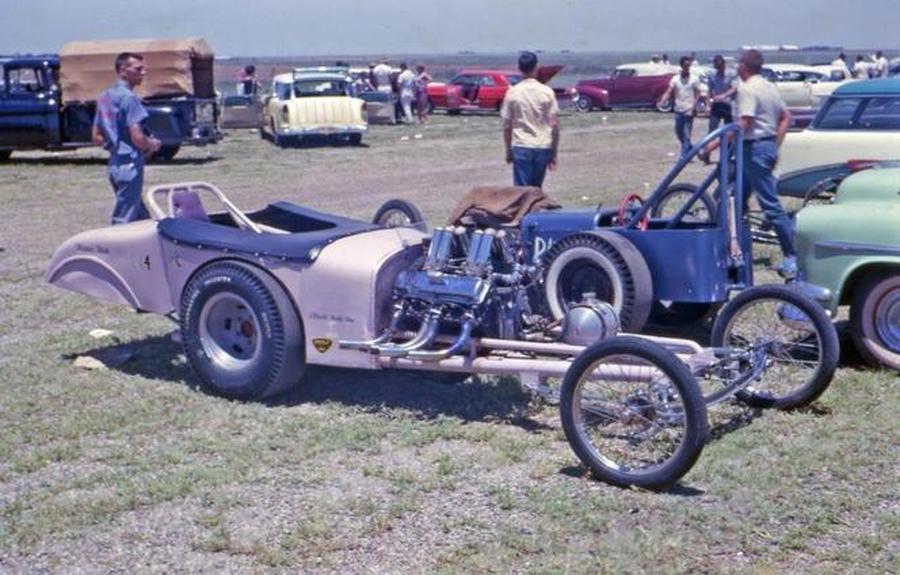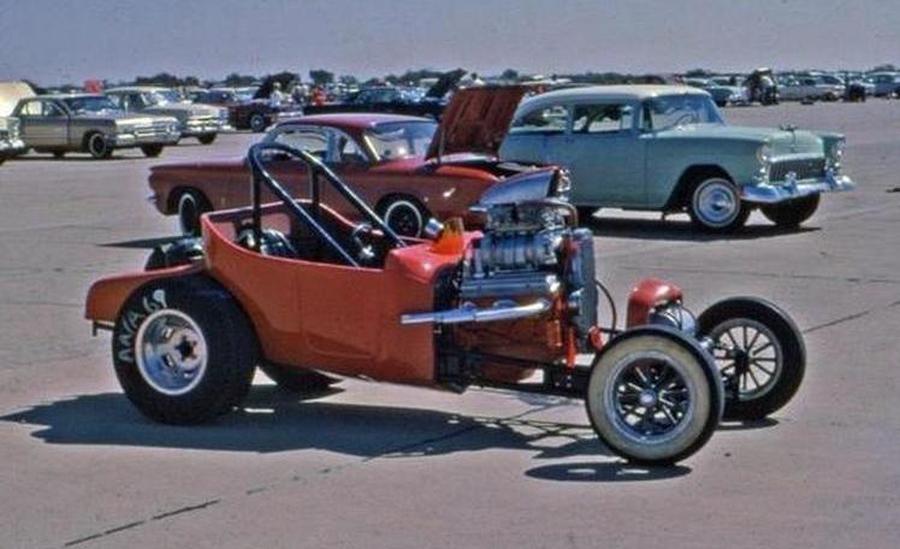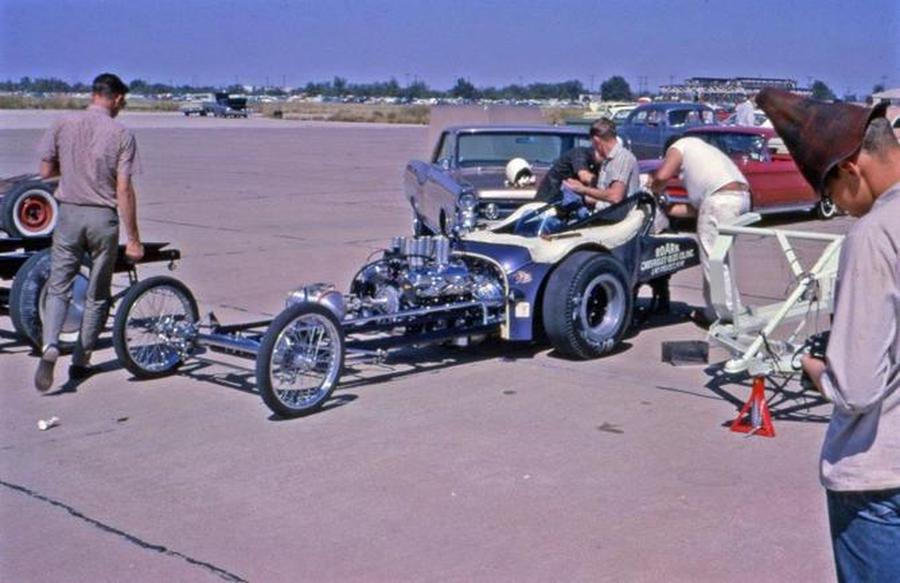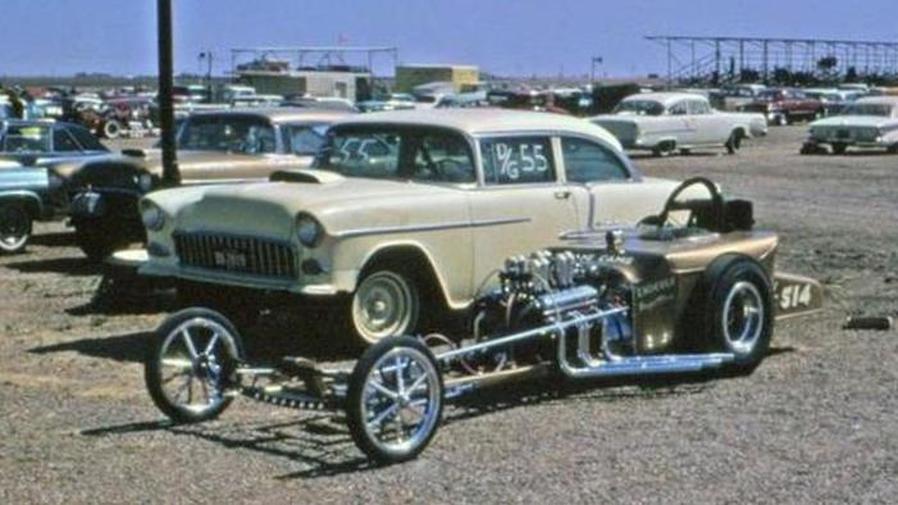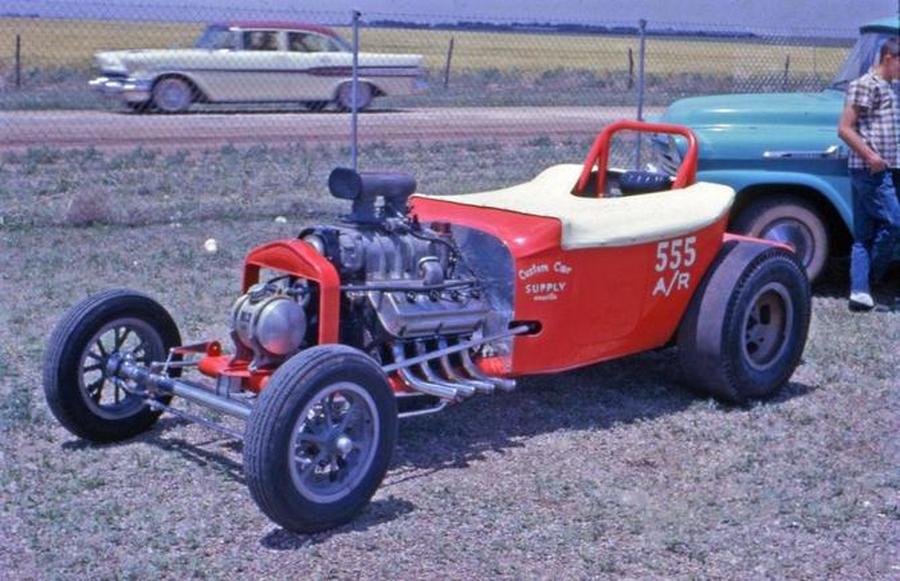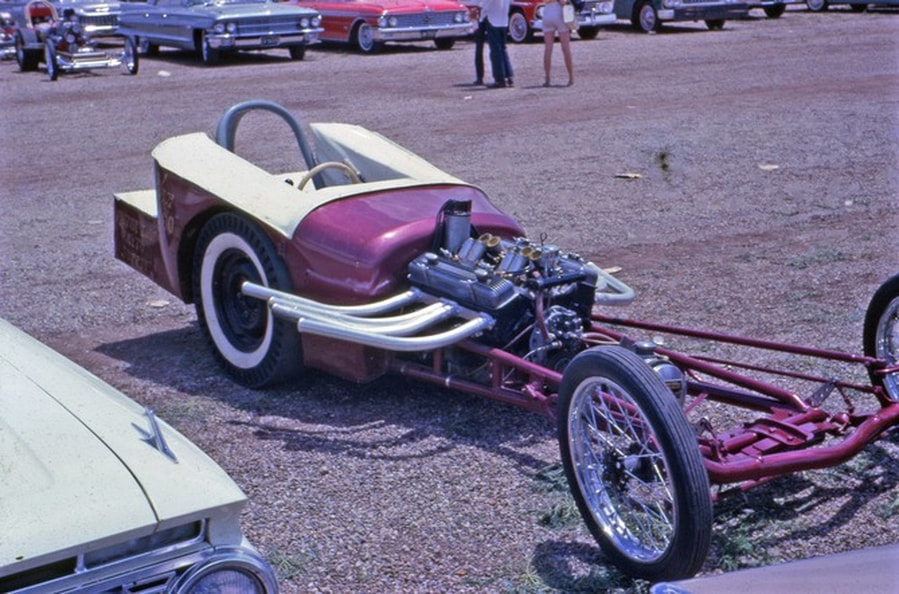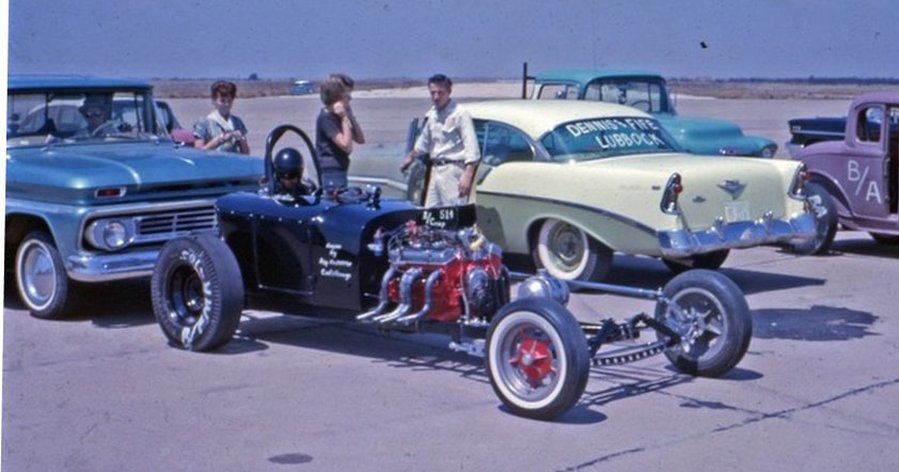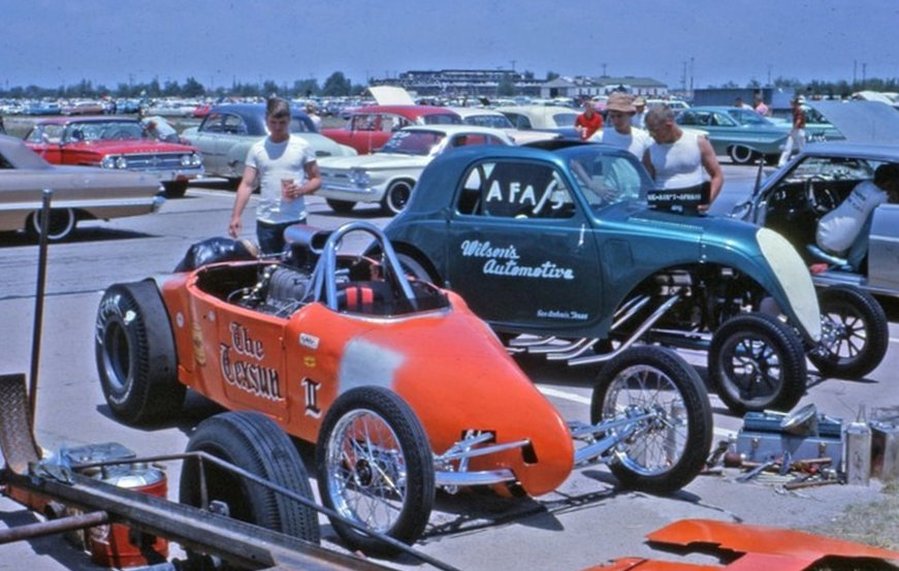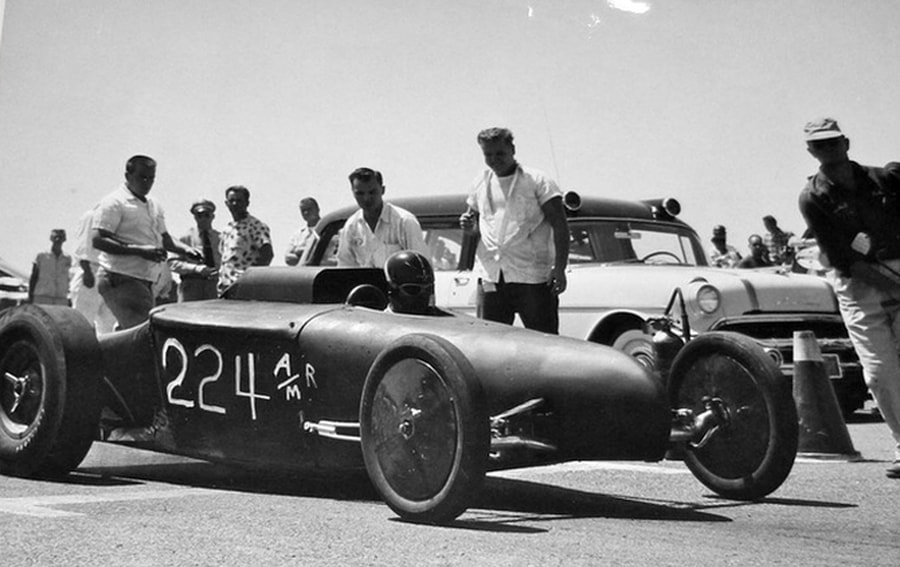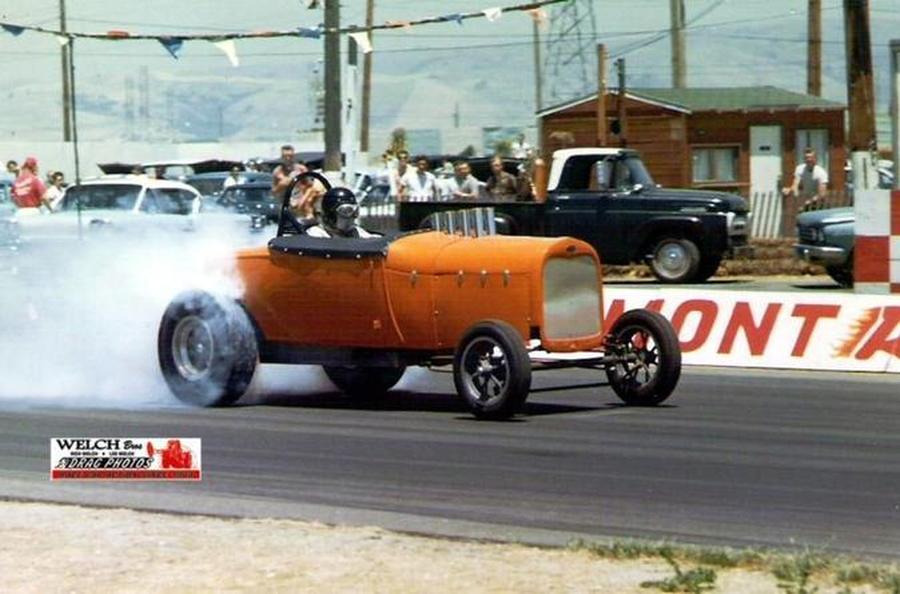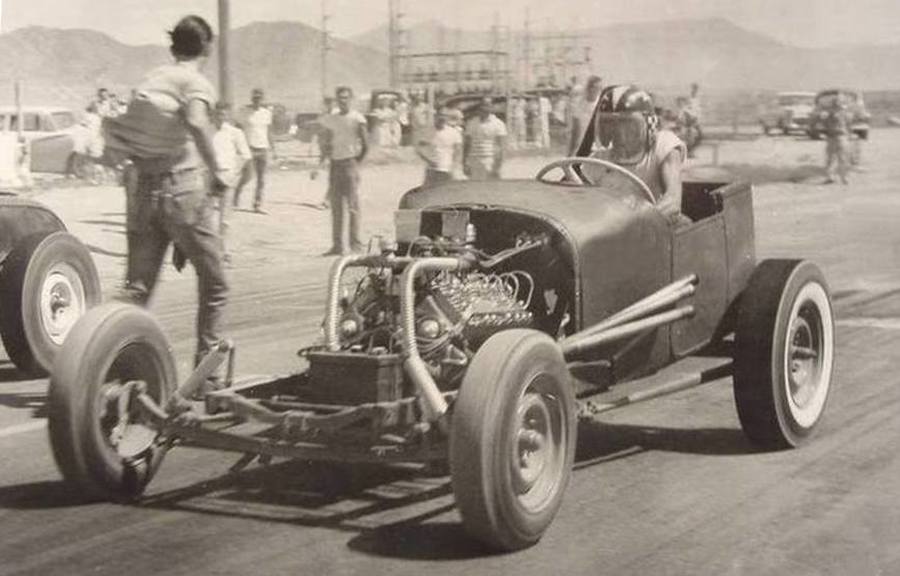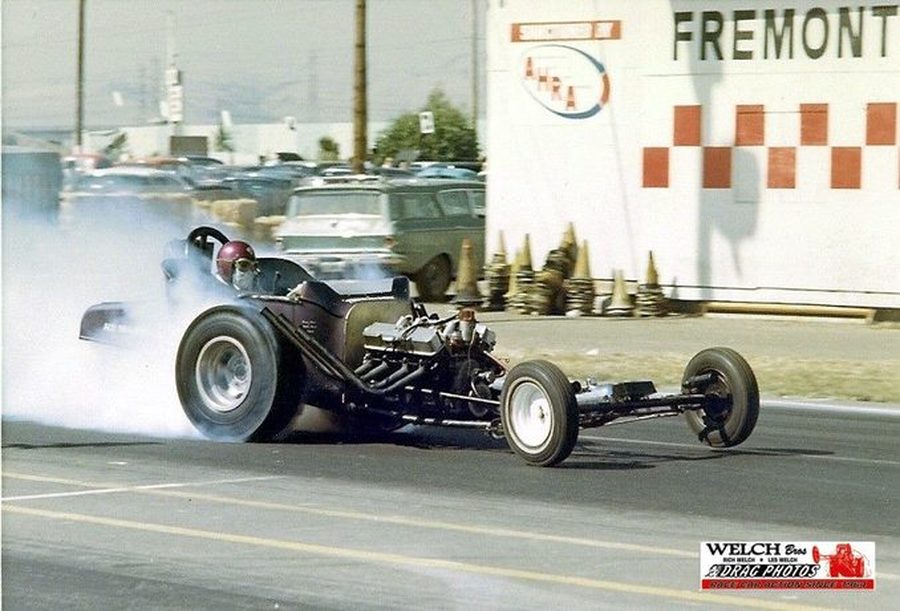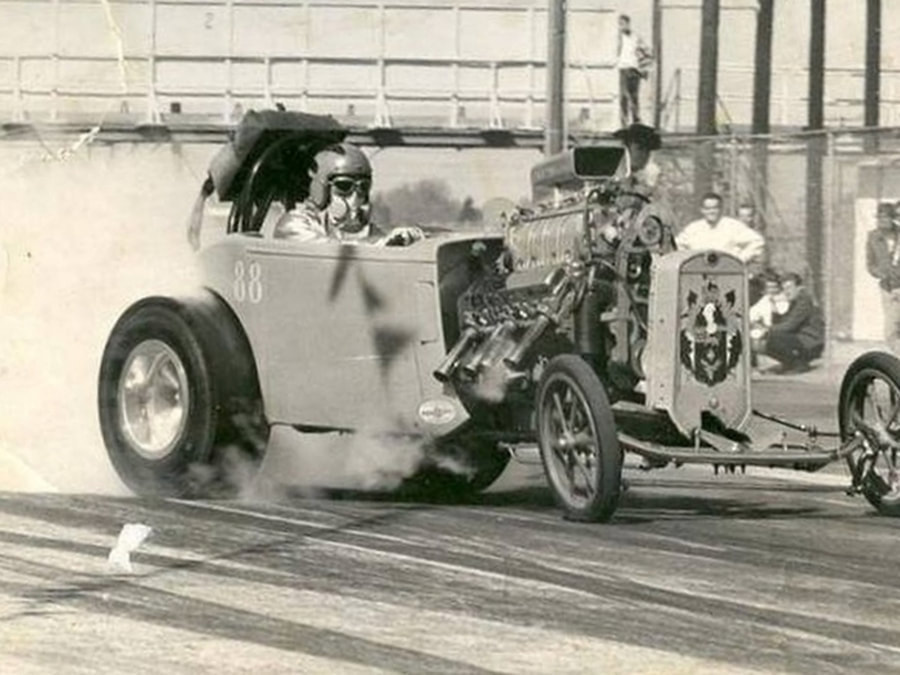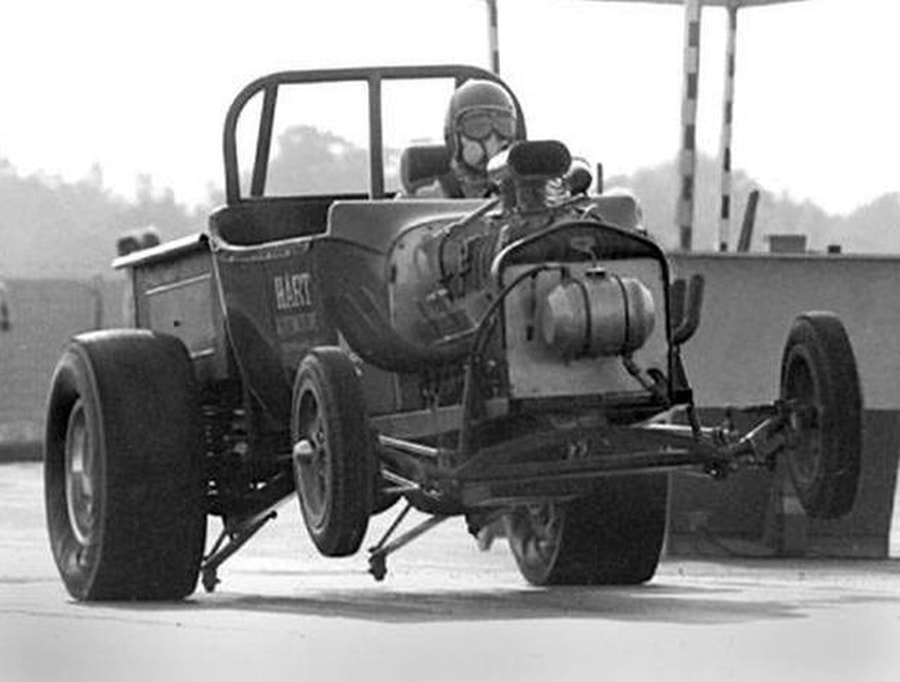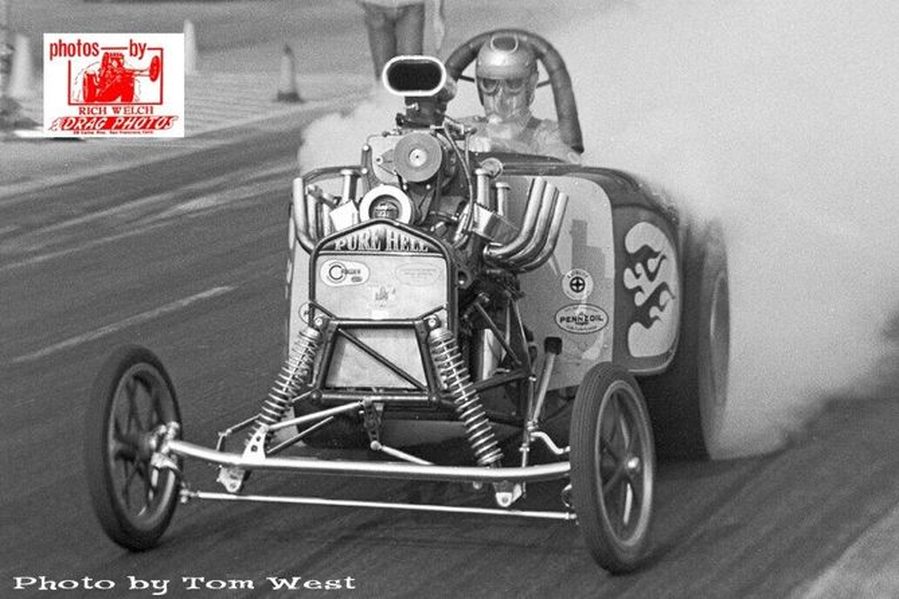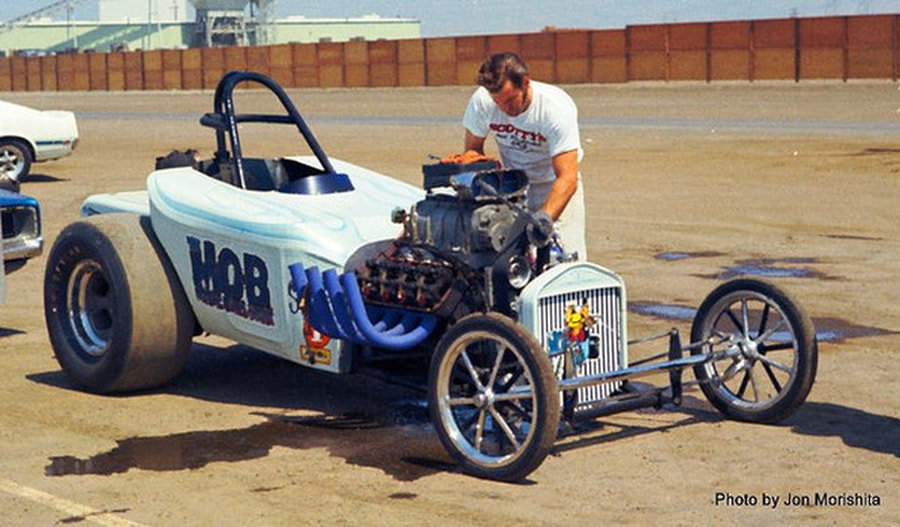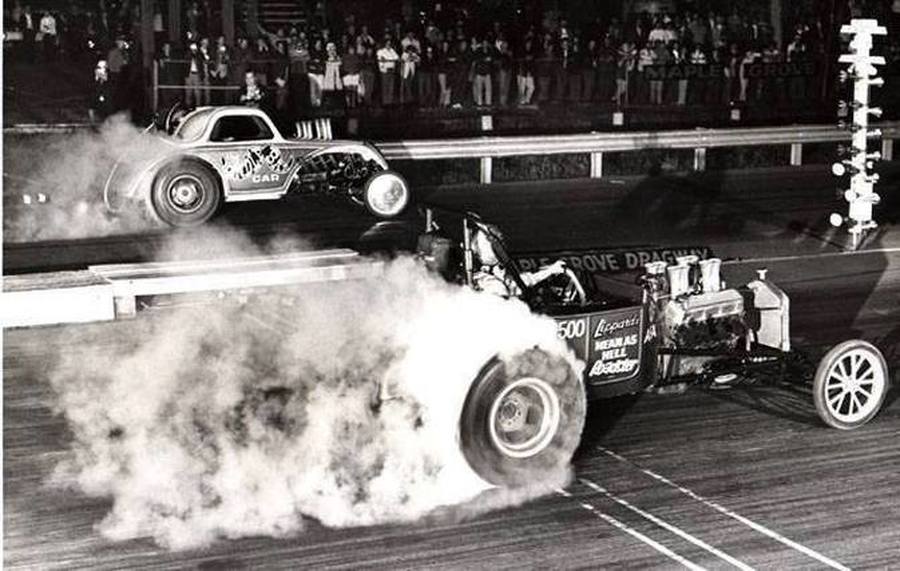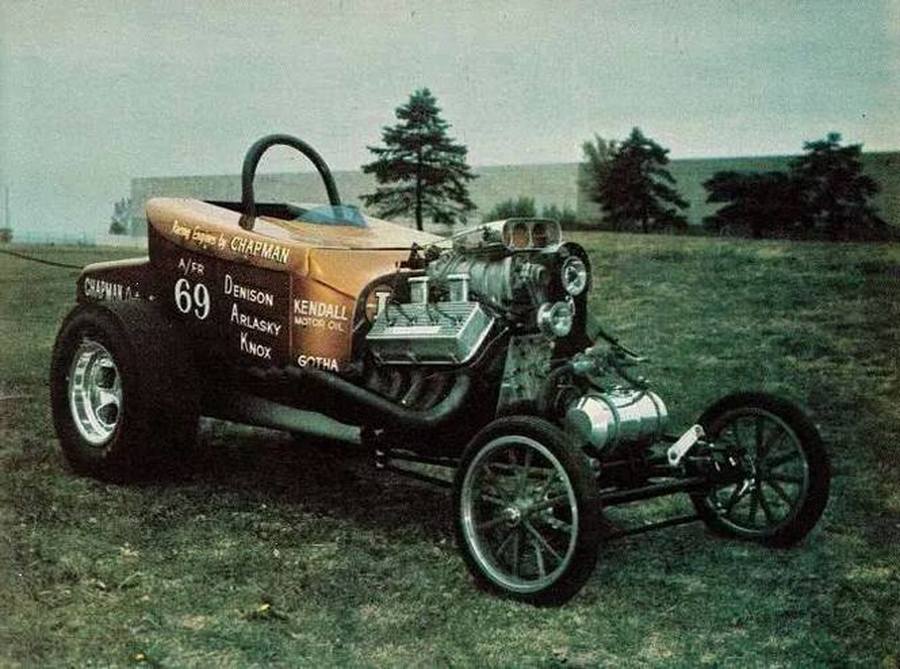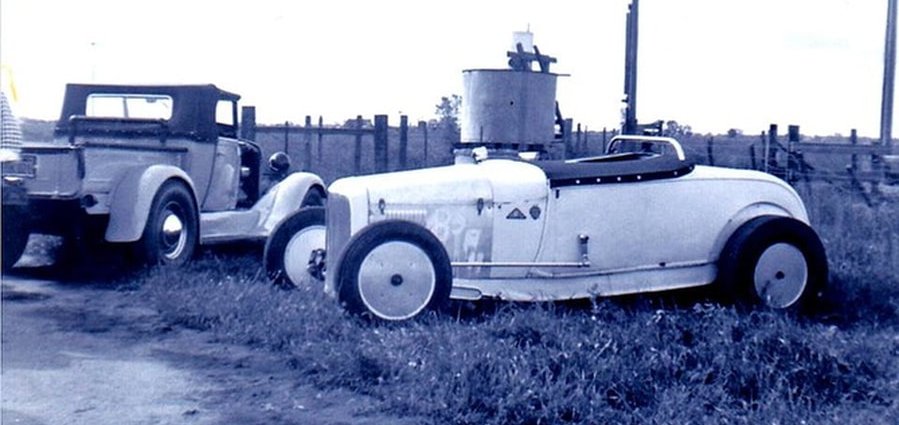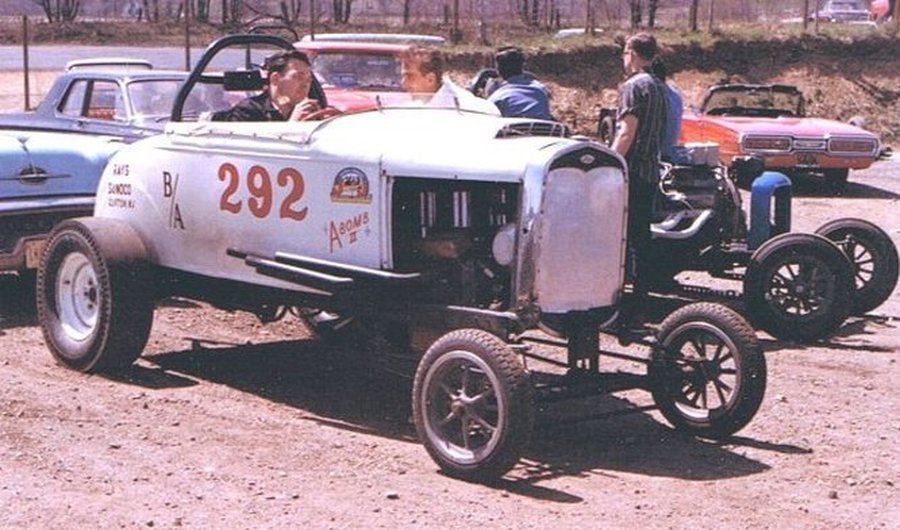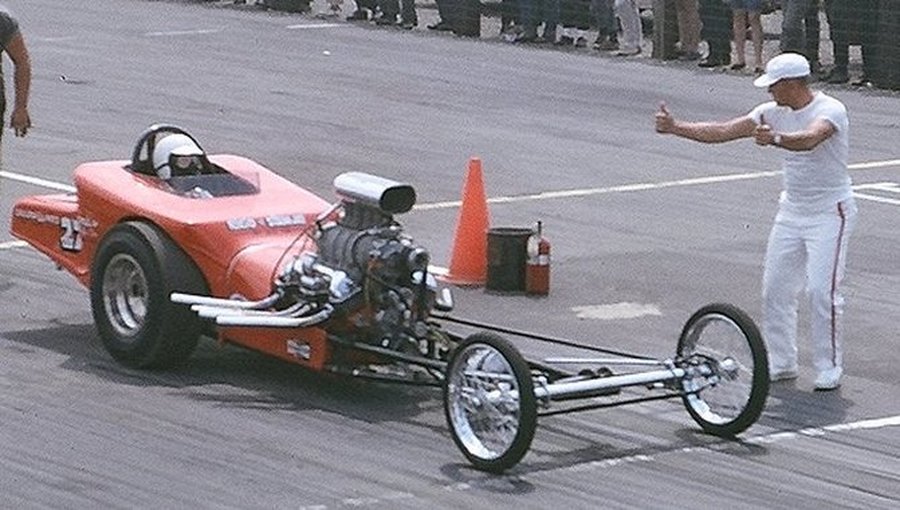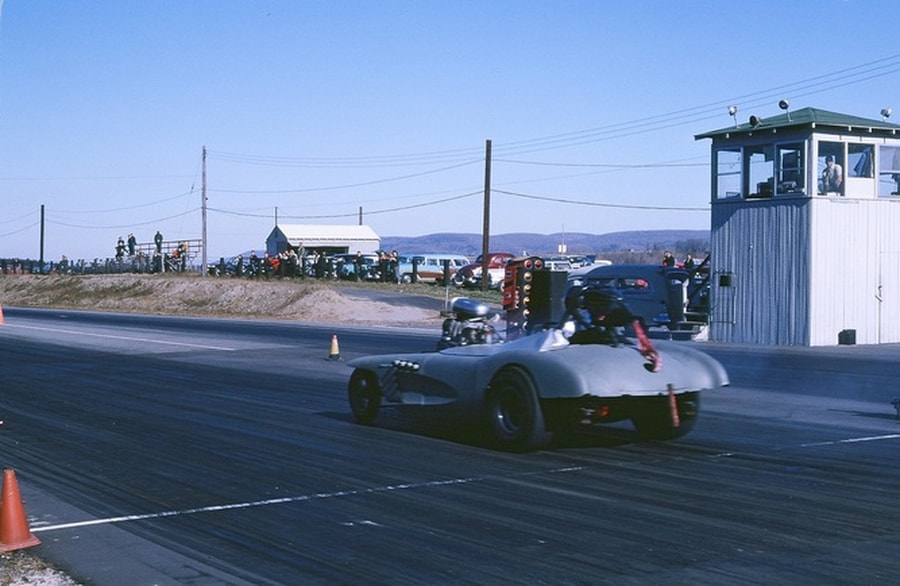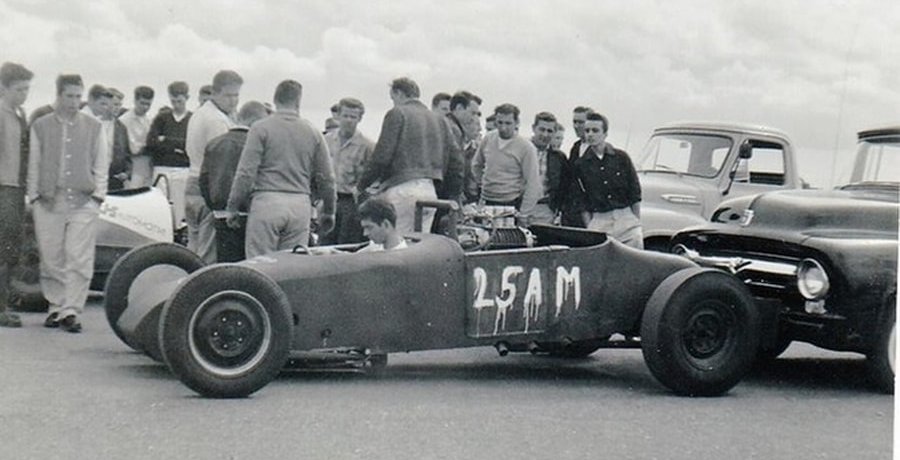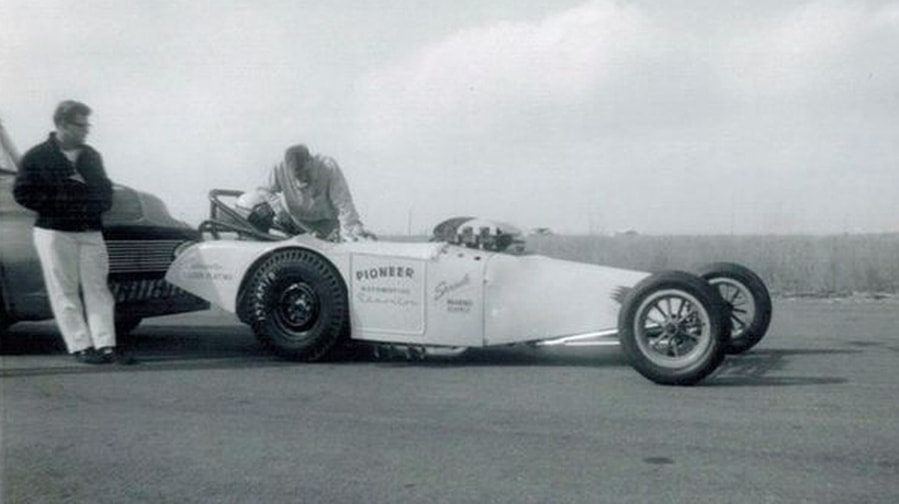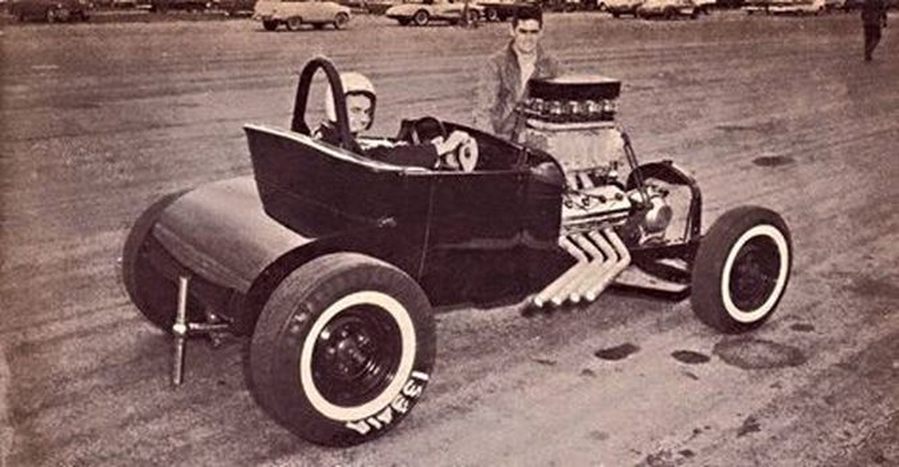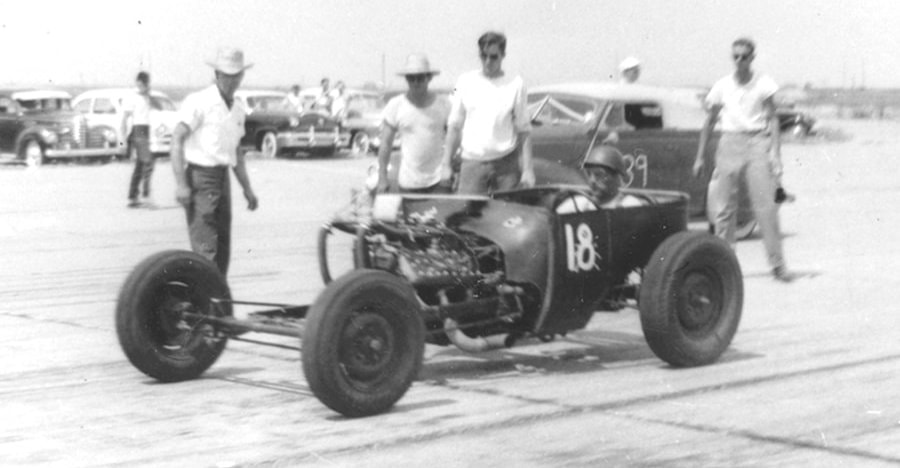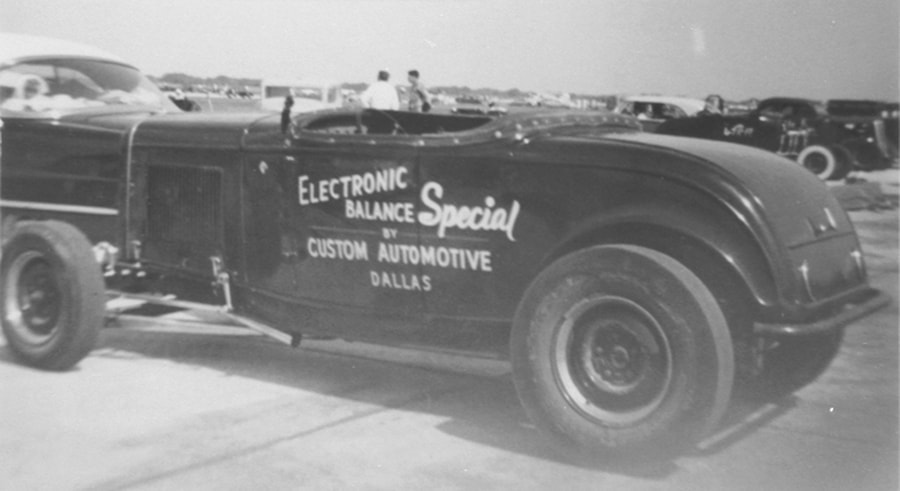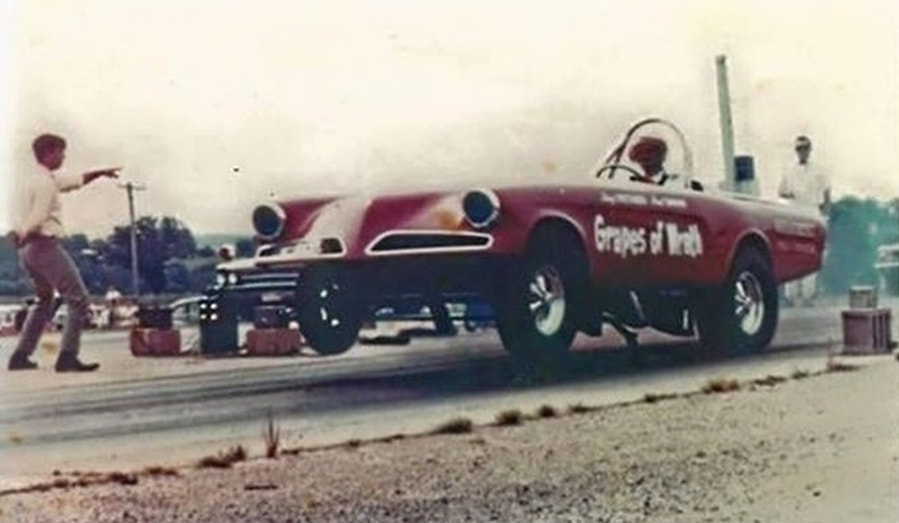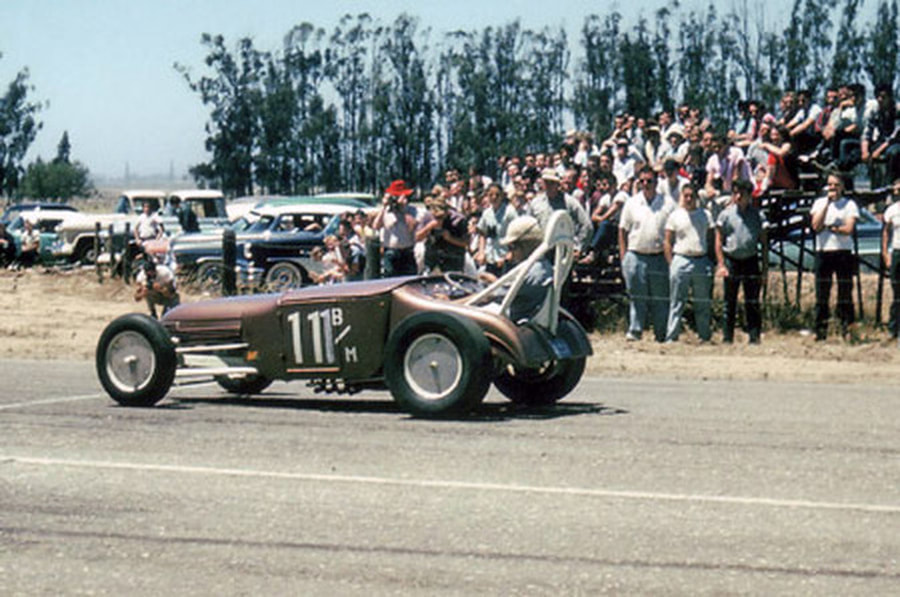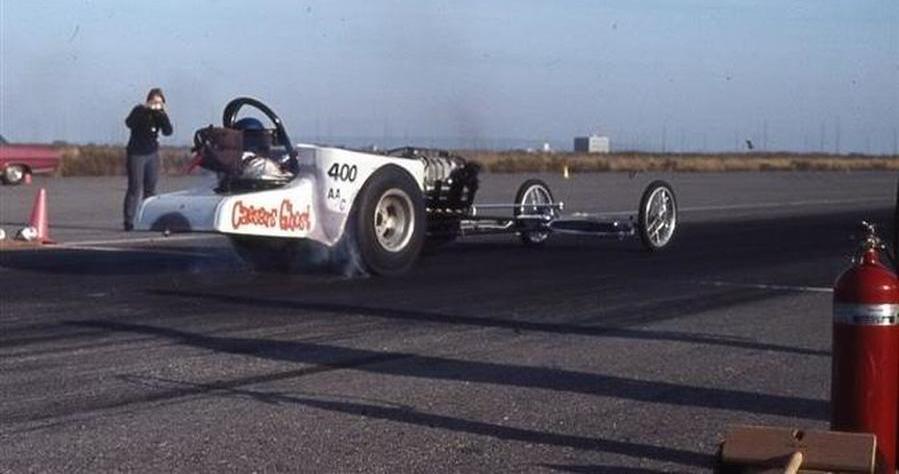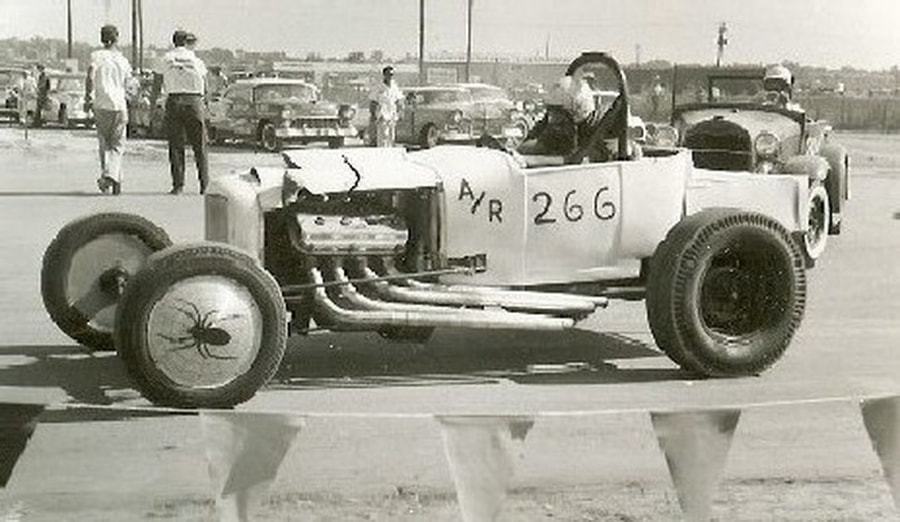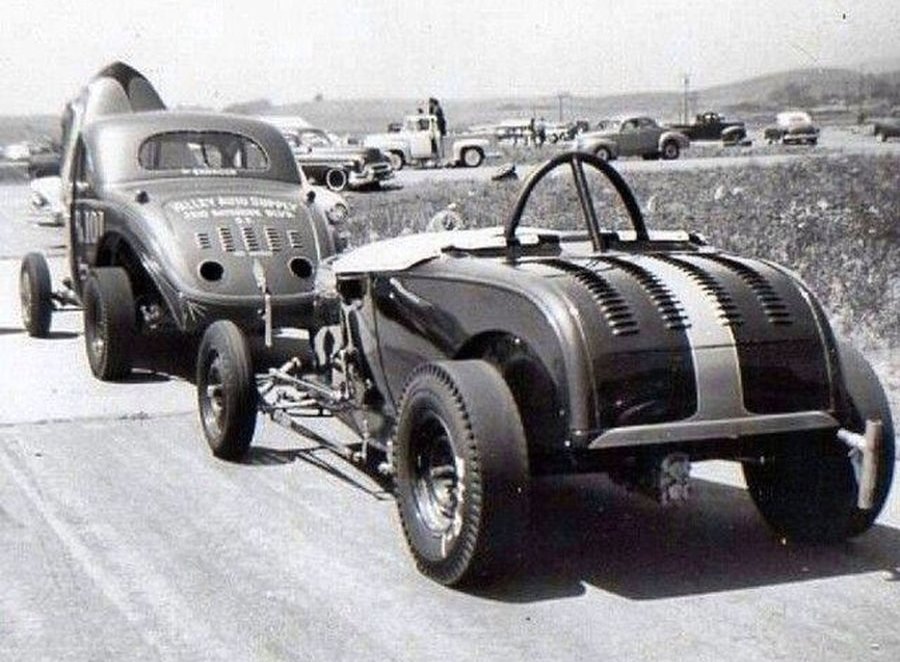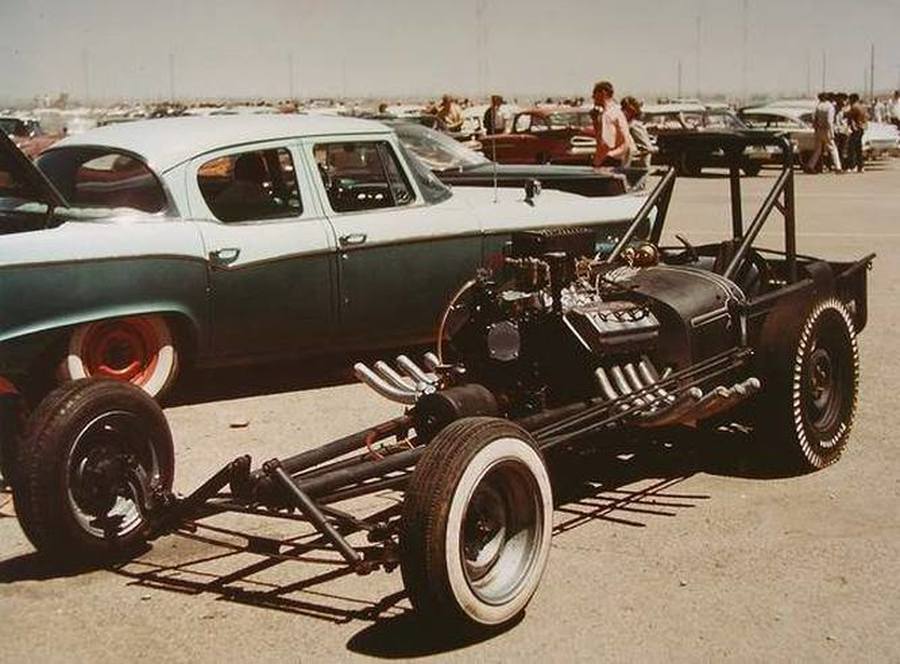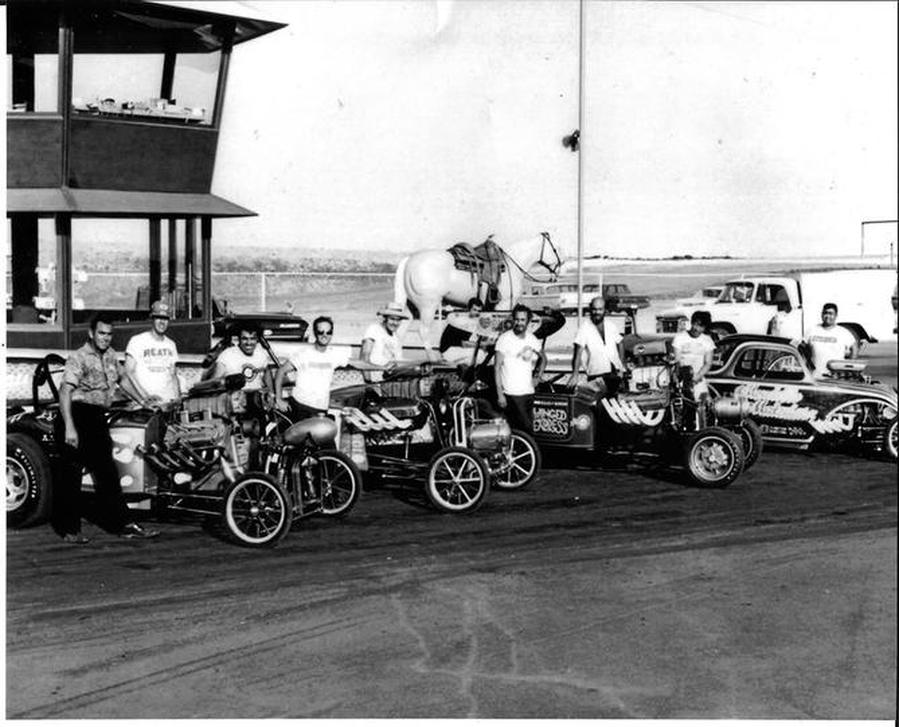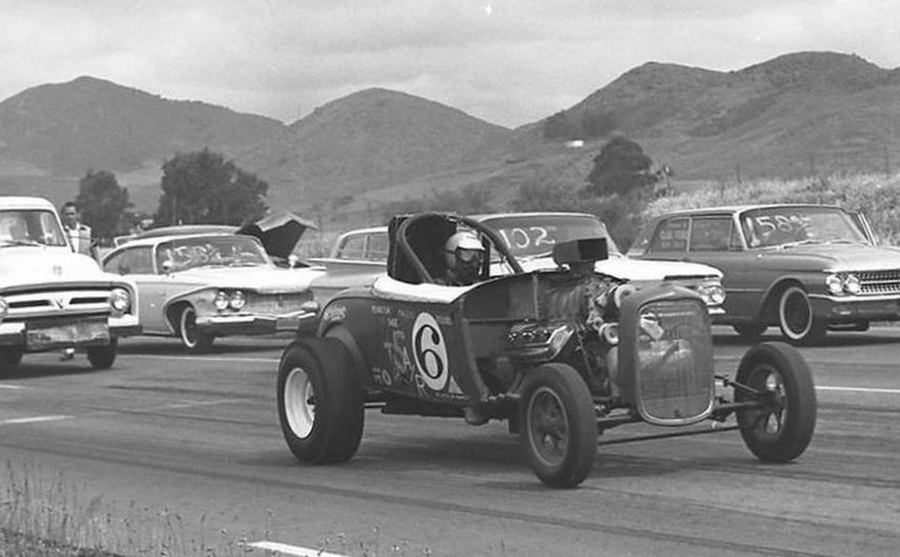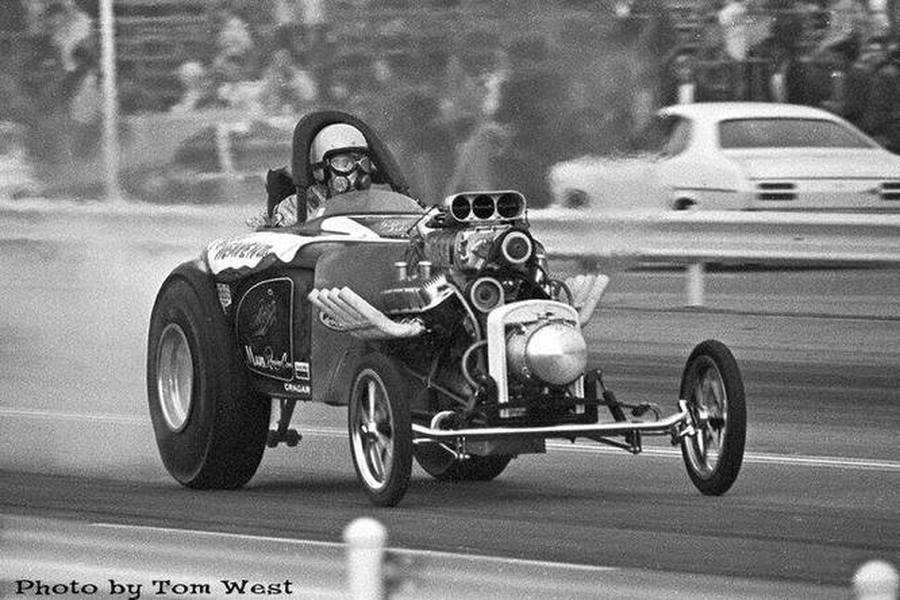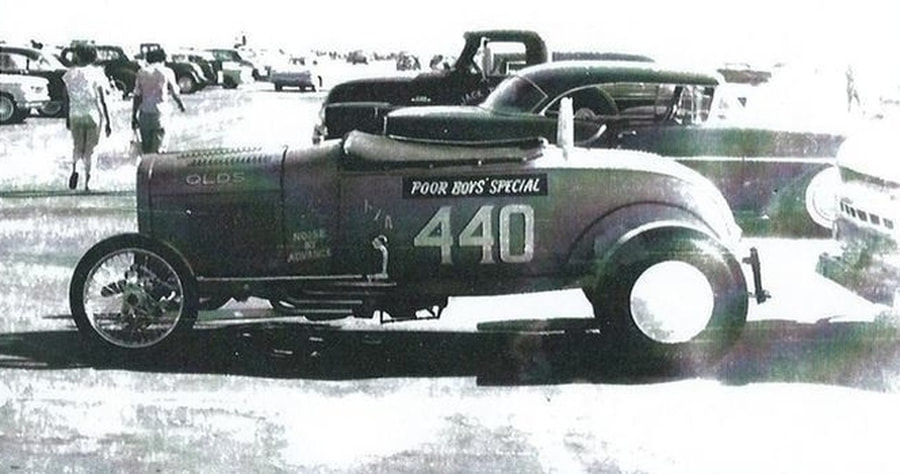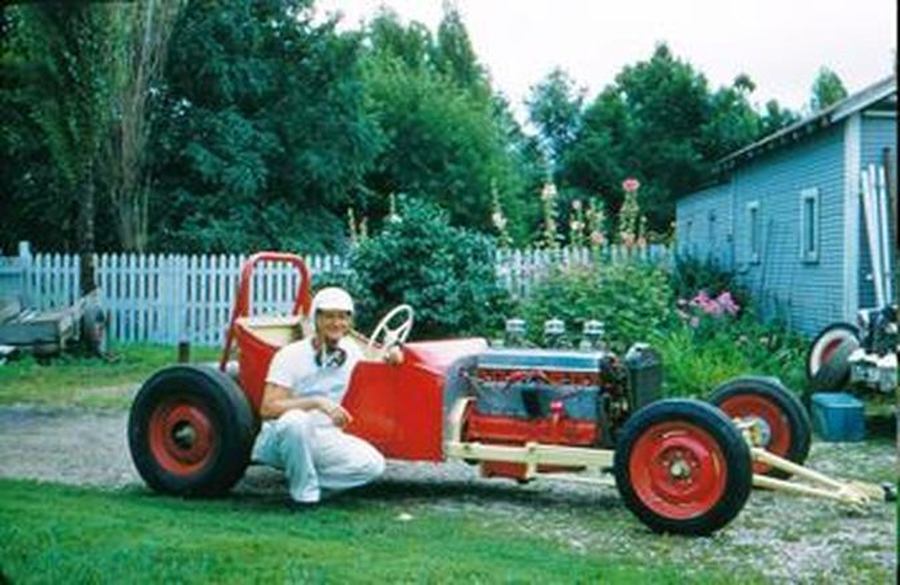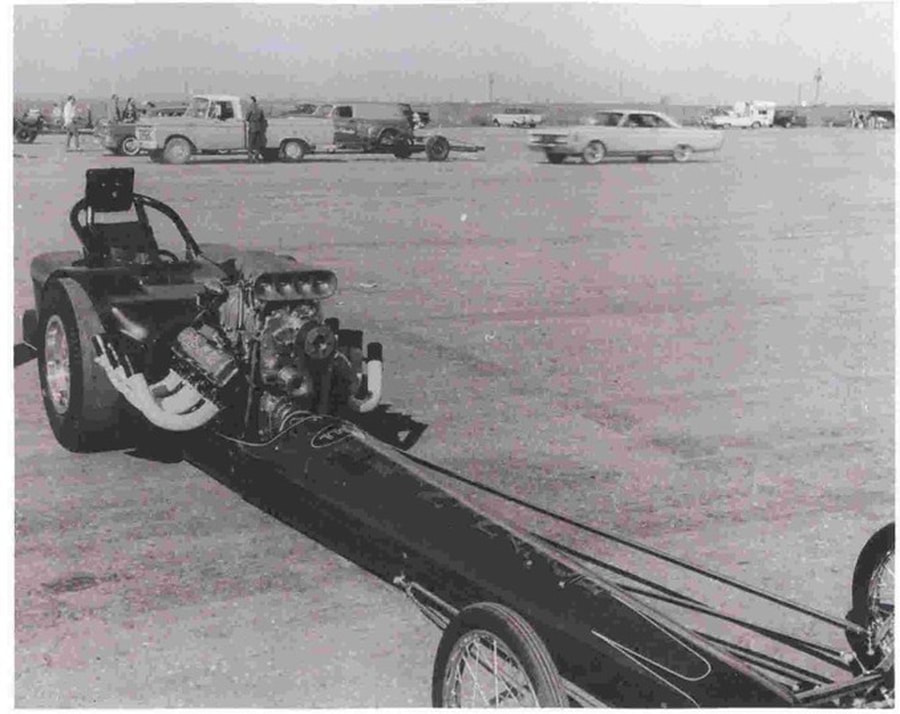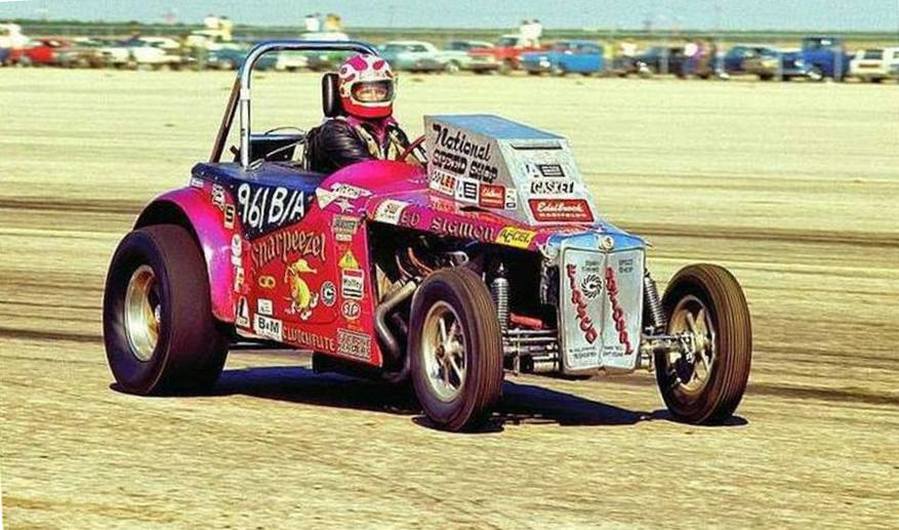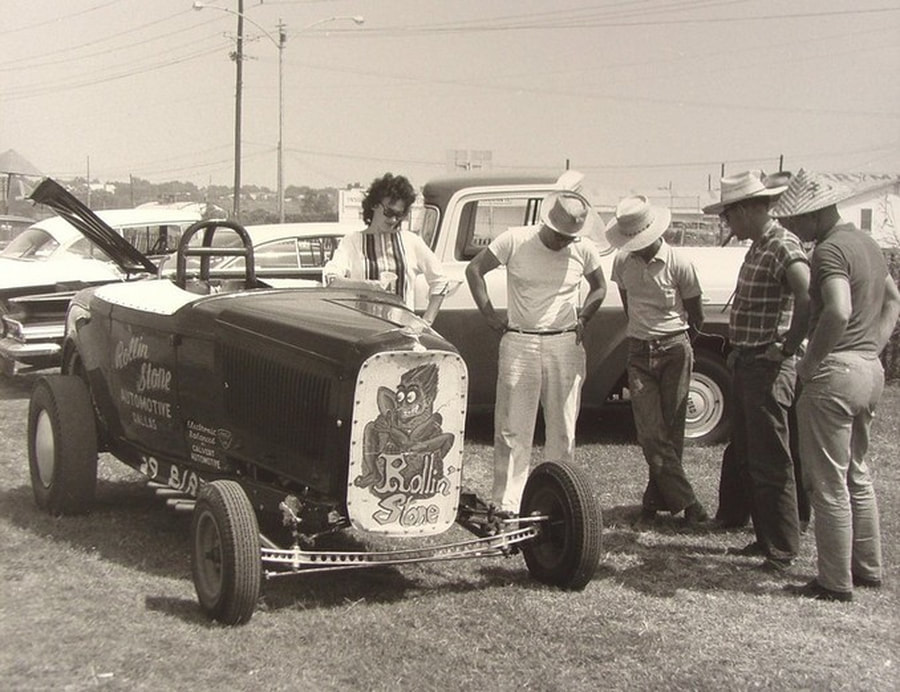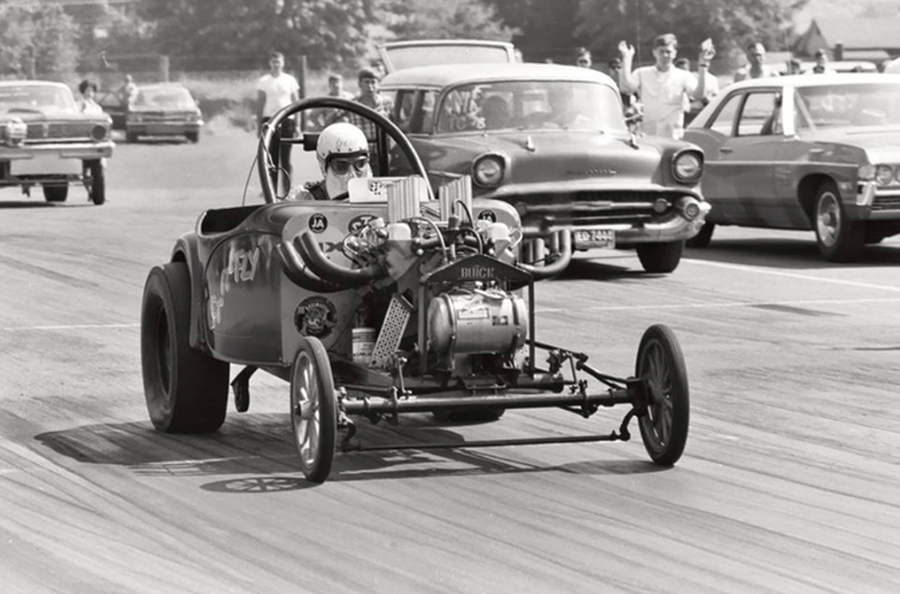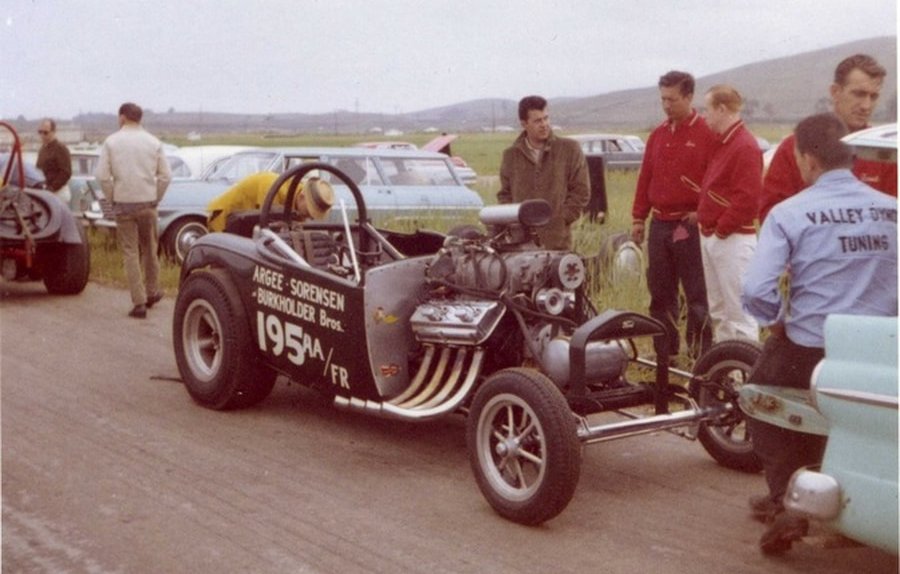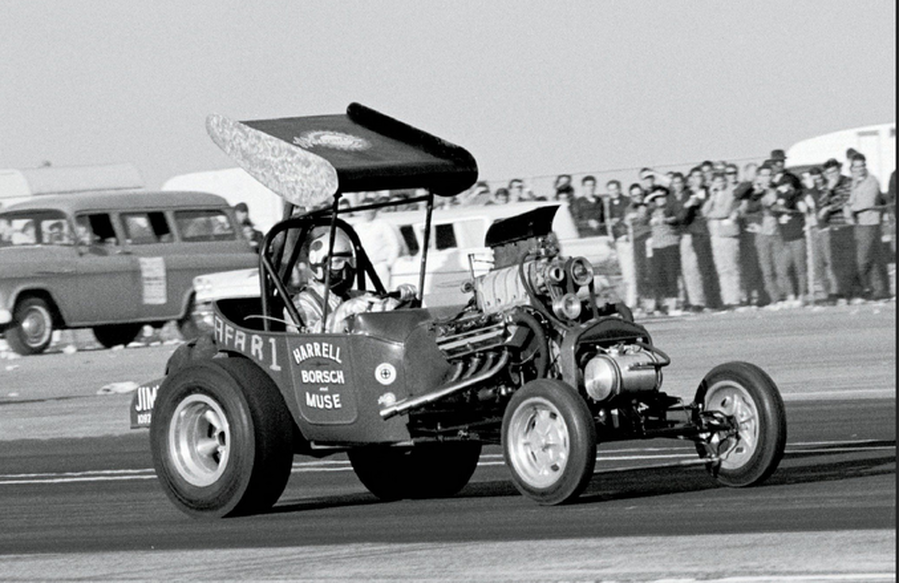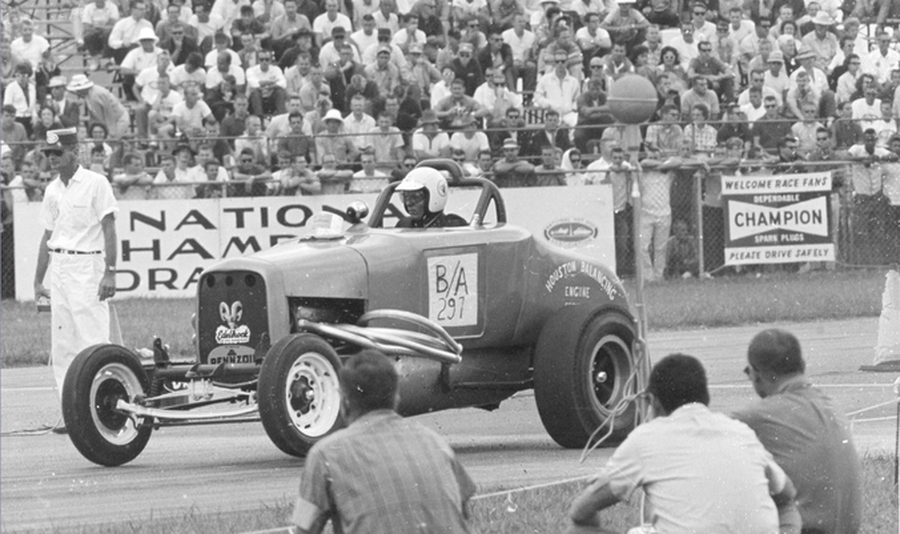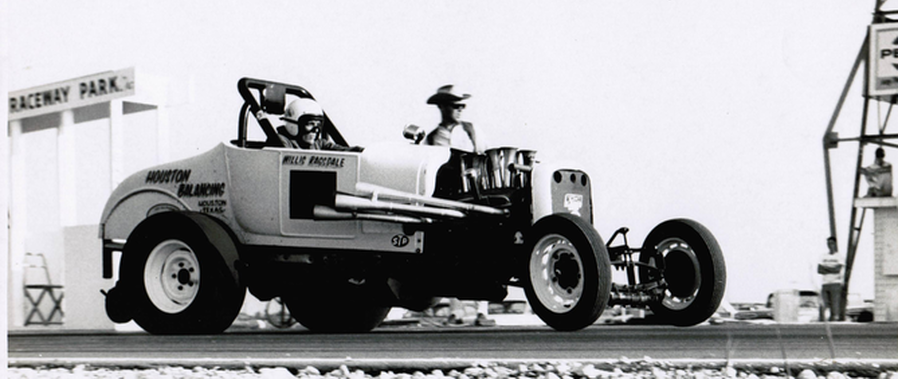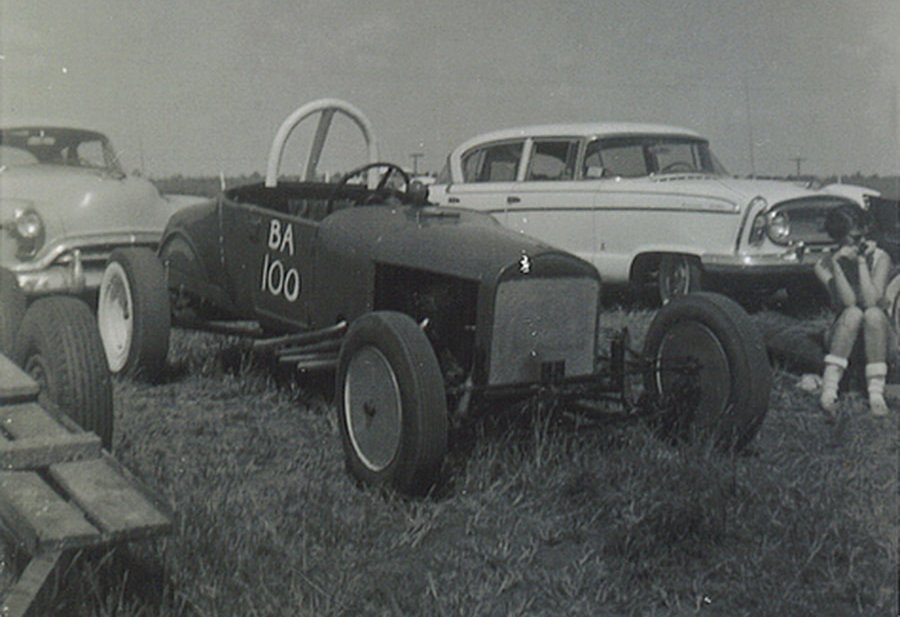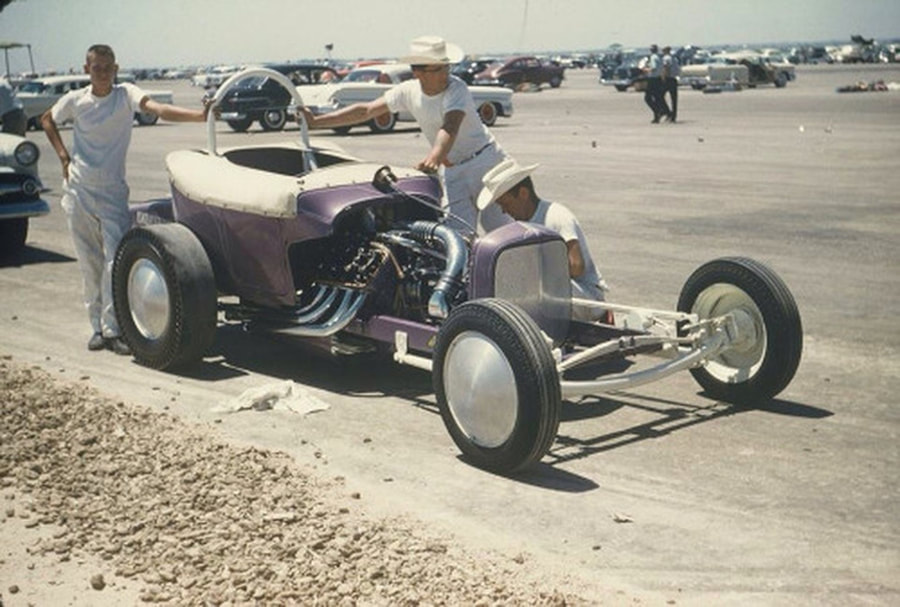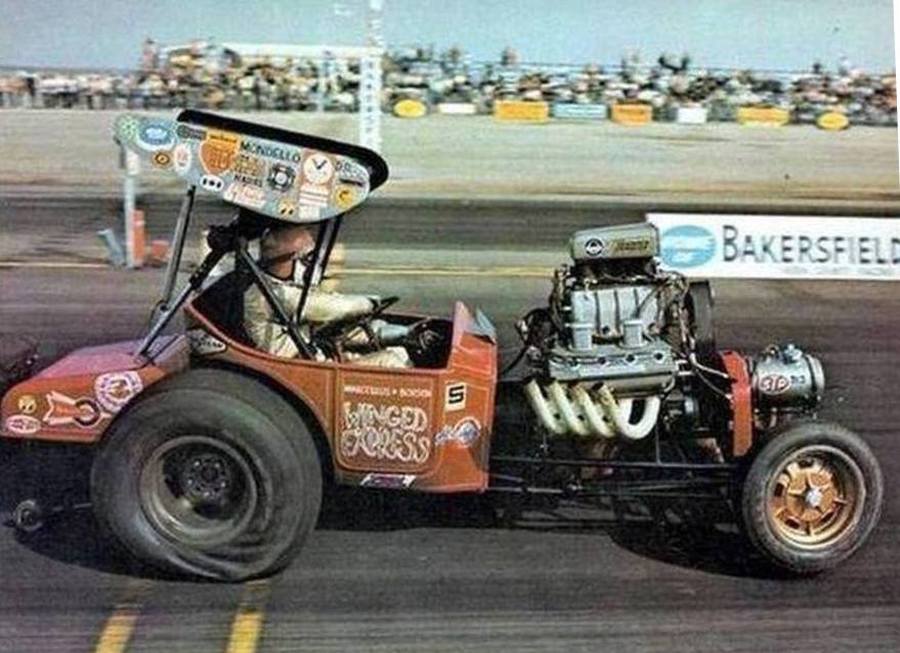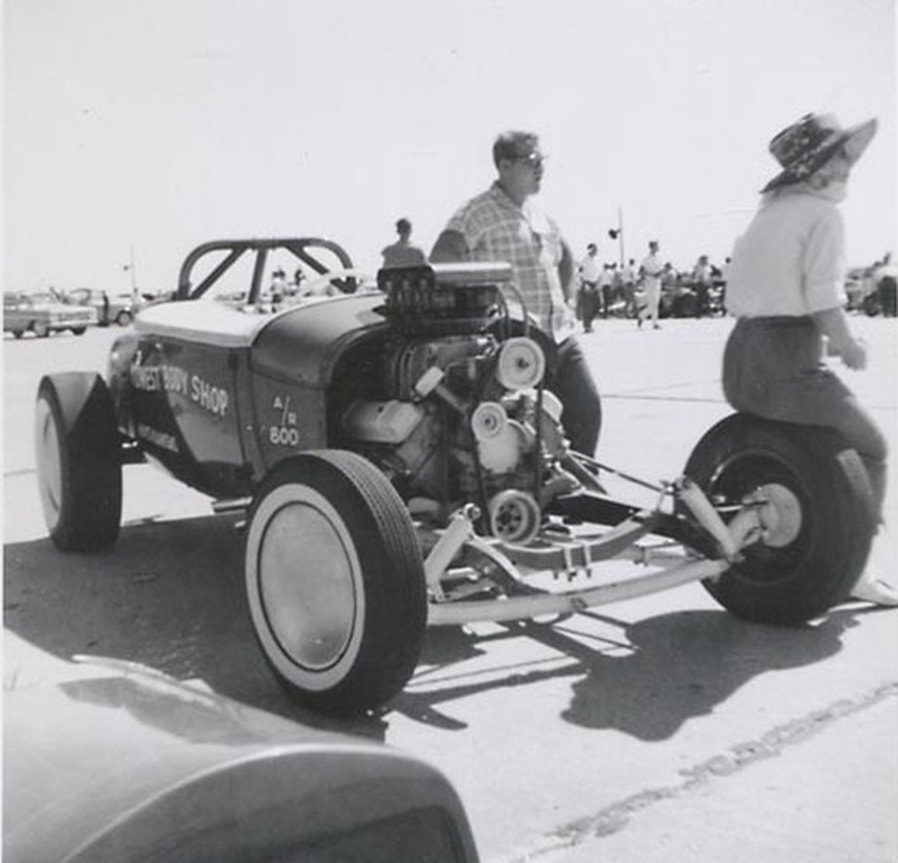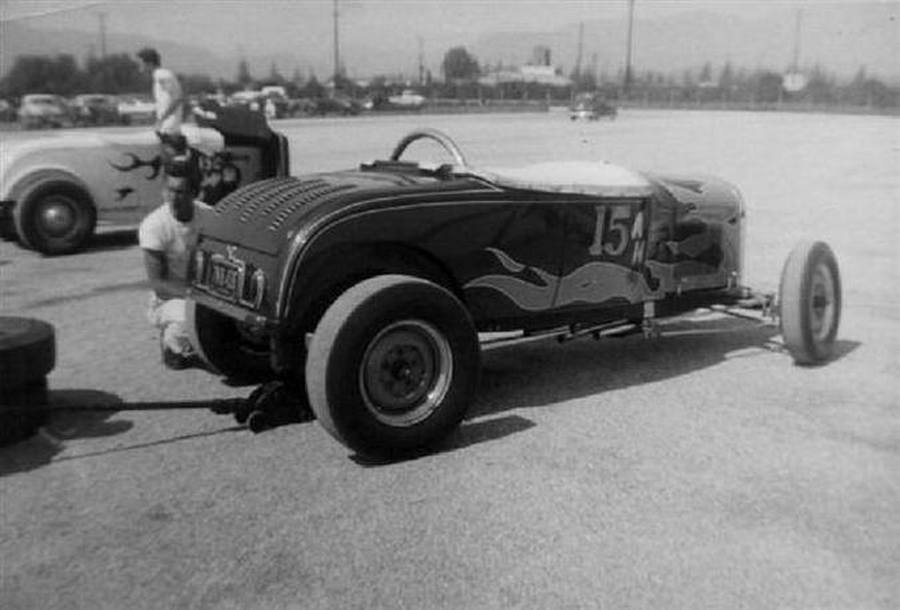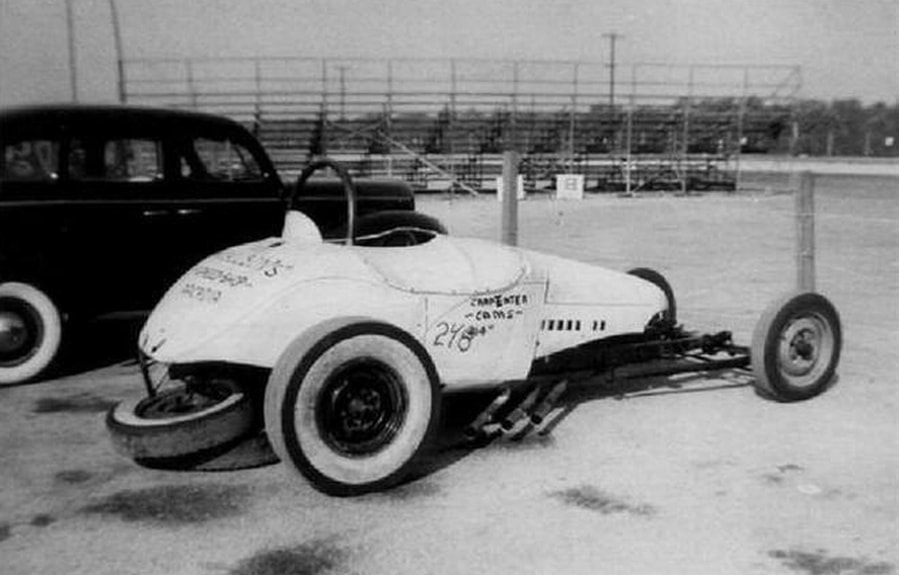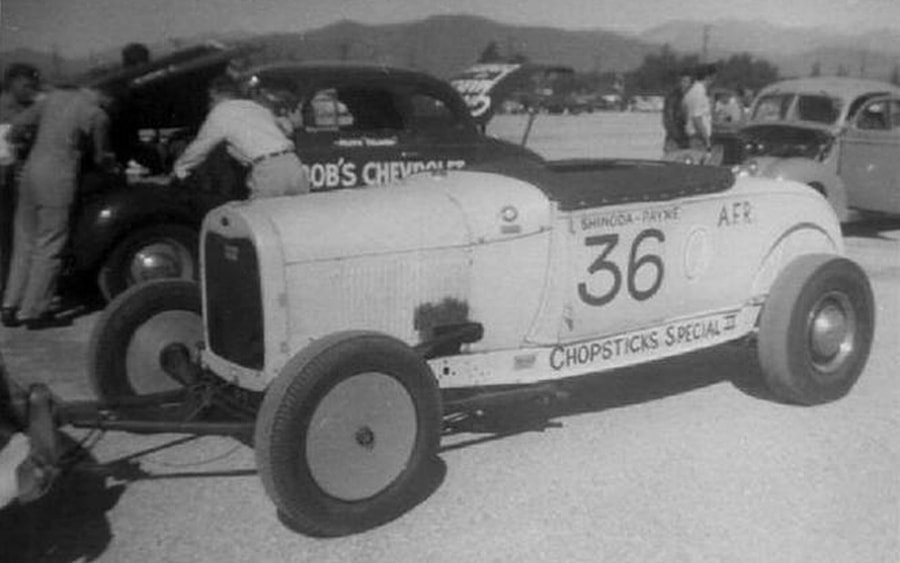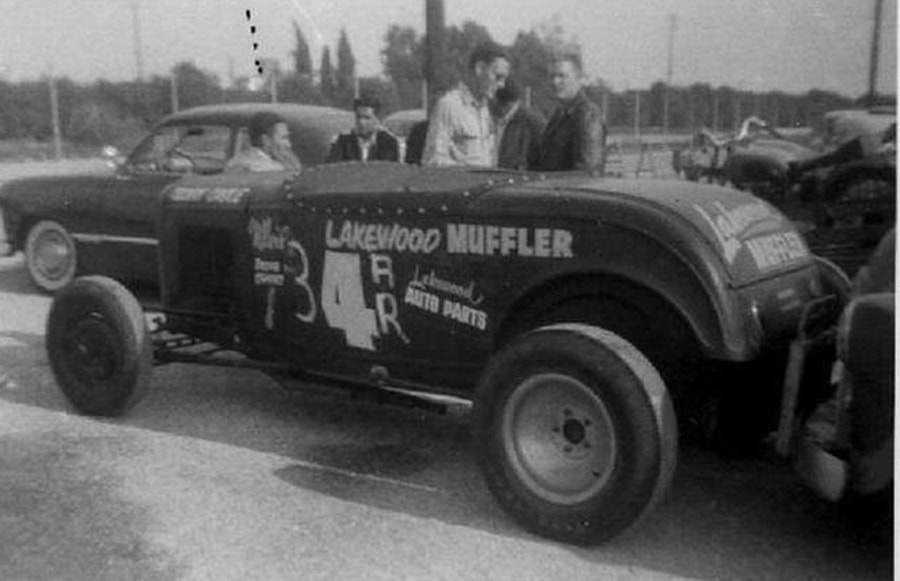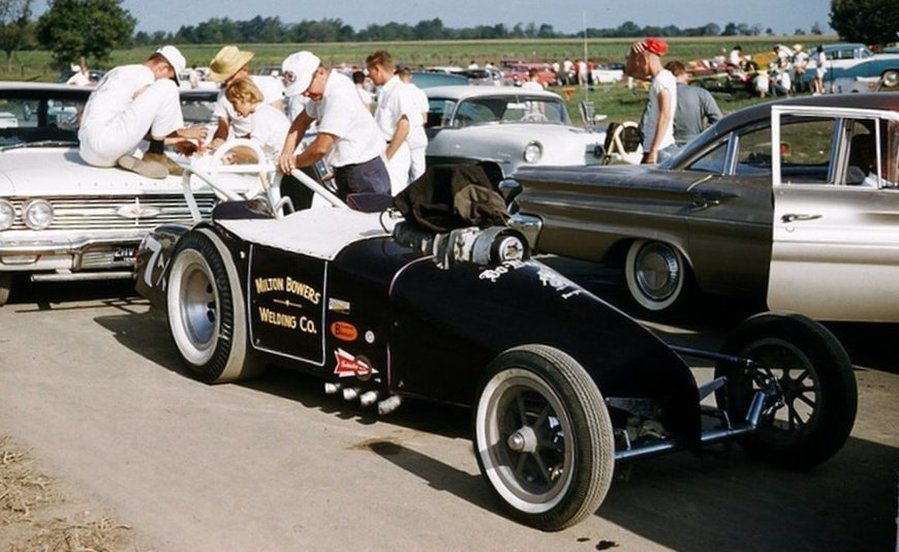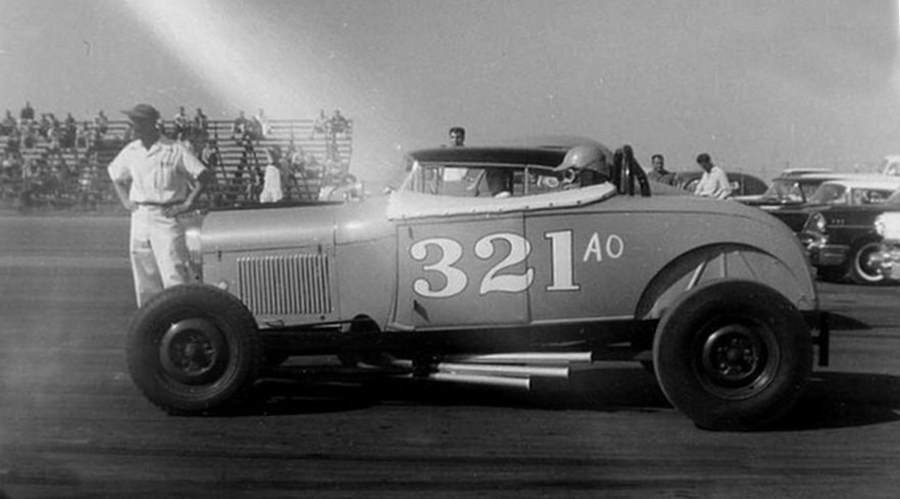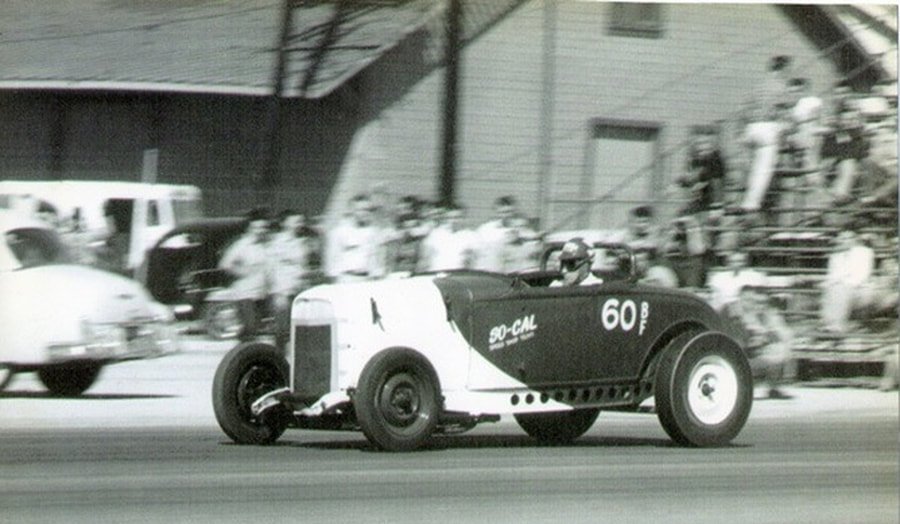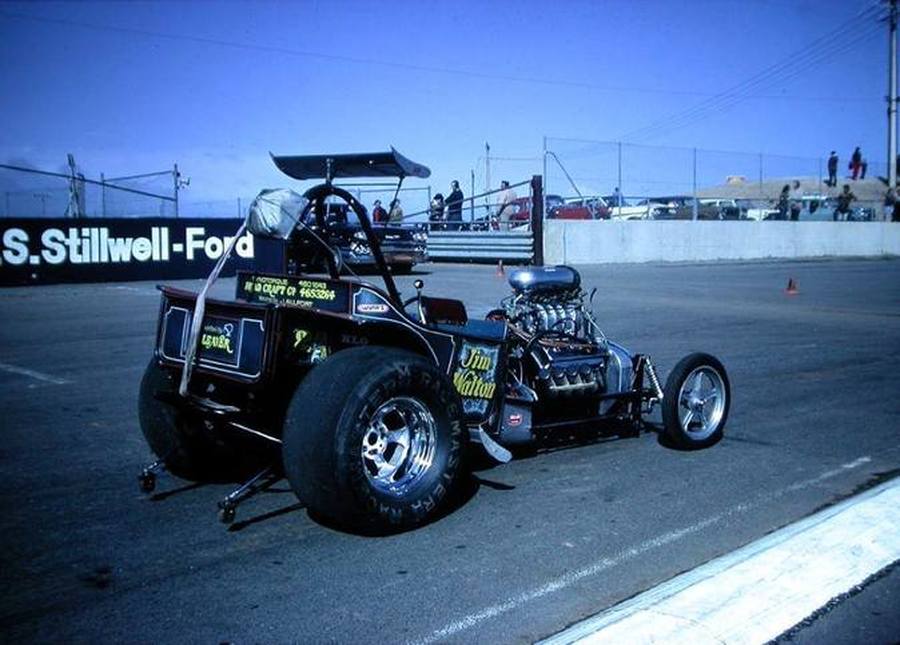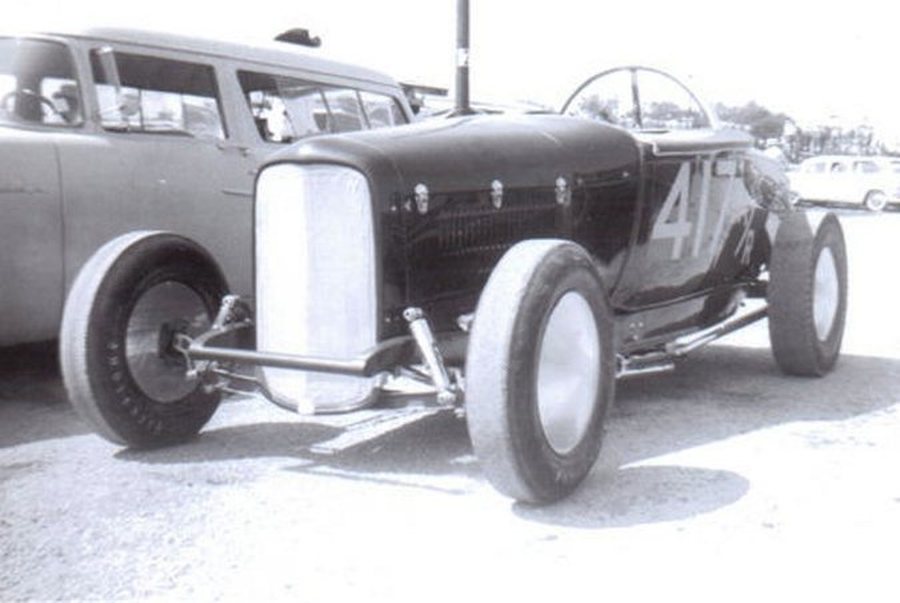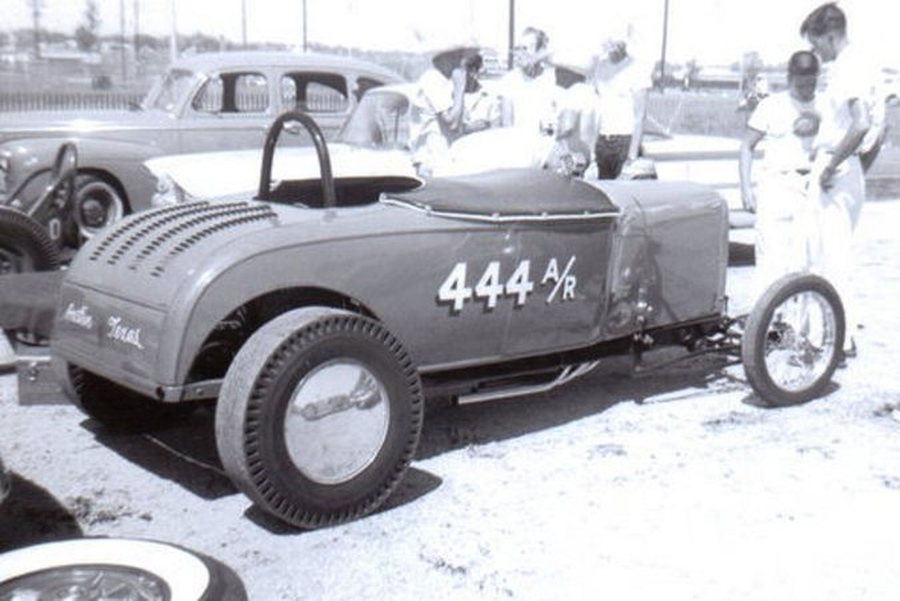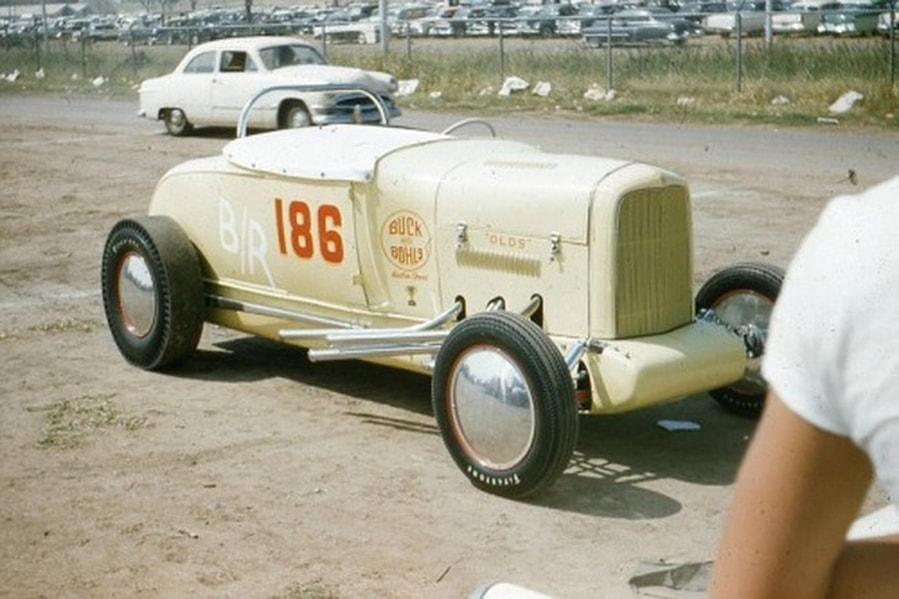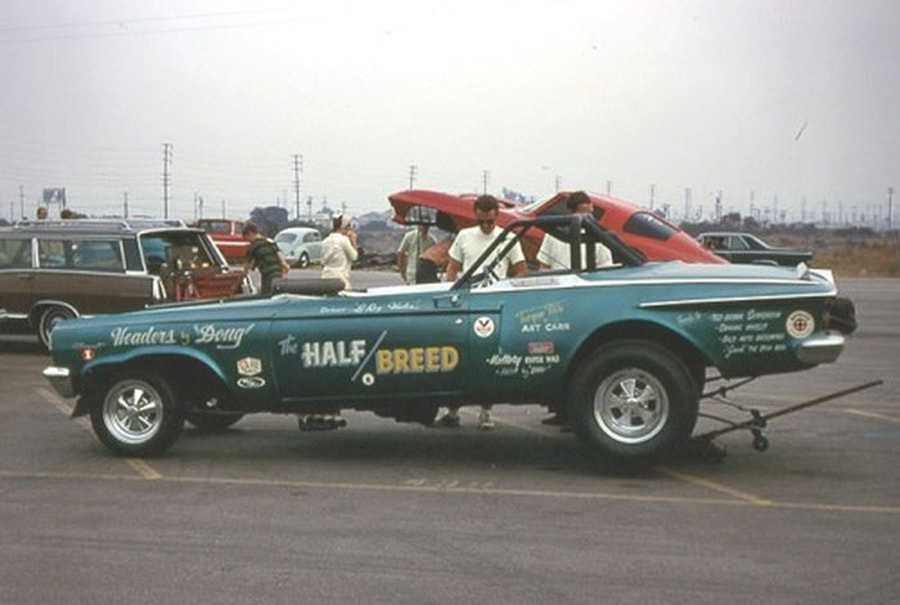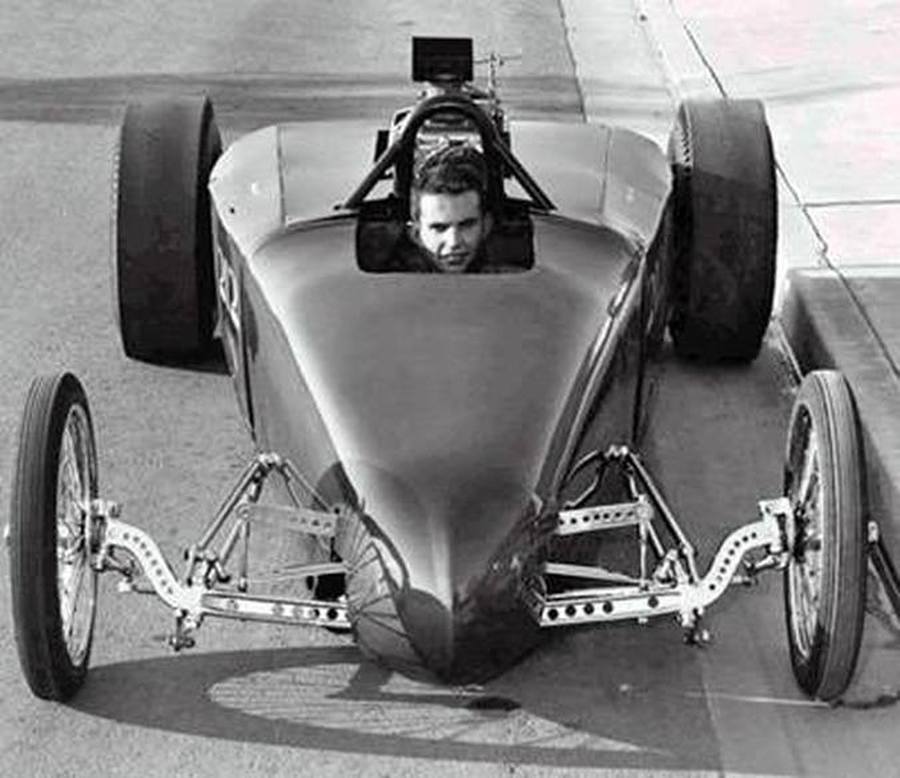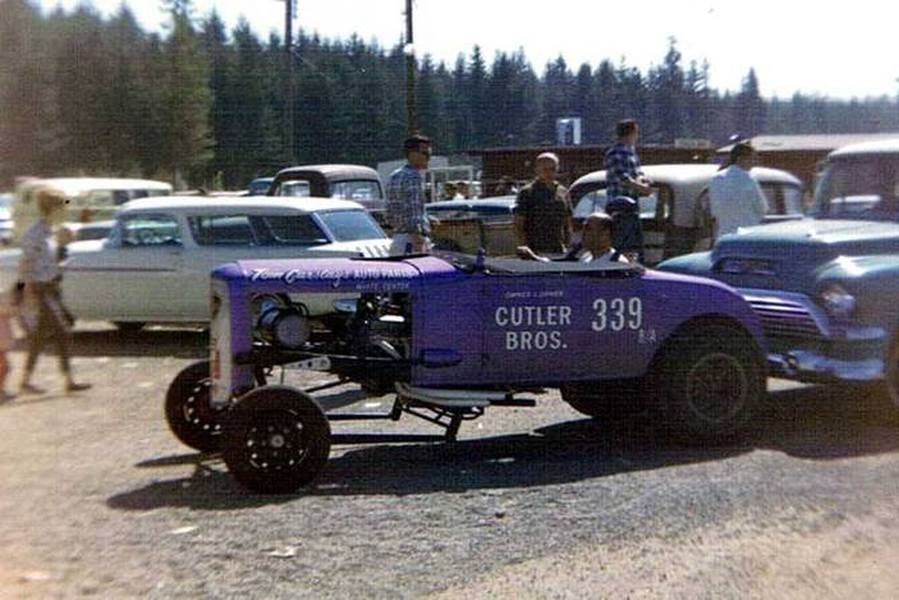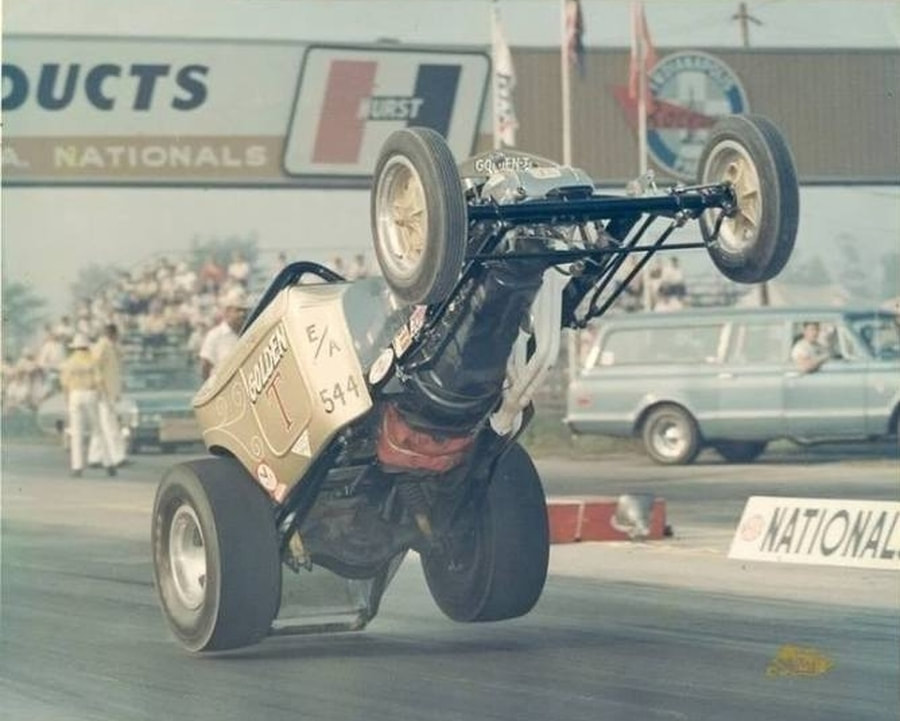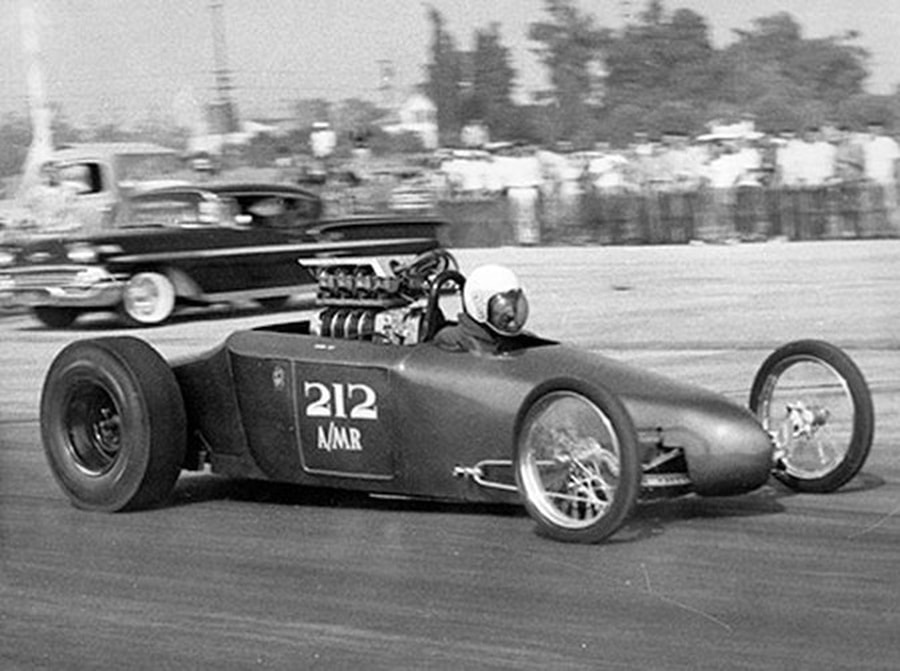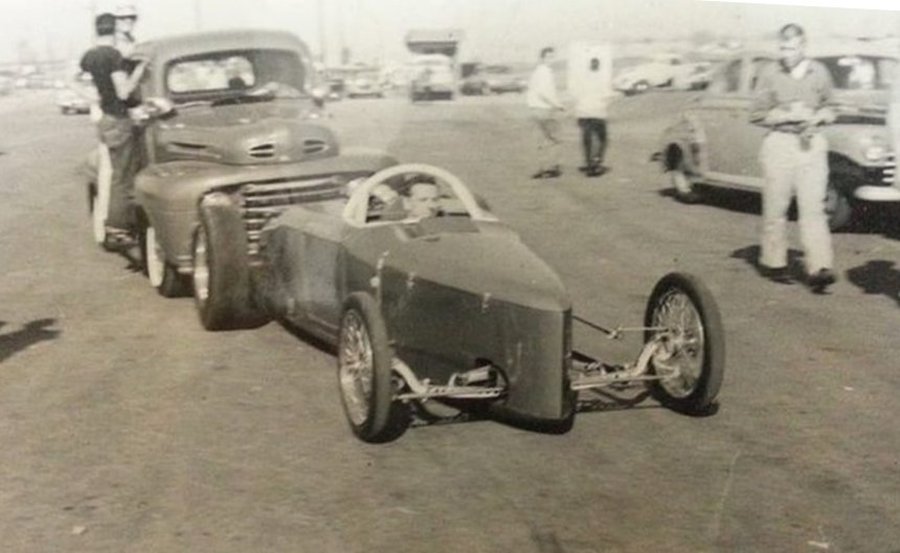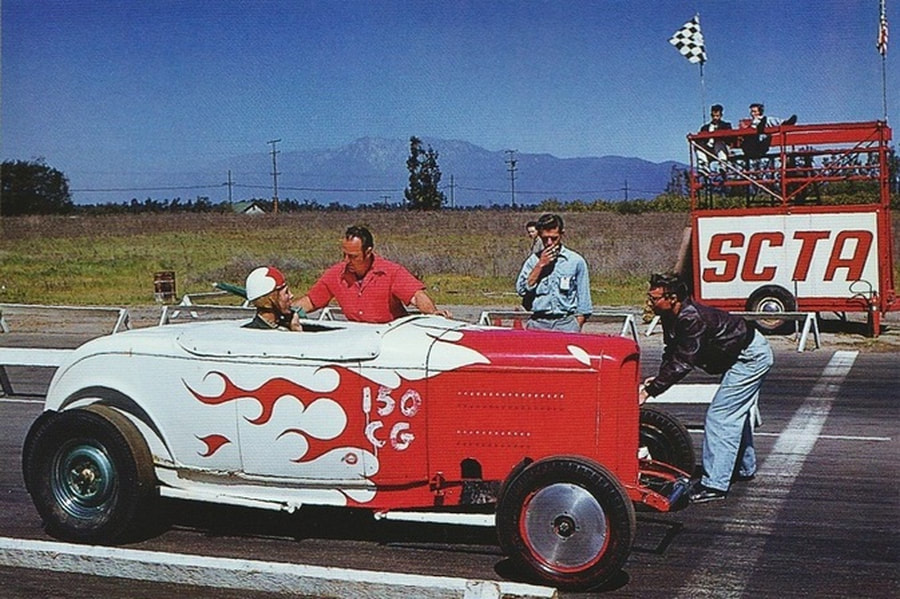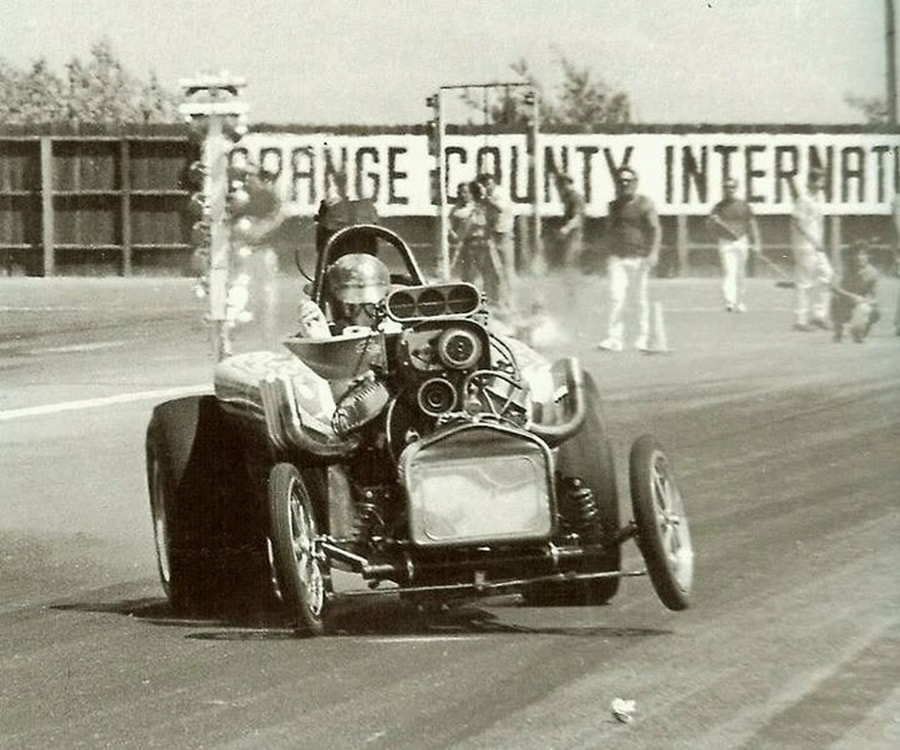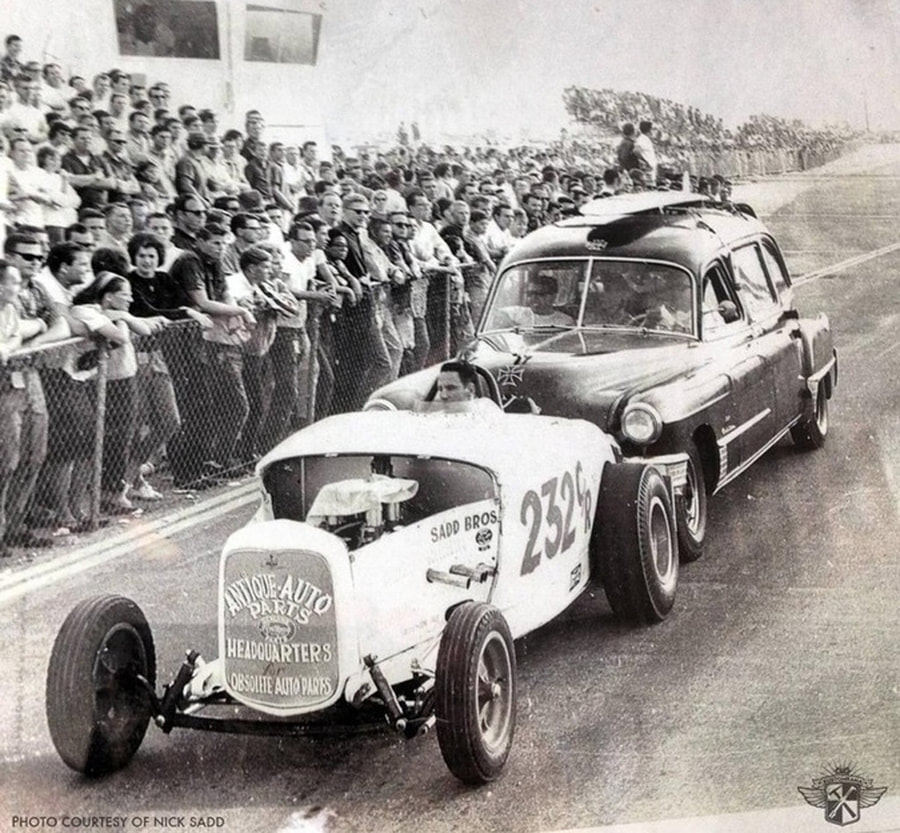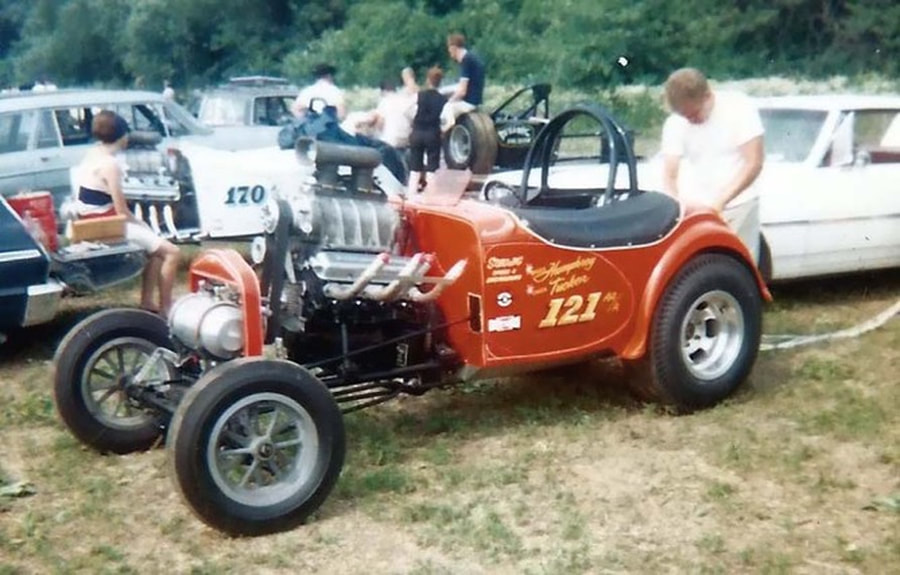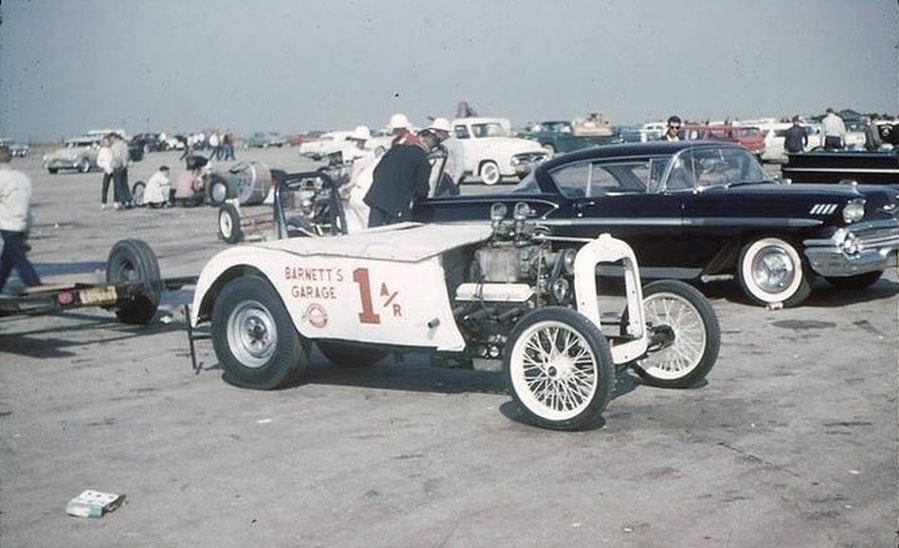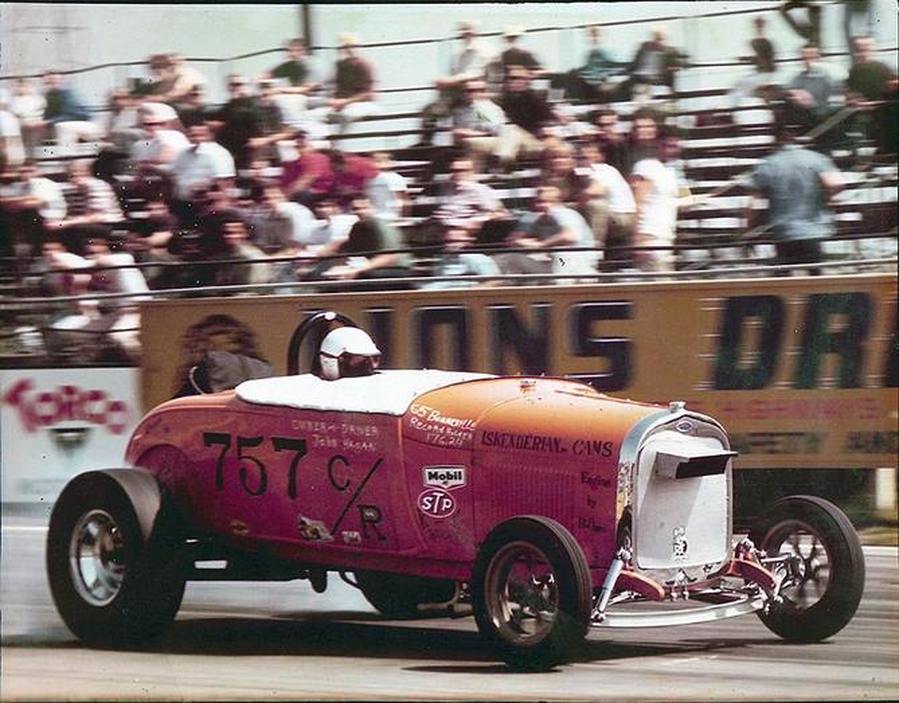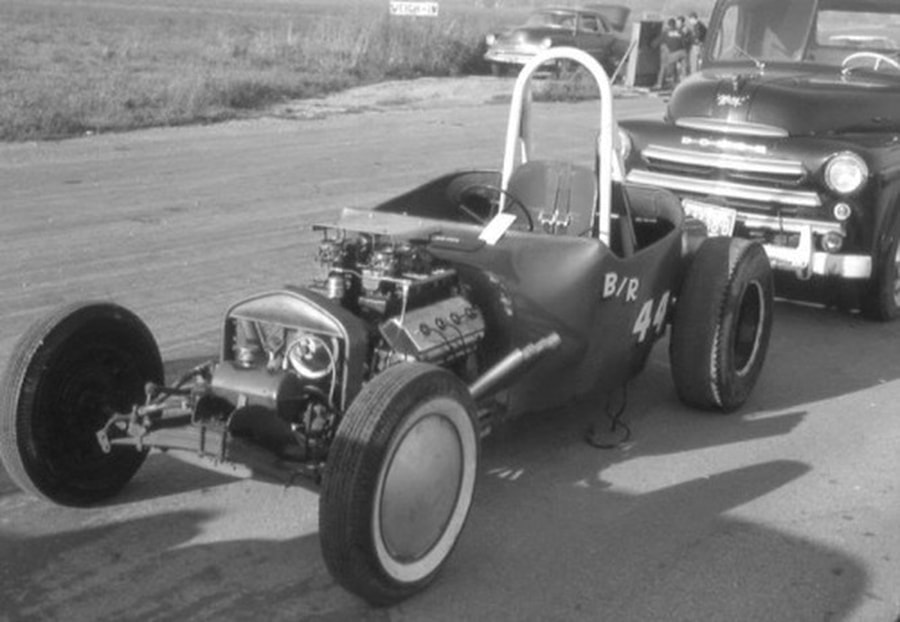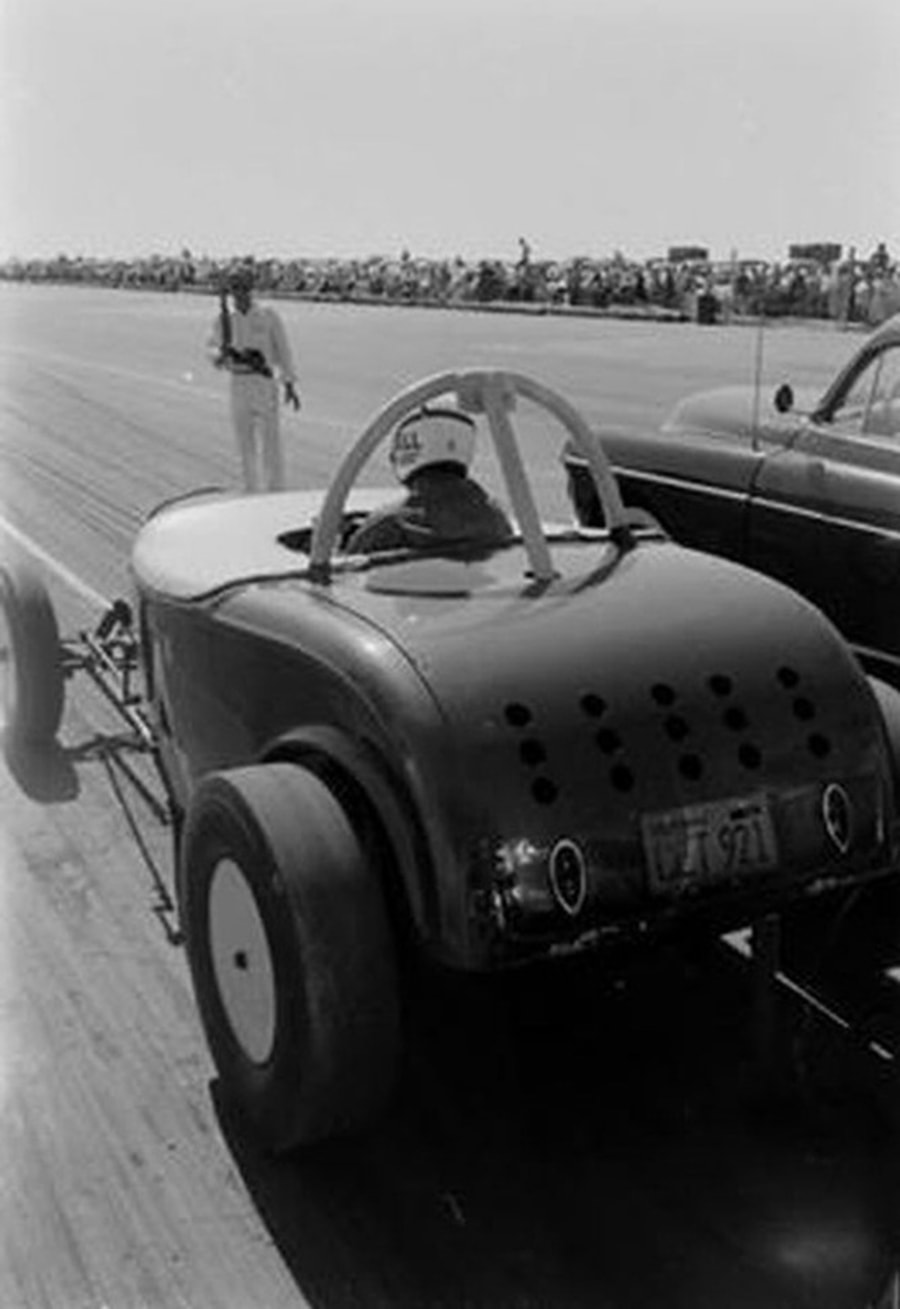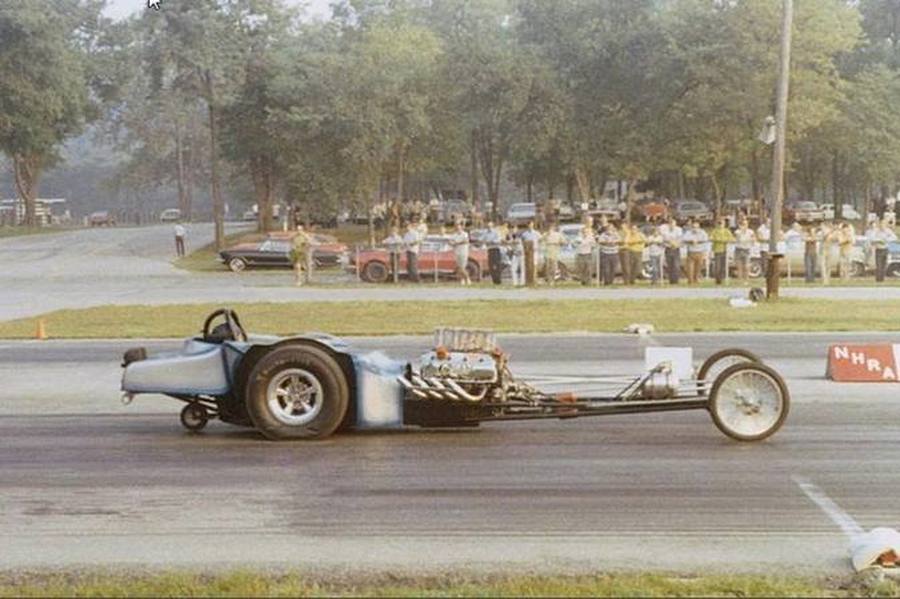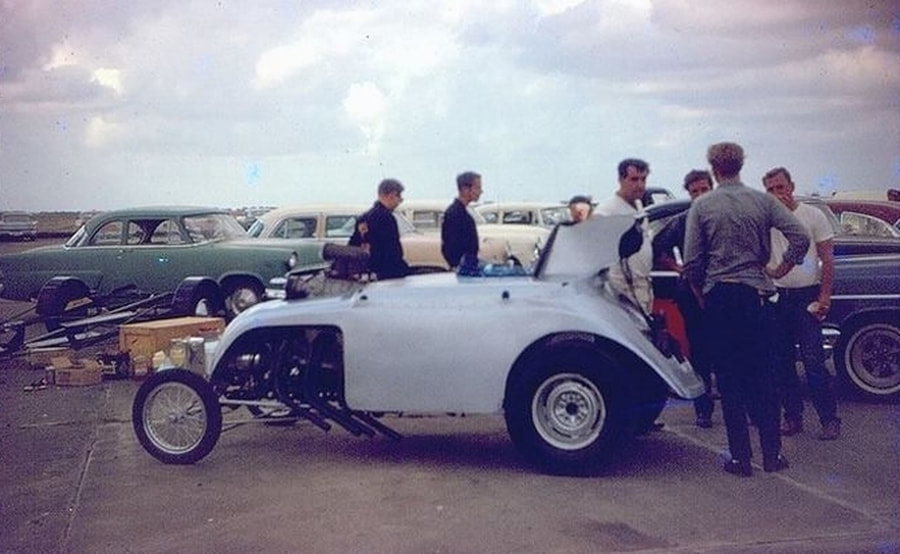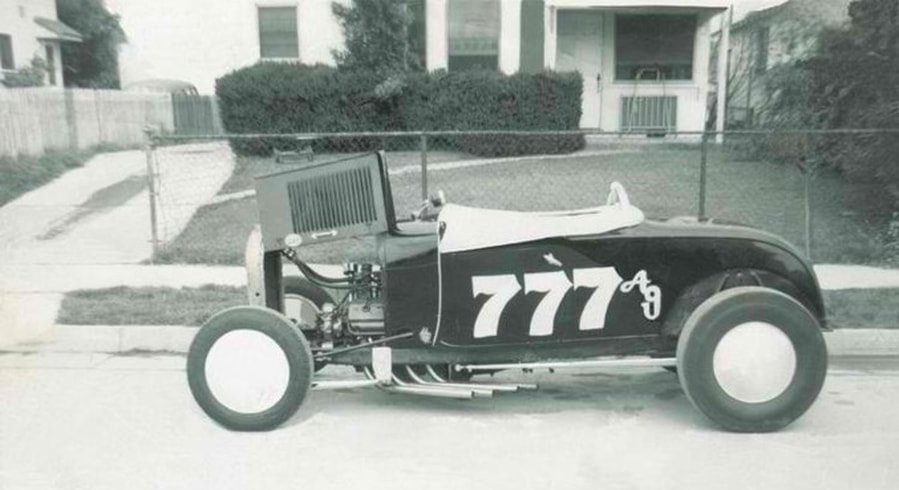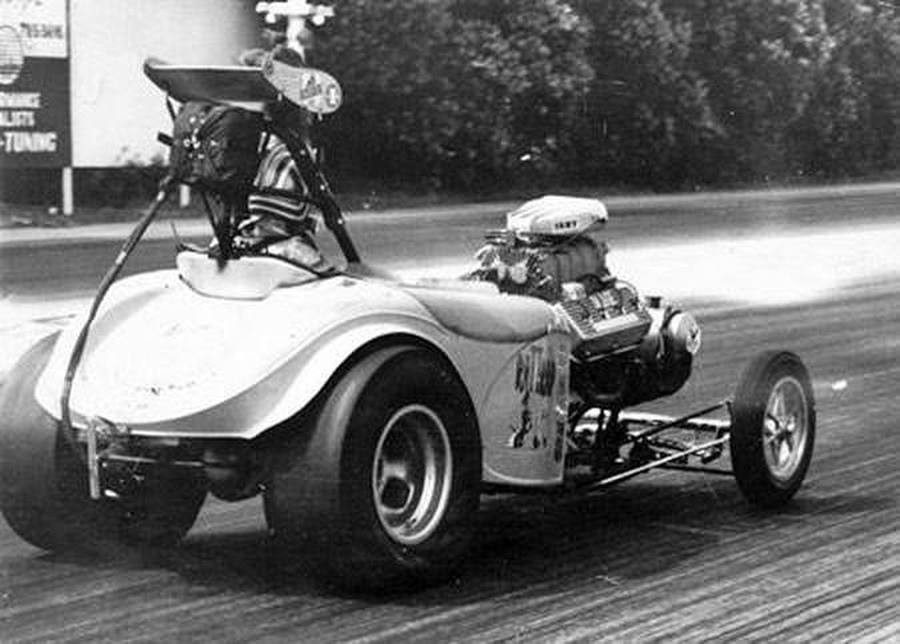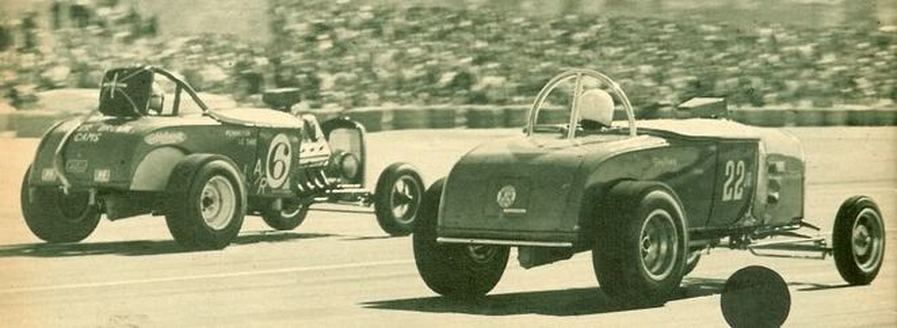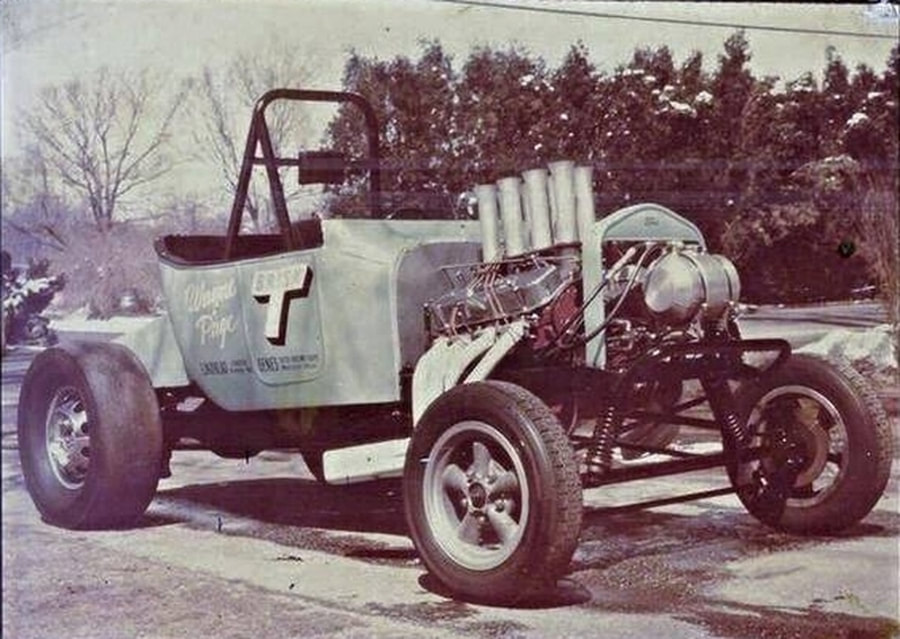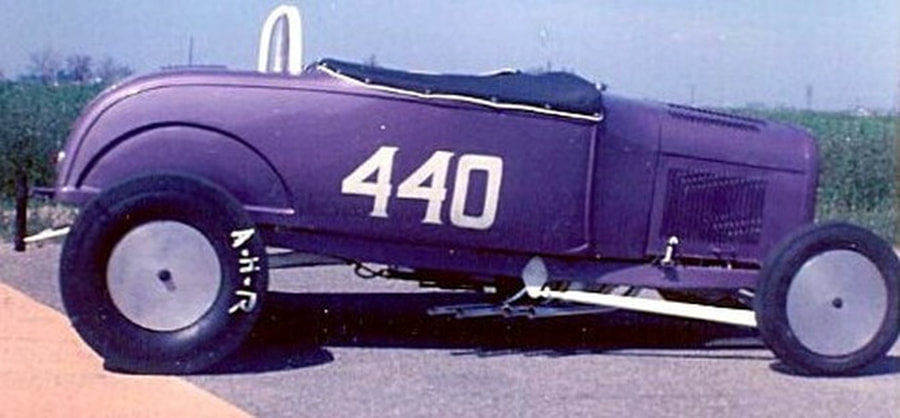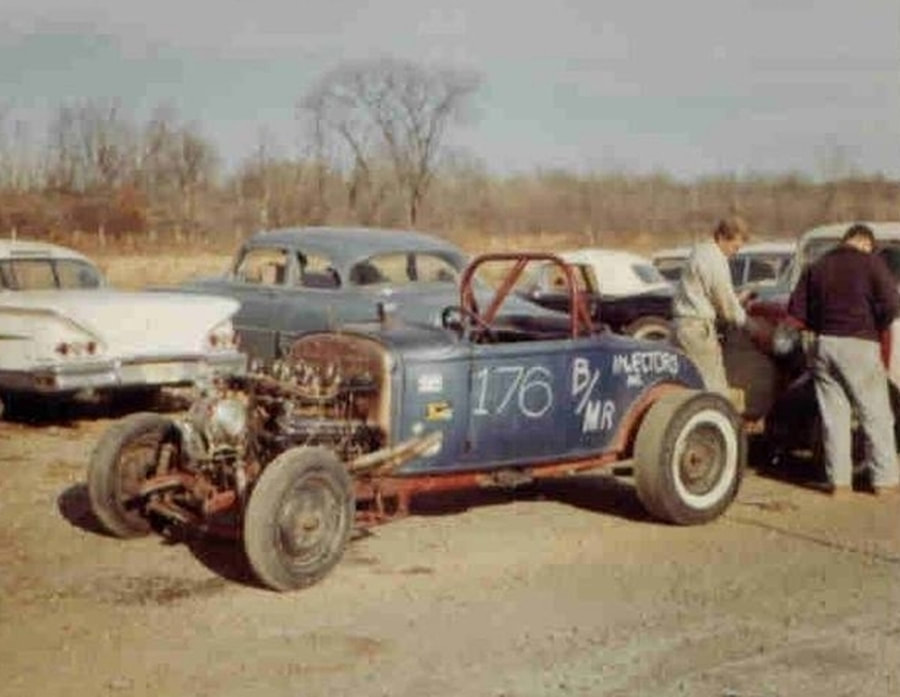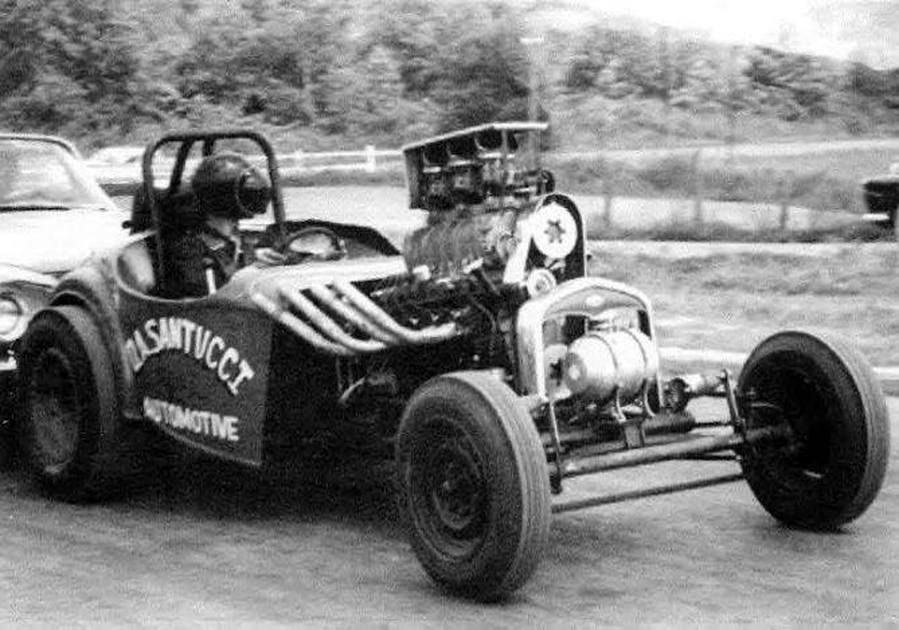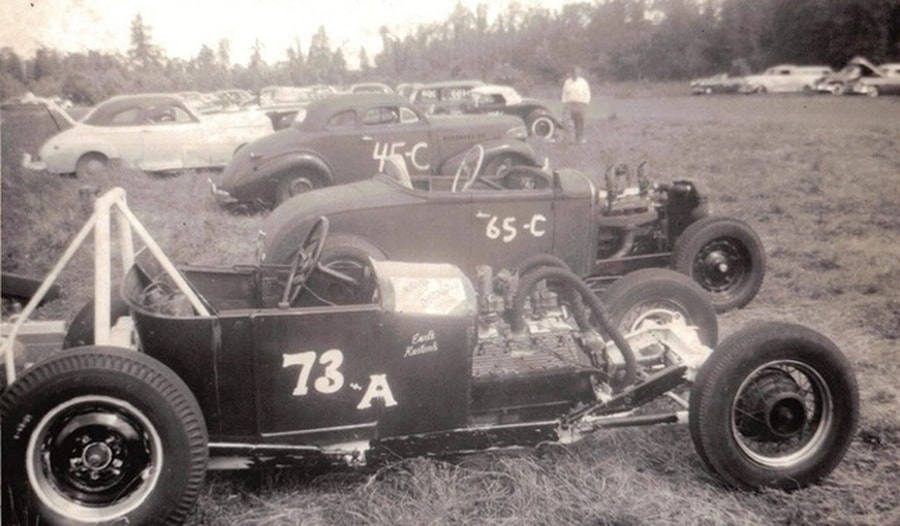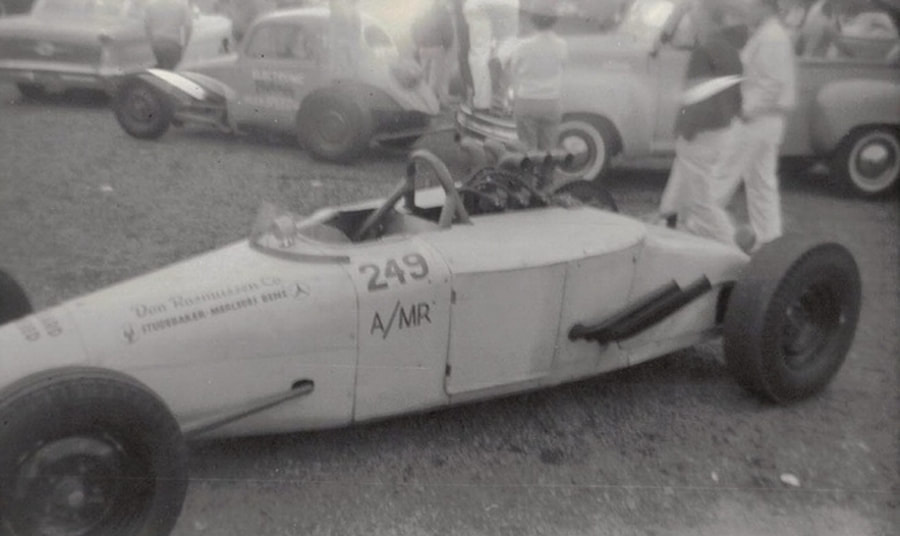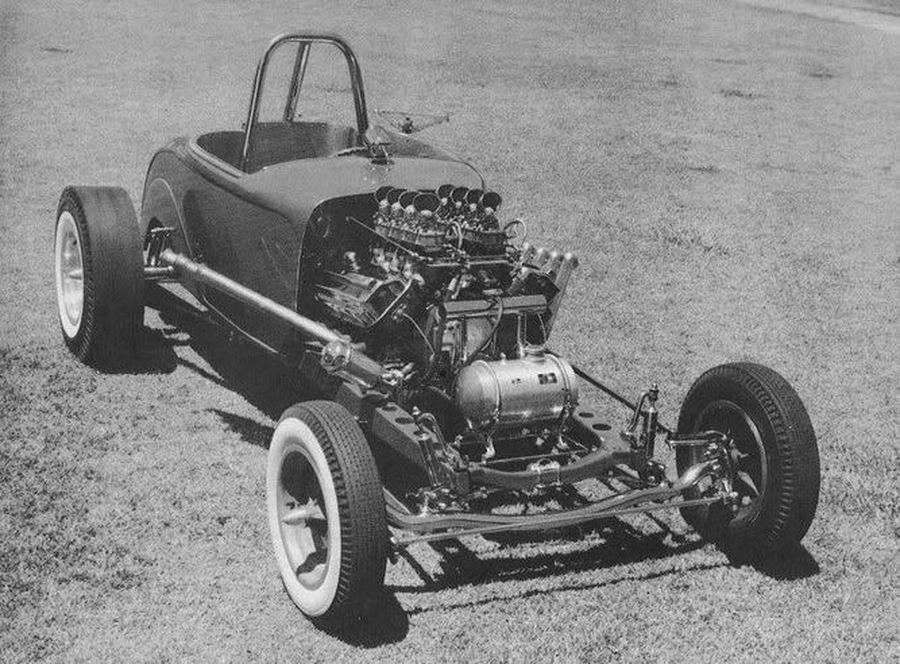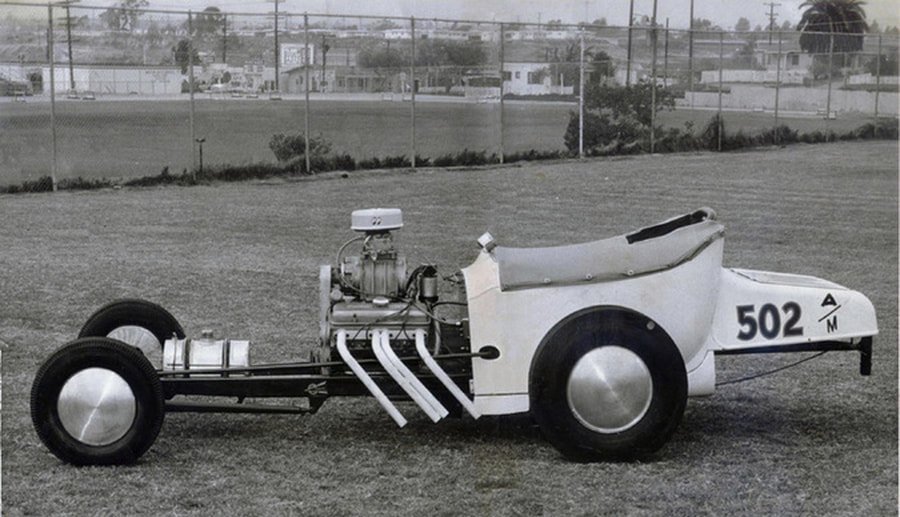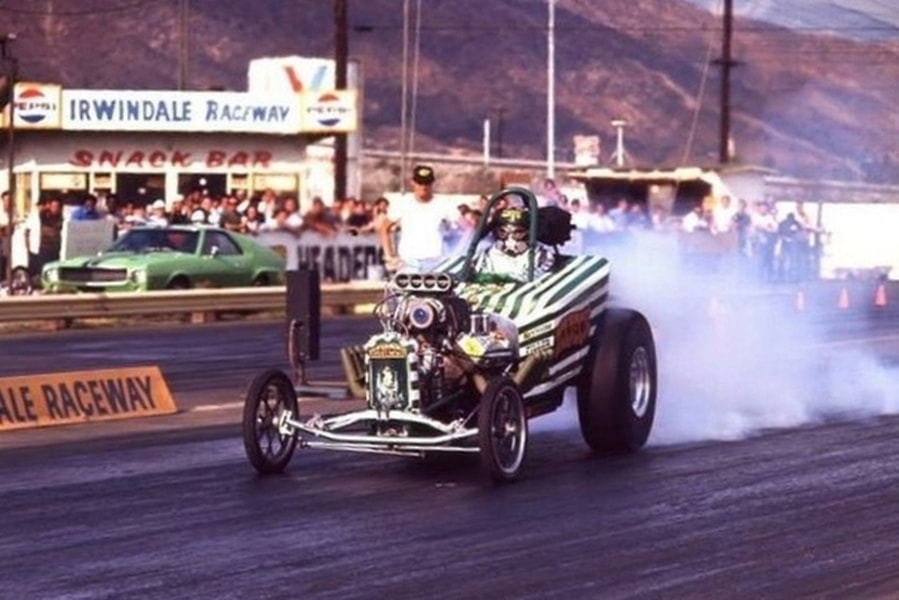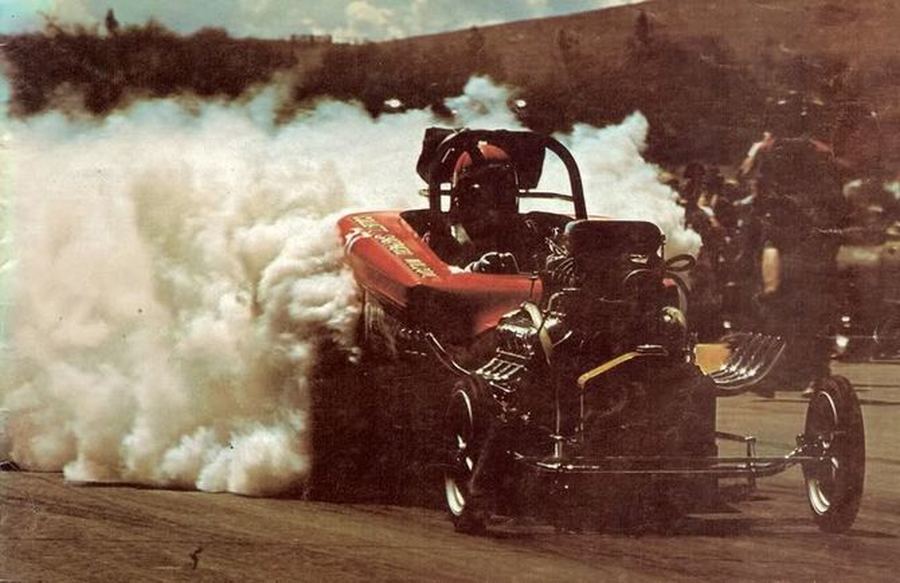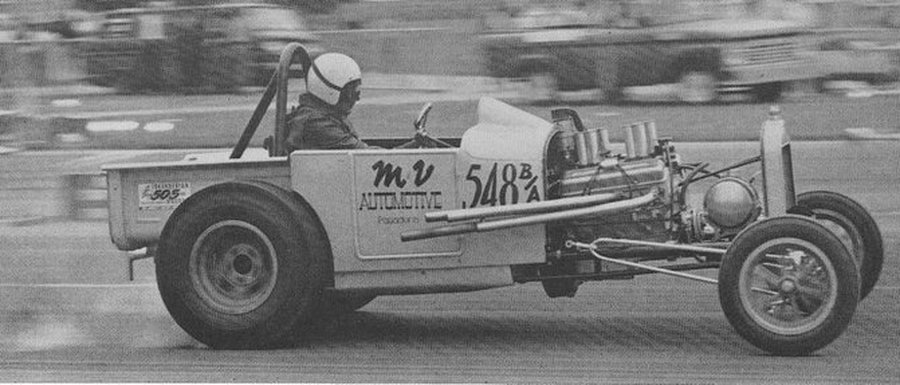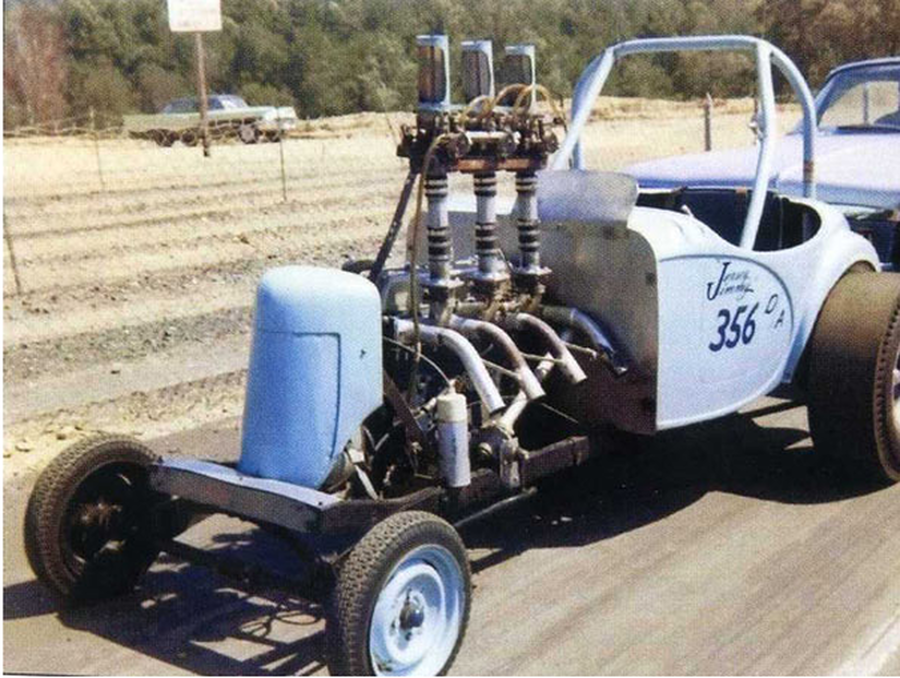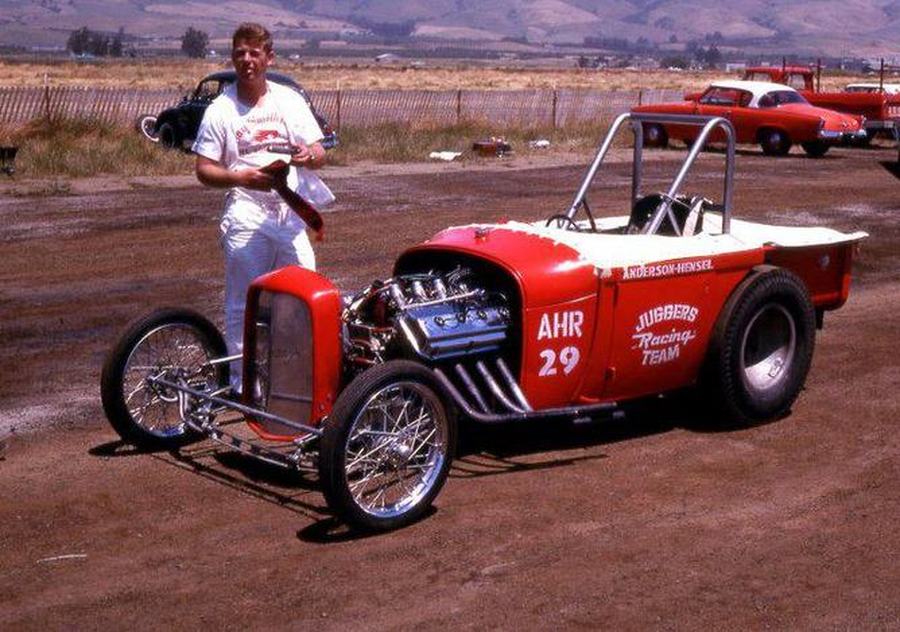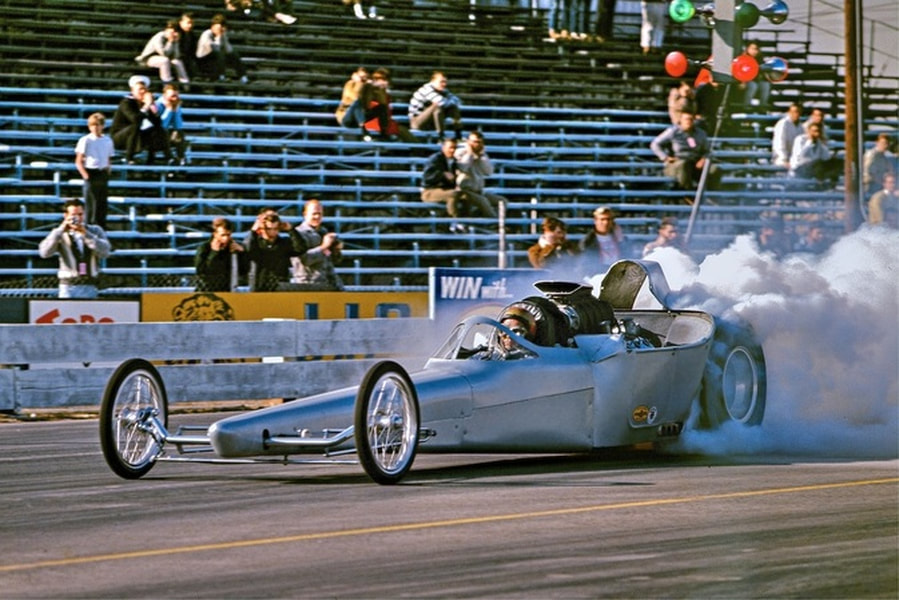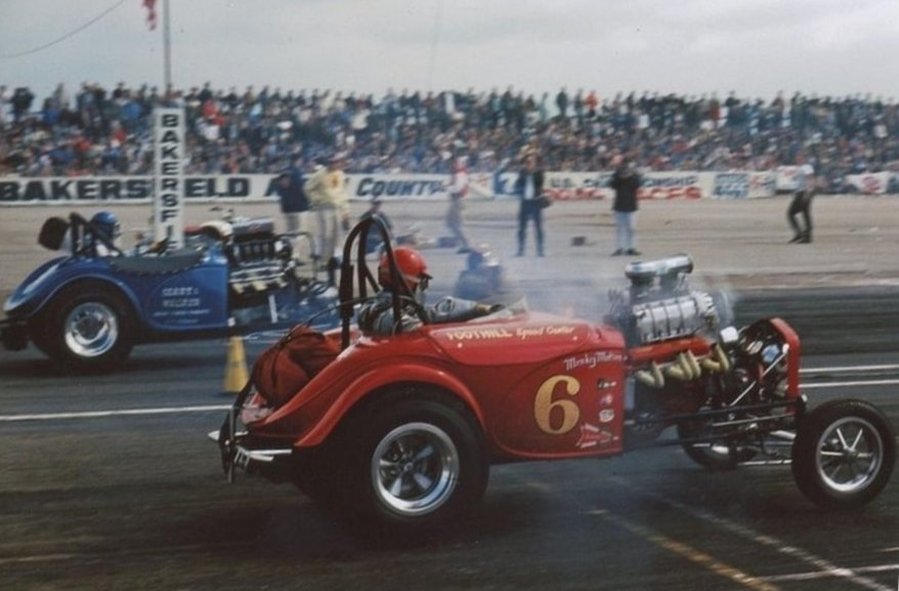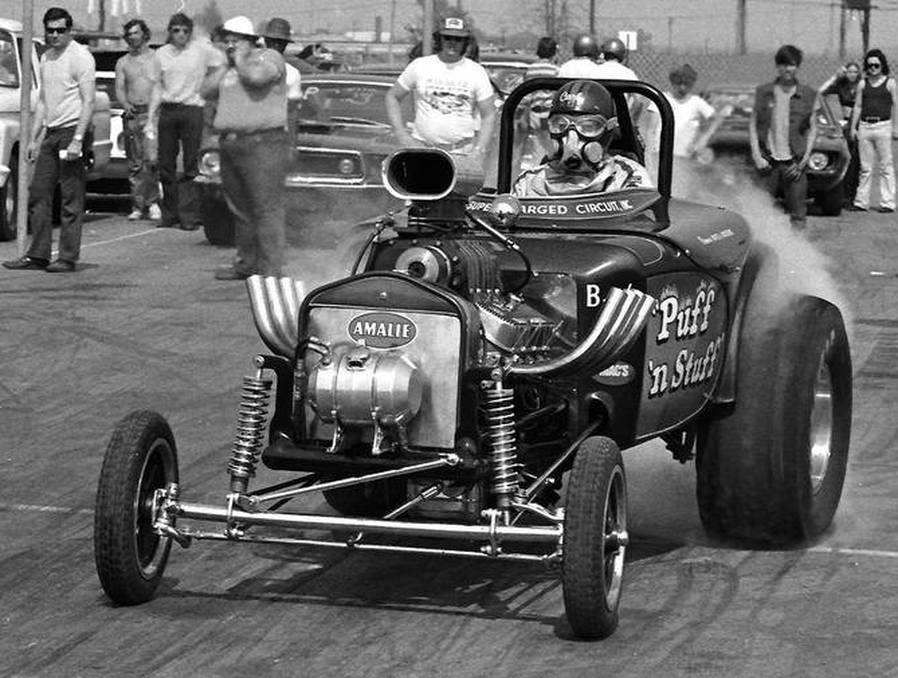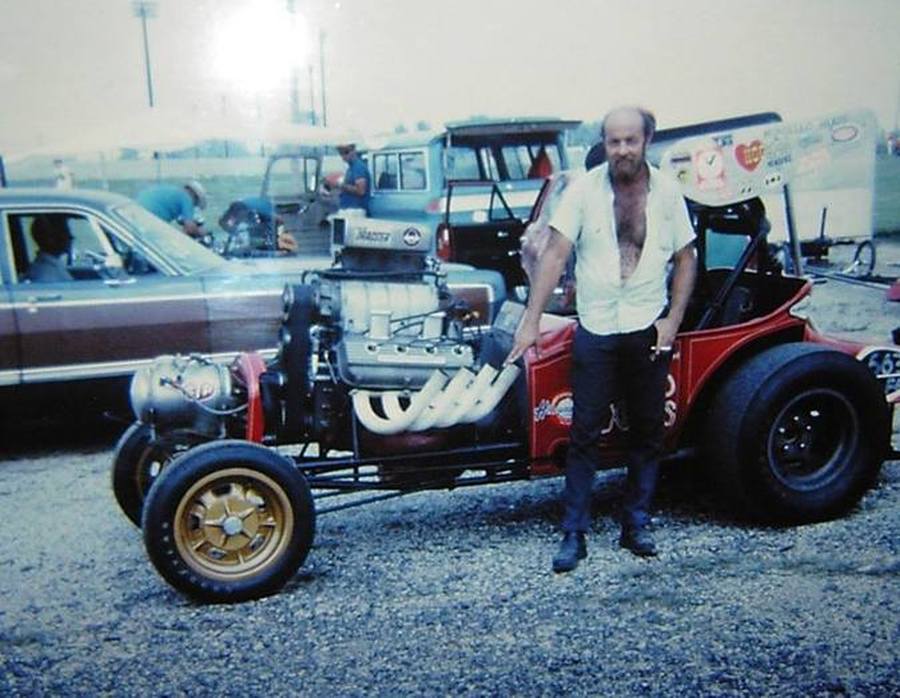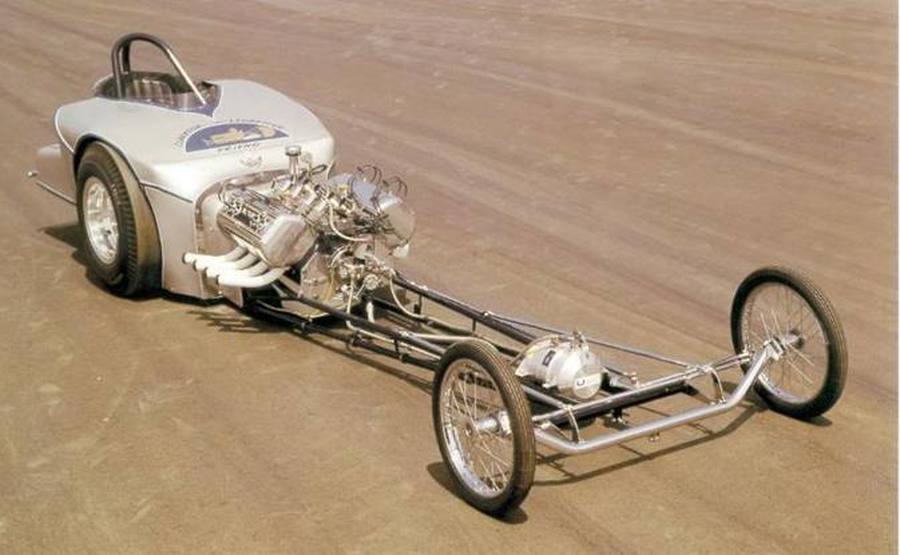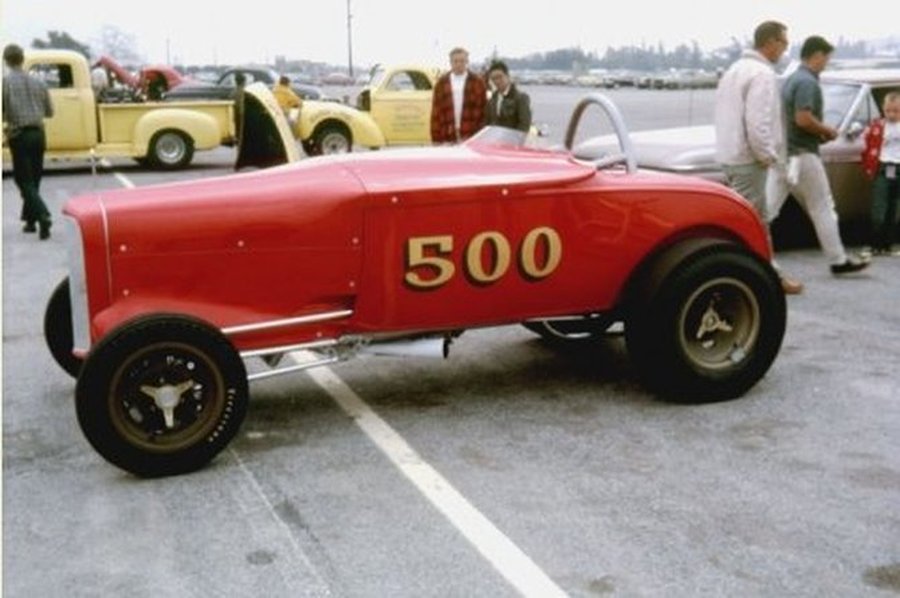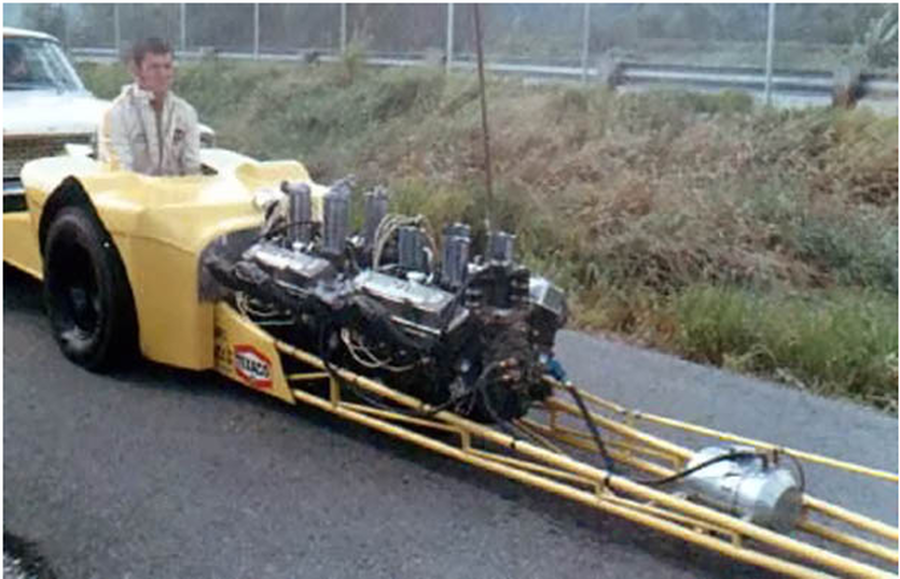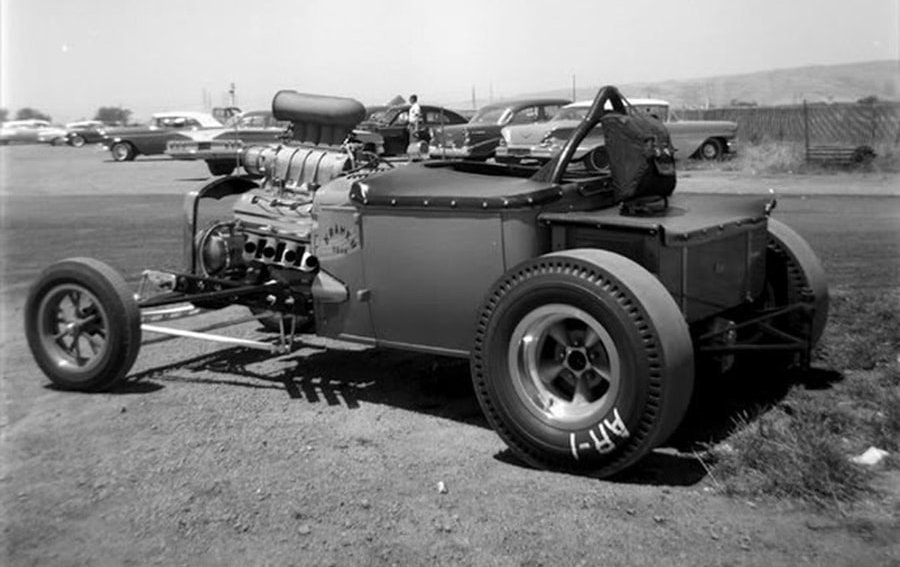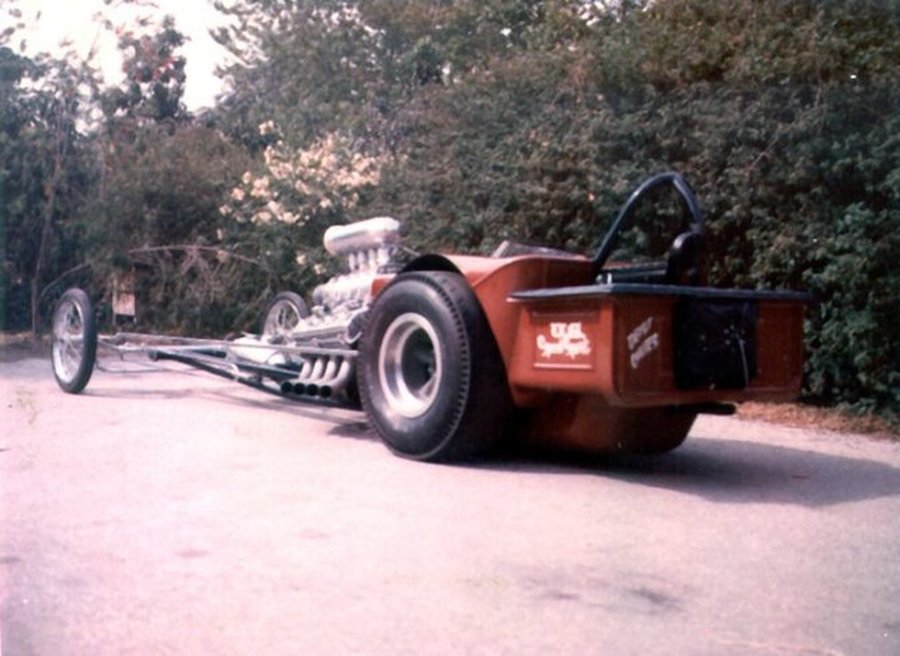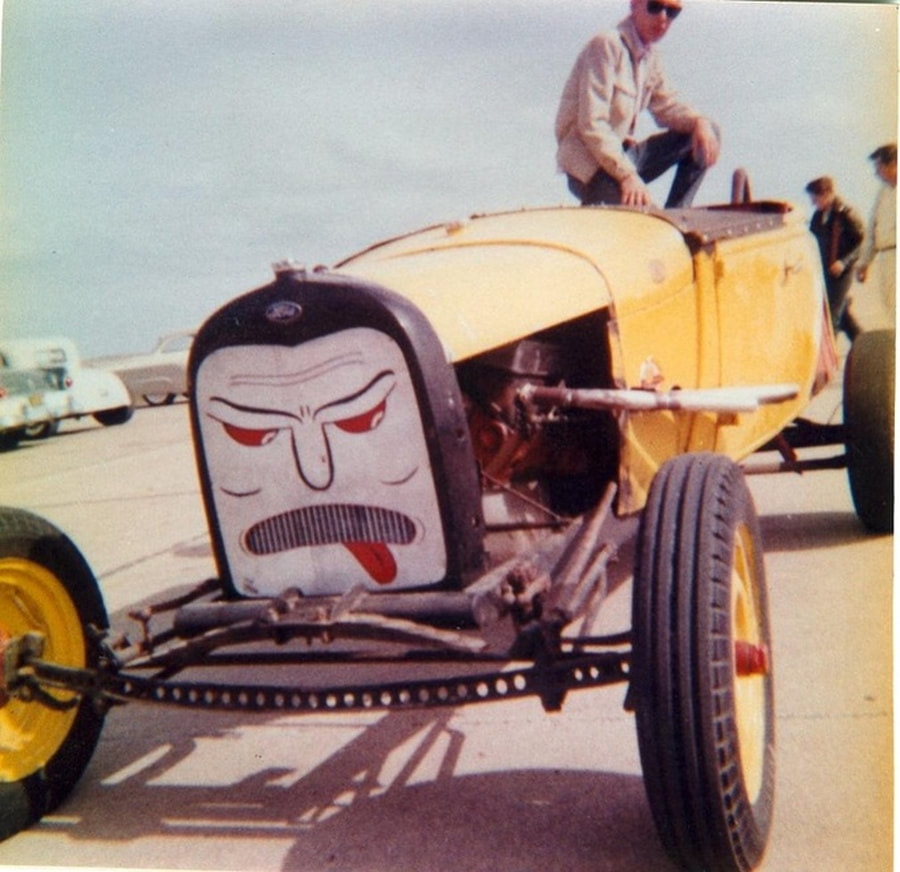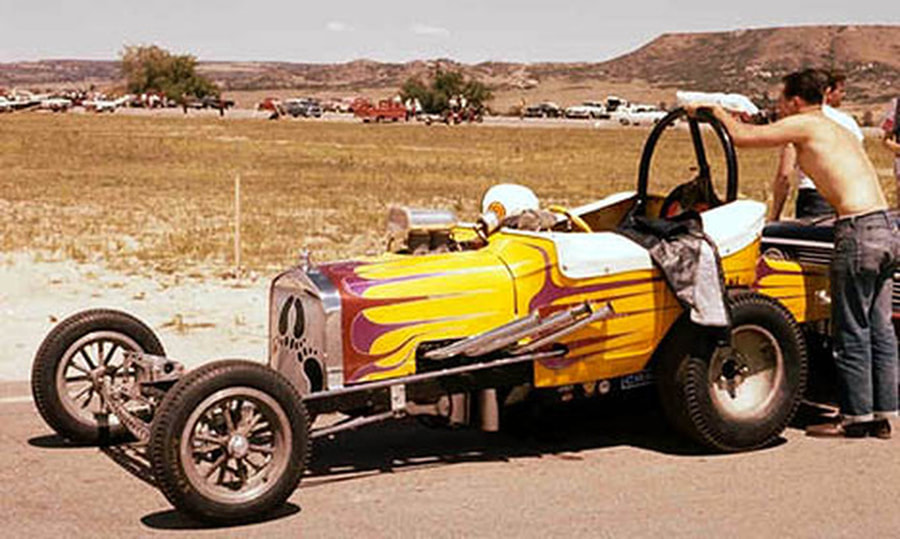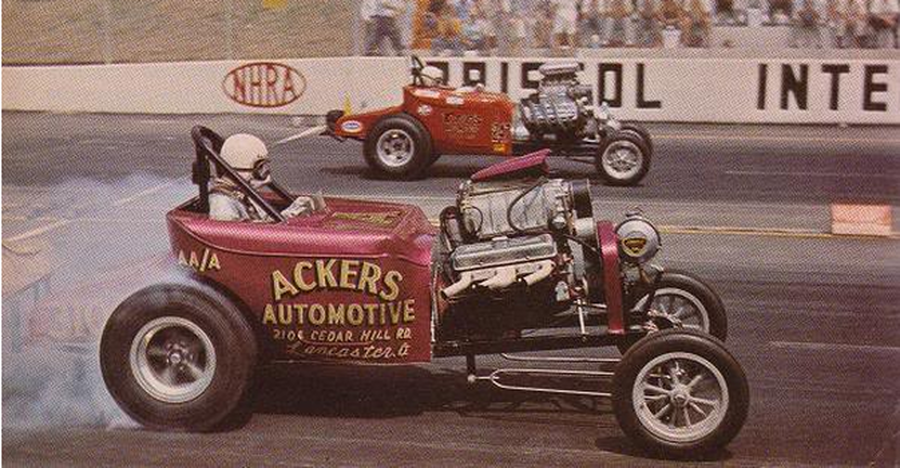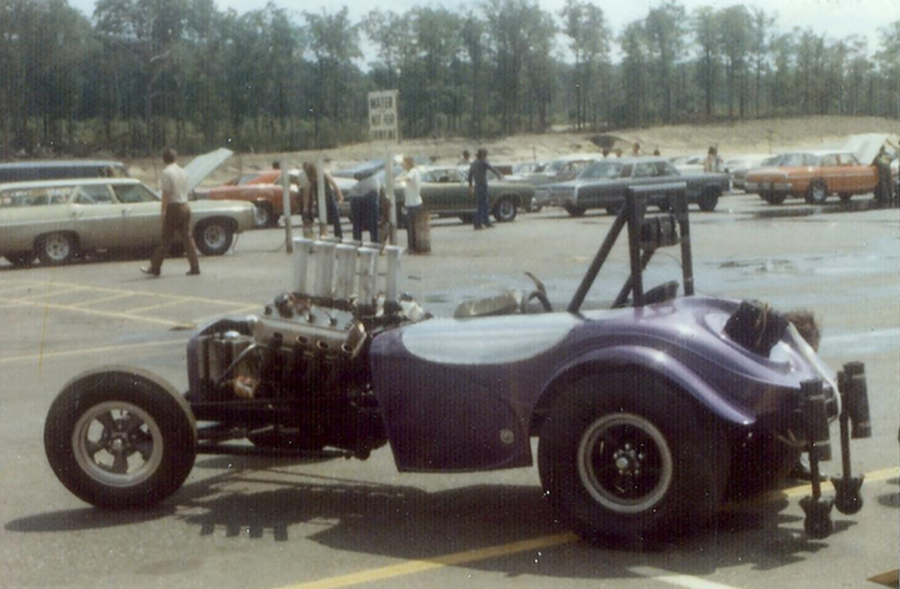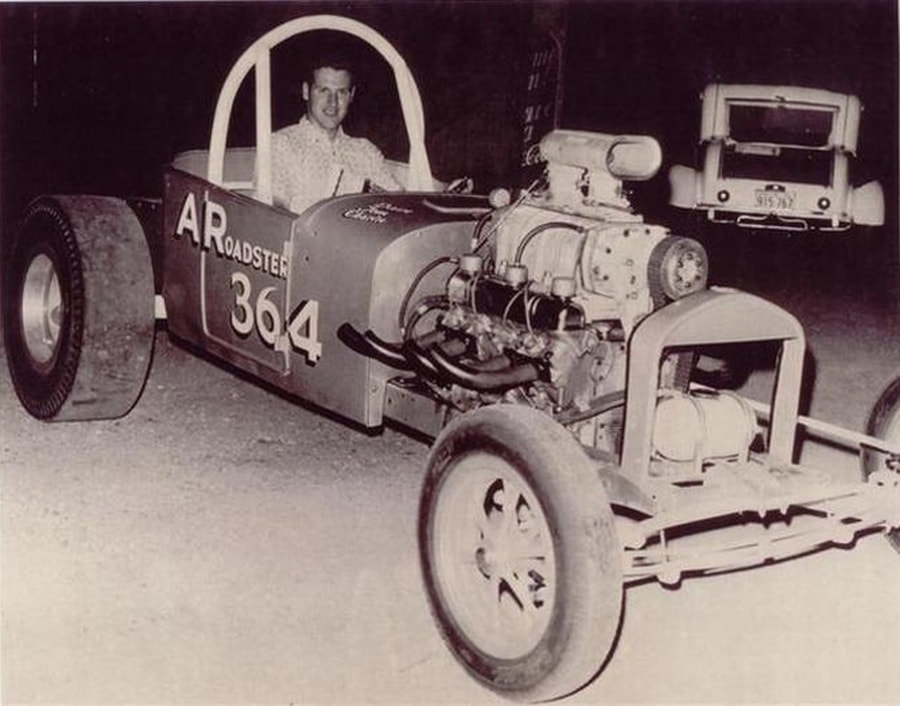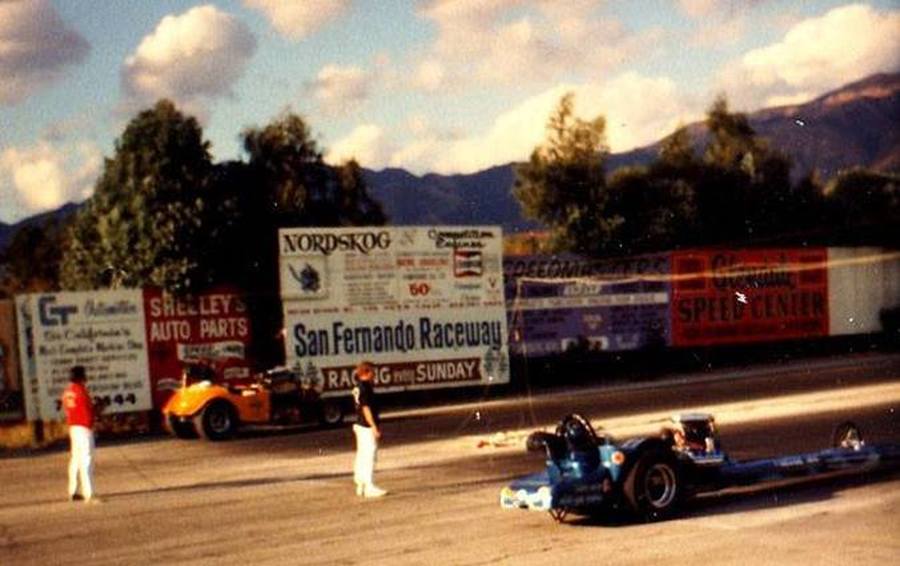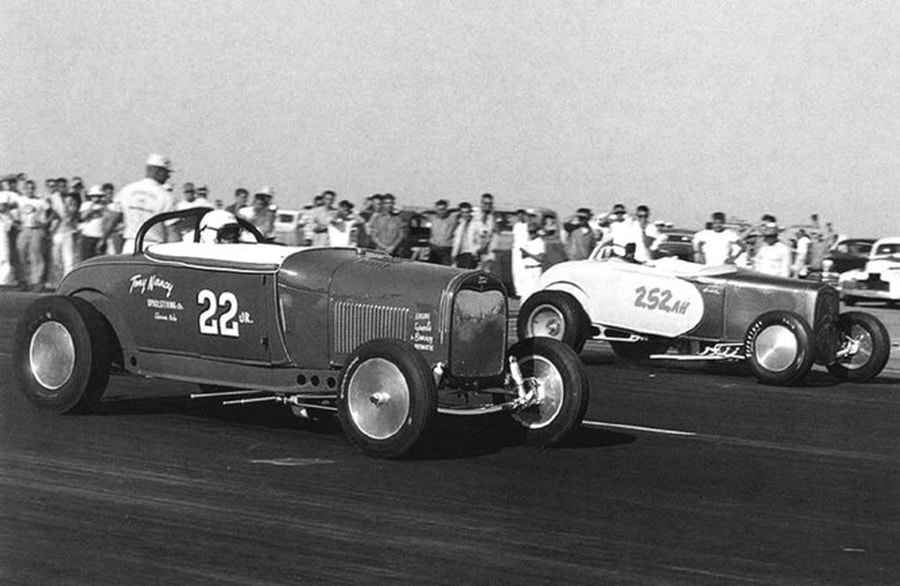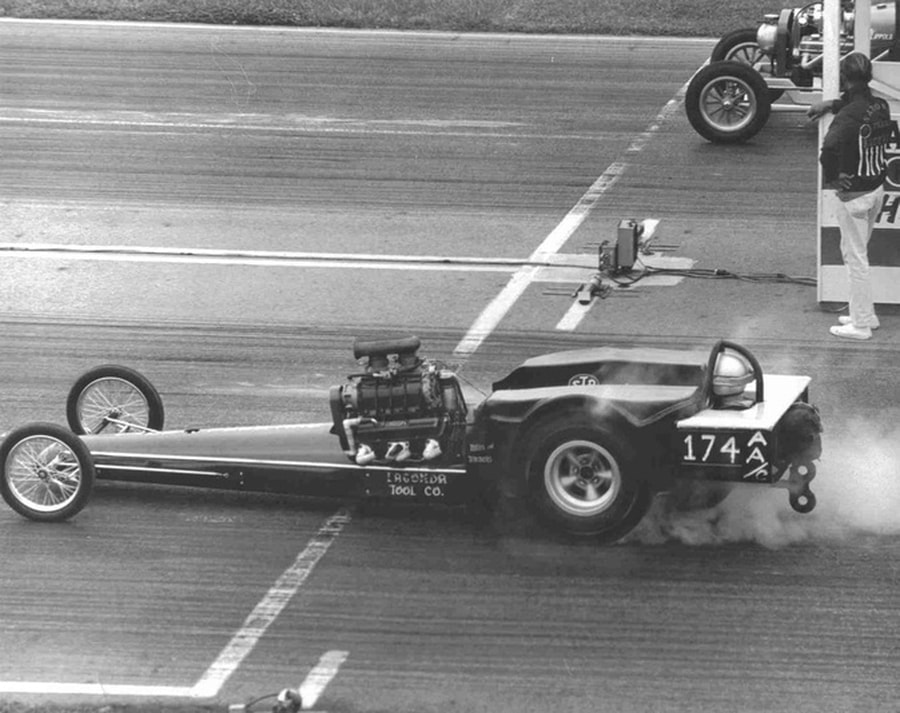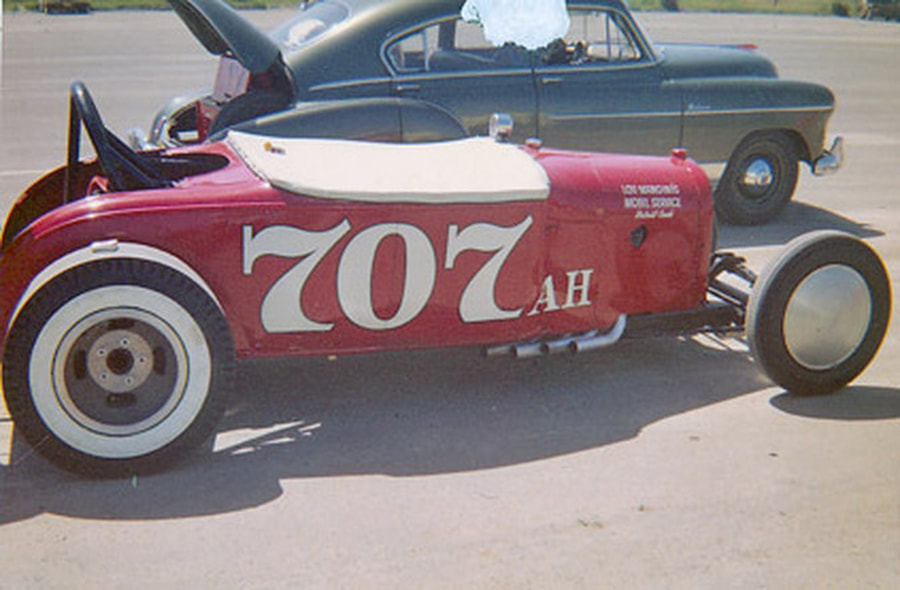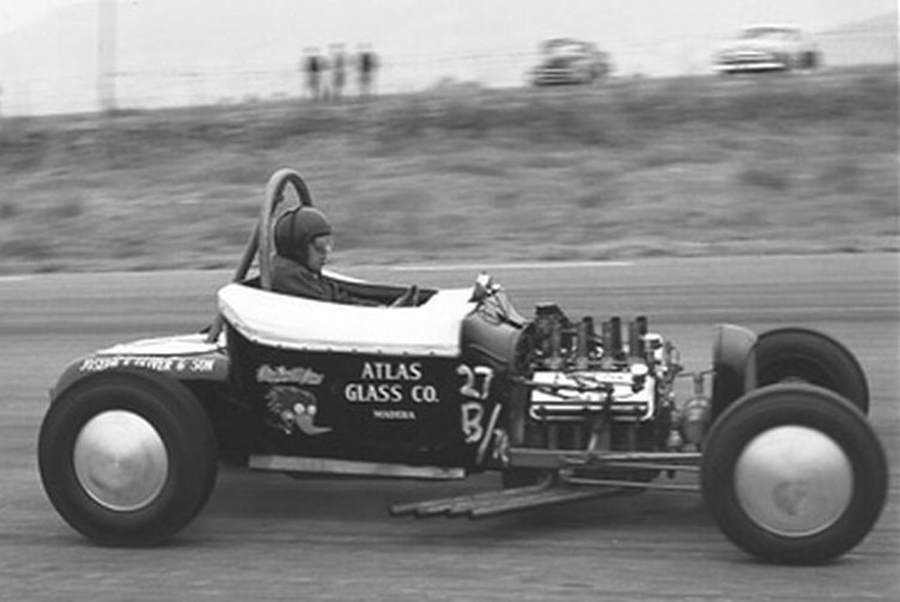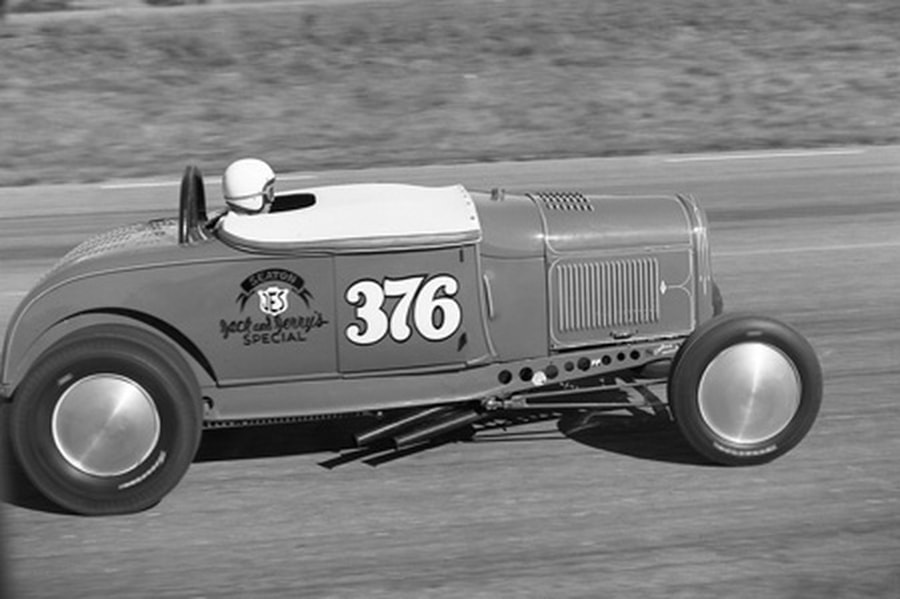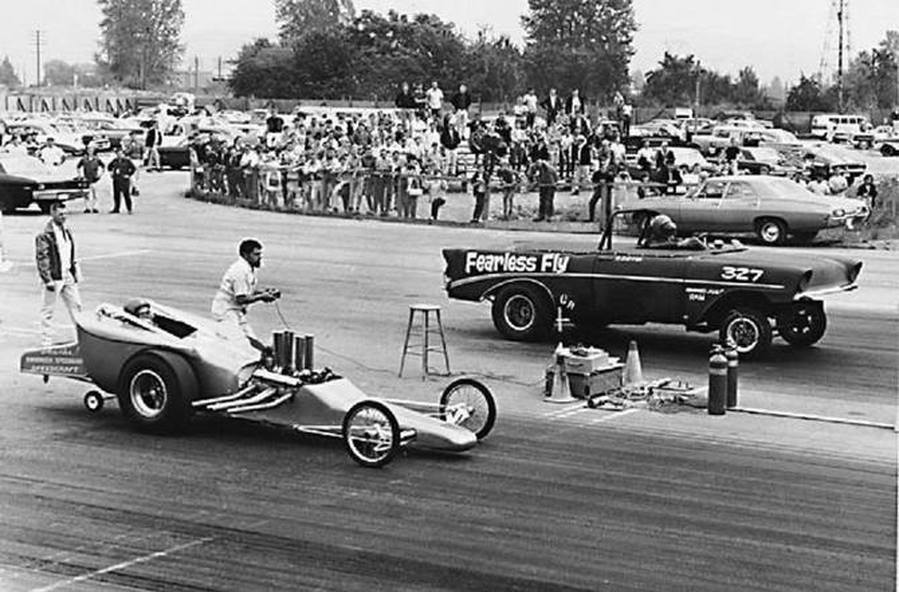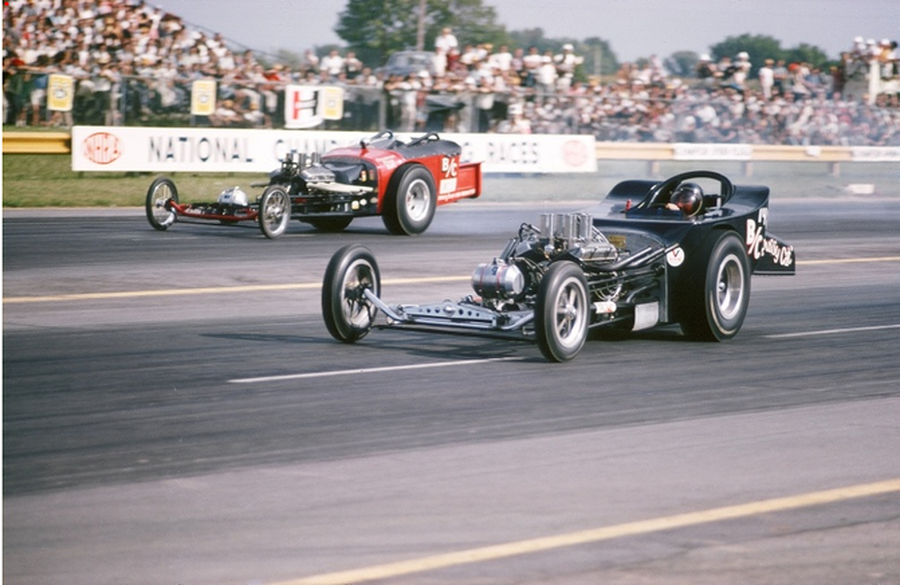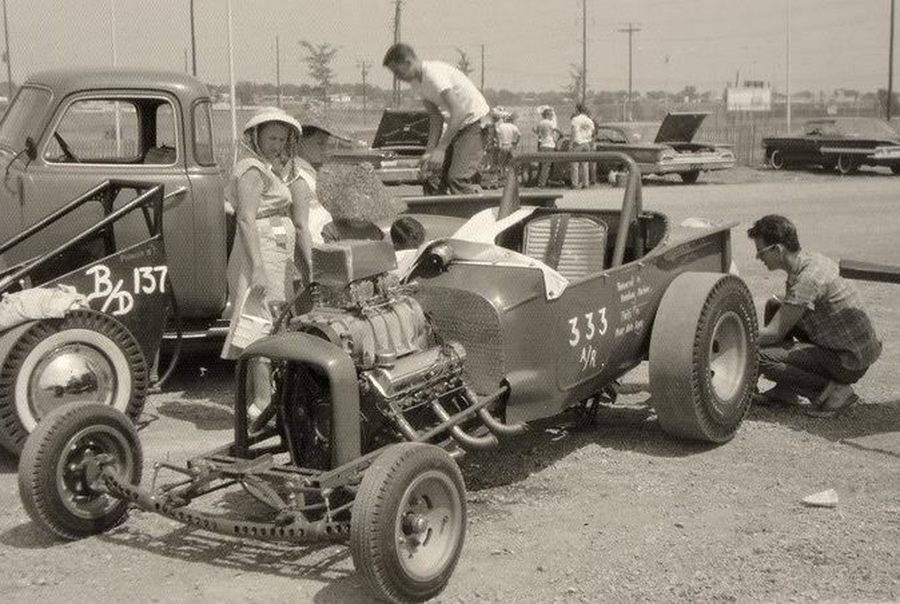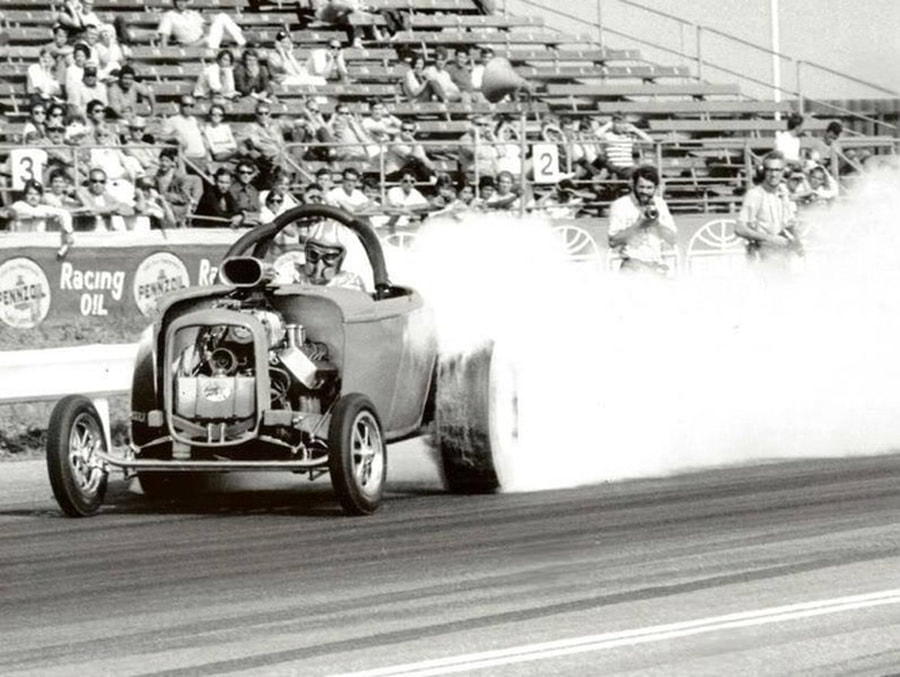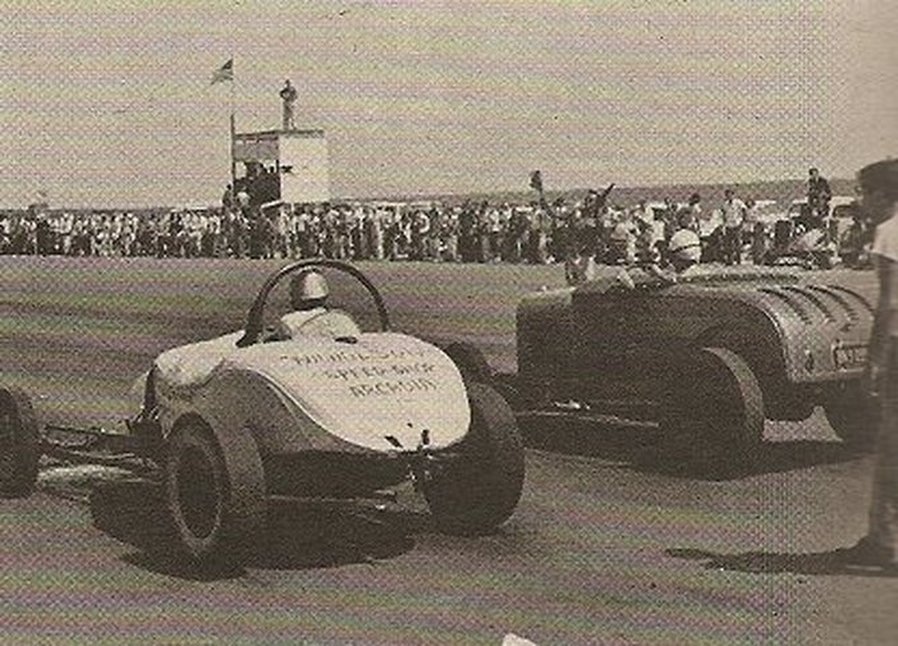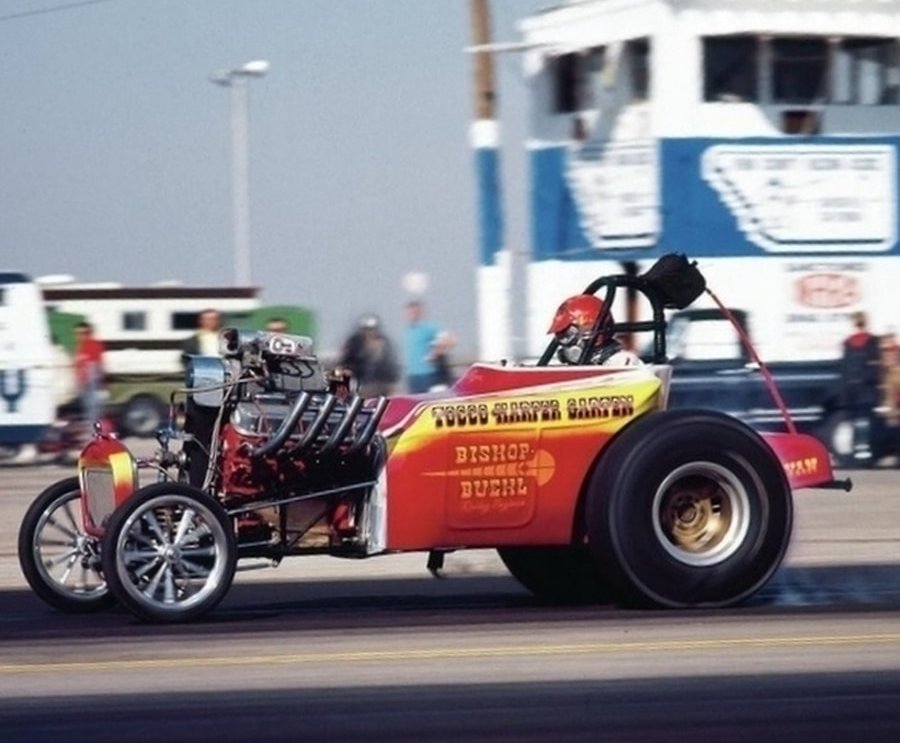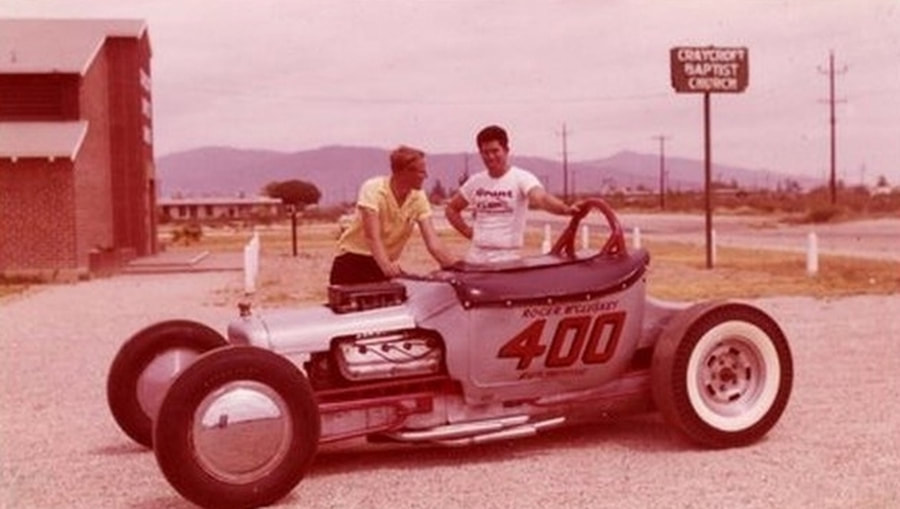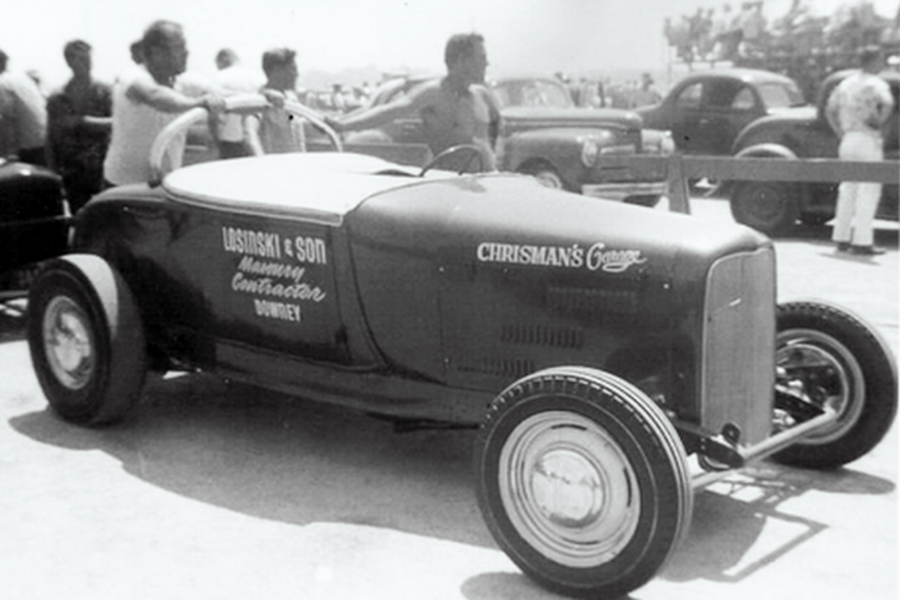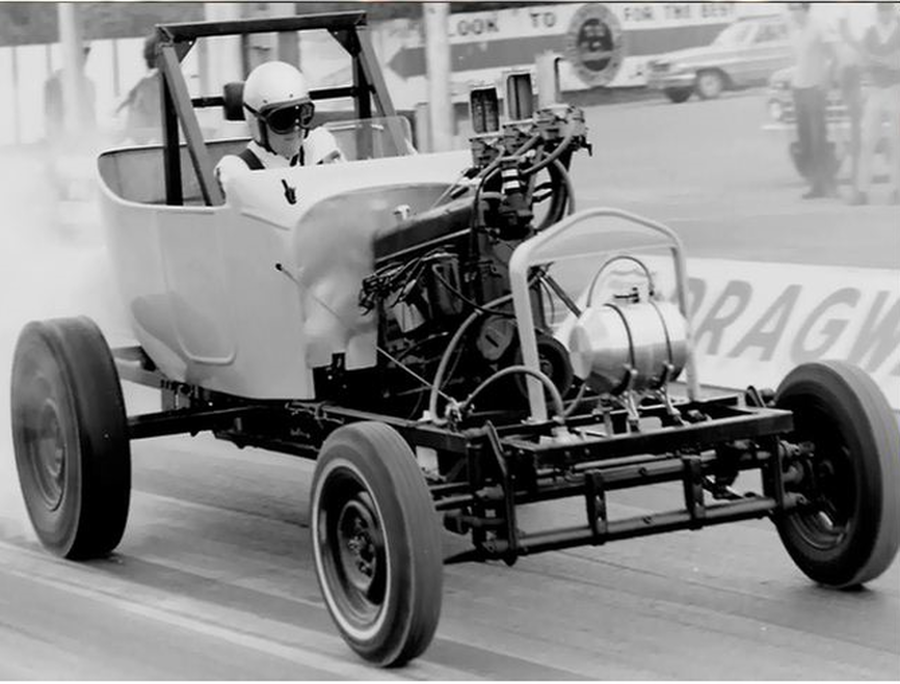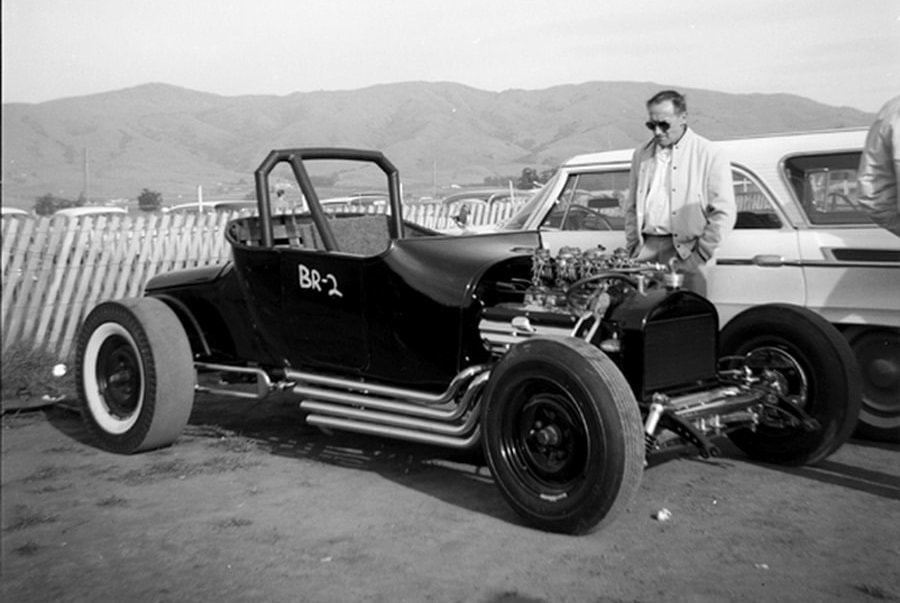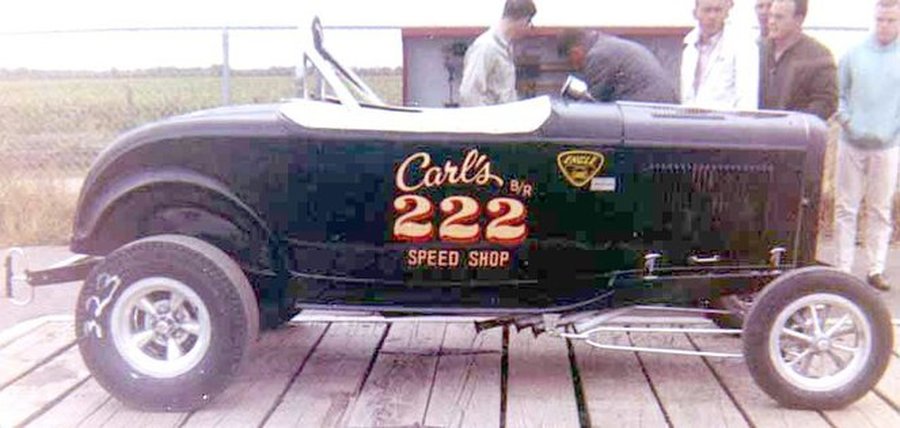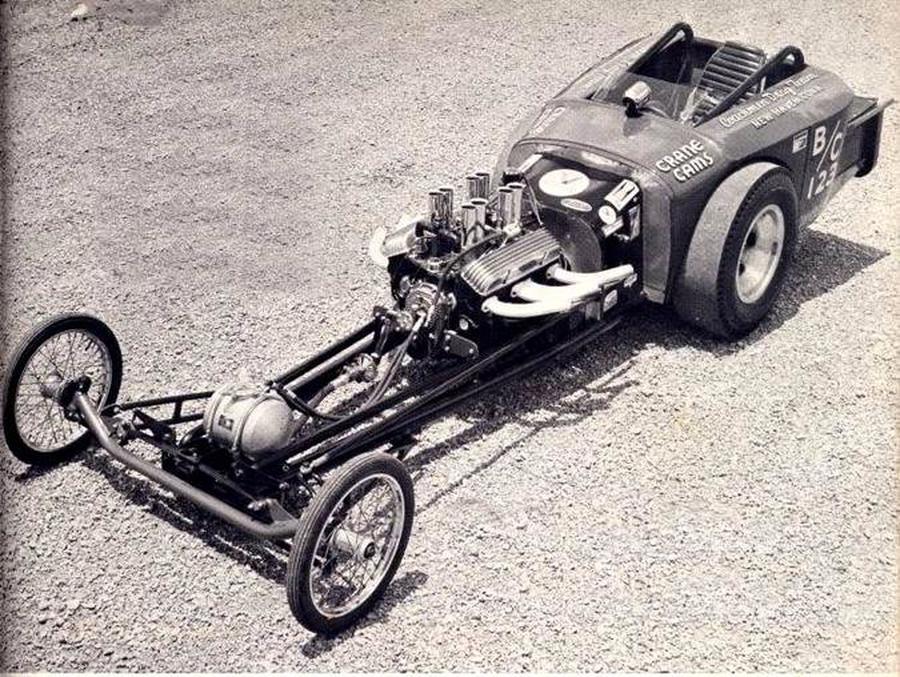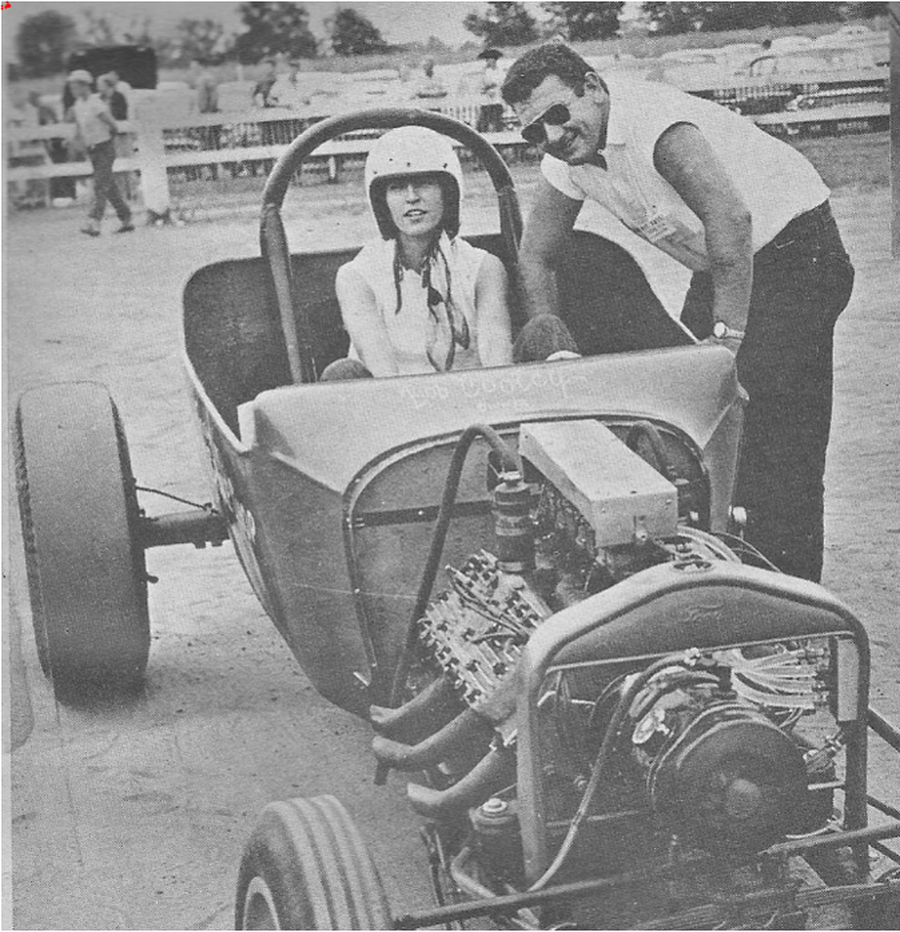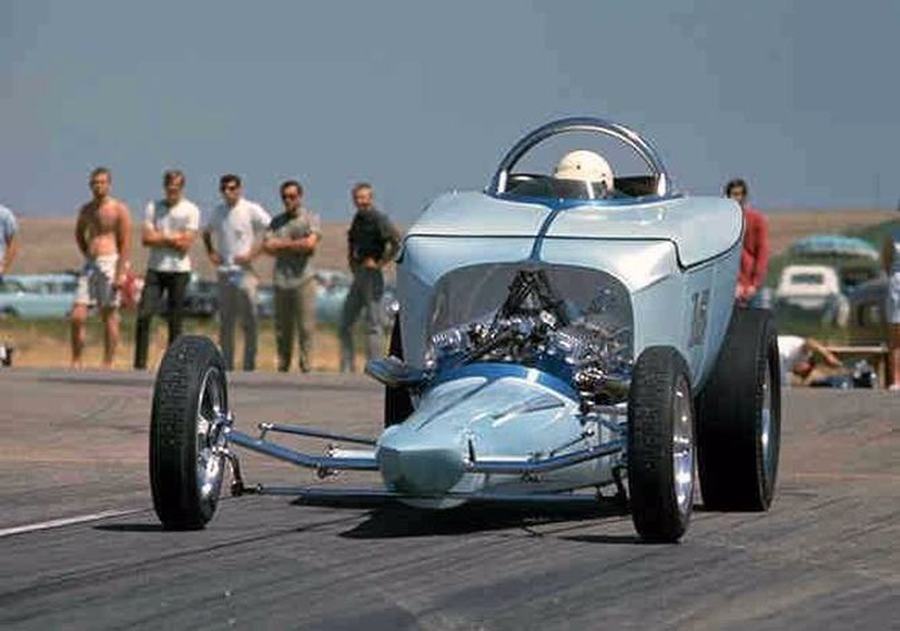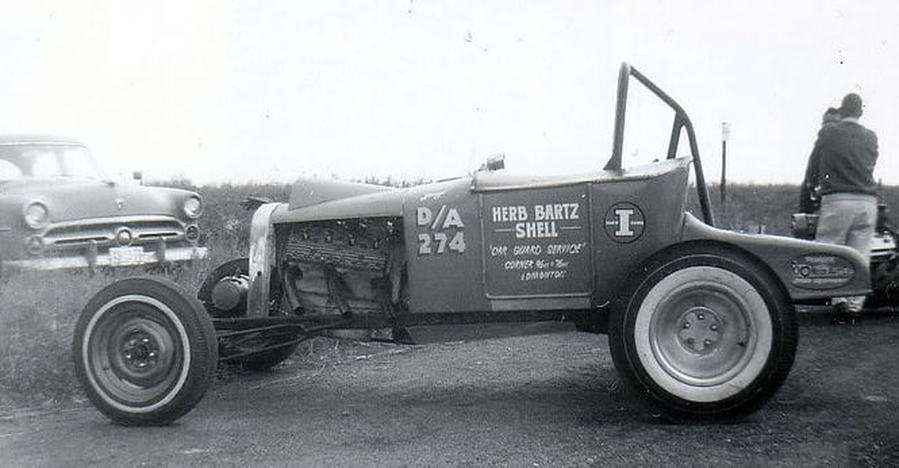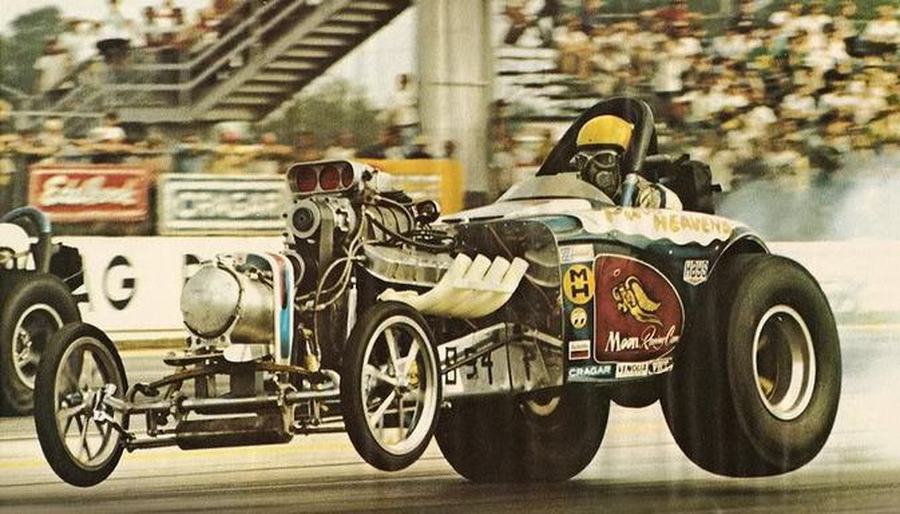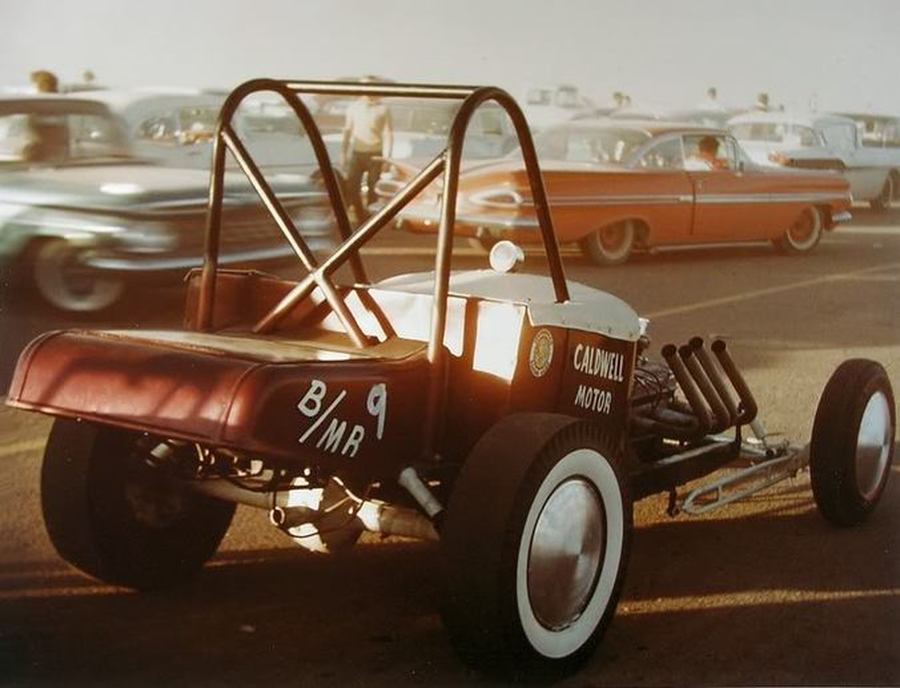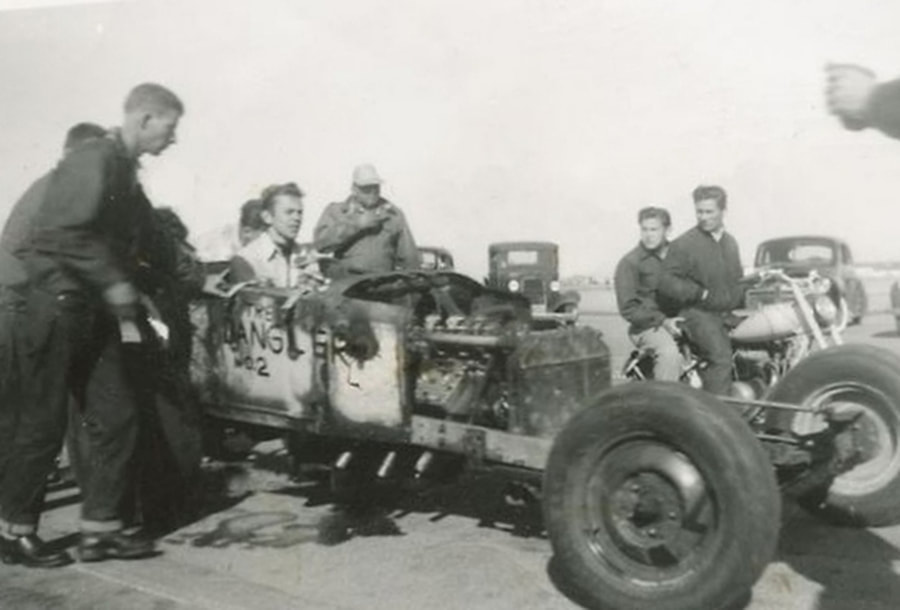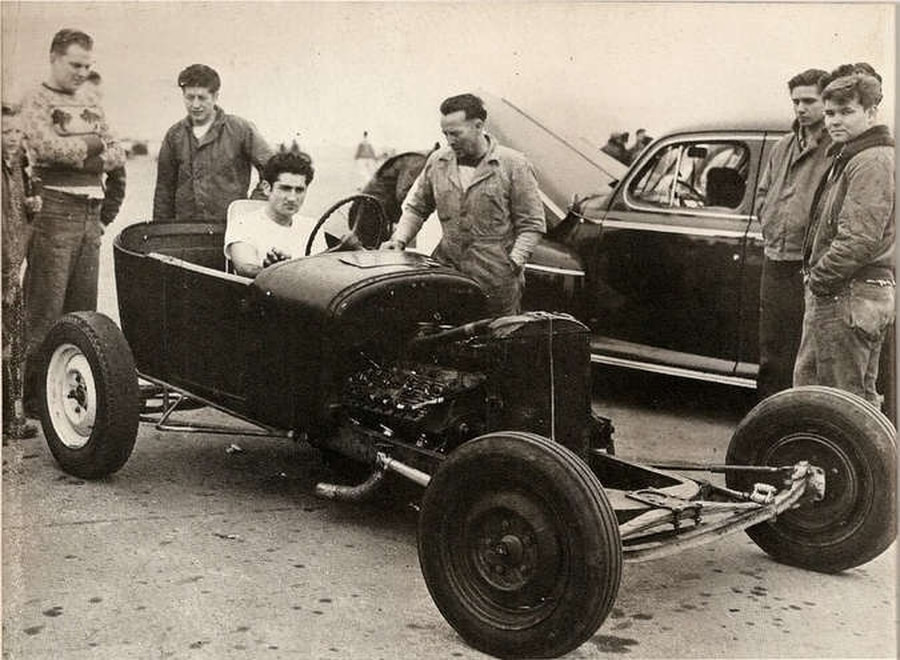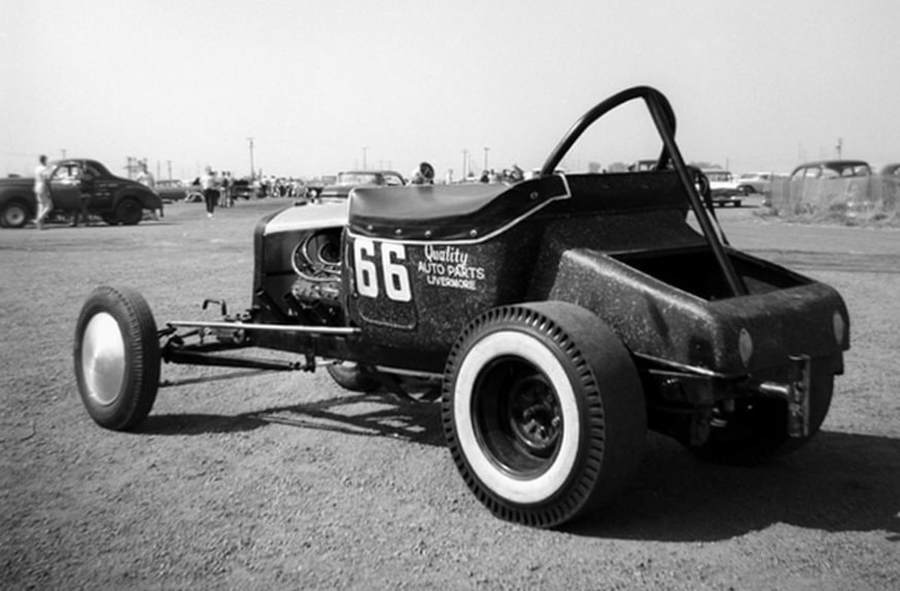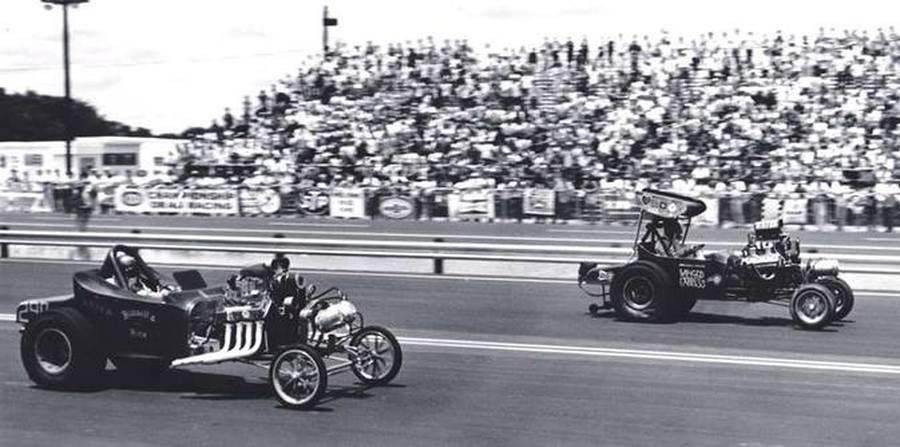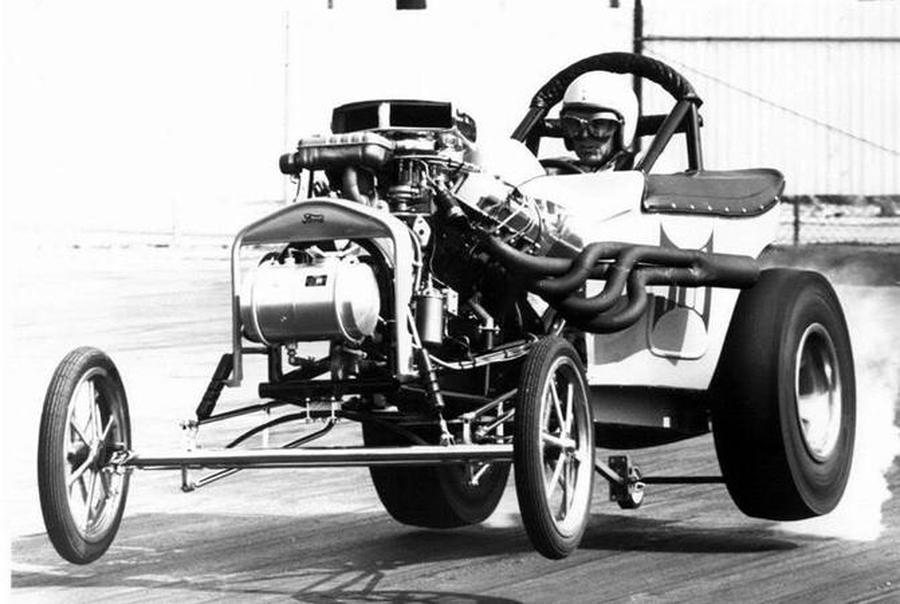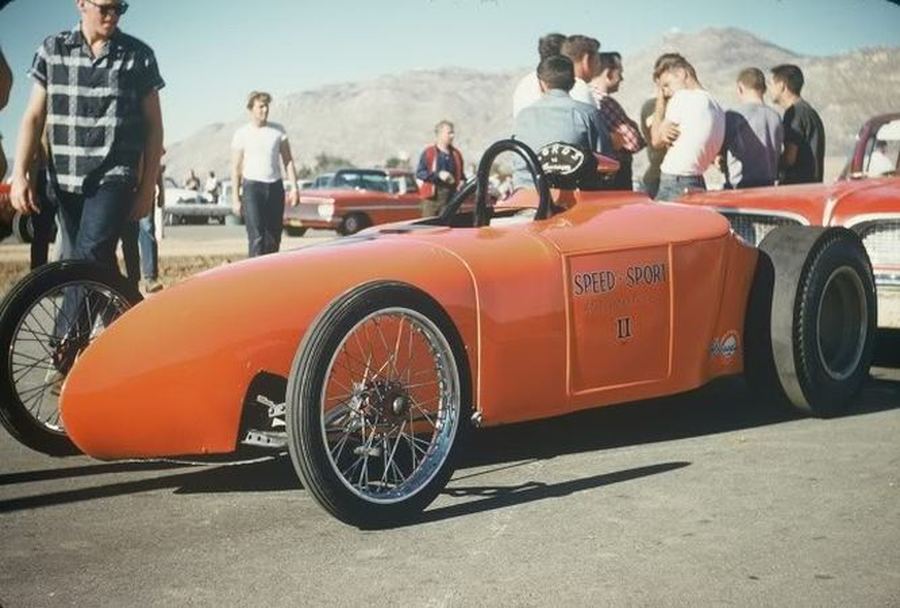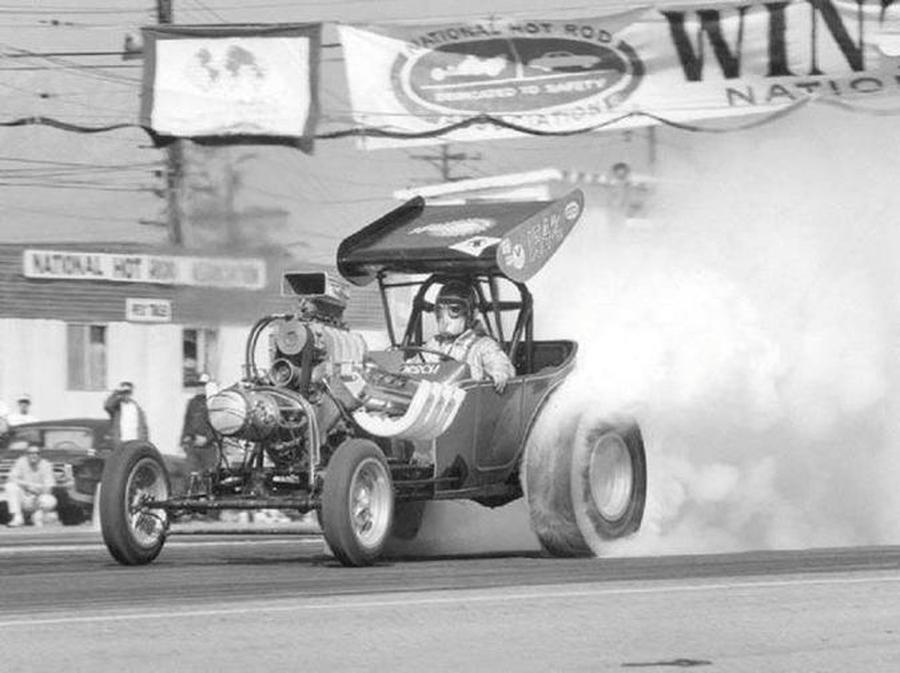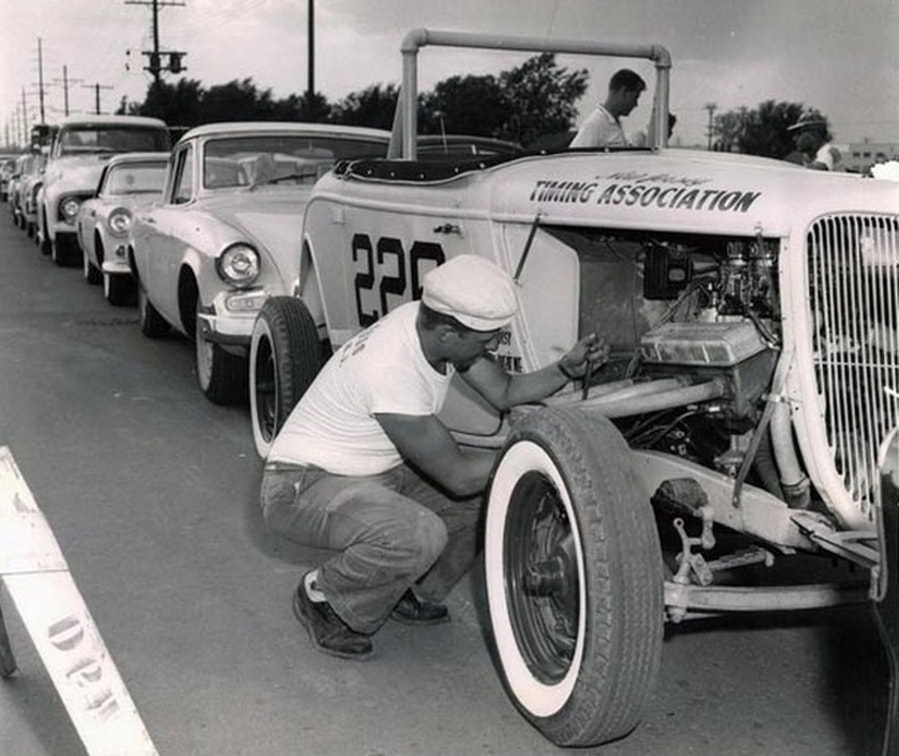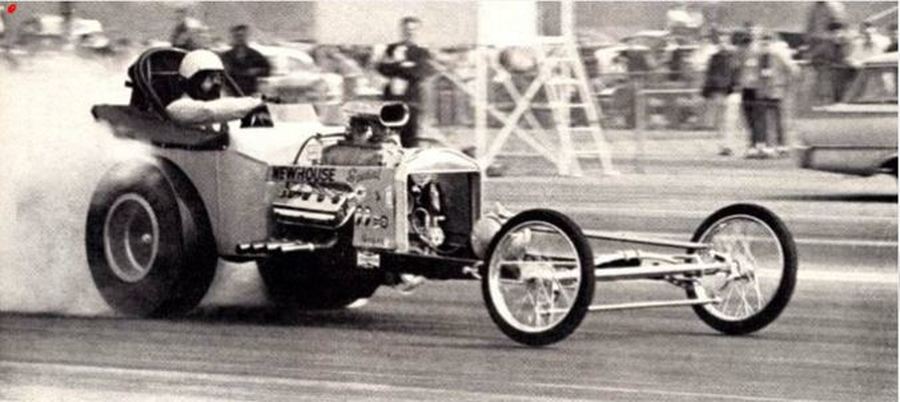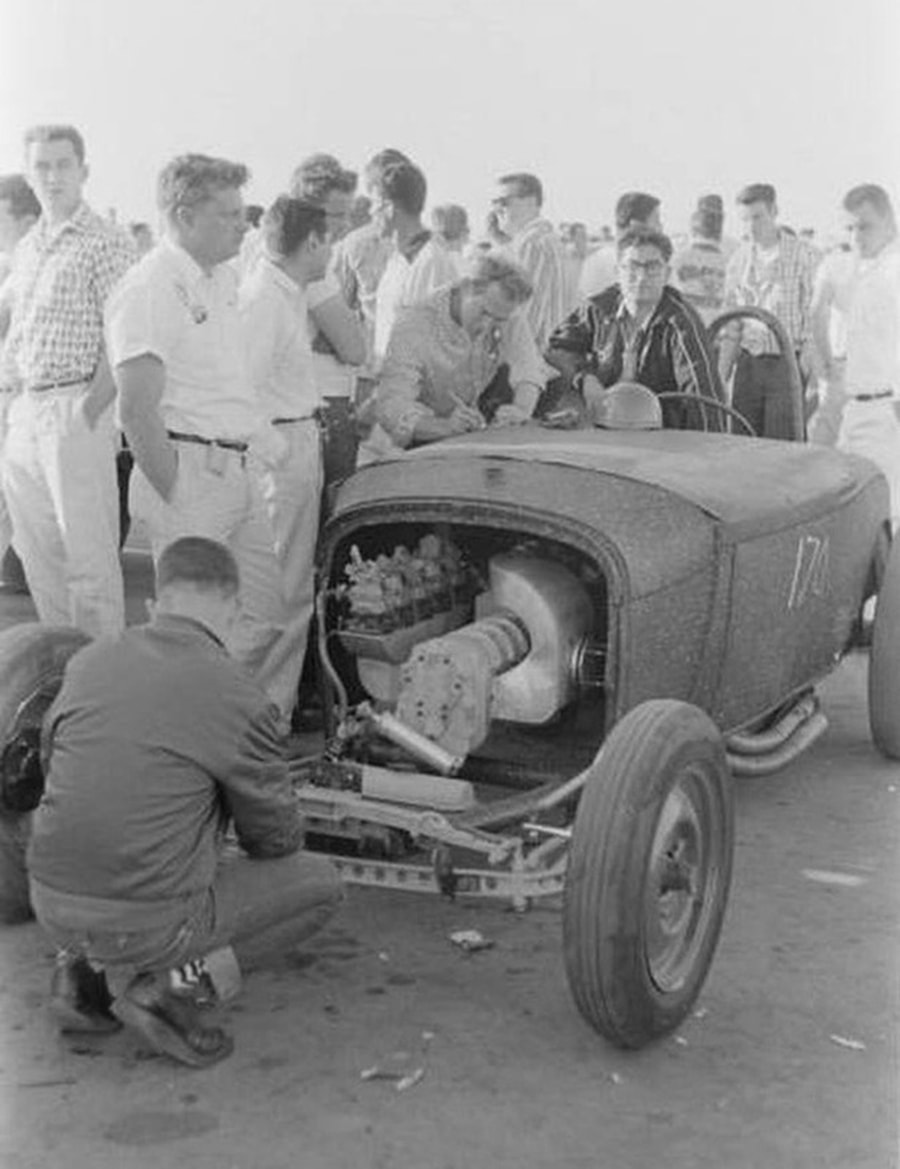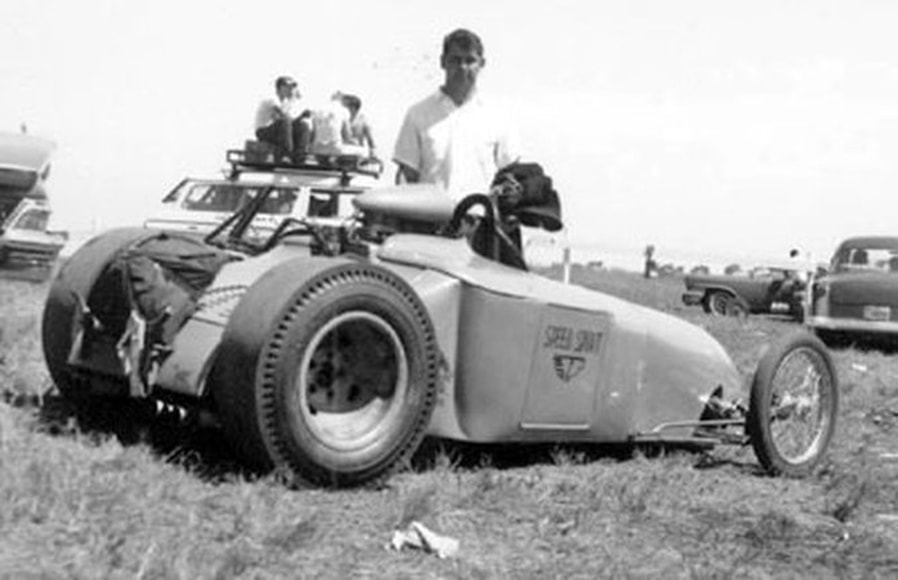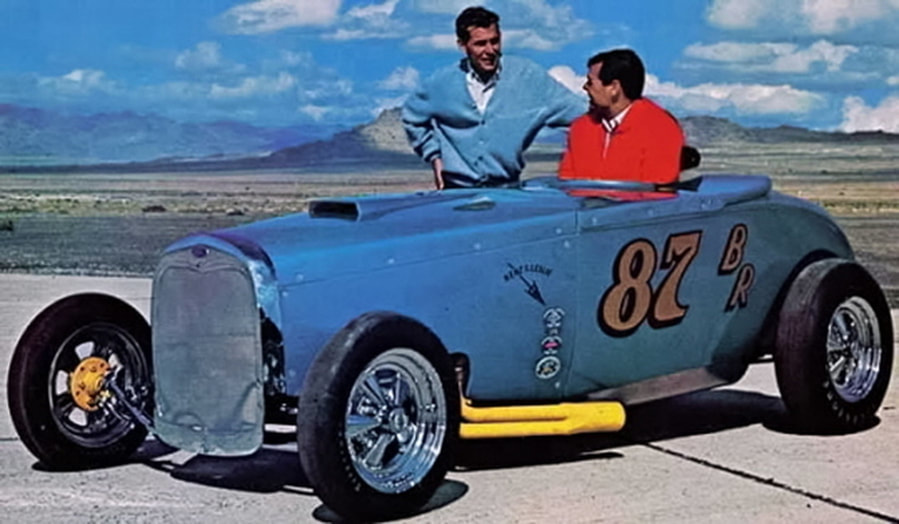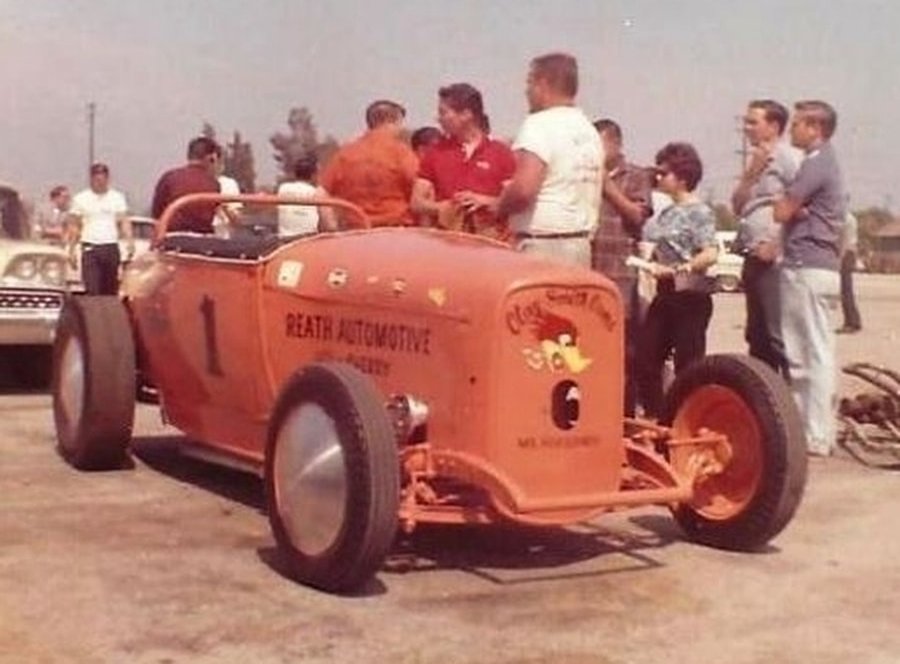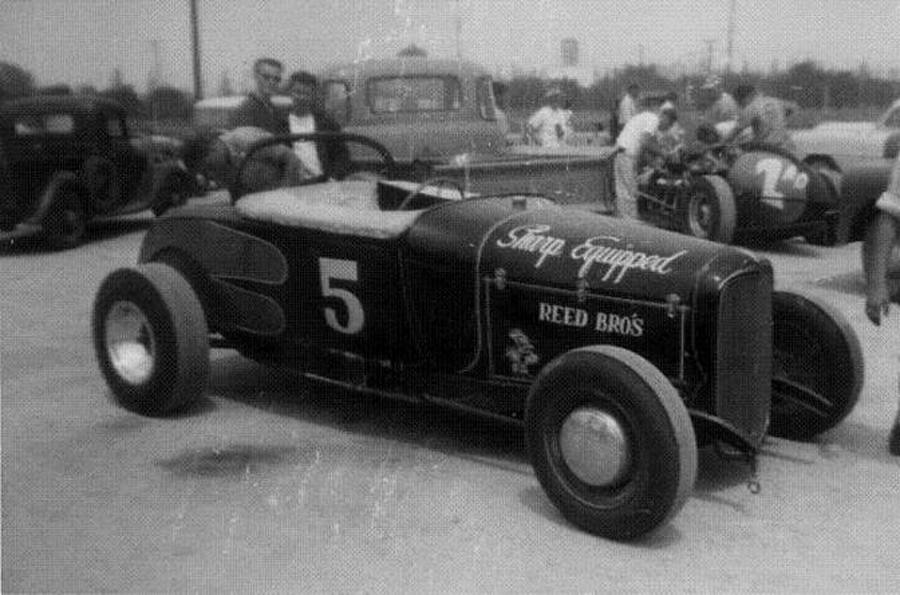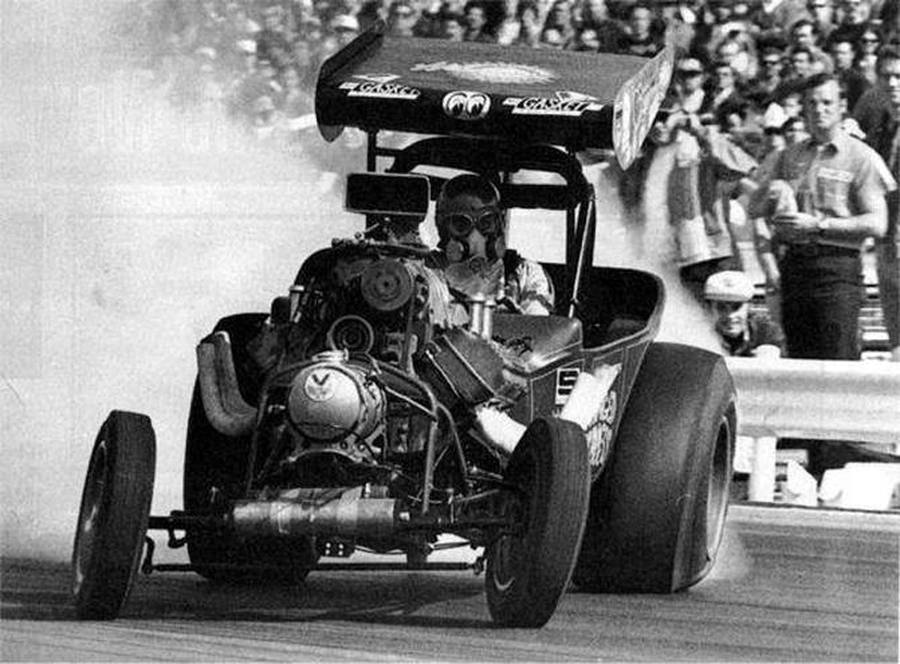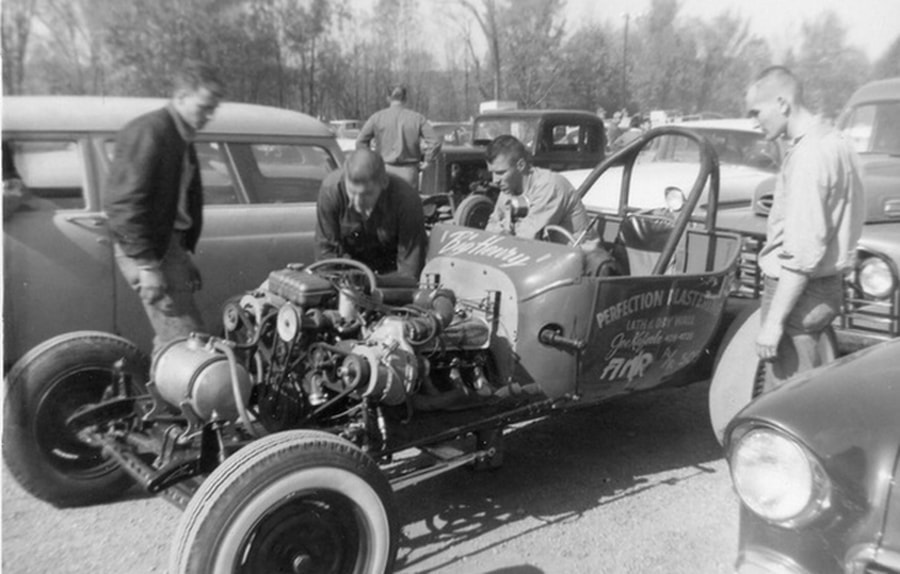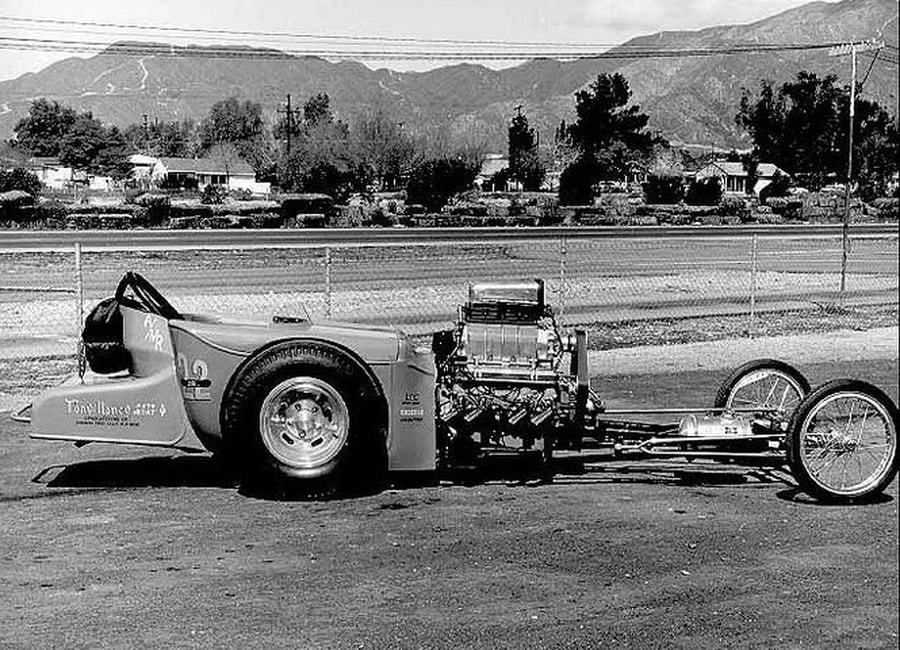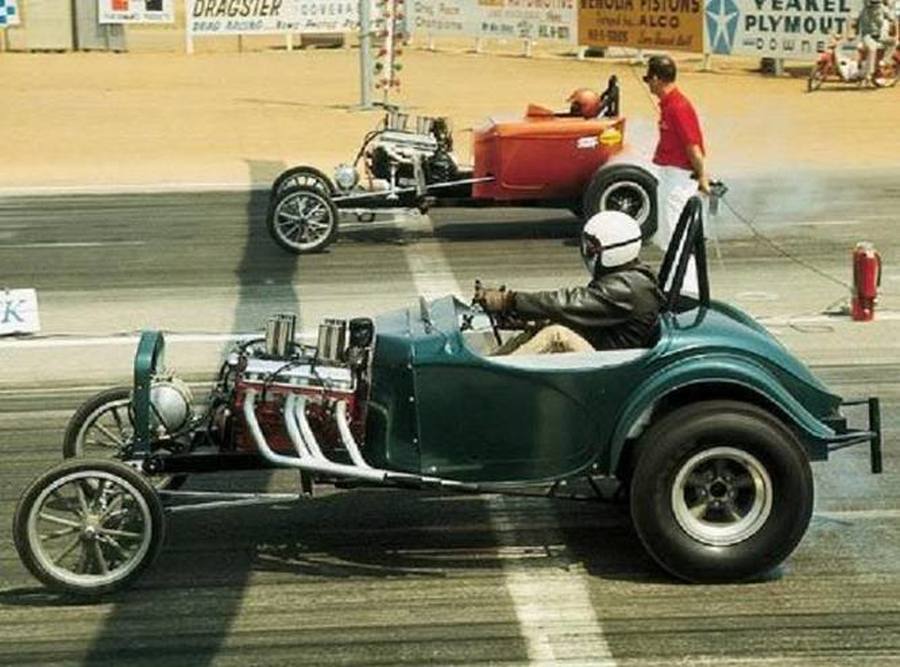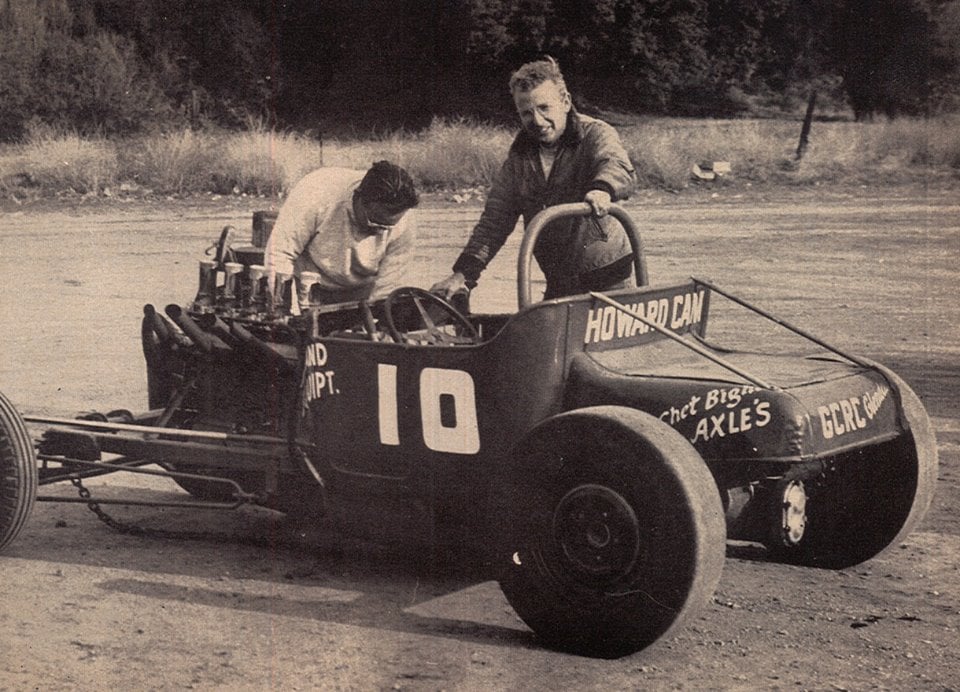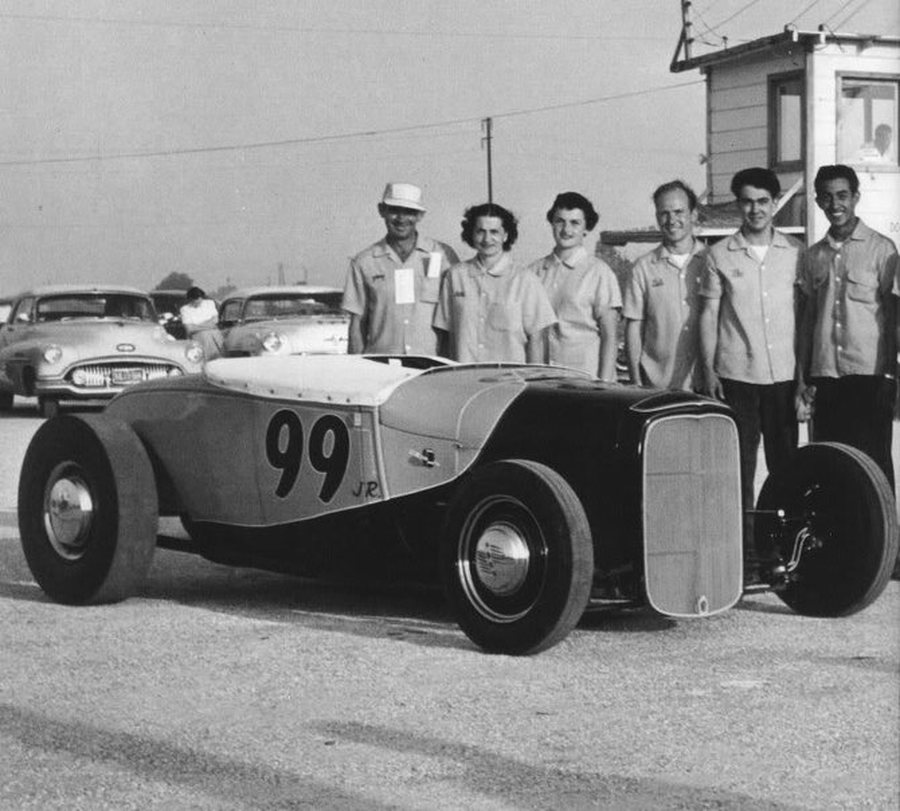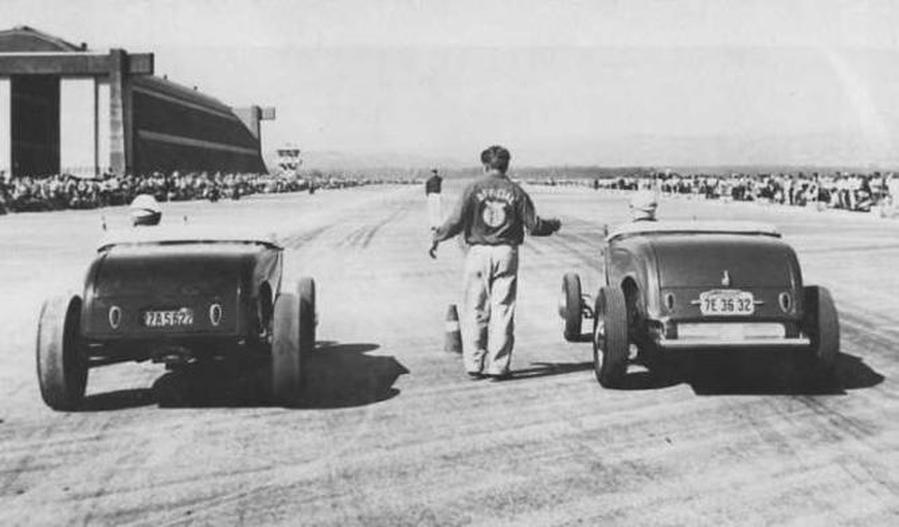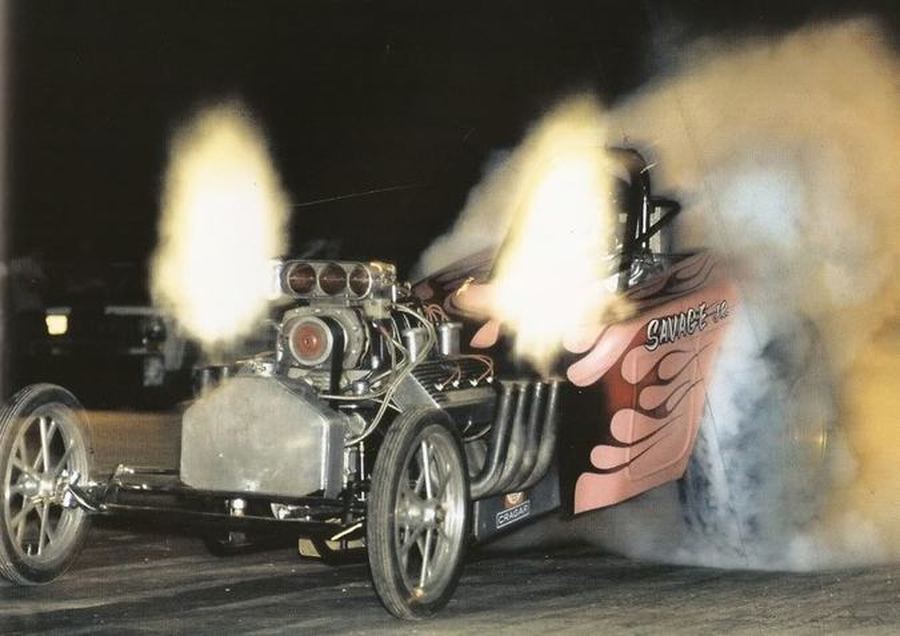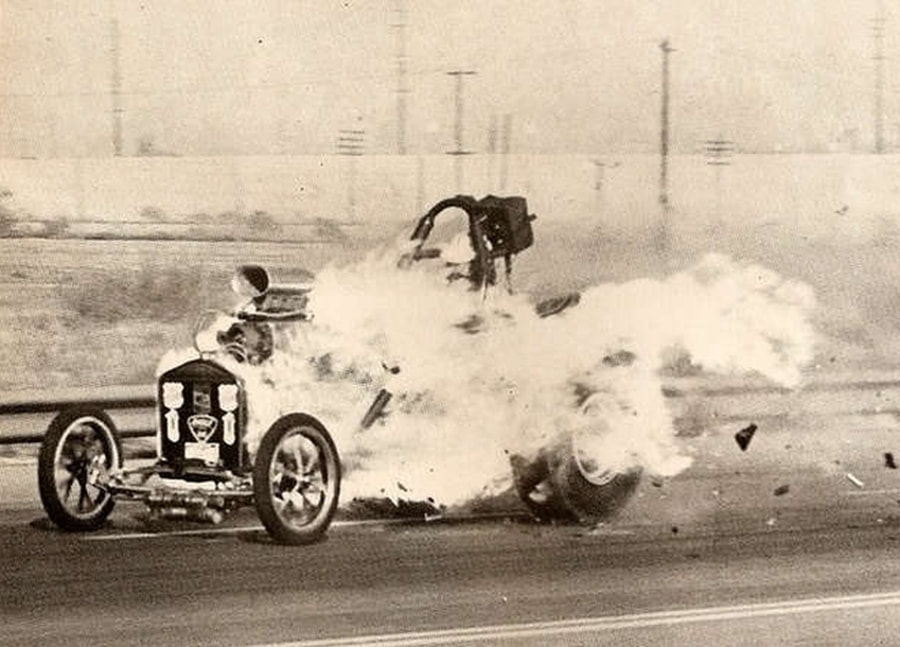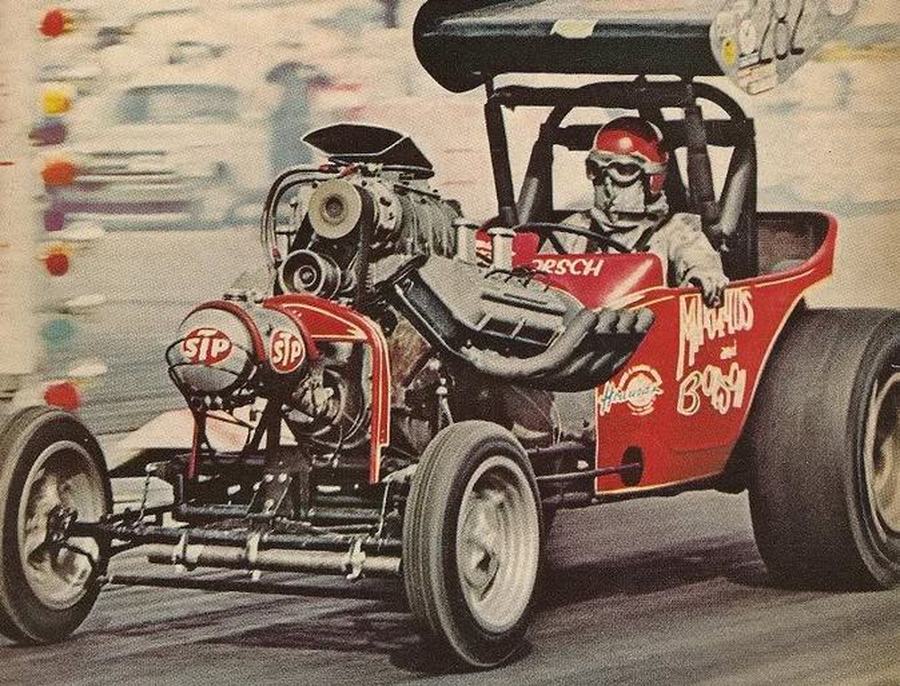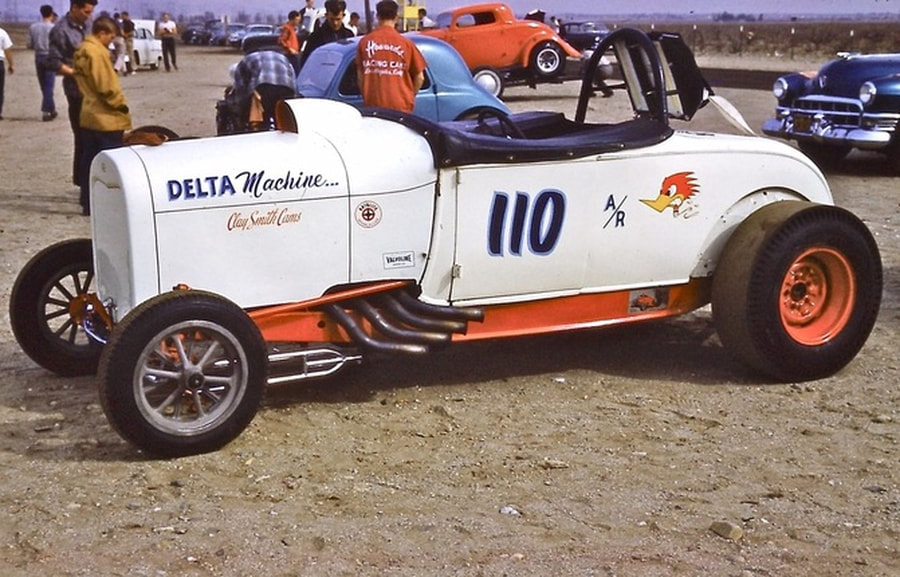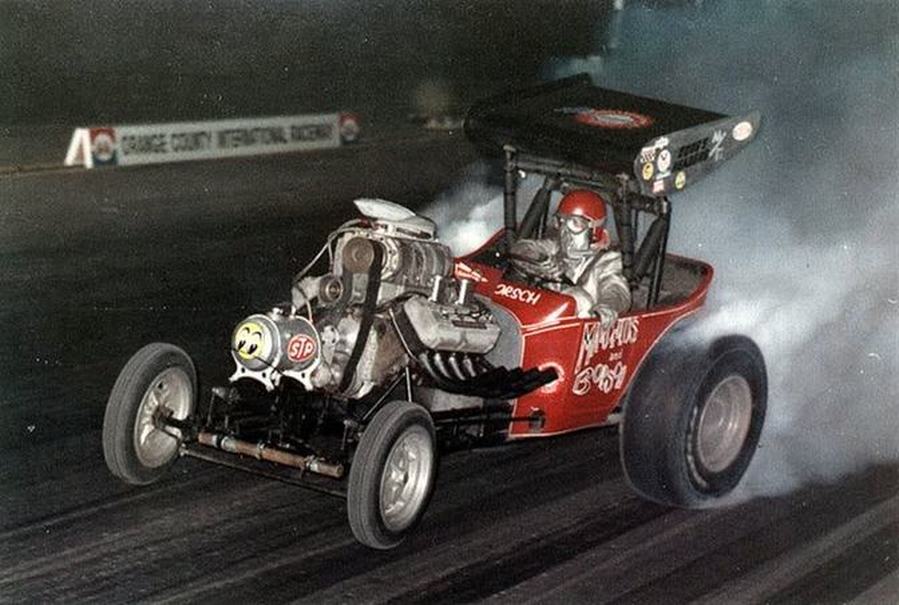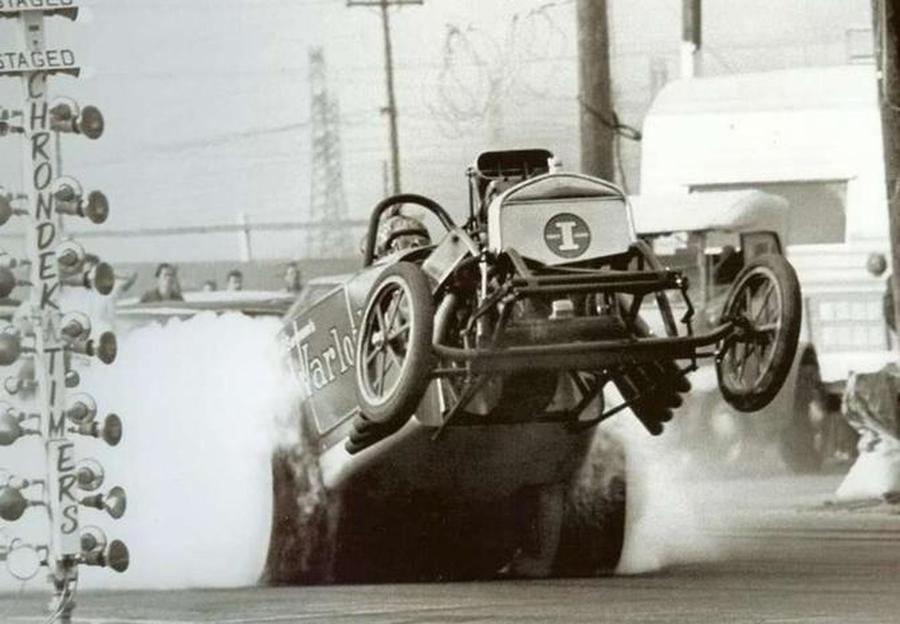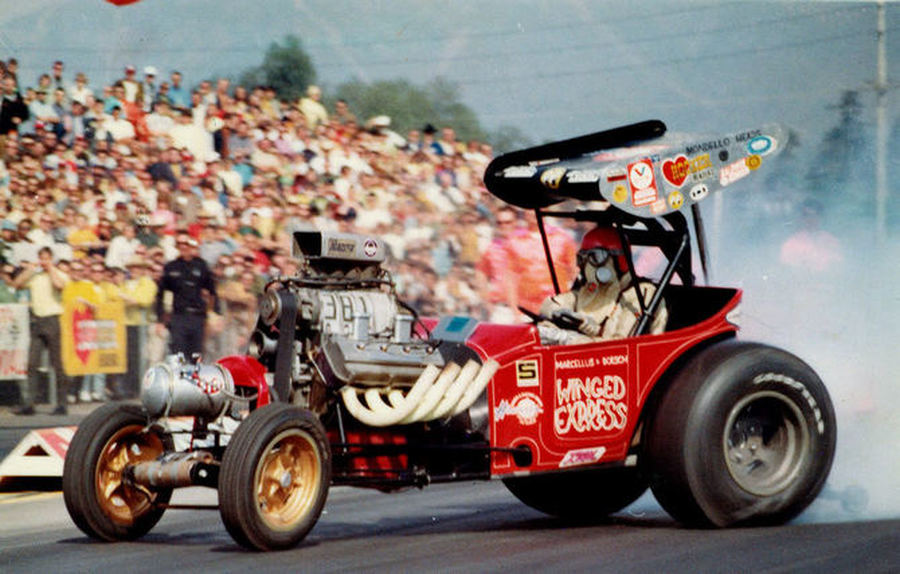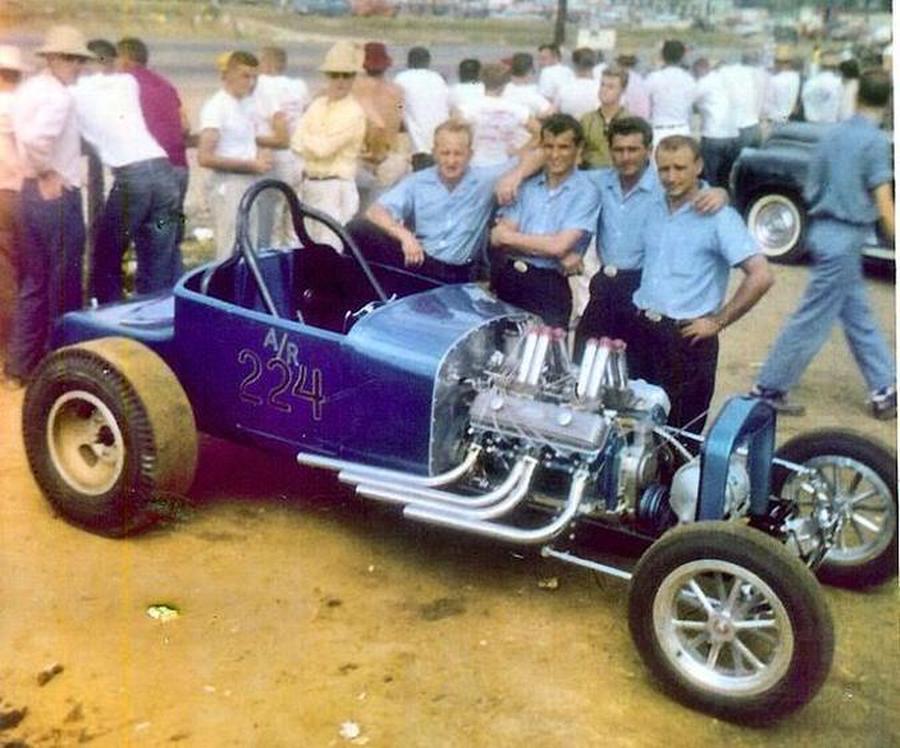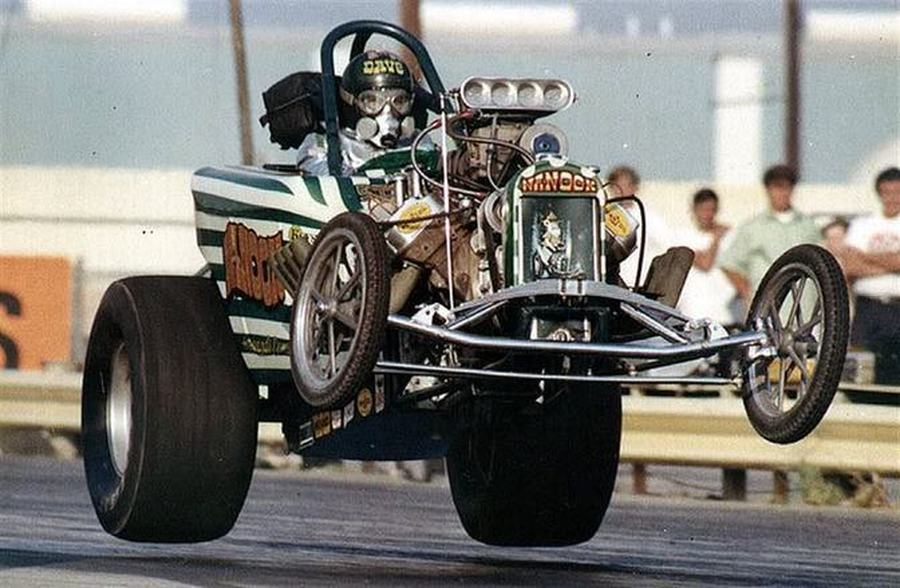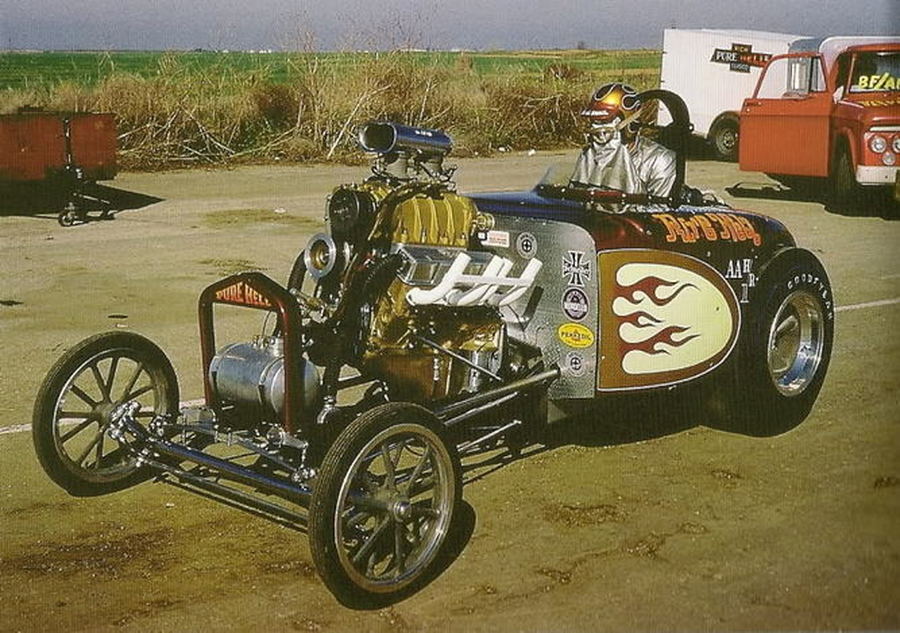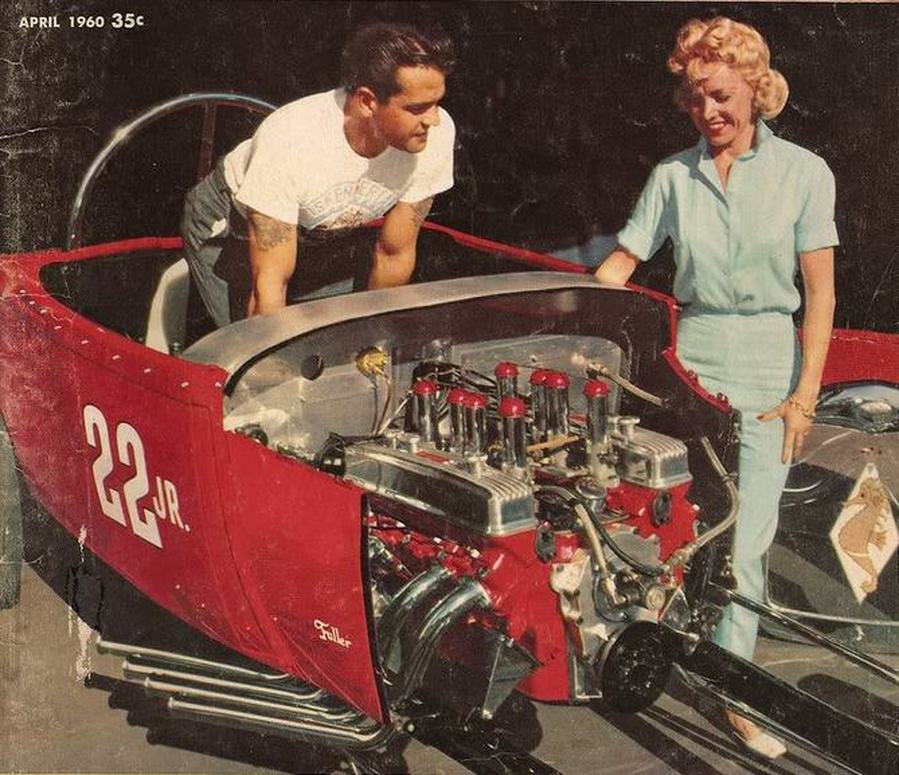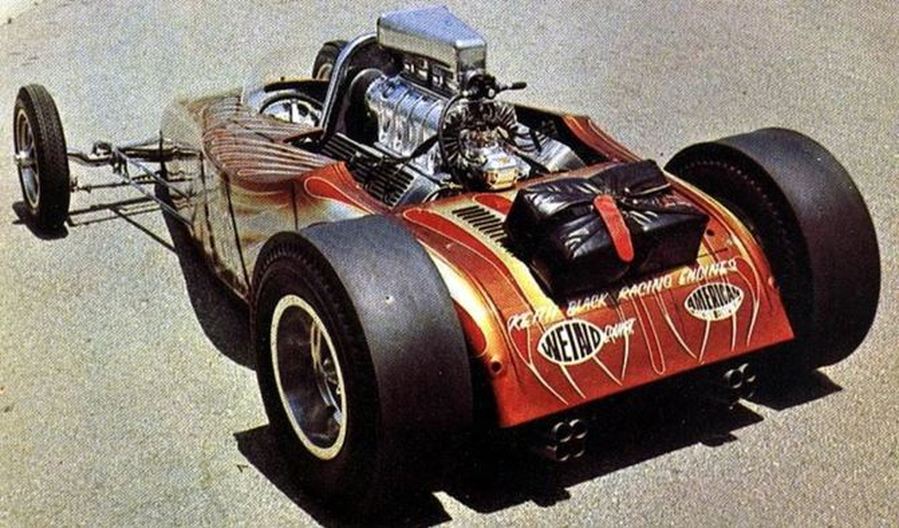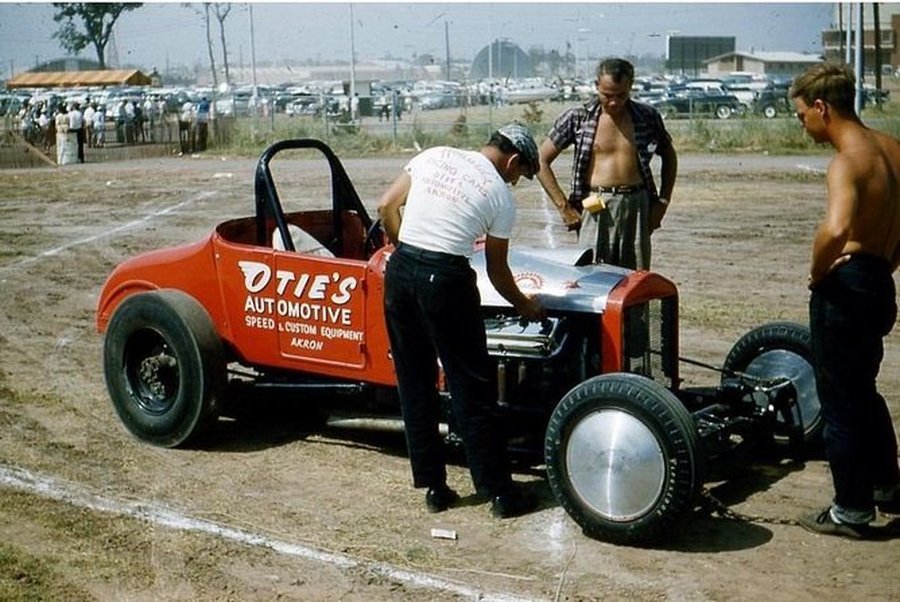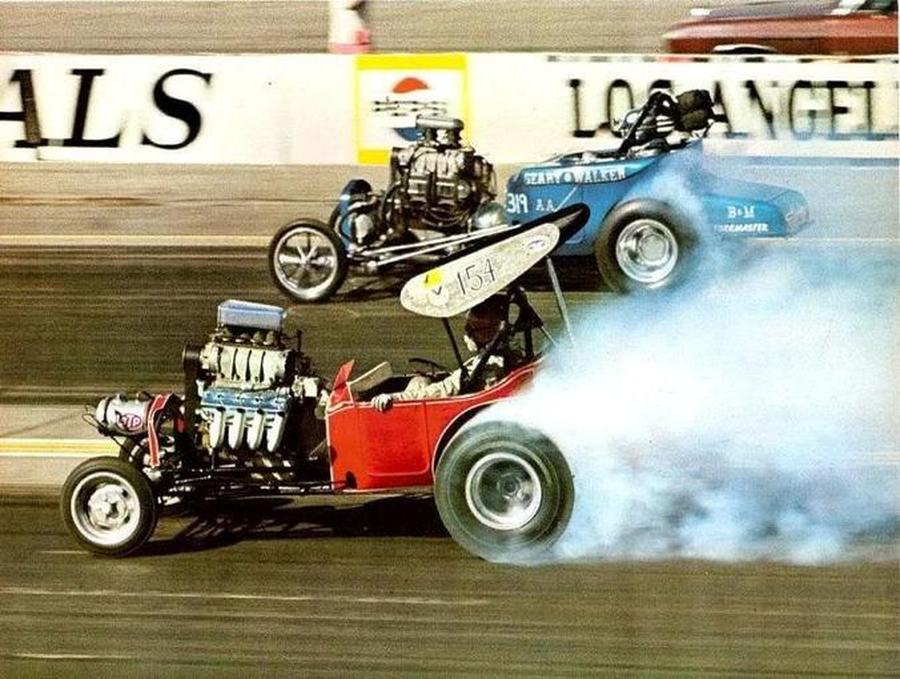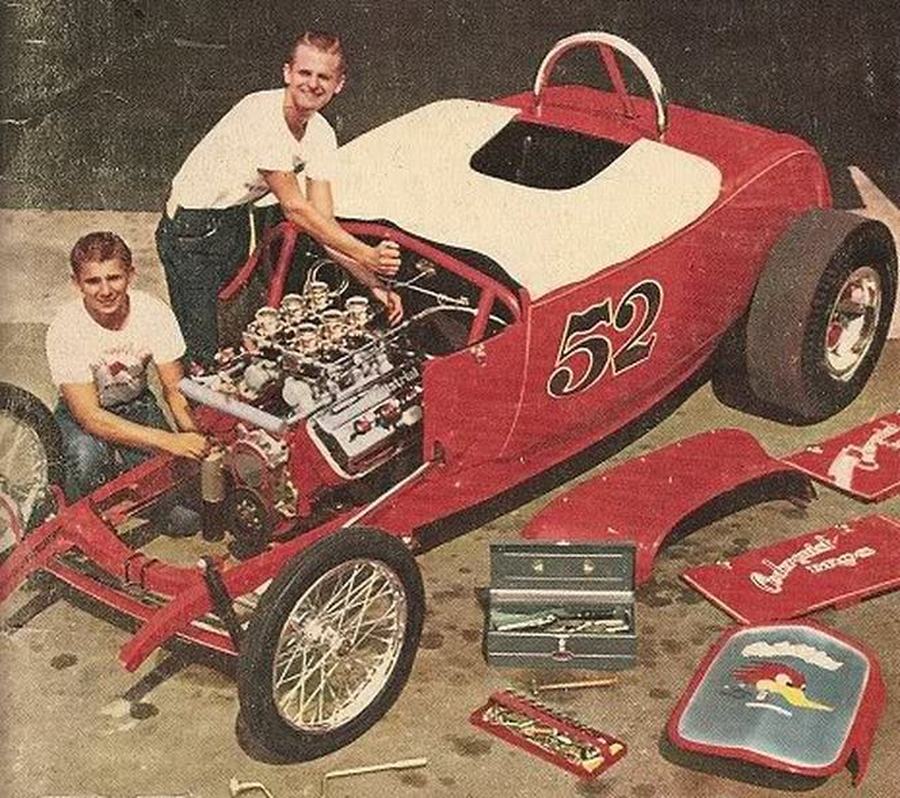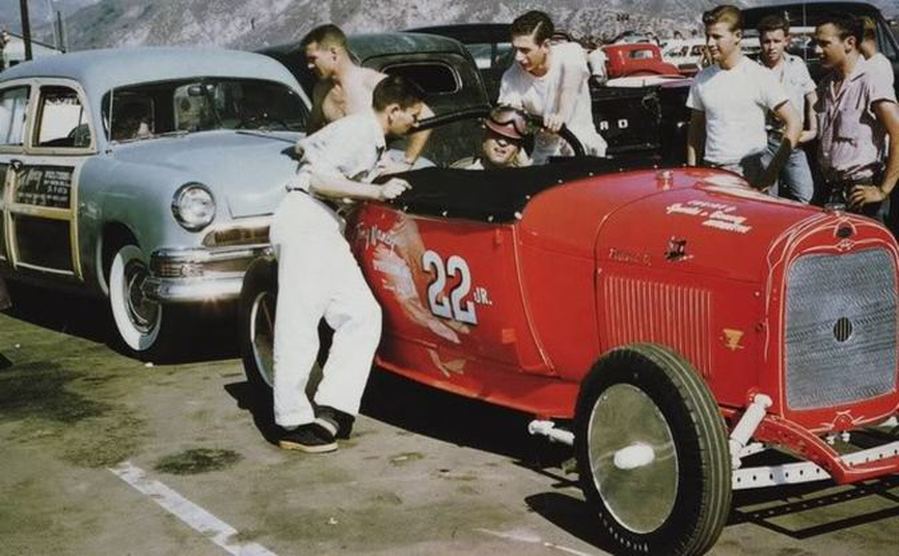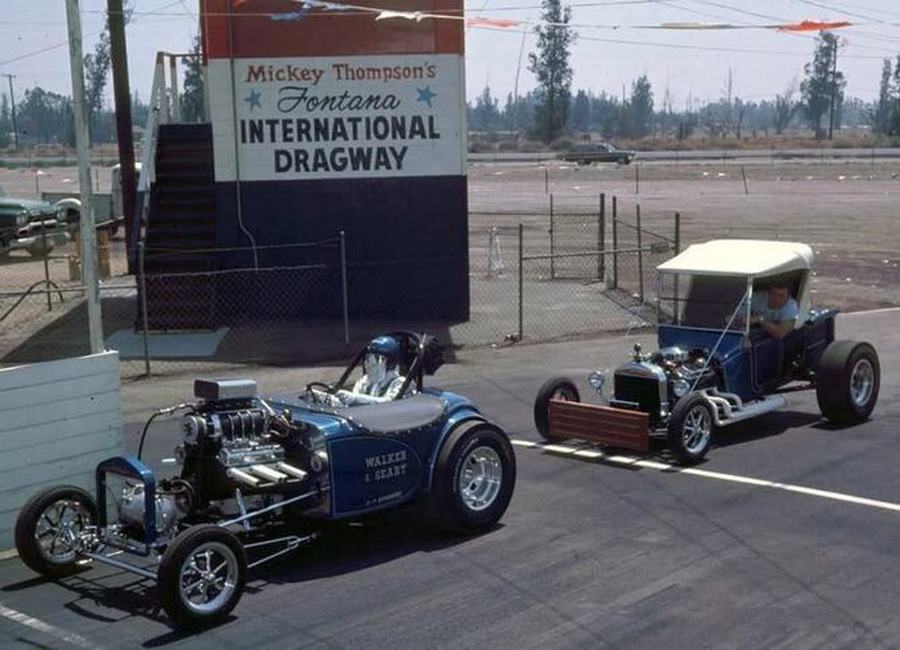ROADSTERS & MODIFIED ROADSTERS
While technically a part of the "Altered Family", the biggest difference between the Altered Coupes/Sedans and Competition Coupes/Sedans classes is that the Roadster and Modified Roadster classes were "topless" (a magical word for us guys, but I digress).
While the Roadster classes had something in common with the Street Roadster classes, there was nothing "streetable" about most of them. Fenderless, no headlights, more engine set-back, nothing to confuse the drag race fans as to what these cars were all about. And, nitro fuel was permitted in some of the classes. There was even less confusion regarding what the Modified Roadsters were all about. Basically they could be considered as a dragster chassis with a roadster body installed. You can consider many of these cars as topless Altereds.
And like the Altered classes, the Roadster and Modified Roadster classes were a catch-all category for any open top vehicle that did not fit into any other category.
While the Roadster classes had something in common with the Street Roadster classes, there was nothing "streetable" about most of them. Fenderless, no headlights, more engine set-back, nothing to confuse the drag race fans as to what these cars were all about. And, nitro fuel was permitted in some of the classes. There was even less confusion regarding what the Modified Roadsters were all about. Basically they could be considered as a dragster chassis with a roadster body installed. You can consider many of these cars as topless Altereds.
And like the Altered classes, the Roadster and Modified Roadster classes were a catch-all category for any open top vehicle that did not fit into any other category.
A great Roadster from the Lone Star State (I think)...
A Modified Roadster, with a plastic Model-T body, and a hefty supercharged Olds engine...
This photo can represent the typical "Roadster" around the nation. A Small Block Chevy engine with 3-carbs. I'm sure it was a street driven Hot Rod at one time. There were thousands of rods like this "back in the day". All you had to do was to remove the fenders, remove the running boards, headlights, and windshield and you had a very neat drag car, all at little or no expense. I'm sure it ran on gasoline....
I feel for this guy. You can build a drag car or maintain a wife. I always had trouble trying to do both...
Another Altered Roadster, this one using a 429-cubic inch injected Ford engine...
When I started this site (10 years a go in 2013) , I had an Altered Section. I put all the Altered's in the same Section. But some folks asked me to put the open Altereds n their own Section. Altered's come in all forms, cars with no roofs, and open cars like the one above. Cars with no roofs are called "Roadsters", so I took all the Roadsters and put them into this Section...
Nothing wild here, just a superlight D/Altered Roadster. Note the ultralight chassis tubing and fiberglass replica Model-T body. Engine of course is a Flathead Ford...
Another Fuel Altered with a mind of it's own...
Here is one that might make you scratch your head in wonderment. I can't tell if the body is from a Model-A or a Model-T or something else. It is definately a Modified Altered Roadster, no question about that. The engine, which is sitting in the driver's compartment, is a Buick Nailhead, with what looks like a single 4-brl. carb. The driver sits in front of the engine, with his legs in what used to be the engine compartment. It's not pretty, I will grant you that, but the roll bar looks to be okay...
An interesting Roadster, looks to be half Model-T and half Buick Straight-8. Jim Pinker, Ken Hickman, and Rick Steele, three teenagers from Oregon built this D/Altered Roadster. The Buick Straight-8's started life with 321 cubic inches, and has been bored out to 343 cubic inches...
Nothing big jumps out at me in looking at this photo, but there are a lot of little things that do. It's a pretty straight forward roadster with a Ford flathead engine (with 4 carbs). The car is very neat, and stands out with the blue paint. I like the idea that he painted the front suspension, fuel tank and wheels (inside and outside) the same color as the body. Looks great and less costly than chrome plating everything. And then there is the grass. Not many pits had grass, and even if the grass looks like it needs to be watered more, it's much better than blacktop in my opinion. Finally, the guy with his back to the camera and cuffs on his Levi's. When I was in High School I had cuffs on my jeans, too. A lot of guys did back then, it was a fad at the time. Ah, to be young again...
Keeping it simple. A frame from a 1932 Ford, a body from a 1929 Model A, and a Chrysler Hemi (from a Chrysler). The non-supercharged engine is set-back 25% of the wheelbase. One of the better roll bars installed on this roadster...
Nothing fancy here, just a straight-up supercharged Chrysler powered Roadster. The body is a fiberglass Model-T replica. Disregard the weeds in the pits, at least the track is fully paved, unlike so many tracks in the 1950's. The track is Caddo Mills, in Texas and the photo is from 1959...
Dave Miller's streamlined, flathead powered, Roadster, running at the "Old San Gabriel" Drag strip, which was open from 1956 until 1958. I wonder what Dave was looking at?
(Photo by Bob Gunnet).
(Photo by Bob Gunnet).
SoCal local, Holly Hedrich in his rear-engine Modified Roadster...
Even as a little kid, I was interested in cars, especially race cars. In High School, I hung out with other kids that had cars. We formed a club (I can't remember what we named the club), but we would get together and talk about cars. In the 1950's, hot rod clubs were a big thing. If someone in the club had a race car, everyone would pitch in to work on the car (including throwing some cash in the pot). This nifty Altered Roadster is part of every guy in the club. The engine is a GMC Straight-6, with a Wayne 12-port cylinder head, featuring Hilborn fuel injection...
Would someone please dial 911?
This has to be a class act going down the highway. Moon disks on the truck, trailer and the B/Roadster, and white wall tires all around. In my opinion, louvers were always cool on a hot rod. In the case of the louvers on the rear deck of this Roadster, they will allow any air caught inside the body to escape. Of course, the owner of this roadster could have just drilled a bunch of holes in the rear deck with a hole saw and save a lot of money, but he obviously had more class than that...
Some interesting stuff on this Roadster. A full tube frame for one, and it looks as if the driver turned the roll bar into a roll cage. Pretty much ahead of it's time...
One of the neat things about the Altered class is that almost anything can run in the class. The difference between an Altered coup or sedan and a roadster is that the roadsters had no top. This 1957 Thunderbird is running as a C/Altered class as a Roadster. It may also have been eligible to run in the Modified Sports Car class, I don't know...
As close to jewelry as you will ever find, considering it's an all out race car. I could study this photo for hours and not get bored. A Model-T body and a Ford Flathead engine with a set of overhead valve Ardun cylinder heads, and fuel injection.
What has to be one of the most beautiful drag roadsters ever built, and it would not be fare to show you only the front view. Charlie Scott, the owner of Scotty's Muffler Service, went the extra mile on the exhaust system on this car, and it looks like he picked up some sponsorship along the way...
I had to look at this photo for several minutes before I realized that the engine was mounted where the driver would normally be, and the drivers seat is mounted just behind the trunk. Also note that the rear end housing has been considerably narrowed. This Modified Roadster was run by Charles Kleckner, Great Neck, Long Island New York... (Photo by Greg Ward)
As slick as they come, this 1929 Model-A Roadster, originally built and driven by Art Chrisman. At some point along the way, the car was sold, possibly to the Lowe Brothers, from Atlanta, GA. Something about this photo makes me think it was taken at a track in Texas. The only hats I see are cowboy hats...
I can't tell for sure if this fuel burning Altered Roadster is doing a burnout or just leaving the starting line on a run. One thing for sure, the photo shows what happens when an engine with a couple of thousand nitromethane fueled horsepower lights up the drag slicks. It was not unusal for these AA/FA class drag cars to have that cloud of tire smoke follow them all the way down the track. The moment of truth comes when the tires start to hook up to the track. It's at that point when the 100-inch wheelbase Roadster decides if it wants to keep going straight, or makes a turn to the left or the right. This is a decision that the driver cannot make, only the Roadster can make that decision, and it rarely notifies the driver in advance...
Cars like this Altered Roadster were not very complicated. You build a super high horsepower supercharged engine (a Big Block Chevy in this case) and get a body that is light enough to hang on one of the branches of your Christmas Tree, and stand back. WAY back. Roadsters like this one are like wild animals, they are just standing there in the pits and so you wander over to have a better look-see. They have been known to see how close you are willing to get, and then, SNAP, they turn around and eat you, and spit out the bones...
A nice roadster with a Model-T body and an injected Chevy engine. Note the stout looking roll bar. It's fashioned out of square tubing. It's much easier to weld up a roll bar at home out of square tubing for a racer that builds his car in his own garage. On the other hand, even though the roll bar is plenty strong, the sharp corners at the top can be a major issue if the car gets sideways and rolls over. The sharp corners had a tenancy to "dig in" and cause the car to barrel roll down the track...
Before the light weight plastic body Altereds became all the rage, these all factory steel 1929 Ford Model-A's were where it was at. Clean as a whistle, eh what?
Not too much different from the Roadster pictured above this photo. Looks like another Model-A, maybe a 1930 or 1931. Both this Roadster and the one above have grille shells from 1932 Fords instead of the original A-Bone radiator shell...
A couple of Roadsters having a "go". This "drag strip" looks more like an airport landing strip than an actual drag strip, look how wide it is. The white Roadster is a 1932 Ford. I don't know anything about it other than what I see in the photo. I see that it has a license plate but I'm pretty sure it's not a street driven hot rod, although it probably was once. Many states required that flat-towing a vehicle (using a bumper hitch) had to be licensed, just as you have to have a license plate when towing a trailer. As far as the rear tail lights, they were most likely hooked up to the tow vehicle when being pulled on the highway, where brake lights are required, just as they are with a trailer. I see that both Roadsters were equipped with Quick-Change rear ends. It also see that car number 19 was sponsored at one time by a Body Shop, but it looks like the deal fell though, as the name of the body shop has been taped over. Finally, both cars were equipped with roll bars. The roll bar on the red Roadster in the other lane is not quite high enough to be very effective in the event of a roll over. Let's just say that the bottom half of his head might be saved, but not much above his ears...
Clean, neat, and to the point. A fuel burning supercharged Oldsmobile engine and Bantam Roadster body...
I look at this photo and all I can say is WOW! And note the eight carbs...
A simple description of a ROADSTER is that it has no top. A simple description of a MODIFIED ROADSTER is that it has no top and it looks nothing like it did when it originally came from the factory. This then is a Modified Roadster. The body (the part behind the engine) is either from a 1927 Ford Model T or an exact duplicate made out of fiberglass. The nose section is entirely custom, and most likely fashioned from aluminum. The engine is an Oldsmobile, running a 6-71 supercharger with a 4-hole Hilborn injection system mounted on top. Note the size of the parachute pack attached to the roll bar. "Back in the day", custom designed drag 'chutes did not exist, and racers had to pick up surplus military style parachutes from Army-Navy stores...
To understand the evolution of drag racing, you have to follow the bouncing ball. In Southern California, it started on the street. Guys returning from WWII built hot rods, and like every other red-blooded American kid, they raced around on the streets. Street racing, although it was fun, it had it's limitations. Many of the hot rods were really fast cars and they needed some kind of a race track to really put their cars to the test. The dry lake beds in SoCal had been in use for race meets since 1938 and got more and more popular, but really took off right after the war ended. By 1946, hundreds of hot rods were showing up at the dry lakes to run their cars. In 1948, a car club in Santa Barbara decided to put on a drag race at the Goleta Airport. This "event", which was not actually held on a taxiway at the airport, but on a side road on the airport property, became known as the first sanctioned drag race, sanctioned by the Santa Barbara Acceleration Association. Several events were conducted at the Goleta Airport in 1948 and 1949. Since drag racing was new, most of the entries were either hot rod street machines or dry lakes race cars, such as this beautiful 1928 or '29 Model-A Roadster, owned by Bob Joenck, from Santa Barbara. At the dry lakes, you could run your car to see how fast it was, but at a drag race, you could actually race against another car, like you used to do on the street, and without worrying about getting a traffic ticket. According to hot rod historian, drag racer, and all around good guy, David Sorenson, Bob Joenck still has a shop in Santa Barbara. David posts information and photos on a Facebook page, "Pre-55 Period Correct Hot Rods", a page I visit every day to see what David has posted (and to steal photos like the one above for this website)...
The Thomas & Pritchard Fuel Altered lights up the slicks coming off the starting line in the "Beaver Hunter" Roadster, at Lions Drag Strip...
Leland Kolb and his 1927 Ford Roadster "Wiz Bang"...
An early Ford Roadster, blown Chrysler powered, and it features a tubular frame, which was somewhat rare for that period...
A 1927 Model-T Modified Roadster. It looks like the original "dog sled" style roll bar has been augmented with a taller one...
Probably not the first Roadster with a "back seat" driver. Charles Kleckner out of Great Neck, NY and his Lyndwood Eliminator chassis Roadster. It's not just that the driver is sitting in the trunk, it looks like the entire rear of the body has been extended rearwords a couple of feet. What makes this car truly unique is that it's probably one of the first Roadsters with a narrowed rear end. This roadster ran in the B/Modified class and won that class at the NHRA Nationals in Oklahoma City, setting a record of 113.49 MPH...
As vicious a looking Fuel Altered Roadster as you will ever see. Fielded by "The Mob", which was made up by Moore, Oates & Bradley. Although I can't see his face, the driver standing on the floorboard may be long time shoe, Ed Moore...
An unusual presentation of a Modified Roadster running at the Smokers "Fuel & Gas Championship" (sometimes known as the "March Meet") in Bakersfield, CA, in 1958. The body is a Bantam roadster, and the engine is a Ford (or Mercury) with ARDUN cylinder heads. Photo Credit to John Moore...
A slick Modified Roadster with a "W" series Chevy engine (348 cubic inches I'm led to believe). The supercharger helps of course. The body is most likely a fiberglass replica of a Model-T. Like the Competition Coupes, the Modified Roadsters are long gone from NHRA competition at National Meets...
A Bantam bodied Modified Roadster, powered by a mostly stock Chevy 409 engine...
Powered by a Buick Straight-8 engine. You don't see that combination very often. From 1931 up until 1953, the Buick Straight-8's were known as a powerful and rugged engine. At one point during that period, they even offered dual carbs from the factory (I believe that was in 1940). Anyway, these were big displacement engines, up to 320 and even 345 cubic inches. This one features 6 carbs...
Pete Ogden, a well known racer from the San Francisco Bay area, in Romeo Palamides' DeSoto powered, fuel burning roadster, probably at Kingdon drag strip in the late 1950's... (photo and info sent to me by Denny Forsberg)
Not all the fuel burning Altereds ran in the AA/FA class. The John Middleton & Chet Norris injected Chevy Bantam held the 1320 C/Fuel Altered ET and MPH record in 1961... (photo and info sent to me by Denny Forsberg)
Under normal circumstances, this would be cause for alarm. A fuel burning Altered Roadster, with one rear tire two feet off the ground and the other one barely touching. But there is nothing normal about this car or this driver. Wild Willie Borsch is at the controls of the "Winged Express", which means that somehow he will get this beast to the other end of the track, probably without lifting his foot off the throttle...
A slam-bam spiffy Model-T roadster. Note the center steering location. Some nice tin work on this car, with the custom nose piece and the neat hood bubble. The Norton & Marion roadster, from Oregon, in 1955...
Roadsters at Santa Ana Drag Strip. Opened in 1950 and closed in 1959. Things were a little different back then. Spectator safety consisted of old telephone poles laying on the ground, with people standing behind them. I turned 16 years old in 1955 and this drag strip was my first experience driving my car down the quarter mile. Today, this is John Wayne Airport in Orange County, CA...
When you can't get the engine back closer to the rear end, you move the rear end closer to the engine. I believe the engine on this all steel Model-A Roadster is an Oldsmobile. This photo was taken at the Pomona Drag Strip...
Nicholson's Speed Shop sponsored Bantam roadster. I'm pretty sure it was powered by either a straight-6 Chevy or GMC engine. The tall guy on the left is Don Nicholson, long before he became "Dyno Don", and the guy bending over the engine to his right would be his older brother (by four years), Harold Nicholson. Harold drove the car, and died in it in 1959, when a front wheel broke off and the roadster flipped several times. Harold was only 35 years old. Don went on to fame as a Super Stock, Factory Experimental, Match racer, Pro Stock pilot, etc. He raced everything, and his won/lost record was 90% wins. "Dyno Don" passed away at 78 years old in 2006, from Alzheimer's disease...
Not just another Hi-Boy roadster. Don Rackemann leaves the San Gabriel starting line in the Rackemann/Baney roadster. The car normally ran one of two Cadillac engines on fuel, one carbed and one injected, but it also ran Nick Arias' GMC. The roadster ran competitively at both the drags and the lakes, but has since disappeared. What a find it would be to discover it again, maybe complete with the upside-down Von Dutch-painted grille inset. Lou Baney was a very influential hot rodder and businessman. He was the founder and manager of the Saugus Drag Strip in SoCal, one of the very earliest drag strips in the area. He was one of the early presidents of the Speed Equipment Manufacturing Associations (SEMA). He owned several new car dealerships in the L.A. area. He owned several Top Fuel dragsters, including the famed red, white and blue SOHC Ford dragster driven by the Snake. A mover and a shaker, Lou Baney made things happen… (thank you David Sorenson)
Well, yes, it has been "modified". It was once a coupe and now it's a roadster, and it's all steel. No fiberglass body panels, no carbon fiber, no lightweight anything, other than some holes in the frame...
Other than drag races conducted on airport taxiways or actual runways, most early drag strips did not have paved pits. You pitted in the dirt, and sometimes in the weeds. Many younger drag racers would not even show up to race if they had to do that today. A nice little channelled Model-T bodied roadster...
Nothing very complicated about this Altered Roadster. Model-T body, stock type frame and a small block Chevy engine. Note the roll bar, with the 90-degree corners. These were eventually disallowed by NHRA. Back in the day, before drag strips had guard rails, if the car went off the track there was a good chance that it would turn over in the dirt. The sharp, pointed corners on roll bars built like the one above would dig into the dirt, causing the car to barrel-roll numerous times, making for some very ugly (and many times fatal) crashes...
A blown Hemi Chrysler mill in a Modified Roadster...
A photo snapped at exactly the right moment. The guys near the car are looking down, the driver is looking down, and the spectators are just looking. Looking at what? They are looking at all the pieces of cast iron that used to be the engine bouncing on the ground after the engine blew up. As Don Garlits once said, "Sometimes you eat the bear and sometimes the bear eats you."...
There's nothing really remarkable about his Roadster, other than the fact that it was once a 5-window Coupe. I wonder how many hack-saw blades it took to convert the coupe into a roadster?
Another Bantam bodied Roadster, like the one below, but this one runs in the Modified Roadster class. Injected hemi Chrysler for power...
This Bantam AA/Fuel Altered Roadster, Don Green's "Rat Trap", coming to life on the starting line. I do not know who the photographer was but I can pretty much assume that he could feel the heat from the headers, his eyes were running from the nitro fumes, and his ears are probably still ringing today. For myself, I always wanted to be near the starting line at the drag races when the hot cars ran, most of the tracks in SoCal permitted it. To this day, I have a ringing in my ears (more like a hissing sound) 24 hours a day, 365 days a year. My doctor at the VA told me it's called "Tinnitus", and there is no cure...
A Fuel Altered Model-A roadster pick-up running an injected Olds engine...
This whole "Altered Wheelbase" idea that was going around with the Match Race stockers was kind of like a virus or the flu, a lot of racers caught it, including the guy that built this Corvette bodied Altered Roadster...
An injected Ford flathead engine, a very stout roll bar, and a Model-T body. I guess that D-Altereds didn't go fast enough back then to require a parachute. I can't tell if this is a drag strip or an airport taxiway (note the absence of guard rails). Must have been a chilly day, everyone in the stands is wearing a jacket...
A 1949 or 1950 Ford "roadster". The rules back then, as well as now, stipulated that if it's a convertible, it had to run with the top "up". I don't see a hard top so it's not a Coupe, and I don't see a soft top, so it's not a convertible. In fact, I don't see any top, therefore, it's a Roadster. (Don't mind me, I'm making this up as I go...)
The world of drag racing in the 1950's and 1960's was not always about the well known or the famous. In fact, it was usually about guys that you never heard of getting together on the weekends and racing cars that they built at home, cars you rarely (or never) saw at National Events. Like these two for instance, people and cars I know nothing about. This was drag racing 98% of the time back in the day. Home made cars and guys having fun, win, lose or draw. Am I the only one that noticed that the driver in the light colored car in the left lane forgot to pull his goggles down over his eyes before the start of the race?
Two for the price of one, a Modified Roadster in the foreground and a Roadster in the next lane...
Oh oh, here comes trouble. Looks like Willie has broken an axle on the launch, and this ill-handling beast is about to get even more beastly. It might get so out of shape that Willie may even have to use both hands...
A neat Model-T bodied Altered Roadster with a supercharged Chevy engine, and a couple of 4-brl. carbs on top. At some point, racers realized that the short wheelbase Altereds were not that easy or safe to drive (or aim). This one features an extended wheelbase and looks very cool...
The Greico & Clark "Black Box" roadster, out of SoCal. This photo was taken at the NHRA Nationals in 1958. Power came from an Olds engine. Hank Clark was the driver...
Wild Willie making a pass at one of the Fuel-Gas Championship events at Bakersfield. Nobody called it the "Winged Express" in the beginning, the reason being that it did not have the wing until later in the cars career...
A legend out of Tucson, Arizona, the original Speed-Sport Automotive rear engine Modified Roadster...
A perfect example of lean and sturdy chassis and a well proportioned body. The roadster looks nice too...
A couple of Altered Roadsters having a go at Orange County International Raceway, in Irvine, CA. This place was the Taj Mahal of drag strips in it's day, but the property (like most of the property in Irvine) was owned by the Irvine family, and was on a lease to the drag strip operators. And then the inevitable happened, a major hotel chain offered to lease property next to the OCIR, provided that the drag strip was not there. Good-bye OCIR.
Southern California was the first place in the nation to have a drag strip and in the 1950's, 1960's and 1970's, there were over 15 drag strips operating at the same time in Los Angeles and Orange County, and they all did well financially. But other than the tracks at Pomona and Fontana, they are all gone. Having property in SoCal is like having bags of gold bullion, and the property owners could leverage a lot more gold from businesses and home builders than they could from the drag strip operators...
Southern California was the first place in the nation to have a drag strip and in the 1950's, 1960's and 1970's, there were over 15 drag strips operating at the same time in Los Angeles and Orange County, and they all did well financially. But other than the tracks at Pomona and Fontana, they are all gone. Having property in SoCal is like having bags of gold bullion, and the property owners could leverage a lot more gold from businesses and home builders than they could from the drag strip operators...
It looks like it might rain this afternoon, let's get the racing started. This nice purple Model-T Altered Roadster (running in D/Altered) is powered by a straight-6 Chevy or GMC engine. As far as defining the pit location, it depends on your attitude. Some racers may say that they had to pit in the weeds, and some might say they were able to get a pit in the tall grassy area...
The beautiful "Californian II" Modified Roadster, owned by Manuel Gonzalez, storming out of the hole on another run. The engine is a supercharged Oldsmobile, the body is a fiberglass Model-T roadster body, heavily modified by Dick Dean. Too bad this is a black and white photo, because the Candy Grape Metalflake paint job was done by famed custom car builder George Barris, and is the brightest purple you have ever seen. Check out Manuel's first car, the "Californian" dragster in the Dragster Section...
I have always loved the 1928-1929 Ford roadsters. And this car is no exception. It just looks "right" in my eyes. Even the flame job looks right. In the front is says "Grande Bros. Body Shop". I don't know if they were the owners of the car or just the sponsors, nor do I know anything else about this car, other than it looks "perfect" to me...
The quote back in the day was that "to drive a fuel altered, you needed to have big balls". In my opinion, this was only half true. Yes, you did have to have big balls to get into the thing, but a fuel altered was not something a guy drove. A fuel altered did not typically accept much input from the guy holding on to the steering wheel (yes, I said holding on), it was a vehicle that did what it wanted and went where it wanted to go. In this photo, it appears as if the car is going straight, but that can change in a nano-second. It also looks like all four tires are on the ground but that could change in an instant. In a second after this photo was snapped, it could have two tires off the ground and sometimes three tires in the air, and at times, all the tires in the air. This is a Top Fuel Dragster in a 100" wheelbase car, with the drag slicks of that era. This is 20-sticks of dynamite on wheels with all the fuses lit and the driver's only thoughts and prayers were to get to the other end before the whole shebang went kaboom...
It takes a special kind of guy to paint his race car purple. I also love the tail lights on an Altered. Note how the seat has been moved back a little in the body. The seat looks to be from a WWII fighter plane, as this was way it was before there were custom driver's seats available. Stout roll bar, too...
Back in the day, we used to describe a clean and neat car like this Modified Roadster is being "real sanitary" or "sano" for short, which had nothing to do with germs or hygiene. This looks like the pit area at Pomona Drag Strip to me, and if I were a detective, I might deduce (or guess) that the event this car was entered in was the NHRA Winternationals. There are two NHRA events held each year at Pomona, the first being the Winterrnats held in February, and the other would be the World Finals held at the end of the season (October). But off in the distance, I can see some snow on Mt. Baldy making me believe that this was an event in the wintertime. It does not snow in L.A. in October...
A pretty spiffy looking Modified Roadster. The driver has been relocated to the trunk, directly over the narrowed rear end. Looks like a full belly pan has been added, very neat...
Not just another Bantam roadster, this one is powered by a Buick Straight-8 engine...
Tony Waters and his famed Modified Roadster, powered by a fuel burning Desoto Hemi engine. Known as a "giant killer", this car bested many fuel dragsters in it's day...
Do you know what's wrong with this roadster? Probably nothin'. I don't know this car, I think it was from up in Northern California somewhere, the photo was taken at Half Moon Bay drag strip. Power came from (according to the sign on the hood) a 258 cubic inch flathead Ford engine, with a 6-71 GMC supercharger. A pretty neat car to say the least...
The "Hot Car" cool-down area at the track. This is where you stopped after your run, before going back to your pit area. They usually had a few water hoses where you could cool off your engine, like this big supercharged and injected Olds. I'll tell you what I really like about this car, it was purposely built to be a Modified Roadster. Too many Modified Roadsters were actually thinly disguised dragster chassis, with a narrowed rear end and a chopped up body tacked on the back over the roll cage (or a fiberglass replica body). This one is a "roadster", first and foremost...
An interesting fuel burning, Chrysler powered, hot roadster. At first glance, it seemed a little strange that they builders decided to install the roll bar in front of the driver, and then it occured to me that the roll bar was in the exact right place, if the driver was seated in the usual location. When the car was built, the drivers seat was probably in the usual location and then at some point, they decided to move the driver toward the rear of the car, maybe for better traction, and left the roll bar where it was...
Showing some class, with whitewall tires, real Moon Disks, a perfect body and a sharp neat paint job. For all I know, he could be sponsored by a body shop. Model-A's were manufactured from 1928 through 1931, Henry's first car after the Model-T. For me, the '28 and '29 were the best years...
A thinly disguised dragster pretending it's a Modified Roadster. That's how they were in those days. What drew my attention to this car is the frame, or rather the lack of uprights between the upper and lower chassis tubing. I'm guessing that it was somewhat "flexible" going down the track...
Just a reminder that even the most widely known and recognized Altered of it's time, the "Winged Express", was towed around the county on an open trailer. No one worried about theft or damage to the car when parked at a restaurant or overnight at a motel. This was a time when folks didn't lock their front doors at night, and frequently left the keys in their car ignition switch so they wouldn't lose them. It was a different time. Nobody in their right mind would think of doing that today...
I'm not sure about the body and grille shell on this roadster. I just know that it's bright red and powered by a supercharged, fuel injected Olds engine. I never knew exactly why racers covered leaf springs with what I assume to be electrical tape, but it was not an isolated incident, I used to see it pretty often...
Looks like an all steel body on this neat Model T roadster, and an interesting (and stout) roll bar set-up. That is either a GMC or a Chevy straight-6 for power...
A Modified Roadster built along the lines of a typical Dray Lakes Roadster. Maybe it was a Dry Lakes racer once, and was converted into a drag car. In either case, it was a Model-T Roadster when it left Henry's shop in Detroit in 1927. The engine is now mounted where the driver used to sit, and the driver is now seated where the engine used to be mounted. Engines weigh more than drivers, hence, traction is better in this configuration. The car was built and driven by Jim Fox, from Pomona CA. The engine was built by Dennis Holding, also from Pomona. These two racers later teamed up with Norm Weekly and Ron Rivero (from almost across the street from Pomona, in La Verne) to form the well respected dragster team known as the "Frantic 4"... (thank you David Sorenson for the info)
If it doesn't have a top, it must be a roadster. And if it looks anything like this Corvette, it is safe to say it's been "modified". Therefore, it's a Modified Roadster. In the background, you will note a "modified" VW, with the driver in the back seat, running as a modified coupe. You just have to love the Altered Classes...
A Modified Roadster like this one is a very thinly disguised Dragster. So you may ask, "why would a guy put this little fiberglass body on a dragster just so it can be called a Modified Roadster?" Well, one reason may have been that there were a lot of dragsters out there, and not very many Modified Roadsters, and some people just want to be different...
John Reschlein in the "Reschlein & Trisch" Altered Roadster, one of the cleanest of the breed. Surprisingly, the small block Chevy's could do very well against the larger Chrysler hemi engine cars... (Thank you Dennis Friend for the photo)
I think it's the narrowed rear end that gives this Modified Roadster such a well proportioned and streamlined look. It makes you forget that it's a Model-T body. The sheet metal piece over the carburetors was called a "flash shield", and was a mandatory rule for any open car that had carbs sticking out of the hood. It was designed to keep the fuel from being sucked out of the carburetors and into the face of the drivers by the air streaming over the carbs at high speed. The racers had a choice; use a hood scoop or a flash shield...
A crank-driven supercharger had some advantages, and some disadvantages. On the advantage side, there were no blower belts to break or slip, and it offered the driver a better view of where he was going (especially on dragsters). On the disadvantage side, the blower spun at crankshaft RPM, and to my knowledge, there was no way to overdrive the blower for additional boost...
What can you say about this terrific photo? Looks like an airport runway converted into a drag strip for the weekend. A couple of Roadsters storming off the line. The "timing tower" looks as if it's a temporary structure mounted on a truck or a bus. And no bleacher seats for the fans, and no guard rails to spoil the view of the cars, either. Well, what the heck, they are far enough away to be reasonably safe (maybe) if one of the cars decides to hang a hard left turn...
Tom Burger and Terry Kroeger ran this sweet E/Altered Bantam roadster, powered by a straight-six 292 Chevy engine... (Thank you Ron Williams for the photo)
A T-Bone roadster pick-up, powered by a 348-inch Chevy engine. How do I know it's a 348 rather than a 409? Looks like it's running three 2-brl. carbs and not dual 4-brls, plus I'm just guessing...
Look closely at this photo. It was taken in 1948 or 1949 at the Goleta Airport near Santa Barbara. This had to be at one of the first few organized drag races prior to 1950. Look at the spectators in the background. They look like they are all between the ages of 18 and their early 20's. Think about it, because any of them that survived Korea and survived Vietnam, or just survived old age, would be in their 90's today...
A neat Chevy powered roadster. As far as the body, I really don't know what this one is. It kind of looks like a Model-T Ford in the back, or a Model-A Ford in the cowl area, but then it doesn't. It's also possible that it was once a sedan of one make or another, and someone cut the top off. Very interesting...
The "Forsberg Bros.- Hubbard" B/fuel Austin roadster. Books could be written about almost every drag car on this site, and this roadster is no exception. It was originally powered by an Olds engine but eventually, it was this supercharged and injected Mouse Motor that put this car on the map. The Forsberg Brothers, Denny and Jerry, talked with Al Hubbard about putting his engine into the Austin. Al's engine was a 272 cubic inch Chevy with a Winfield cam, TRW pistons, heat treated rods, 6:71 blower, and Algon Injectors.
I'm going to let Denny Forsberg tell the story in his own words. "In the beginning, we ran only 25% in the tank, but still had main bolt and main cap breakage. Once we got that resolved, we upped the percentage to 40% and that got us down to 9.86 at 158 mph. On October 2, 1960, equipped with Al Gonzalez' new check valve nozzles on the injectors, we went to Bakersfield and set a new 1320 record for B/Fuel Roadster. Jerry broke the existing Bakersfield speed record with a run of 164.23 at 9.63 seconds. In order to get the Standard 1320 record we had to tear it down. Jack or Lloyd Chrisman checked the bore and was amazed the engine was that small. Jerry backed up the record at Fremont and I rewrote the elapsed time record with a 9.46 at Fremont on October 30th." (The photo and information is published on the We Did It For Love website. I also want to thank Denny for all the help he has given me in identifying numerous drag cars on this site)
I'm going to let Denny Forsberg tell the story in his own words. "In the beginning, we ran only 25% in the tank, but still had main bolt and main cap breakage. Once we got that resolved, we upped the percentage to 40% and that got us down to 9.86 at 158 mph. On October 2, 1960, equipped with Al Gonzalez' new check valve nozzles on the injectors, we went to Bakersfield and set a new 1320 record for B/Fuel Roadster. Jerry broke the existing Bakersfield speed record with a run of 164.23 at 9.63 seconds. In order to get the Standard 1320 record we had to tear it down. Jack or Lloyd Chrisman checked the bore and was amazed the engine was that small. Jerry backed up the record at Fremont and I rewrote the elapsed time record with a 9.46 at Fremont on October 30th." (The photo and information is published on the We Did It For Love website. I also want to thank Denny for all the help he has given me in identifying numerous drag cars on this site)
Driving an Altered powered by a blown Chrysler, with one hand. The driver was either very brave or he was getting ready to jump out. Maybe he wasn't the regular driver, I suspect that the regular driver was much taller. Wild Willie Borsch typically drove his Roadster (The Winged Express) with one hand, but Willie was not of this earth...
A perfectly proportioned 1927 Model-T Ford Roadster. In the early days of drag racing (early 1950's), the majority of the cars in competition were converted from street driven hot rods, as I'm sure this one was...
A clean Modified Roadster along with what looks like a clean cut crew. Supercharged Chevy for power (note the chain blower drive). There was a time when Team Uniforms consisted of everyone wearing the same T-shirts...
Pretty as a picture. Owned by Bill and Bev Franklin, from Denver, CO. Feature cars in Hot Rod Magazine were usually very nice looking cars, with great paint jobs and plenty of chrome. This Chevy powered Model-T roadster fits the description perfectly. In "real life" at most drag strips, drag cars were not quite so clean and neat. Going quick and fast was the primary purpose for most racers on a budget...
A couple of Modified Roadsters, both with Model-T bodies. The racer on the left is sitting where the engine used to be, and the racer in the other car is sitting where the trunk used to be. Very confusing.
The roadster on the left is Henslee & Cook's Chrysler powered '27 T, and on the right is Milt Alley, powered by a Hemi DeSoto. This photo could have been taken at the drag strip in Santa Maria, and was probably around 1955 or '56...
The roadster on the left is Henslee & Cook's Chrysler powered '27 T, and on the right is Milt Alley, powered by a Hemi DeSoto. This photo could have been taken at the drag strip in Santa Maria, and was probably around 1955 or '56...
I look at 1928-1929 Model-A roadsters the way that some guys look at a beautiful woman. I've had a 1929 Model-A, sold it for more than I paid for it. I've also had beautiful women, and they always cost me more when I got rid of them...
A nifty little Olds powered pick-up truck. The pick-up bed looks to be fabricated (permitted by NHRA rules) but the body itself, I have no idea what it is (or was)...
Even before the addition of the big wing on top and the name, "Winged Express", the spectators knew that they were about to see this nasty bad-ass Altered Roadster do some tricks because there was a "wild" man behind the steering wheel. A great view of the car in this photo, like a lion crouched down ready to pounce on some unsuspecting prey. Starters knew not to get too far out in front of this car prior to waving the flag, because this car went wherever the hell it wanted to go, and the crazy man in the seat was reluctant to lift his foot off the pedal. Mousie installed the big wing on the car to "settle it down". Fat freaking chance...
Another Altered Roadster with a Model-T body, this one powered by an injected Chevy small block. The "wheelie bar" location is interesting, since by the time the little wheel would contact the pavement, the car would be aimed almost straight up like a V-2 rocket...
The "Terrifying T", 1925 Model-T roadster or maybe a fiberglass duplicate, I can't tell. Looks to be a Ford or Lincoln engine but I'm willing to be wrong on that (it does have a front mounted distributor). Interesting front end, the suspension and front wheels are off of a VW...
A Buick powered '29 Model-A roadster. The car is running in the B/MR class. At first glance, it looks to me like it was once racing in the Street Roadster class and the racer decided to ditch the headlights, front fenders and radiator grille...
The name on the side of Bob Jefford's Roadster says it all. "Forever Flathead"...
Dave Marquez with the Motor Monarchs Car Club out of Ventura, CA, at the first NHRA National Event in Great Bend, Kansas. The engine is a fuel burning flat head with an Ardum OHV conversion. This car was immaculate in every detail...
Gil Mudrak's fuel burning Modified Roadster, "the Runt", photographed at Santa Pod Raceway in Merry Old England...
Is it a Modified Roadster or is it a Dragster? Actually, it is whatever the owner said it is and depending on whether it's racing with or without the plastic roadster body, it could probably run in either class...
A great photo of "Wild" Willie Borsch storming off the line at Lions. Looks like the roadster is going straight, at least for the first 50-feet or so. And it also looks like Willie has both hands on the wheel...
This '29 Model-A Ford Roadster (with '32 Ford grille shell) has had more lives than a cat. Originally built by Ray Torres, it was sold at some point to Tony Berardini (who owned it at the time of this photo), and later sold to Jim and Nick Harrell. Drivers included Indy and sports car legend Dan Gurney and also Willie Borsch...
Let David Sorenson tell you the story of this photo himself...
“Me, driving Don Wilson's B/FA, Irwindale, May 14, 1967. I got back from Vietnam in January, mustered out of the Navy on 9 May, got a job 10 May, and returned to drag racing on 14 May. I saw this roadster in Blair's parking lot, and when I asked, was told it belonged to Don Wilson, who often bought obsolete race cars for a song. Wilson and I towed to Irwindale and ran the car, first on gas, then on a small amount of nitro.
We later set records on gas at Irwindale and San Fernando, but later, grenaded the engine. Okay, it’s not “Marcellus & Borsch” or “Pure Hell”, but for me it was a way to get the war behind me.
Wilson and I would go on to build “Panic”, with a Les Hawkins chassis and a fiberglass Model-T body, but I got married and went back to college and Wilson partnered with Gary Hazen, who made “Panic” famous.
Photo by Tim Marshall, one of the best drag racing photographers around.”
Do yourselves a favor and visit David’s Facebook page, The Glory Days Of Drag Racing.
“Me, driving Don Wilson's B/FA, Irwindale, May 14, 1967. I got back from Vietnam in January, mustered out of the Navy on 9 May, got a job 10 May, and returned to drag racing on 14 May. I saw this roadster in Blair's parking lot, and when I asked, was told it belonged to Don Wilson, who often bought obsolete race cars for a song. Wilson and I towed to Irwindale and ran the car, first on gas, then on a small amount of nitro.
We later set records on gas at Irwindale and San Fernando, but later, grenaded the engine. Okay, it’s not “Marcellus & Borsch” or “Pure Hell”, but for me it was a way to get the war behind me.
Wilson and I would go on to build “Panic”, with a Les Hawkins chassis and a fiberglass Model-T body, but I got married and went back to college and Wilson partnered with Gary Hazen, who made “Panic” famous.
Photo by Tim Marshall, one of the best drag racing photographers around.”
Do yourselves a favor and visit David’s Facebook page, The Glory Days Of Drag Racing.
A nice looking Roadster. Note the stretched wheelbase that was required when using a crankshaft driven supercharger. Engine looks to be an Oldsmobile or possibly a Pontiac...
So many of the Altereds in the beginning were true dual purpose cars. Drive them to work or to school during the week, and go drag racing on the weekends. There is no doubt that is the case with this Roadster pick-up. You can see the exhaust plumbed through mufflers when the headers are capped. He could pull the headlights and the windshield if he wanted to, or not, depending on his mood. The engine is a Ford Y-Block, probably 312 cubic inches, with some nice T-Bird valve covers.
This is the way that a Hi-Boy drag roadster is supposed to look, in my opinion. This is a very high class car for the 1950's, with chrome plated hair-pin style tie-rods in the front, chrome plated rear axle housing, chrome plated rear springs and matching Moon Disks front and rear. Nothing like a Halibrand quick-change rear end to top it off. The Motor Monarchs out of Ventura was a very serious club with quite a few hard chargers on the drag strips and dry lakes in SoCal...
Back to our roots, a hopped-up Flatead in a Model-T Ford Altered Roadster. Safety was paramount, which is why the driver is wearing his goggles. No one wants to get a bug in the eye at 90 MPH. Lack of a helmet, shoulder harness and roll bar, well, that's another story...
Another Bantam Roadster, just like all the rest, right? Not exactly. J.W. (Dub) Caraway's "Lil' Hemi" is not powered by a Chrysler engine, despite first glance. It's powered by a Dodge Hemi. These were smaller renditions of the Chrysler Hemi that Dodge introduced in the early 1950's. The original Dodge Hemi (1953-1954) had 241 cubic inches, expanded to 259 and 270 cubes in 1955, 315 cubes in 1956, and finally to 325 cubic inches in 1957. For comparison, the Chrysler Hemi first introduced in 1951, had 331 cubic inches, expanded to 354 inches in 1956, and then to 392 cubic inches in 1957. Okay, the history lesson is done for today...
The Reschlein and Trisch 1932 Bantam, Chrysler powered roadster. This team, out of Rockford, IL, raced in the NHRA AA/A class for several years, and won more than their share of races. Gasoline powered, per NHRA rules for the Altered Classes...
Here comes trouble, it's "The Mob", looking to put a hit on some other Fuel Altereds. Looks like some sore loser took out their loss by machine gunning "The Mob's" trailer...
A pair of Roadsters have at it. Except for the fact that these cars don't have fenders, they are most likely street driven hot rods. Roadsters with fenders would normally fall into the Street Roadster class, and those without, the Roadster class, even though these cars have headlights and probably license plates. The term "street/strip" applied to the majority of cars at drag strips in the early days...
Arnold Birky used his experience from his body and fender shop business (Santa Rosa, CA) to assemble this Buick powered roadster (1927 Model T body on a Model A chassis) and ran it at several of the Northern California drag strips, on gasoline. The first time he tried nitro was the last time the Buick engine was in one piece. He then turned to running dragsters, including running Top Fuel cars in NHRA competition. It was too bad that this little roadster became infested with metal eating termites. Looks like they ate everything but the wheels and tires...
It must have been a chilly day at the track, they guys are wearing their jackets and have their hands stuffed in their pockets. A neat roadster, with a narrowed rear end...
Any racer behind the wheel of a AA/FA has to be more than a driver, he has to be part lion tamer and carry a whip and a gun for protection. Dealing with a wheelstand is one thing, but when your steed is going down the track with only one tire in contact with the pavement, that has to get your attention...
I love this flathead powered Model-T roadster. I don't know who the owner is or anything about him other than he's from Texas and he has a classy car. Whitewall tires on the front, on the slicks, on the trailer and not a speck of chrome anywhere...
Another Model-T roadster, this one Chrysler hemi powered. I suspect that the body is a one-piece fiberglass replica. Rather than going to the trouble of cutting a hatch in the rear portion of the body, this racer installed the battery in the front next to the fuel tank, something I don't remember seeing very often...
They don't come much cleaner than this. A '27 Model-T roadster with a GMC straight 6 engine, sporting the Wayne 12-port cylinder head...
It's not too difficult to figure out the approximate "date" of a photograph. In this photo, there are no vehicles in the background from the 1960's. The roadster itself is not using the later Hilborn "4-holer" injectors, the drag slicks are not very wide, and the headers are not zoomie style. I'm guessing the photo is from the mid to late 1950's (looks like a '56 Chevy in the background). A pretty neat roadster with a 1925 Model T body, a 1932 Ford grille shell in the front, and a supercharged Olds in between...
There is an old story from the early 1960's that a kid named Marco asked his dad if he would help with the costs of building a car for the drag races. His dad responded, "Of course I will son, as long as it's not a dragster." To which Marco said, "No problem dad, I'm going to build a roadster."
This immaculate 1927 Model-T Modified Roadster has been around. It was originally owned by Holly Hedrick, an early dry lakes and drag racing pioneer, and then like so many old race cars, sold to different people over time. At this time, no one seems to know where this car is or what eventually happened to it. As a race car, it garnered a reputation of being evil handling and squirrely. Going straight down the track was apparently not part of this cars DNA, but it sure was a "looker"...
Altered Roadsters are a lot like women, completely unpredictable. They could go straight down the track on one run, and leap into the air on the next run...
We all know that Shirley Muldowney was the first female to get an NHRA license to drive a dragster. But she was not the first female drag race driver. Being "first" belongs to Peggy Hart, wife of promoter CJ "Pappy" Hart, the promoter of the Santa Ana Drag Strip (the first drag strip to have regular scheduled weekly races, 1950-1959). Peggy drove this Cadillac powered roadster and beat the hell out of many male counterparts. This photo is from 1951 (when Shirley was 11 years old) at Santa Ana. Peggy was also an accomplished dragster driver, too. Her diggers included the usual flathead Ford powered cars, and also an early supercharged Chrysler hemi powered dragster...
Tony Waters is the shoe on this nitro fueled supercharged DeSoto powered dragster killer...
Nitromethane also powered Donald Scovbille's blown Chrysler roadster. Old San Gabriel Drag Strip, opened in 1956, was gone by 1963...
This will be called an "aborted run"...
An NHRA National event at Pomona, with a couple of C/Altered 6-bangers...
Chevy power, either a 348 or a 409...
A '27 Model-T body and the driver is seated in the trunk. The hubcaps add a nice touch.
I always loved the drag strip at Fremont. When I was in the Army I was stationed at Ft. Ord for awhile, and I would sneak off on the weekends and hitch a ride to and from Fremont to watch the action...
When all you have is square tubing, you build your roll bar out of square tubing. This one looks beefy enough...
A Ford straight-6 engine...
Harold Nicholson in the driver's seat, and the tall thin guy on the left side of this photo is his brother, Don (before he was Dyno Don). Harold perished in this car, at Saugus Drag Strip if I remember correctly...
Tony Nancy's original "22 Jr.", being flat towed by Spark's & Bonney's shop truck. S&B built some of the hottest fuel flathead engines...
Coming at you like rolling thunder, Alvin "Mousie" Marcellius' "Winged Express", with "Wild Willy" Borsch in the seat. He may look like he's out for a Sunday drive with his hand resting on top of the door, but Willie is a master at getting this machine to the other end, whether the car wants to go there or not...
A supercharged big block Chevy in this Modified Roadster, at Lions Drag Strip...
The "Big Wheel" out of Minneapolis, MN. The driver and the engine decided to swap locations on this roadster. Well, the driver decided, the engine just went along with it...
A little Crosley coupe, turned in to a roadster...
This might be the roadster that turned into the Marcellius and Borsch car, long before the big wing was installed...
A couple of fuel roadsters at Bakersfield. The tires will eventually stop spinning, when they get to the 1/4 mile stripe and take their feet off the gas (fuel) pedal...
This super neat Roadster was built by Rod Stucky in 1960, and features a 112-inch tube chassis and fiberglass body. This was pretty advanced for the early '60's. With a small block injected Chevy for power, it was an AHRA national record holder in the C/A class in 1963. The Mouse Motor was later replaced with a 427-inch Super Stock Ford power plant and was the A/R winner at the Summer Nationals in 1964. The owner, George Ocock was based out of Ft. Wayne, Indiana... (Thanks to Brad Ocock, George's nephew, for the info)
The driver of the roadster in the far lane is sitting in the trunk. And in the near lane, the driver is sitting under the hood. I'm not kidding. Just above the Mooneyes decal is a little window which enables the driver to see out to the sides, and the front grill shell is covering a piece of clear plastic so he can see where he is going...
A Chevy small block on nitromethane, at "the Beach"...
Despite what you may think, this is not the front end off of a soap box derby racer...
Tony Nancy's "22 Jr." started life with a hot flathead, then an injected Buick, and in this photo, a supercharged Buick...
The throttle blades are wide open as this roadster leaves the line at OCIR...
The Bantam roadster always had an "all business" look to it...
Injected Pontiac power on this Bantam roadster...
Now this is a hat...
A McCullouch centrifugal supercharger forces air into this engine...
Vic Hubbard Speed Shop, up in Northern California in the Bay area. Other big name speed shops in the S.F. area were Goodies Speed Shop and Champion Speed Shop...
The "Instant T", with supercharged hemi power...
Many moons ago, the scales at Pomona Raceway...
Not sure what kind of an engine this is. Possibly an old Cadillac V-16...
Ike Iacono and his 1932 Ford A/Hot Roadster. Ike also had a 1934 Ford Altered coupe. Both cars ran GMC straight-6 engines..
Before the heavy duty Gilmer timing belts, racers used either narrow V-belts (like the kind that were used for generators or water pumps) or motorcycle drive chains to tun the superchargers. There are about a half dozen V-belts on this particular set-up, to keep enough belt tension...
I believe that this photo was taken at the old Saugus Drag Strip (1951-1957)...
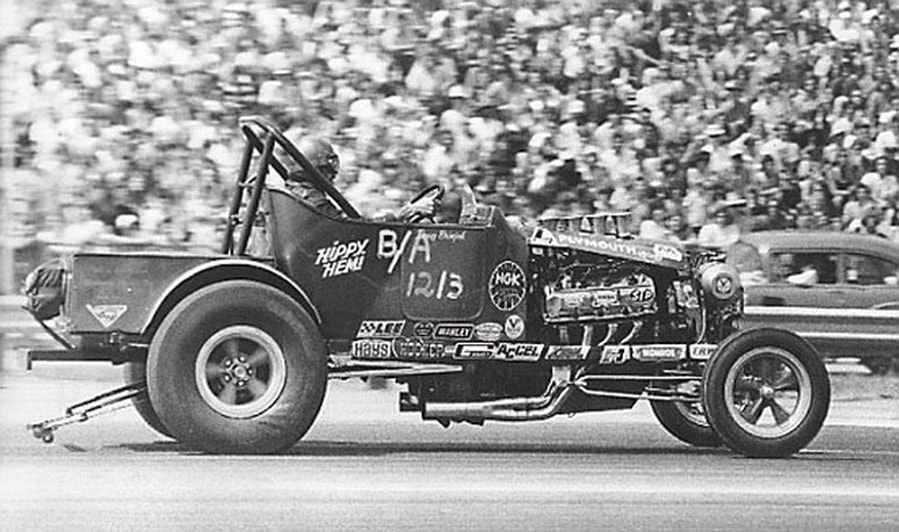
Tony Nancy on his home turf, San Fernando Raceway. Note the hay bails on the other side of the track, designed to keep cars from going off the track into a flood control channel. And on this side of the track (Nancy is driving on the return road), nothing. No hay bails and no guard rails, just nothing. Tony Nancy was a member of the Road Kings Car Club, made up of many well known racers like Tommy Ivo, Don Prudhomme, Bob Muravez (aka Floyd Lippencotte Jr.), Kenny Safford, and several more...
If this is not the 4th of July, this is not a good thing...
Powered by a Ford 429 "shotgun" engine...
The driver is in the trunk...
"Wild Willie" Borsch and the "Winged Express" spitting fire, while he waits for the light at OCIR...
I'm guessing this is an early Chevy roadster, maybe a '33 or a '34...
An early drag car. I mean a VERY early drag car...
Looks like a big block Ford wedge engine, like a 390, 406, 427, etc. The distributor (a magneto on this car) is in the front, like pretty much all Ford engines. GM V-8's had the distributor in the rear. You need to be able to study these photos to get all the value out of them, and look for the little things...
A big supercharged Oldsmobile engine smokes the hides, and is not going very straight as it leaves the line. Fuel Altereds had this little problem, they went wherever they wanted to go, and rarely asked the drivers for permission...
"Pure Hell" on a pass out of the gate...
Tony Waters and his fuel burning roadster, out of Bakersfield...
"Wild Willie" fighting the steering wheel. He hasn't gone 10-feet from the starting line and already the car wants to get crossed up...
The Nicholson Brothers (Don and Harold) and their fuel burning flathead powered roadster...
Dave Selway's Lakewood Muffler-sponsored roadster, running Clarke Cagle's fuel burning Ardun engine, at Pomona. This car was pretty advanced for the early to mid 1950's, with an independent rear end assembly. Photo by Norm Grudem. (Thank you Dave Sorenson)...
A very early shot of Pomona Raceway...
What a shame that NHRA dumped the Fuel Roadster classes. I guess they weren't exciting enough for the spectators, compared with the Pro Stock class where two cars (both with identical plastic bodies and identical 500 cubic inch un-supercharged engines) could race down the track side by side straight as an arrow...
For you younger people that are reading this, that never had the pleasure of watching a pair of supercharged roadsters go down the track, you just have no idea as to what you missed...
They weren't always pretty, but they were always fun to watch...
The famous AA/FA, "Nanook", out of the chute like an angry bull at a rodeo, and just as tough to tame...
Barely off the starting line and already "Puff 'n Stuff" is daring the driver to control it...
The man himself, "Wild Willie" Borsch, grabs a smoke in the pits. Sadly, Willy is no longer with us but the car is, and the car still makes exhibition runs with Mousie's new driver, Mike Boyd. But Willie goes down the track with Mike on every pass. His ashes are in an ern securely bolted to the floorboards of this car. I'm not kidding...
Bill Edwards' twin Chevy powered Modified Roadster...
During the transition period between the Ford flatheads and overhead valve engines, the Cadillac engines were very popular...
Making them go straight was a full time job in these cars...
It says, "Nicholson Bros. Speed Shop, Arcadia". I live literally five blocks from where their old speed shop was located, and the building is still there. This is Harold Nicholson versus George Burkhart in the early 1950's. Harold was one of the first to use the Bantam roadster body. The engine back then was a supercharged GMC which was eventually swapped in favor of the Ford flathead. Harold was considered a very sharp racer but the car was evil handling and eventually took his life in 1959 at San Fernando Drag Strip. He was survived by his brother, Don, who went on to become an icon in Super Stock, Factory Experimental, early Funny Cars and Pro Stock...
A simple car. A square tube chassis, a fiberglass Model-T body, a Volkswagen front end, and a straight-6 powerplant...
Simply beautiful, show car quality...
The driver senses trouble and has pulled his hoof off the pedal. He's thinking, "I've got four tires and three of 'em are off the ground"...
These two cars, this one and the one below, go back to the very beginning. Assuming for a minute that the guys in these photos were about 20 years old at the time, they would be about 88 years old today, if they were still around...
Willie has a car length lead, and he ain't gonna lift until the stripe...
All four tires with air between the rubber and the ground. A day in the life of an Altered driver...
The legendary Fisher and Greth "Speed Sport Roadster", out of Arizona...
"Wild Willie" being Willie, driving with one hand. For Willie to use both hands on the wheel, you knew that the car had to be VERY crossed up...
The rules called for a "roll bar". They didn't say what type of material you had to use.
Gary Cagle fights to keep this baby going straight(er)...
Eight pipes sticking out the back. This car had a sound like no other...
The car owner must have had lot of orange paint. With the exception of the Moon disks, everything that is metal on this car is orange...
The "Winged Express" acting up. Willie decided to use both hands on the wheel on this pass...
A couple of Paxton superchargers on this roadster, probably a Ford engine...
Tony Nancy's perfectly proportioned Modified Roadster, supercharged Buick for power...
Tom "Acmo" McLaughlin and Bob Rounthwaite at Saugus Drag Strip, around 1951 or 1952. Acmo (named for the Acme Beer cans he used as carb stacks), installed his GMC straight-six engine into this original, all steel 1925 Model-T roadster, featuring a quick-change rear end...
Raymond Godwin's "Tennessee Bo Weevil"...
Ike's awesome Jimmy powered '29 roadster...
Between 1950 and 1951, they held drag races at the WWII Tustin Naval Blimp Base. The huge hanger on the left is one of two, the largest all wooden buildings ever built, and they are still there. This base is less than a mile from John Wayne Airport in Irvine, which used to be the home of the Santa Ana Drag Strip...
This can safely be called a massive engine explosion, with parts and pieces flying and flames enveloping the entire car and the driver. Scary to watch and more scary for the driver...
The tires are smoking so that's a pretty good indication that Willie is still standing on the pedal...
An angry "Warlock"...
Driver Dave Hough has his hands full, as the AA/FA "Nanook" decides to go airborne...
"Pure Hell" at rest...
Tony Nancy showing off his "22 Jr." Buick engine and Kent Fuller chassis to a young lady...
A pair of AA/FA roadsters going down the track. You have to ask yourself, who would want to spend time at the drag strip watching cars like thes, when they can watch three professional classes where each car looks exactly the same as every other car in their class? Take a look, because cars like these are not coming back and are gone forever from competition...
"22 Jr." when it was still running the Ford Flathead engine...
